
MANASLU BLOGS
Information Hub for Manaslu Conservation Area


A Detailed Guide for Manaslu Circuit Trek (2024-2025)
The Manaslu Circuit Trek is a less-traveled path in the Himalayas of Nepal. Throughout the journey, you will pass through various Tibetan villages and witness breathtaking scenery, particularly during the final days of the trek when you ascend to altitudes exceeding 5000 meters while crossing the Larke Pass, also referred to as Larkya La Pass. It is surrounded by various peaks such as Manaslu, Ngadi Chuli, Himal Chuli, Shringi, Annapurna II, Himlung, Rani Peak, Boudha Himal, and many others.
The Manaslu Circuit Trek offers a chance to explore a less explored region that is filled with a unique culture, Buddhist traditions, breathtaking landscapes, diverse wildlife, and stunning views of snow-capped mountains. This trek takes you through rural villages inhabited by different ethnic groups, dense forests, river crossings, numerous suspension bridges, and the Larkey La Pass, where you can witness the majestic Mt. Manaslu (8183m), the 8th highest mountain in the world.
The Manaslu region is situated in the central part of Nepal and is located on the northern side of the Gorkha district. It encompasses the sub-tropical Himalayan foothills and extends to the trans-Himalayan high meadow that borders Tibet to the north. The elevation in this region ranges from 700m to 8,183m. The eastern border is formed by the Budhi Gandaki river, while the western side is bordered by Ganesh Himal.
Why Manaslu Circuit Trek?
The journey takes you from the hot and humid plains with their stepped rice and millet fields, through the impressive canyons of the Budhi Gandaki River, where you can find breathtaking waterfalls and turquoise waters. The ascent of Manaslu features suspension bridges that are unparalleled in terms of length and height, and the annual monsoon often destroys smaller bridges, making it necessary for hikers to cross using partially submerged boulders.
Even though it was only accessible to 400 trekkers at a time in 1992, this walk still feels like a pioneering expedition. This trek offers a visually stunning experience reminiscent of trekking in the 1980s, but it requires good physical fitness. The route takes you gradually northward towards the snow-covered Larkya La Pass, near the Tibetan border. Despite the challenges posed by the high altitude, the breathtaking views of Manaslu make it all worthwhile. Larkya La Pass, standing at 5167 meters, is usually covered in snow and can be slippery.
Micro crampons are often used during the descent. To reach the highest point of the pass before the winds pick up, which usually happens around mid-morning, an early start at 3 am is necessary. Although it is possible to have a clear view of the path you came from, the most stunning sight is seen when you leave the key and continue along a corridor to the west. Suddenly, a massive glacial cirque appears. Annapurna II stands tall in the front, while a magnificent wall formed by Cheo Himal, Himlung Himal, Nemjung, Gyaji Kang, and Kang Guru descends with a stream of glaciers. This view alone makes the journey worthwhile.
Key Points:
- This circuit is not as crowded as Everest Base Camp and the Annapurna Circuit. Although it is becoming more popular, it is still a good time to trek this circuit before it becomes mainstream.
- This trek is a remote and off-the-beaten-path adventure. However, there are tea houses available in every village along the route. This means that you can enjoy a comfortable night’s sleep in a bed with blankets, have access to showers, indulge in delicious meals at restaurants, and conveniently charge your electronics and cameras.
- You can reach the trailhead by car, eliminating the need to spend money on costly domestic flights.
- During the initial days of the circuit, you will follow the trail that runs alongside the Buri Gandaki river in a deep gorge. This section includes several suspension bridge crossings. Towards the end of the trek, you will encounter snowy terrain, but you can still continue with regular hiking boots. Throughout this part, you will be able to admire the breathtaking snowy mountains that surround the trail.
- As you trek, you will witness a dynamic landscape that transitions from a subtropical jungle at lower elevations to the majestic Himalayan foothills. Your journey will culminate at the Larkya La, situated at an impressive altitude of 5,100 meters / 17,000 feet.
Best Time to visit:
Autumn and spring are considered the best times of year to visit Manaslu Circuit and Tsum Valley. Spring occurs before the monsoon, while autumn follows it. However, it doesn’t mean that other seasons are not suitable, despite being challenging.
Spring, with its great weather and blooming rhododendron flowers, is an ideal time for hiking. However, it’s important to note that there may still be snow on the road from the previous winter season.
The monsoon season in Nepal lasts from early June to late August and is characterized by heavy rainfall. As a result, you should anticipate encountering light to heavy rain along the way, which can make the trail muddy and dampen your belongings. Moreover, the sky tends to become hazy, obstructing visibility of any sights.
The best time to go trekking in Manaslu is during the autumn season, which typically lasts from late August to late November. During this time, the weather is usually clear and calm, providing excellent visibility and a peaceful atmosphere. As always, the views of the surrounding landscapes are absolutely stunning and will leave you in awe.
- Winter (late November to late February):
In general, colder temperatures persist throughout the year at higher elevations. However, during the winter, the situation becomes even more intricate. Nevertheless, the visibility improves and the sky remains clear. Nonetheless, if it starts snowing, the trail will be inaccessible until spring.
Difficulty Level:
The difficulty level of the Manaslu trek is considered to be moderate to difficult. Although it is not considered the most challenging trek, the continuous uphill and downhill sections of the trail can test your limits and endurance. Trekking in the Manaslu region requires both physical and mental strength. It is perfect for adventure enthusiasts and regular hikers can easily complete it without any difficulties. However, newcomers may find the walk challenging. To prepare for the excursion, it is recommended to engage in regular exercise and jogging.
The difficulty level of the walk may also depend on factors such as your physical condition, the weight you are carrying, the condition of the trail (e.g. presence of snow), your hiking gear and equipment, your acclimatization process, the food you choose, and other relevant factors. This is an adventure tour in the Himalayas that offers isolation, diverse nature, Himalayan culture and customs, magnificent rivers, breathtaking snow-covered Himalayas, and rugged Larkey La Pass. The difficulty of the trek is determined by factors such as the distance of the walk, the weather during the trekking season, and the altitude.
This trek covers approximately 177 kilometers and should be completed in 12 days. However, the pace may vary depending on individual preferences. The journey starts at Larkey La Pass, which has an elevation ranging from 930 to 5100 meters. To complete the trek, you will need to cover a distance of 13 to 15 kilometers each day. The difficulty level of this trek increases as you reach higher altitudes. Therefore, it is important to be physically fit and prepared for uphill hiking before embarking on the trek.
The Manaslu Restricted Permit is a special permit issued by the Government of Nepal to preserve and promote the authenticity of the Manaslu region. The cost of the permit varies depending on the season and the duration of stay between Jagat and Samdo. The Manaslu Restricted Permit is a special permit issued by the Government of Nepal to protect and promote the authenticity of the Manaslu region. The cost of the permit varies depending on the season and the number of days you will be staying between Jagat and Samdo. From September to November, the cost is 100 USD for the first seven days and an additional 15 USD per person per day thereafter. From December to August, the cost is 75 USD for the first seven days and an additional 10 USD per person per day thereafter.
- MCAP (Manaslu Conservation Area Permit):
To obtain permission in the Manaslu region during your trek, it is important to obtain an MCAP card. You will need to check the MCAP permit at the check post of Arughat, Gorkha. The cost of an MCAP permit remains the same throughout the year. If you are traveling with a local travel agency, they will arrange all the necessary permits and access to enter the Manaslu Region. To obtain an MCAP and ACAP entry permit and TIMS card, trekkers must submit a copy of their passport and two passport-size photographs.
- ACAP (Annapurna Conservation Area Permit):
Similar to an MCAP permit, the ACAP permit is another essential document that you must obtain in order to reach the summit after crossing the Larkey la pass. Until you reach the top of Larkey, you will be in the Gorkha district, which is part of the Manaslu Conservation Area. After crossing Larkey Pass, you will enter the Manang district, which falls under the Annapurna Conservation Area. Therefore, the ACAP permit is also required for this trek. Like the MCAP permit, the cost of the ACAP permit remains the same throughout the year.
Guide and Porter:
Trekking in the Manaslu region is a difficult task. However, with the assistance of experienced team members, delicious food and drinks, relaxation, and acclimatization, you can explore the most famous trekking route in the world. As usual, the porter will help you carry your belongings. Most tour guides are knowledgeable professionals who can communicate in English fluently. It is important to remember that the guide and porter expect generous tips from you at the end of the journey. These individuals put in a great deal of effort and strive to safely guide you and your group through the challenging mountainous terrain. A guide is mandatory for this trek. It is important to follow the government-imposed law, which requires lone hikers to be part of a group with at least two other hikers and an experienced guide. This also means that you must pay the Manaslu trek guide fee.
Altitude Sickness:
Yes, definitely! Since you will be at an altitude of more than 5,000 meters above sea level, it is important to be cautious about altitude sickness. Altitude sickness is a common problem during the Manaslu trek, but there are various ways to prevent it. It is crucial to be aware of the symptoms of altitude sickness, which can range from mild to severe. These symptoms include headaches, loss of appetite, shortness of breath, fatigue, dizziness, and other signs. If your condition becomes urgent, it is necessary to seek help and be rescued. To prevent altitude sickness, it is important to follow several measures. Firstly, maintain a nutritious diet and eat properly. Stay hydrated consistently. Avoid consuming alcohol at higher altitudes. Gradually increase your pace while ascending. Take time to relax and mentally prepare for the challenges ahead.
Food and Accommodation:
Because there are fewer tourists visiting the area compared to the Everest Region, there are limited teahouses and dining options available when trekking the Manaslu Circuit. As a result, typical Nepali cuisine Dal Bhat Tarkari will be served. Upon your arrival in Kathmandu, you will receive a warm welcome and be transferred to a hotel. During your stay in Kathmandu, you will have various options for accommodation, including 5-star homestays for overnight stays. However, our standard offering is 3-star accommodation with a complimentary breakfast.
Foreign trekkers are not allowed in Manaslu due to its boundary with the Autonomous area of Tibet. Entry into the Manaslu region is subject to strict regulations and a special permit is required for the Manaslu circuit trip. The Manaslu Circuit Trail is known for its isolation, difficulty, and tight requirements, making it a less crowded and less frequented trail. In addition, the majority of individuals in this region are of Tibetan origin and follow Tibetan traditions, customs, and religion.
The area is adorned with magnificent monasteries, chortens, mani walls, and other cultural landmarks, as well as less populated communities. This trek offers a limited number of lodges and tea shops. As you climb higher, there will naturally be fewer accommodations and facilities. Nevertheless, all the resorts at higher altitudes comply with tourism regulations and are predominantly managed by local families.
Packing List:
Since this trek is graded as moderately difficult in the Manaslu region, it is important to ensure that you have all the necessary items for the trek and avoid bringing unnecessary items. Proper management of trekking gear and equipment is crucial for this trek. When packing, it is important to understand that a well-prepared packing list can make your trek enjoyable, while a poorly packed one can make it miserable. Additionally, it is important to note that you will be trekking in Manaslu, so there is no need to bring any climbing gear that is not necessary for you. As you will be staying in tea houses every night, you do not need to bring a lot of things. Generally, for clothing, you can bring a pair of base layers, a second layer, and an outermost layer. Here is a packing list that is essential for most trekking trails in Nepal, including this trek.
- A set of hiking pants and shorts.
- In the normal trekking season, it is also beneficial to have a waterproof shell jacket and raincoat. There may be instances of unexpected rainfall.
- Trekking shirts made of lightweight polyester.
- Underwear and a minimum of 4 pairs of socks are necessary.
- Bring a pair of hiking shoes, sunglasses, sandals, a trekking bag, and any regular medication you may be taking.
- Gloves, hat, neck, and mount cover are necessary to protect your face from the strong wind.
- Sleeping bag, toilet paper, towel, toothpaste, toothbrush, suncream, and hand sanitizer for your everyday needs.
- If you want to drink regular water, the most useful things are a water bottle and a water purifier.
Conclusion:
The Manaslu Circuit Trek offers an unforgettable journey through some of Nepal’s most breathtaking landscapes and cultural treasures. From lush forests and cascading waterfalls to rugged terrain and towering peaks, every step along the trail is imbued with a sense of adventure and wonder. The unique blend of natural beauty and cultural heritage, coupled with the warmth and hospitality of the local communities, creates an enriching experience for trekkers of all levels. Whether you’re seeking a physical challenge or a spiritual retreat, this trek promises to exceed your expectations and leave you with memories to last a lifetime. So lace up your boots, embark on this epic adventure, and discover the magic of the Manaslu region for yourself.”
1. What is the Manaslu Circuit Trek?
This trek is a popular trekking route in Nepal that circles the majestic Manaslu massif, the eighth highest mountain in the world. It offers a unique blend of natural beauty, cultural richness, and adventure.
2. What is the best time to do this trek?
The best time for this trek is during the spring (March to May) and autumn (September to November) seasons. These months offer stable weather, clear skies, and breathtaking views of the surrounding mountains.
3. Do I need a permit for this trek?
Yes, trekkers need special permits to enter the Manaslu Conservation Area, which is required for this trek. Additionally, you may also need an Annapurna Conservation Area Permit (ACAP), depending on your chosen route.
4. Is this trek difficult?
This trek is considered moderately challenging. It involves steep ascents and descents, high mountain passes, and variable weather conditions. Previous trekking experience and a good level of fitness are recommended.
5. What kind of accommodation is available during the Manaslu Circuit Trek?
While it’s not mandatory to hire a guide or porter for this trek, it’s highly recommended, especially for those with limited trekking experience. Guides can provide valuable support, navigation assistance, and cultural insights, while porters can help carry your belongings, allowing you to enjoy the trek without heavy loads.
6. Do I need a guide or porter for this trek?
7. are there any age restrictions for the manaslu circuit trek.
There are no official age restrictions for this trek. However, due to the physical demands of the trek, it’s recommended for individuals in good health and with a reasonable level of fitness. Children and elderly trekkers should consult with their healthcare provider before undertaking the journey.
8. What wildlife can be seen during the trek?
The Manaslu Conservation Area is home to diverse wildlife, including Himalayan tahr, snow leopard, musk deer, blue sheep, and various species of birds. While sightings are not guaranteed, trekkers may encounter these animals during their journey, especially in the remote and less frequented areas of the trek.
9. What emergency services are available along the trekking route?
In case of emergencies, there are basic medical facilities available in some larger villages along this trek route, staffed by local healthcare workers.

- Best Hikes In The World
- Appalachian Trail
- European Hikes
- Nepal Hikes
- Patagonia Hikes
- See All Hikes
- Mount Kenya
- Mount Kilimanjaro
- Mount Toubkal
- See All Mountains
- South Africa
- New Zealand
- Switzerland
- United Kingdom
- Packing Lists
Manaslu Circuit Trek – Hikers Guide To This Classic Circuit Hike
Asia , Nepal
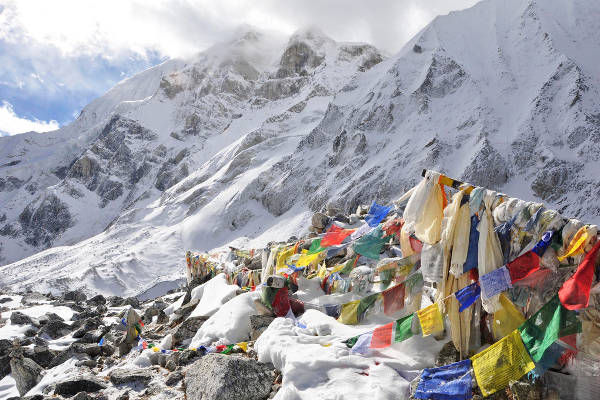
The Manaslu Circuit hike passes ten Himalayan peaks of more than 21,300 feet, including the 8000er , Manaslu (26,781 feet), which is the eighth-highest mountain on Earth .
The Manaslu trek is a 110-mile hike that is a great alternative to Everest Base Camp hike or the Annapurna Circuit hike . The trek usually takes between 14 and 17 days. There are some who do it in 12 days.
Here is my hikers guide to the Manaslu Circuit trek.
Manaslu Trek Guide
The Manaslu Circuit trek resembles the Annapurna Circuit trek of decades past. The area covers six climatic zones. Robin Boustead, author of Nepal Trekking & the Great Himalaya Trail: A Route & Planning Guide , has said, “many would argue that the Manaslu Circuit trail is the best trek in Nepal .”
The Manaslu Circuit hike runs through a restricted area and, while growing ever more popular, is nowhere near as developed as the Khumbu (i.e. Everest) and Annapurna regions. The scenery is similar to that of the Annapurna region and the level of difficulty is similar to the Annapurna Circuit.
A good portion of the trek is spent above 10,000 feet, which is more demanding, but the acclimatisation profile is good, with the trek starting at just under 2,000 feet and taking a week to reach 10,000 feet.
Around 2,000 people undertake this trek each year, much less than hikes in the Annapurna region or to Everest Base Camp, with over half coming in October. You will probably see more yaks and donkeys than trekkers.
The first reason why the Manaslu trek is less frequented is that camping used to be the only option due to a lack of Nepal tea houses . This has since changed with many tea houses being built over the last decade. Admittedly, what tea houses now exist are basic compared to those found on the Annapurna Circuit, but most are relatively comfortable and have electricity. A warm 4-season sleeping bag should be taken as the bedding in some tea houses isn't great and rooms get very cold at night.
The second reason for the Manaslu Circuit hike’s lesser popularity is that the area is restricted and so requires a permit and a registered guide.
Please Note: The highest point is Larkya La (5,213m), which is widely regarded as one of the most dramatic pass crossings in the Himalayas . Sitting as it does in the near-permanent shadow of Manaslu’s north face, snow conditions can be severe. It takes five or six hours to trek to the top.
Manaslu Regional Map
The Manaslu Circuit trek is in western Nepal, a few miles from Tibet inn the North and north-west of Kathmandu in Nepal.
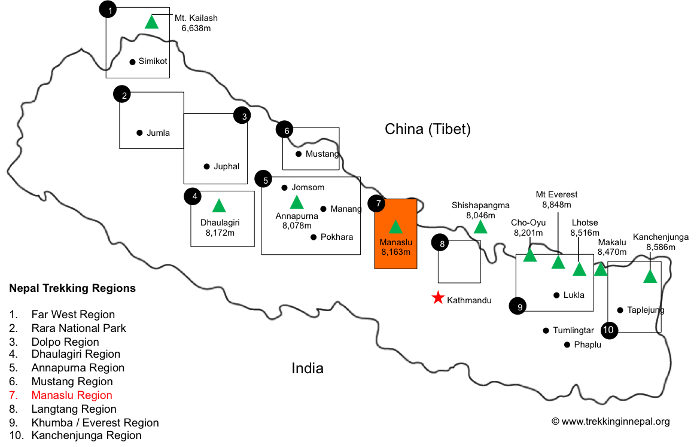
Recommended Manaslu Map
In terms of a good map for the Manaslu Circuit, we recommend: Manaslu and Ganesh Himals Region: 1:125,000 Trekking Map (The Great Himalaya Trail Series Maps) (NP106).
In terms of a single detailed map we recommend the Himalayan MapHouse’s, New Annapurna Trekking Trails Map , which can be bought in Kathmandu, Pokhara or on Amazon.
We have also provided links and recommendations to guidebooks below.
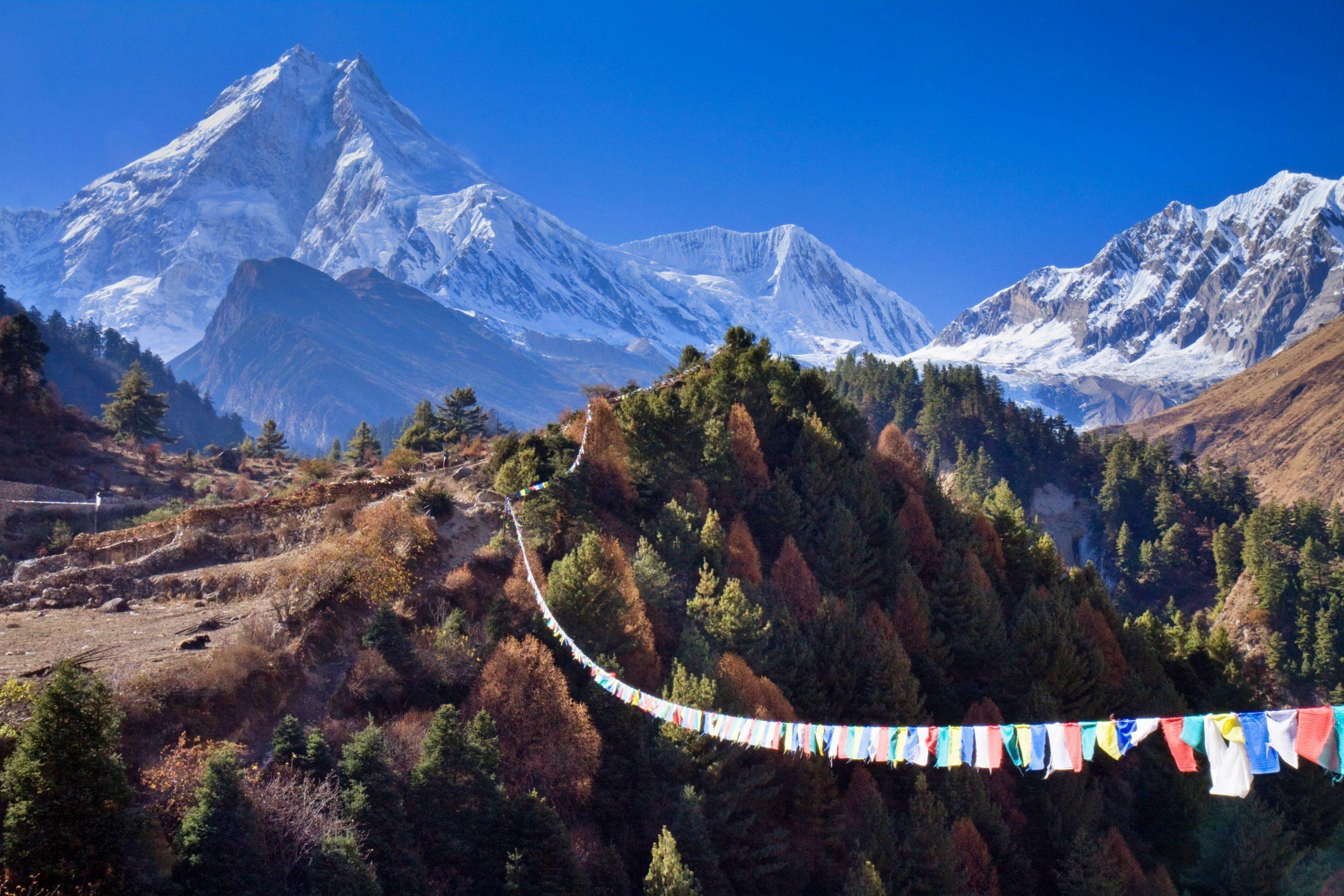
Manaslu Trek Itinerary
Because of the spacing of tea houses at higher altitudes, the Manaslu trek is best done anti-clockwise. It is possible to stay in nothing but tea houses, but you may want to camp as well.
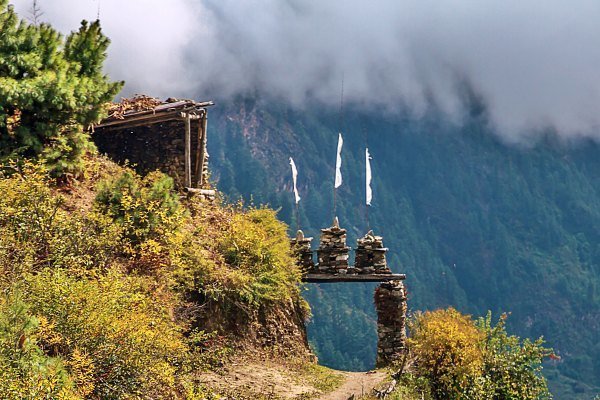
There are several Manaslu Circuit itineraries that can be done. Most start in Arughat, which can be reached by bus from Kathmandu (be prepared for a bumpy ride). Much of the trek follows the Buri Gandaki.
On the lower reaches you will pass lots of farmland, but as you ascend the landscape will become a lot more barren and glaciated.
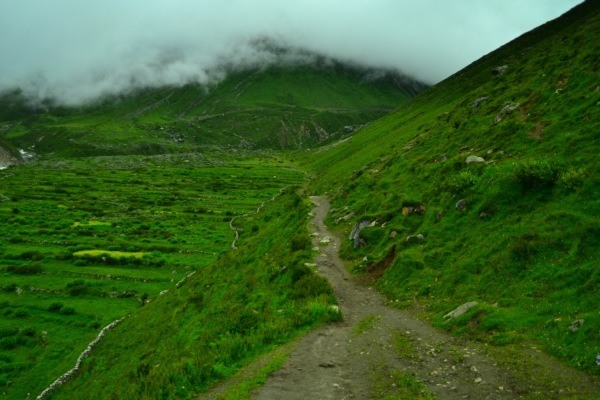
There are many mountain views, the most impressive I think are those of Naike Peak, Manaslu North and Manaslu.
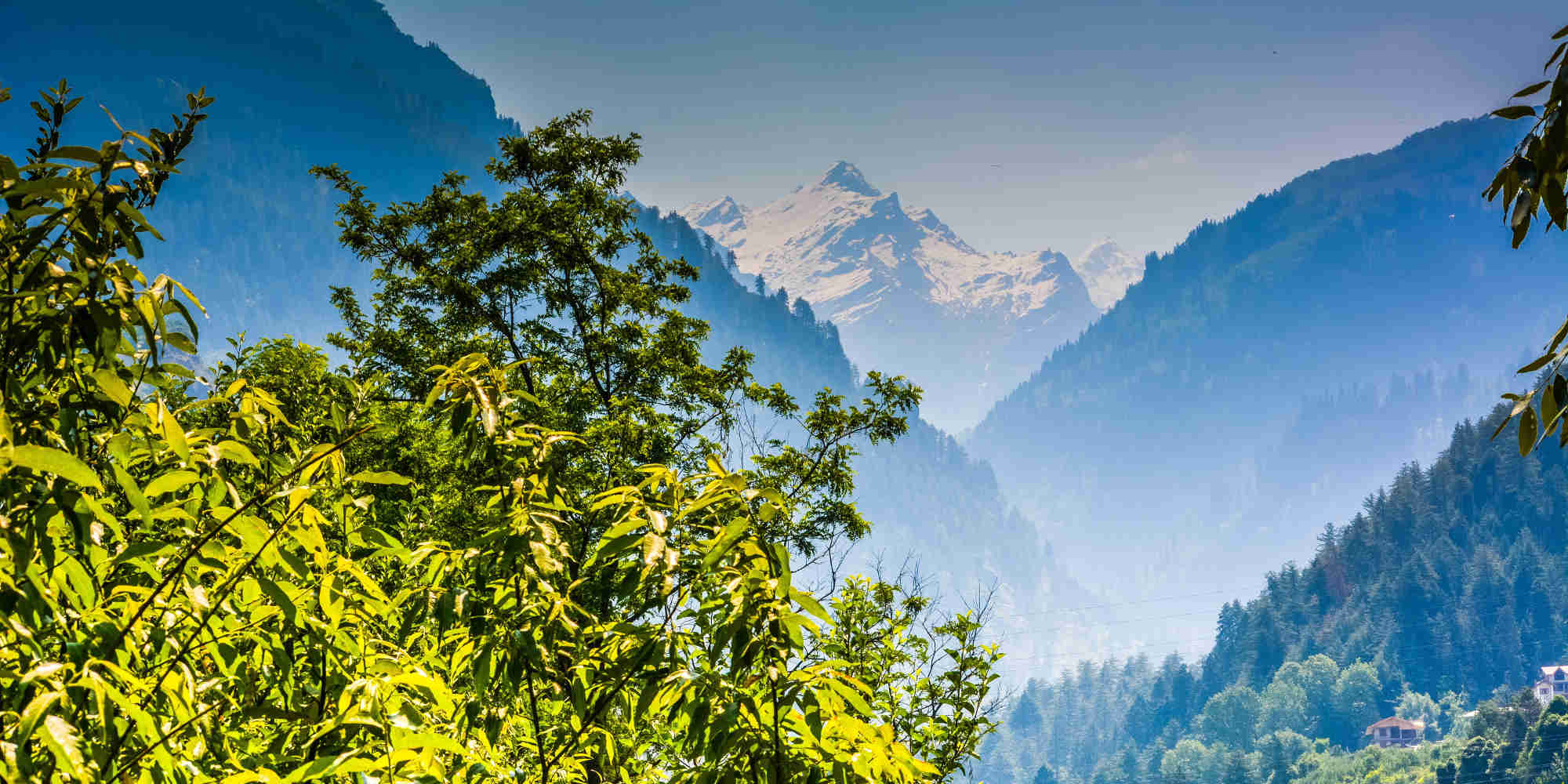
Manaslu Circuit Trek FAQ
When is the best time to trek manaslu.
The best time to trek Manaslu is October or November . Overall, this is the overall best time to trek in Nepal with April and May being the next best times.
How much does the Manaslu Circuit trek cost?
Prices can vary widely, from $2,000 per person at the bottom end to $4,000 per person at the top end. There are over 1000 local trekking agencies in Nepal , so make sure you pick a good, well reviewed operator.
Are permits required for the Manaslu Circuit trek?
Yes, permits are required for the Manaslu Circuit Trek. You need a Restricted Area Permit which costs $50 a week, a Manaslu Conservation Area Project permit which costs $30 and an Annapurna Conservation Area Project permit which costs $30. You will also need four passport-sized photographs.
How difficult is the Manaslu trek?
The Manaslu Circuit Trek is considered quite challenging, but still a possibility for first time trekkers. Altitude is often over 10,000 feet and there may be sections with snow. A good level of fitness is required as the trek is quite long and often steep.
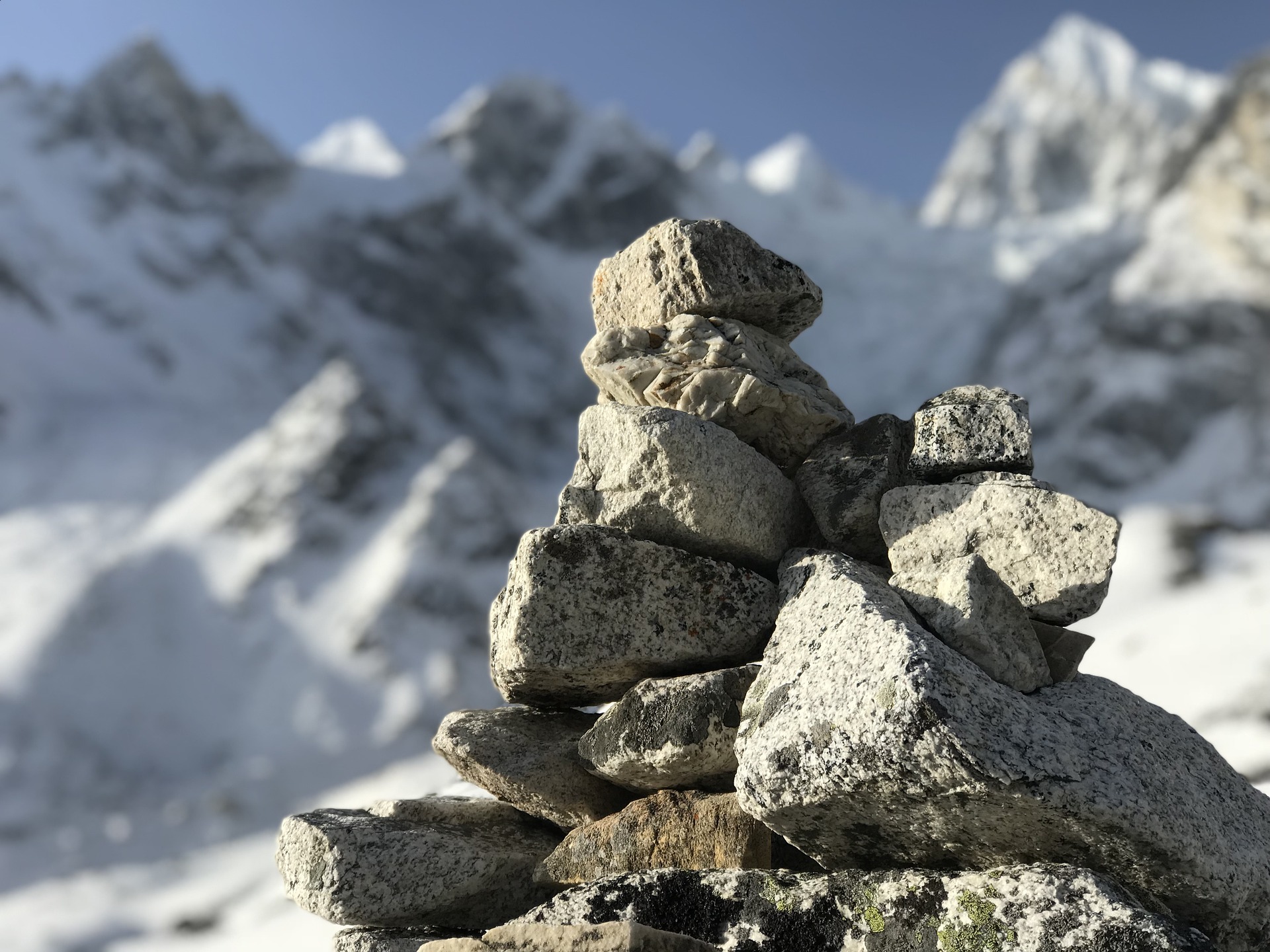
Is altitude sickness a risk on the Manaslu Circuit trek?
Yes, altitude sickness is a risk on the Manaslu Circuit trek because it ascends to some high-altitude points. At its highest point, Larkya La, you will reach an altitude of 5,213 meters (17,100 feet). There are steep sections on this trek where you will ascend very rapidly.
Therefore, it is important to have a solid understanding of the risks associated with high altitude trekking and how the body acclimatises to high altitude. We recommend you read our detailed article on altitude sickness .
What gear do I need for the Manaslu Circuit?
Trekking the Manaslu Circuit requires a number of essential pieces of trekking gear. The trail is long and moderately difficult, exposing you to a range of altitudes where temperatures fluctuate dramatically between night and day.
At a minimum you should take:
- 4-season sleeping bag
- Good hiking boots and 6-8 pairs of hiking socks
- Layered clothing including base layers and a warm down jacket
- Warm gloves
- 60-70L backpack
- Hydration pack
- Trekking poles and polarised glasses

Are there any recommended guidebooks for the Manaslu Circuit Trek?
There are two guidebooks dedicated to the Manaslu Circuit hike that I recommend.
The first one and my personal favourite is A Trekking Guide to Manaslu and Tsum Valley: Lower Manaslu & Ganesh Himal by Sian Pritchard-Jones and Bob Gibbons. As a great alternative, I recommend No products found. by Lonely Planet.
There is also a collector's book available online called Manaslu: A Trekker’s Guide by Kev Reynolds, which was published in 1999.
You are also welcome to have a look at our recommended list of Nepal books and guidebooks for more options.
Continue browsing
See more information on Nepal . Or check out these other Nepal hiking articles:
- Short Nepal Trekking Tours
- Easy Hikes in Nepal
- Kala Patthar Trek
- Kanchenjunga Base Camp Hike
- Trekking to Rara Lake
- Mera Peak Trek
- Best things to do in Nepal
- Helambu Trek
- Hiking the Mustang Circuit
- Gokyo Lakes Trekking Guide
- Makalu Base Camp Trek
- Gosainkunda Hike
- Hiking to Limi Valley
About the author
Mark Whitman
Mark has trekked extensively in Asia, Europe, South America and Africa. He founded Mountain IQ in 2014 with the sole aim to be the best online information portal to some of the most popular mountain destinations around the world. When not writing for Mountain IQ, Mark is out exploring the outdoors with his wife!
Leave a Reply
Your email address will not be published. Required fields are marked
I am planning on traveling to Nepal this mid May to early June with two friends.
I am a Wilderness First Responder and have guided backpacking trips in California and Alaska, so I consider myself quite competent in the backcountry and would be more than happy to carry my own gear for the duration of a trek.
Is there a particular region in Nepal (or Bhutan or India) that lends itself to off-trail travel without a trekking company? I am still open to hiring a local guide because I think it adds a lot to the experience, but I would prefer to be in a region that provides a competent backpacker with more flexibility.
I’d appreciate any input or direction!
Hi David, in terms of Nepal I would recommend the Annapurna Circuit, Goyko Lakes Trek or the Manaslu Circuit – all offer great backcountry hiking, but are sufficiently well trodden with decent facilities (tea houses) to make one’s experience fun and enjoyable.
Thanks so much for the input Mark.
On the three treks that you mentioned, should we prepare to stay on the common trail the whole trip, or is it feasible/desirable to ever travel off-trail to explore a little more?
Last question, I promise. Thanks!
We work with local guides to offer great value adventures at unbeatable prices
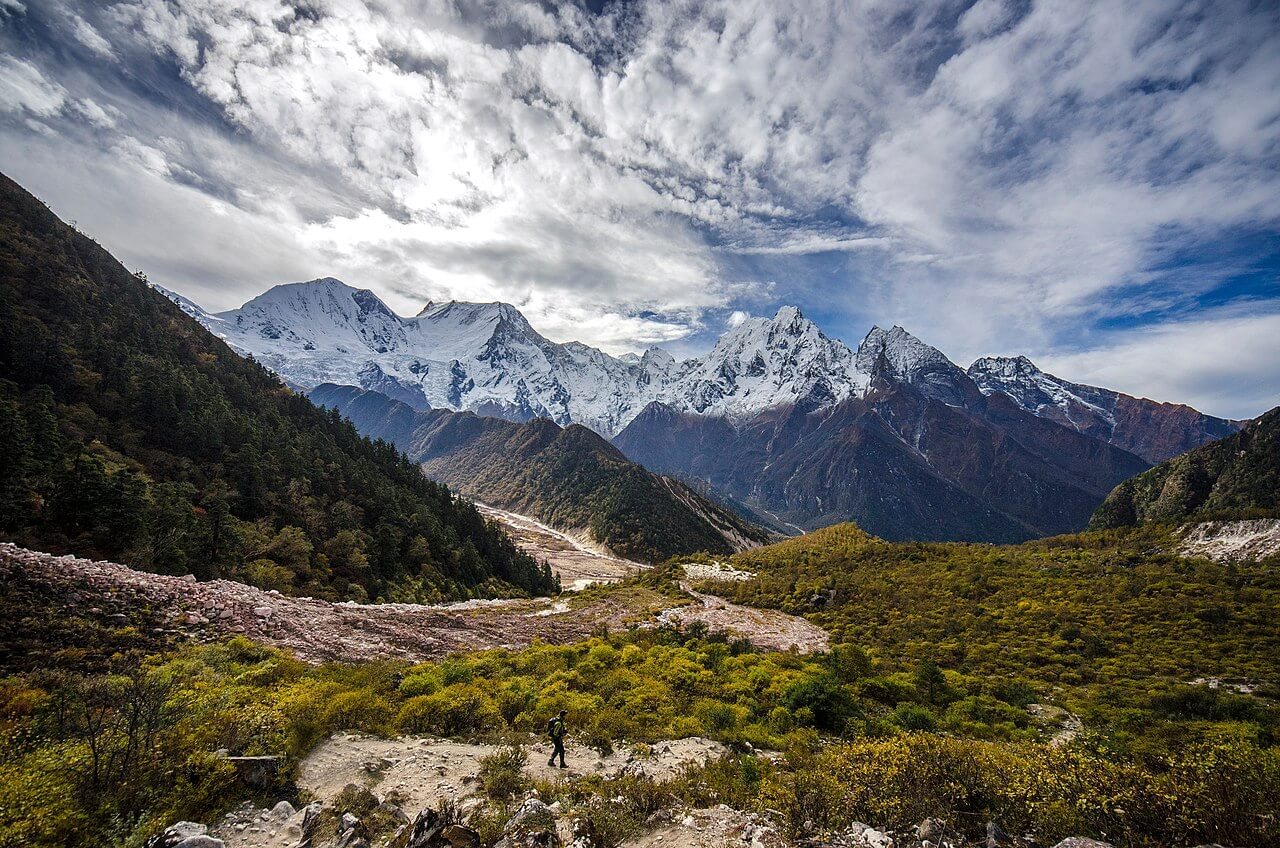
Manaslu Circuit Trek
Manaslu Circuit Trek stands less beaten and secluded compared to treks like Everest or Annapurna , but it is equally as impressive as other classic treks.
Manaslu Circuit Trek is the most beautiful as well as demanding treks in Nepal . Trekking in Manaslu is a delightful experience with a blend of adventure, scenery, culture, lifestyle, and wildlife. Located in the western part of Nepal, this trek provides you with an opportunity to encircle around the world’s 8th highest massif, Mt. Manaslu.
Manaslu Circuit Trek rewards you with magnificent spectacles of some of the highest mountains in the world, including Manaslu and Annapurna. With diverse landscapes, unique cultures, rare flora, and fauna, Manaslu is one of the most sought out destinations for avid trekkers. Most of the travelers who choose this trek tend to enjoy less trodden mountain trails rather than the well-known trekking destinations.
Throughout the trail, this trek takes you via the high valleys, isolated villages, ancient monasteries, tranquil lakes, and high Himalayan passes.
Table of Content
Manaslu Circuit Trek Facts
Highlights of manaslu circuit trek.
- Comparatively remote and off the beaten trekking destination in the Himalayas of Nepal.
- Diverse landscapes ranging from subtropical forests to the high Himalayan passes.
- Crossing over Larkya La Pass (5,135m), the highest elevation point on the trek.
- Discover the timeless culture and lifestyle of the Manaslu region.
- Enjoy the epic mountain sights as this trek offers glimpses of Mt. Manaslu, Himalchuli, Ngadi Chuli, Ganesh Himal, and Larke Himal.
- Discover rare and abundant wildlife. Manaslu is home to 33 different species of mammals, 110 species of birds, and 211 species of butterflies.
Getting There and Away
Start of the trek.
You’ll start your adventure with a scenic drive from Kathmandu to Soti Khola in Budhi Gandaki Valley. You can drive to Soti Khola (141 km) via 4×4 Jeep (8 hours) or by a local bus (10 hours).
End of the Trek
The endpoint for Manaslu Circuit Trek is Dharapani. You’ll have to take a jeep from Dharapani to Besisahar and switch the vehicle back to Kathmandu.
14 Days Outline Itinerary of Manaslu Trek
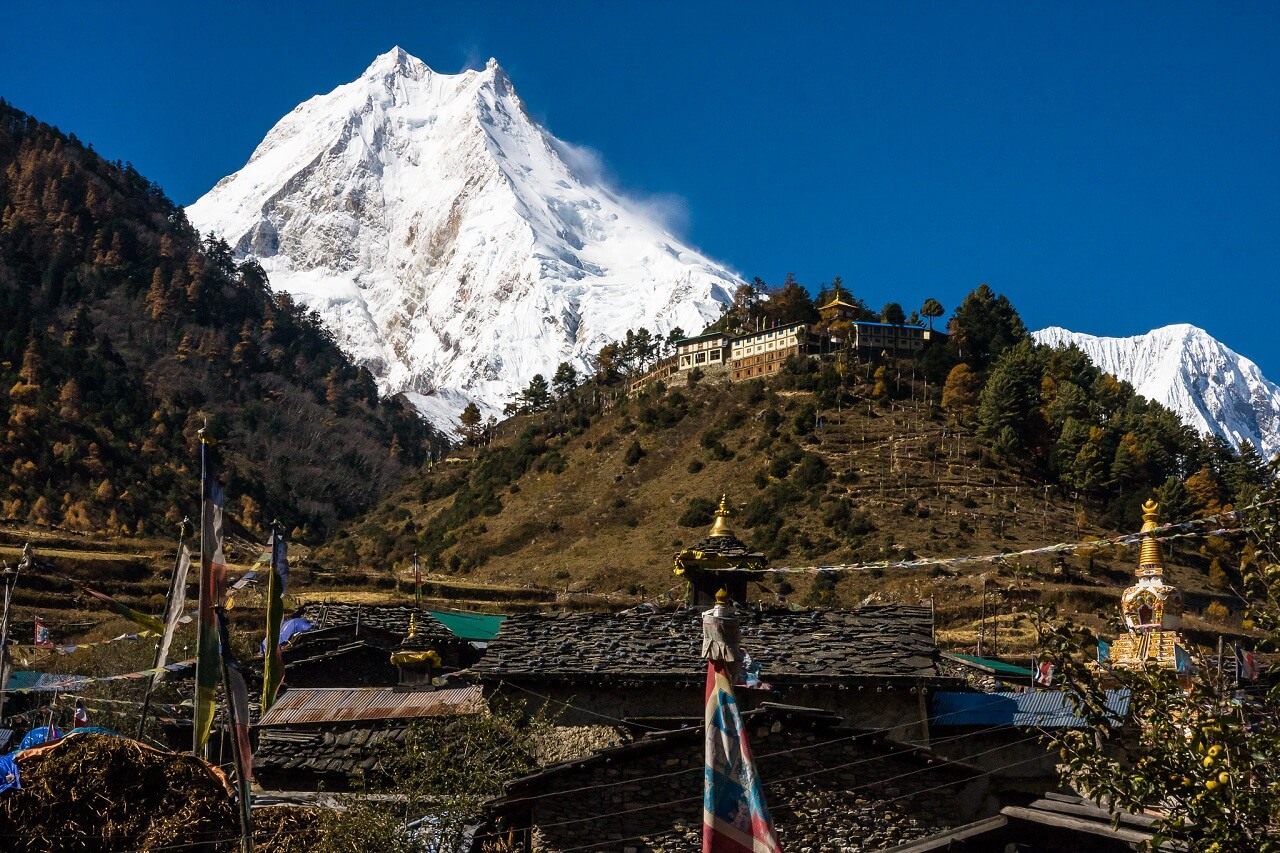
Manaslu Circuit Trek 14 Days Detailed Itinerary
Day 1: drive from kathmandu (1,400m) to soti khola (815m) via arughat (941m) – 8 to 10 hours.
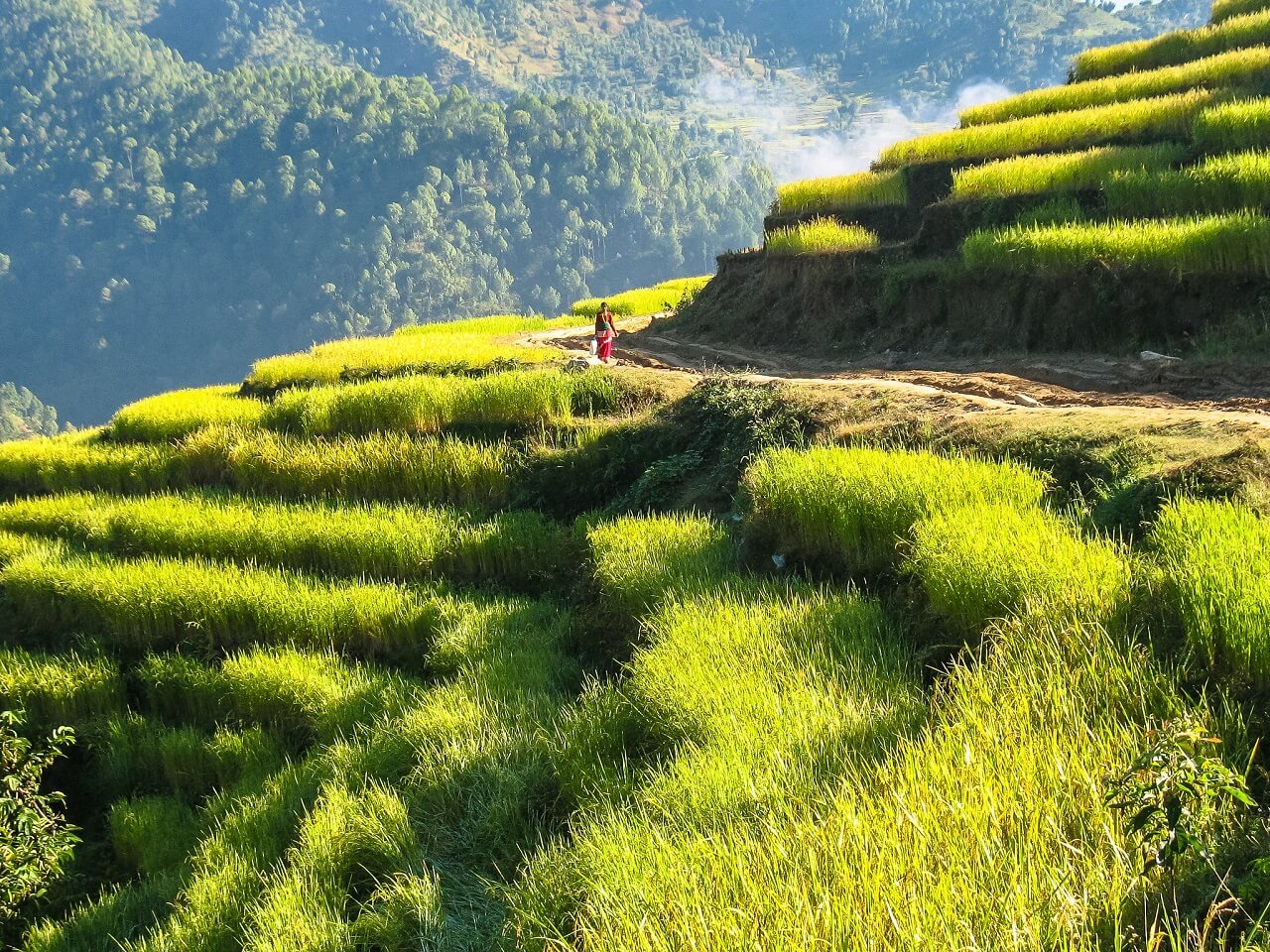
Your adventure to Manaslu Circuit Trek begins with an early morning drive westwards to Soti Khola via the Prithivi Highway. This scenic drive alongside the mighty Trishuli River passes through occasional small towns, breathtaking terrace fields, and lush green hillsides.
Upon reaching the Malekhu Bridge, the vehicle will take a turn towards Dhading Besi, away from the highway. Eventually, you’ll be traveling on a rutted, dirt path towards Arughat as the views of mountains like Annapurna, Manaslu, Ganesh Himal, and Langtang Himal start unfolding in the horizon.
After about 8 to 10 hours of driving, you’ll reach Soti Khola.
Day 2: Trek from Soti Khola (815m) to Machha Khola (900m) – 6 to 7 hours
On this day, your trek starts by crossing the bridge over Soti Khola with a splendid view of the waterfalls. The trail leads to the dense forest before ascending onto the ridge right above the Budhi Gandaki River.
After hiking through the rocky terrain, you’ll arrive at the village of Khursane. Eventually, after descending past the paddy fields, you’ll trek around the Gurung settlement of Lapubesi. Walking along the sandy beds of Budhi Gandaki River, you’ll go down towards the Naulikhola.
Upon crossing the suspension bridge over the river, you’ll arrive at the tiny settlement of Machha Khola.
Day 3: Trek from Machha Khola (900m) to Jagat (1,370m) – 6 to 7 hours
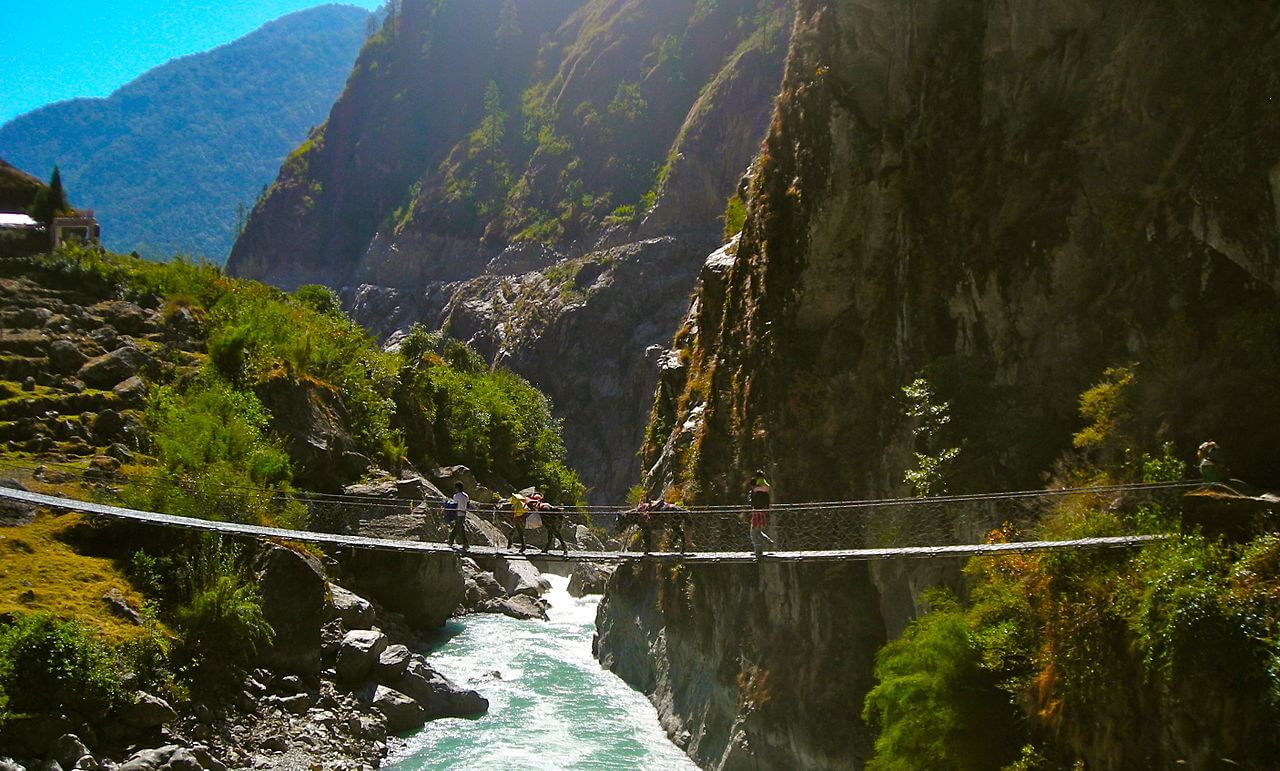
Today, the day may get slightly strenuous as the trail to Maccha Khola leads to several uphills and downhills. Your day begins following the narrow paths along the gorge with a gentle uphill and downhill. After a while, you will cross Tharo Khola to reach another Gurung village at Khorla Besi.
As the trail ascends and descends, you will arrive at a natural hot spring in Tatopani. After arriving at Tatopani, you’ll climb a steep ridge then cross the Budhi Gandaki River via a suspension bridge. The trail then heads over the hill towards Doban after climbing up the stone steps.
After crossing the suspension bridge over Yarkhu Khola, the trail leads to another steep section of the stone staircase. The trail then navigates towards the river before ascending through some more stone steps towards Thado Bharyang.
Heading across the west bank of Budhi Gandaki River, you’ll climb over the ridge and walk alongside the river towards Jagat. The village of Jagat is the entry point of the Manaslu Conservation Area (MCA).
Day 4: Trek from Jagat (1,370m) to Deng (1,865m) – 6 to 7 hours
You begin the day with a steep ascent over the rocky ridge to Salleri, then make a gentle descend towards Sirdibas. Then, continue trekking towards Ghatta Khola and cross a long suspension bridge to arrive at Philim, a large Gurung village.
The trail now heads northward across the millet fields to Ekle Bhatti. You navigate through the sloppy grasslands then cross the Budhi Gandaki river. After you walk along the riverbank, the narrow trail opens up through the valley. You’ll then walk in the shades of bamboo forests towards the Deng Khola. Upon crossing the river, you’ll reach your destination, Deng.
Day 5: Trek from Deng (1,865m) to Namrung (2,630m) – 6 to 7 hours
After leaving Deng behind, you commence the day by crossing the Budhi Gandaki river. From the bridge, make a gentle ascend to reach the trail from Bhi. Now, head westwards up the Budhi Gandaki Valley and walk past the lush green jungles and traditional villages of Manaslu.
Although there are a few alternative options, this itinerary takes the route that passes through the village of Prok. The viewpoint of the settlement offers a magnificent view of the Siringi Himal. You cross the Budhi Gandaki river time and again today and walk past the ancient monasteries en route to Namrung.
The trail navigates along the river upstream under the shade of the dense bamboo forest until you reach Namrung.
Day 6: Trek from Namrung (2,630m) to Samagaon (3,525m) – 6 to 7 hours
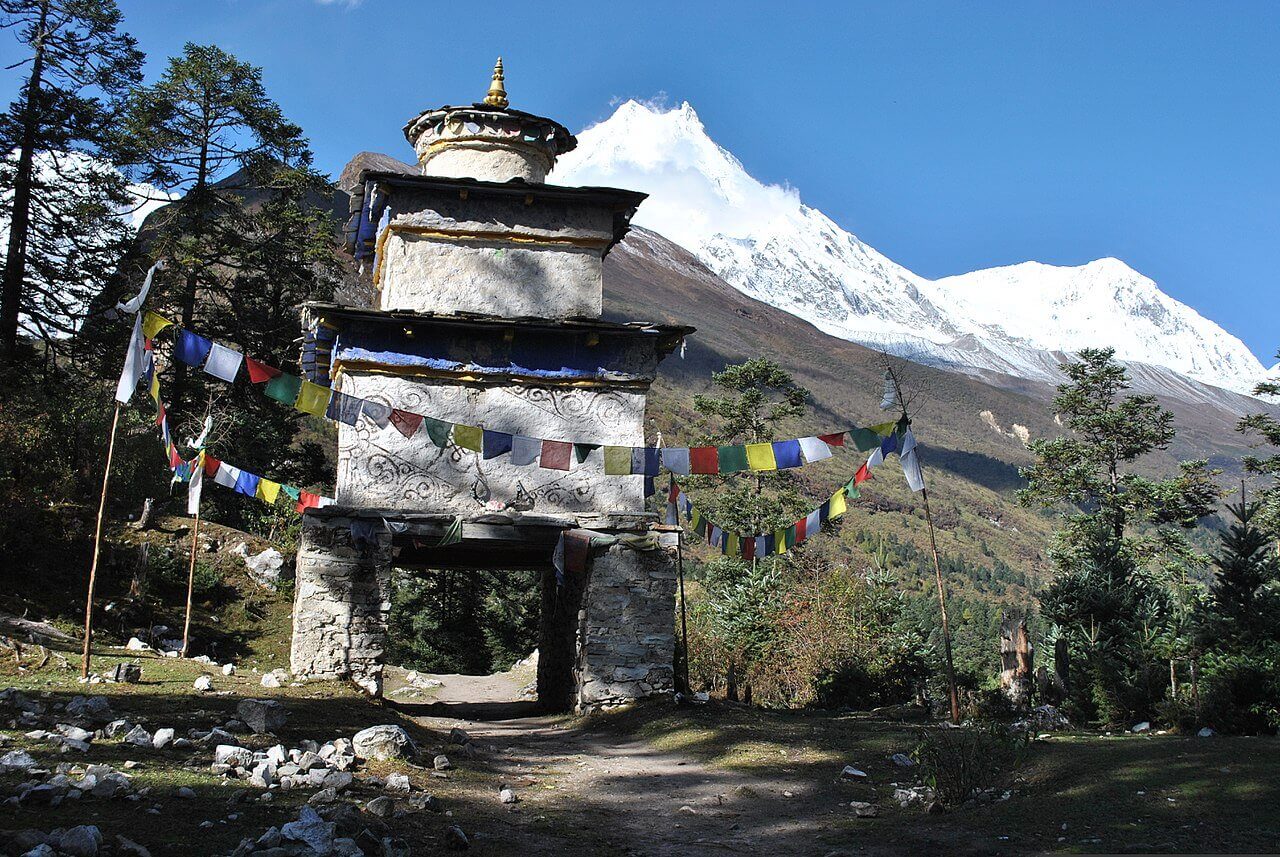
Namrung village offers a magnificent sight of Siring Himal, Ganesh Himal, and Mt. Himal Chuli. After enjoying the morning spectacles of the Himalayas, the trail leads uphill through the lush green forest to reach Lihi village.
Furthermore, you walk past several remote villages like Sho, Lho, and Shyala before arriving at Samagaon. Upon reaching Lho, you will enjoy the extraordinary view of the world’s 8th highest mountain, Mt. Manaslu. Snow-capped mountains surround Shyala village from all directions — Himal Chuli and Peak 29 (Ngadi Chuli) on the left, Mt. Manaslu and its glacier up ahead, and Ganesh Himal on the far right.
Your adventure for the day ends as you reach Samagaon.
Day 7: Acclimatization Day at Samagaon (3,525m)
A much-required rest day at Samagaon to acclimatize with the higher altitudes. On this day, you can choose to take a rest in the teahouse or hike around the nearby destination to keep your feet stretched.
For those who want to explore around instead, you can take a short hike up to an old monastery, Pungyen Gompa. This ancient monastery offers an excellent view of the glacier.
Day 8: Trek from Samagaon (3,525m) to Samdo (3,850m) – 4 hours
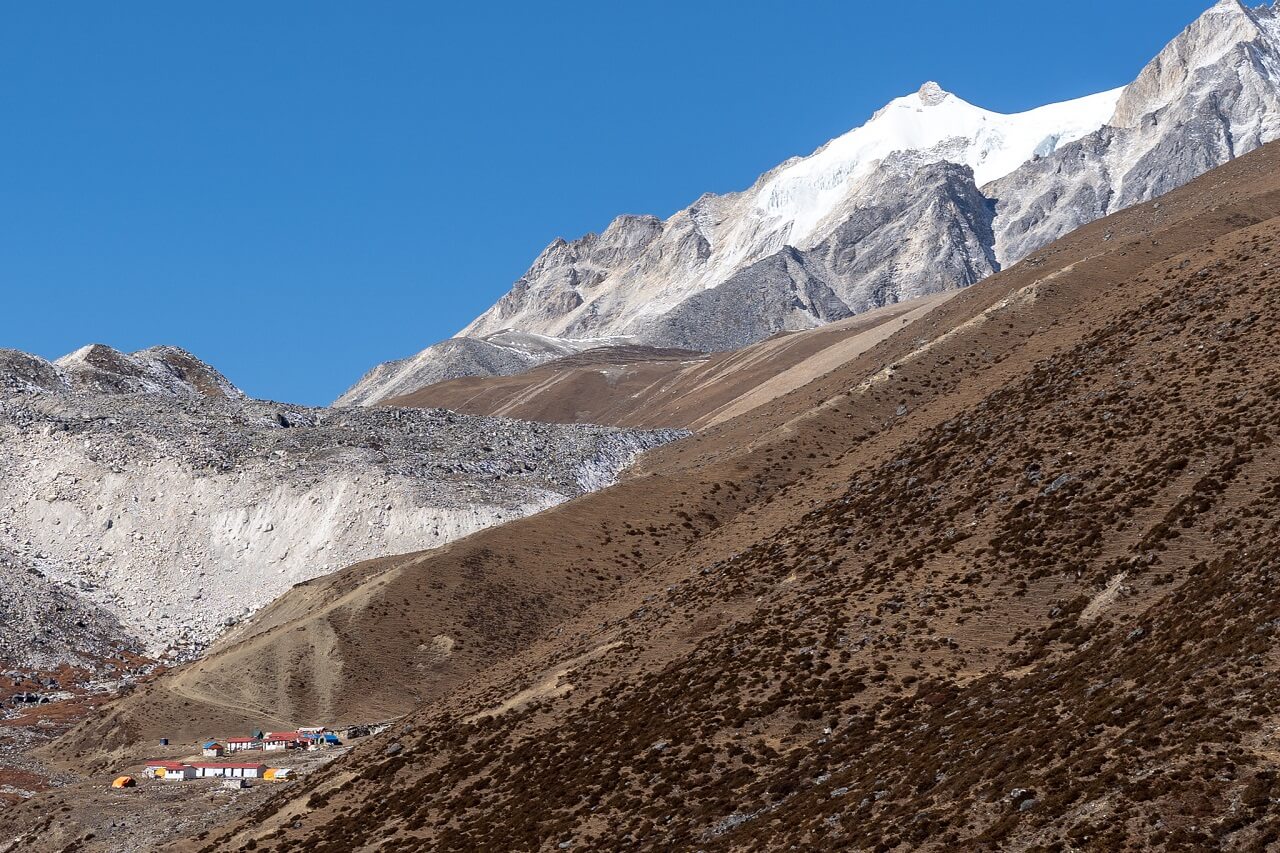
Begin your day with a slight descend to Budhi Gandaki River then head towards the bridge over a side stream. The valley begins to open spread out as you walk across several Mani walls. Enjoy the magnificent views of the mountains along the trail as you edge closer to the Tibetan border.
Then, the trail leads to an accessible route right above the river under the shades of birch and juniper forests. Samdo offers an excellent view of the mountains, especially Mt. Manaslu. Since Samdo is a village of Tibetan refugees, Tibetan Buddhism widely dominates the area.
Day 9: Acclimatization Day at Samdo (3,850m)
Another acclimatization day at Samdo begins before heading to the challenging sections of the trek. There are a couple of alternatives for day hikes in Samdo.
The first option is an easy walk to the valley directly behind the Samdo village. The trail offers magnificent mountain views including Mt. Manaslu, Hiunchuli, Simrang, Ngadi, and Larke Peak.
Another option is to hike towards Gya La, a long pass north of the village. Excursion to Gya La is slightly longer and more strenuous than the first one.
Day 10: Trek from Samdo (3,850m) to Dharmasala (4,460m) – 4 to 5 hours
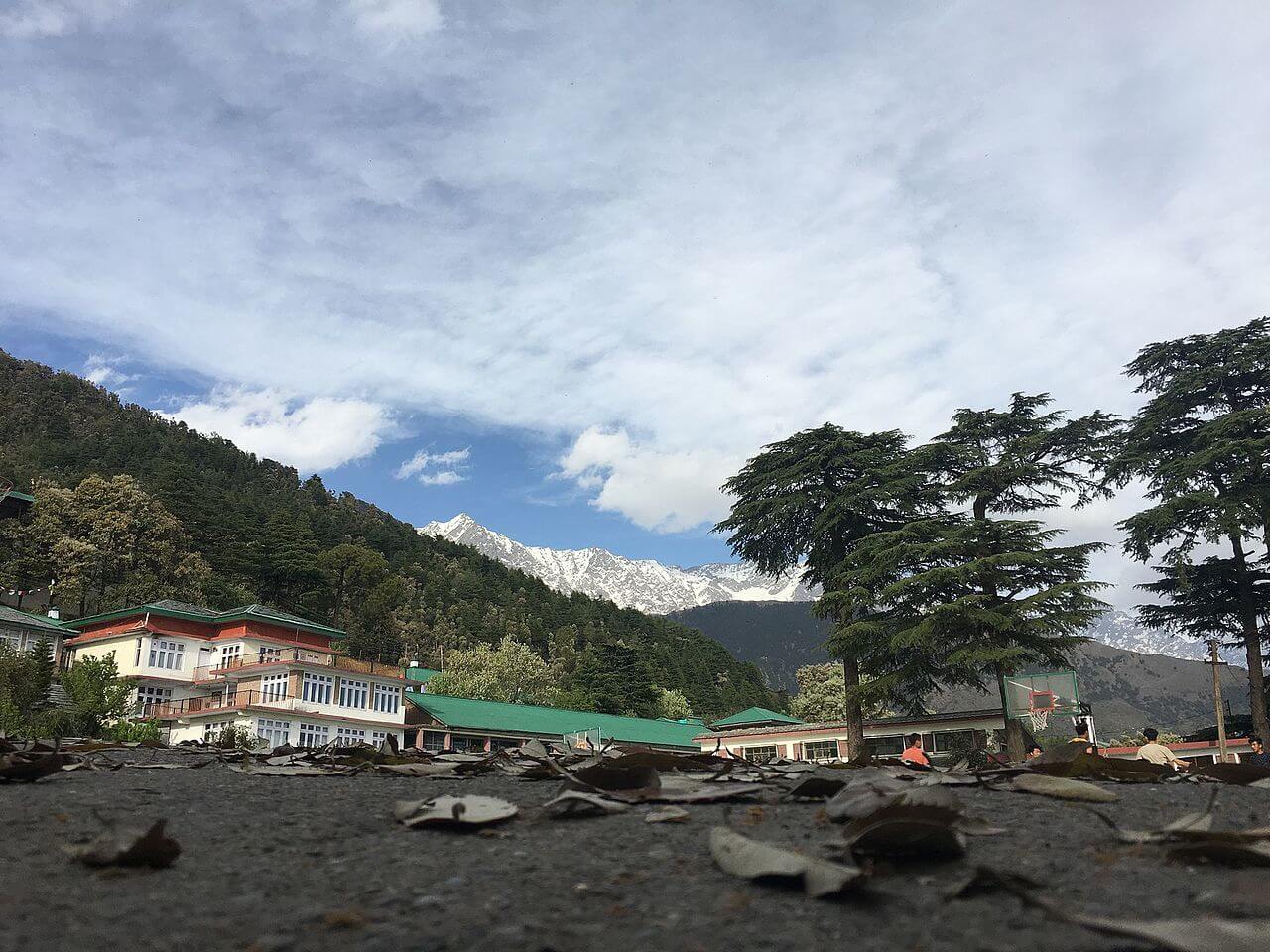
Upon leaving Samdo, you’ll walk past Larke Bazar, a seasonal Tibetan market, then descend towards the Budhi Gandaki river and cross the small wooden bridge. You’ll pass a couple of streams while relishing the Larkya Glacier.
After trekking around the valley of Salka Khola, you’ll climb steep uphill towards Dharmasala.
Day 11: Trek from Dharmasala (4,460m) to Bhimtang (3,590m) via Larkya La Pass (5,135m) – 8 to 9 hours
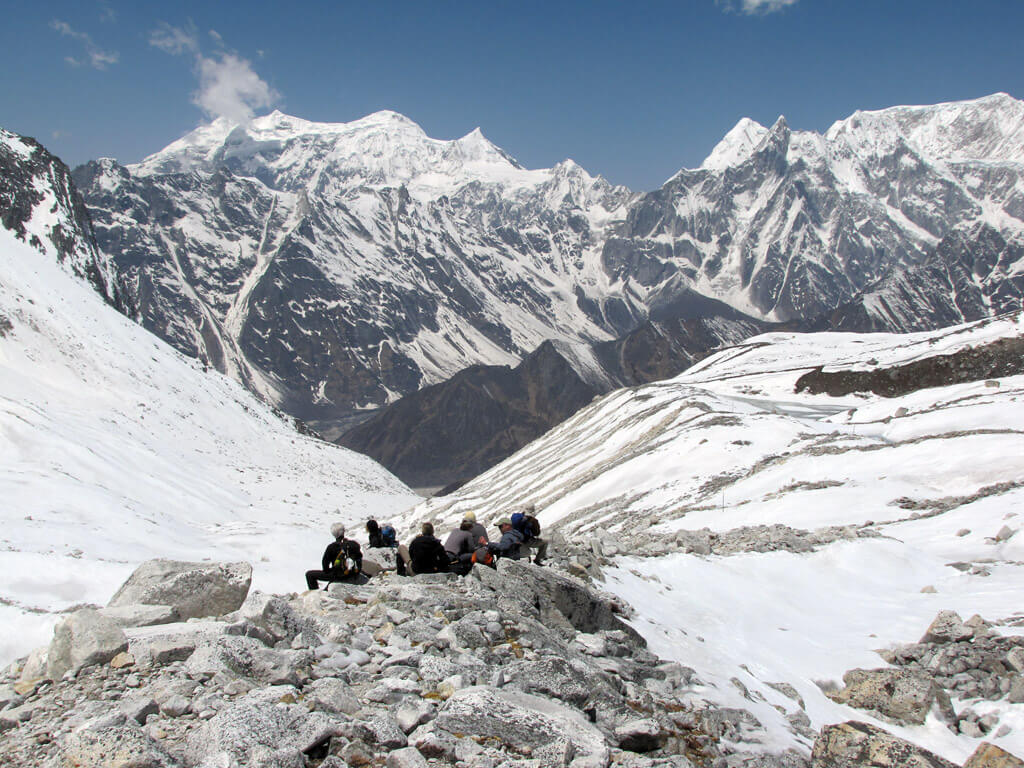
Today marks as the most prolonged and most strenuous day of the entire Manaslu Circuit. Therefore, make sure to begin your adventure early in the morning. Your journey starts with a gentle uphill to a small valley north of Larkya Glacier. The valley provides breathtaking views of Larkya Peak and Cho Danda.
Furthermore, make a gradual ascent across the moraine of the glacier until you reach the upper section of the pass. In the upper reaches of Larkya La Pass, the climb becomes steeper. However, the pass is rewarding with beautiful spectacles of the mountains, including Annapurna II, Himlung Himal, and Cheo Himal.
The trail then descends to the low pastures until you arrive at Bhimtang.
Day 12: Trek from Bhimtang (3,590m) to Tilije (2,300m) – 5 to 6 hours
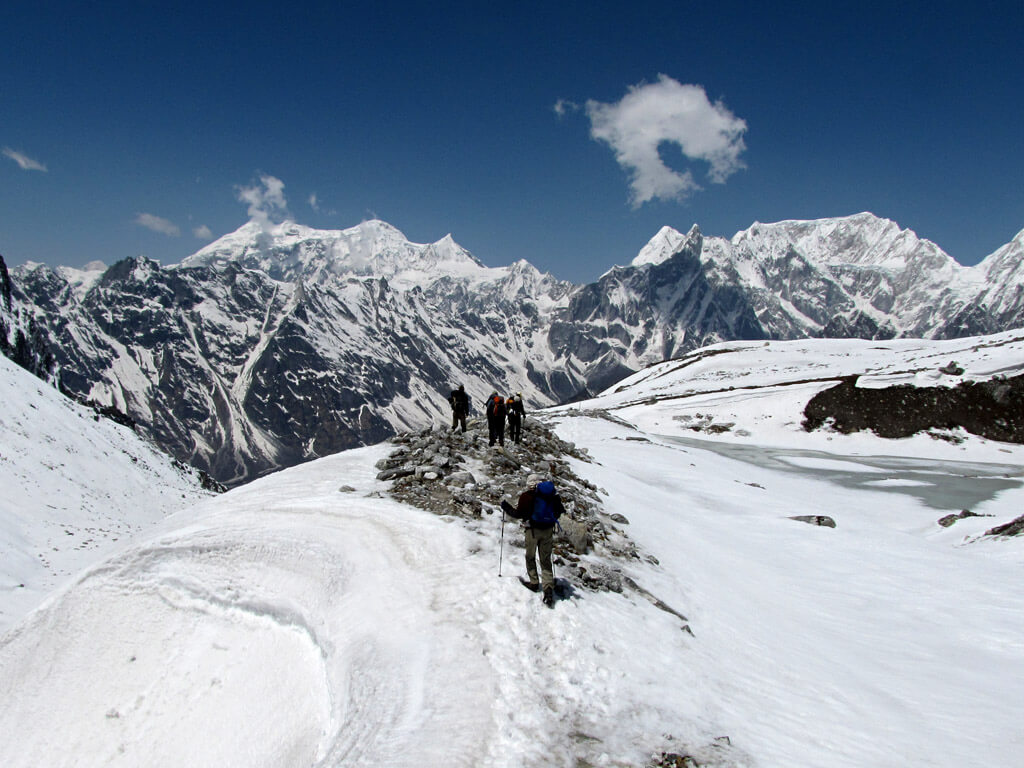
After a long day at Larkya La Pass, you commence the day by descending the Budhi Gandaki river. After crossing the wooden bridge over the river, you’ll walk along the dense rhododendron forest and head toward the narrow valley towards Karche, the highest cultivated land of Budhi Gandaki Valley.
Following a few hours of walking on the river banks, you’ll arrive at the village of Gho. Then, continue walking until you reach your destination, Tilije.
Day 13: Trek from Tilije (2,300m) to Dharapani (1,860m) and Drive to Besisahar (760m) – 7 to 8 hours
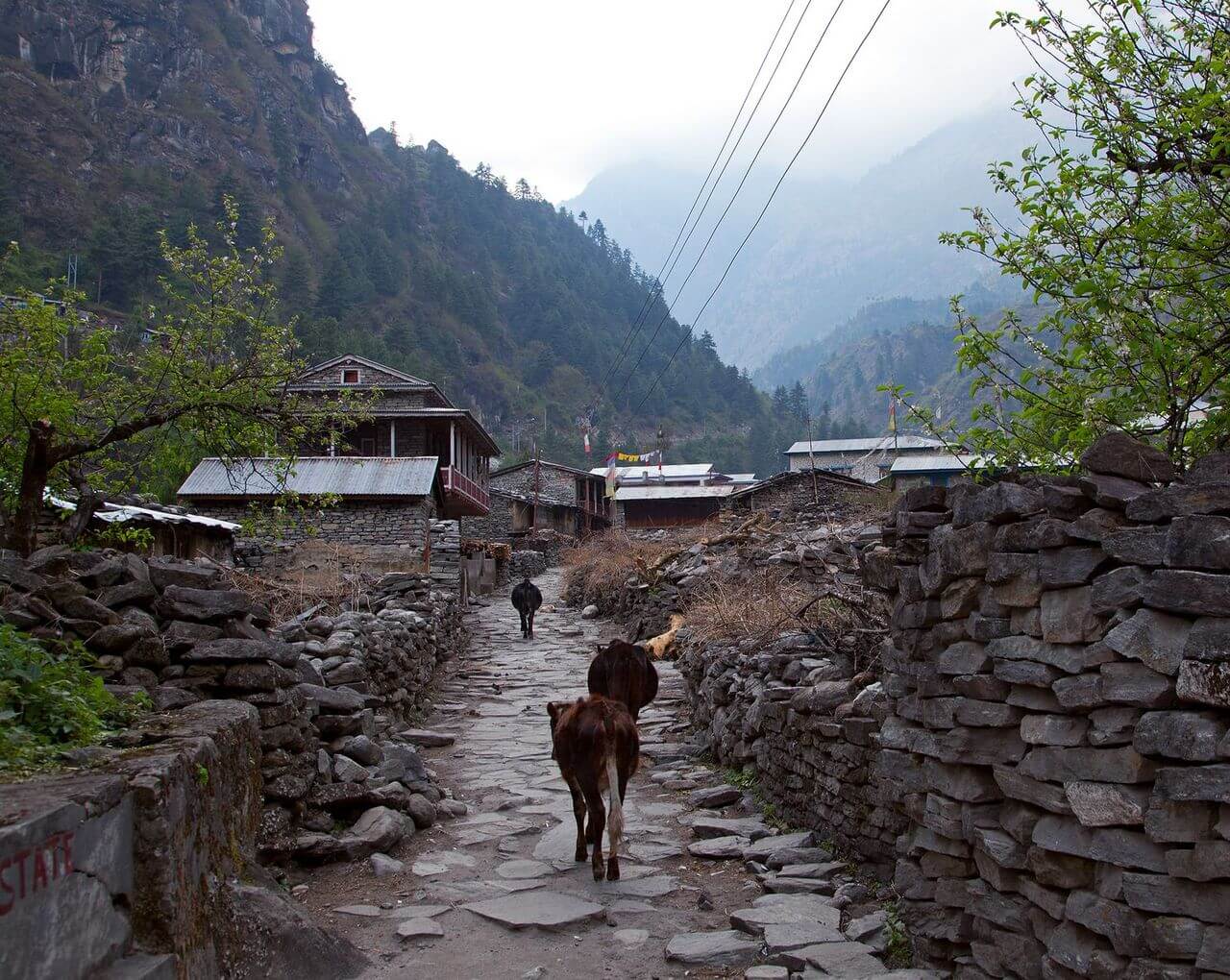
Walking through the beautiful villages, you cross the bridge over the Dudh Koshi river and head past several Mani walls and an arch to arrive at Thonje village. The trail further leads to the occasional police check-posts before entering the route to Annapurna Circuit at Dharapani.
From here, you can hire a jeep or even take a local bus to Besisahar from Dharapani. It makes you about 4-5 hours to reach Besisahar from Dharapani.
Day 14: Drive from Besisahar (760m) to Kathmandu (1,400m) – 5 to 6 hours
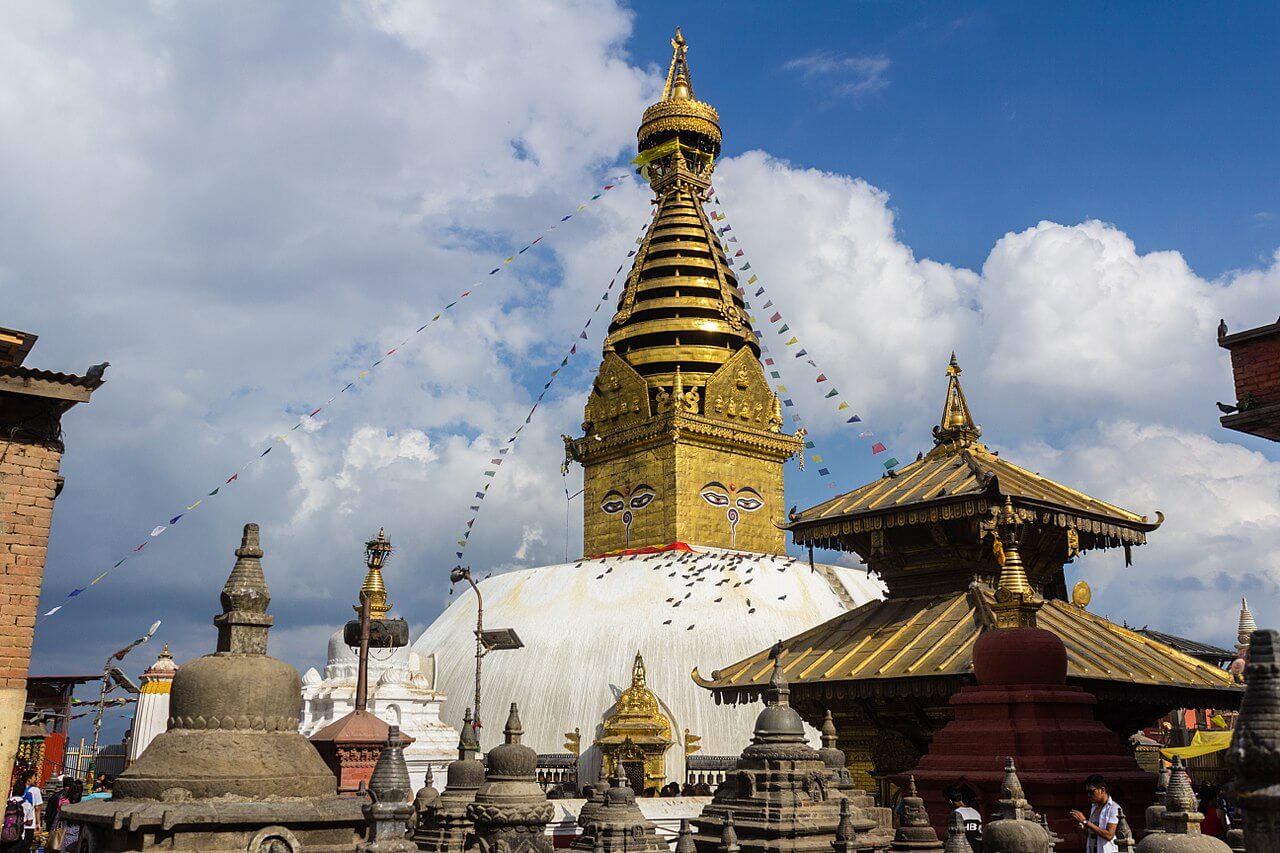
Begin in the morning with a scenic drive across several small villages. You drive along the Prithivi Highway, enjoying the beautiful scenery of hills, flowing rivers, terrace fields, small towns, and occasional mountains.
After driving for about 5-6 hours, you’ll reach Kathmandu.
Tsum Valley Extension
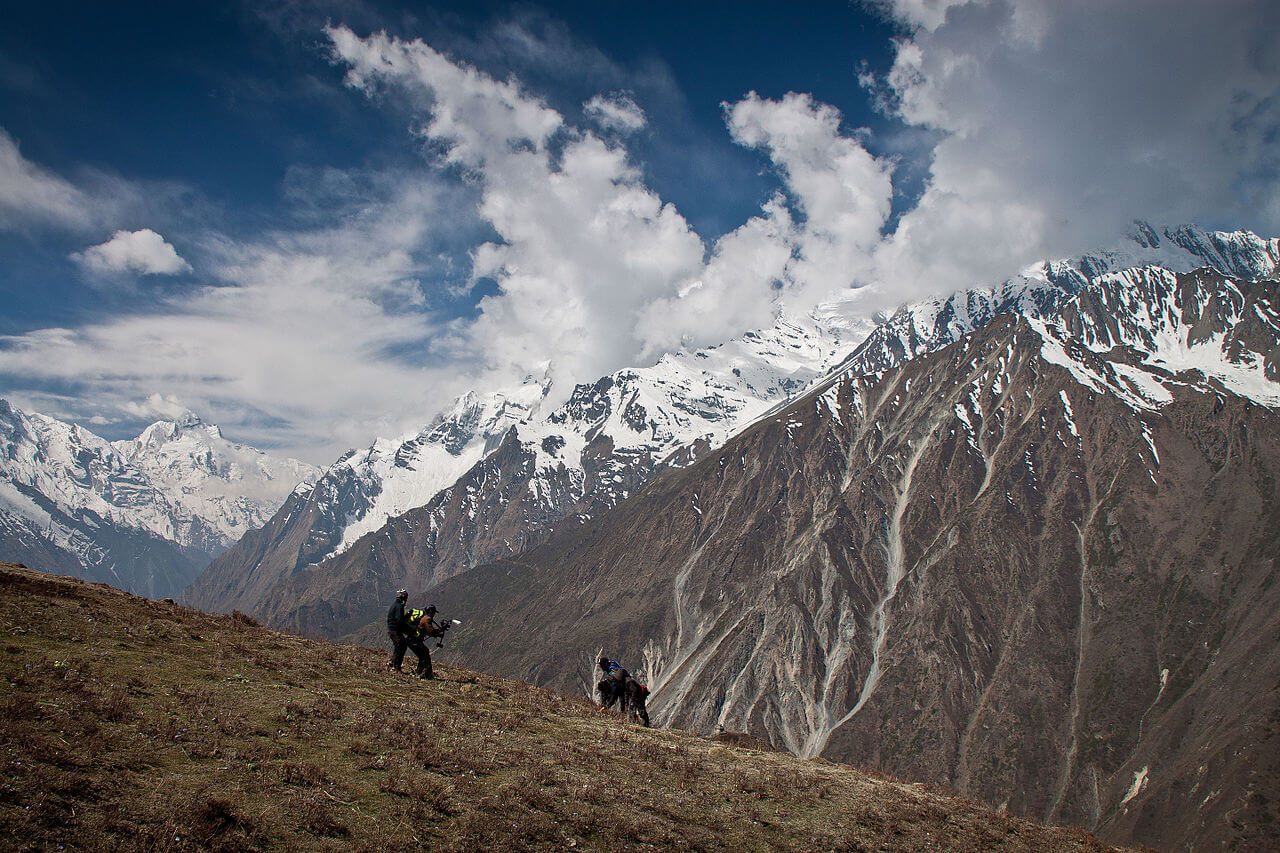
If you have a few extra days, you can extend your Manaslu trek for another week by adding Tsum Valley Trek to your itinerary. The trail to Tsum Valley is even more isolated and remote compared to that of Manaslu Circuit.
Tsum Valley Trek offers an authentic experience with ancient art culture, Himalayan valleys, and spectacular mountain scenery. This trek rewards the incredible mountain spectacles with Ganesh Himal, Shringi Himal, and Boudha Himal surrounding the trail.
Tsum Valley Trek is an opportunity for local experiences as the trek is well-known for its warm hospitality and traditional homestays. You’ll also get an insight into Tibetan Buddhism as you will be exploring the ancient Buddhist monasteries, including Milarepa’s Cave, Mu Gompa, and Rachen Gompa.
Side Trips of Manaslu Trek
If you have a day or two, Manaslu Trek offers plenty of marvelous side trips you can take along with the standard route. Manaslu Circuit has a few more remote and off-the-beaten destinations where only a few dedicated travelers make their ways. Therefore, if there is enough time, we highly recommend you consider some of these options along the trail.
1. Manaslu Base Camp (4,848m)
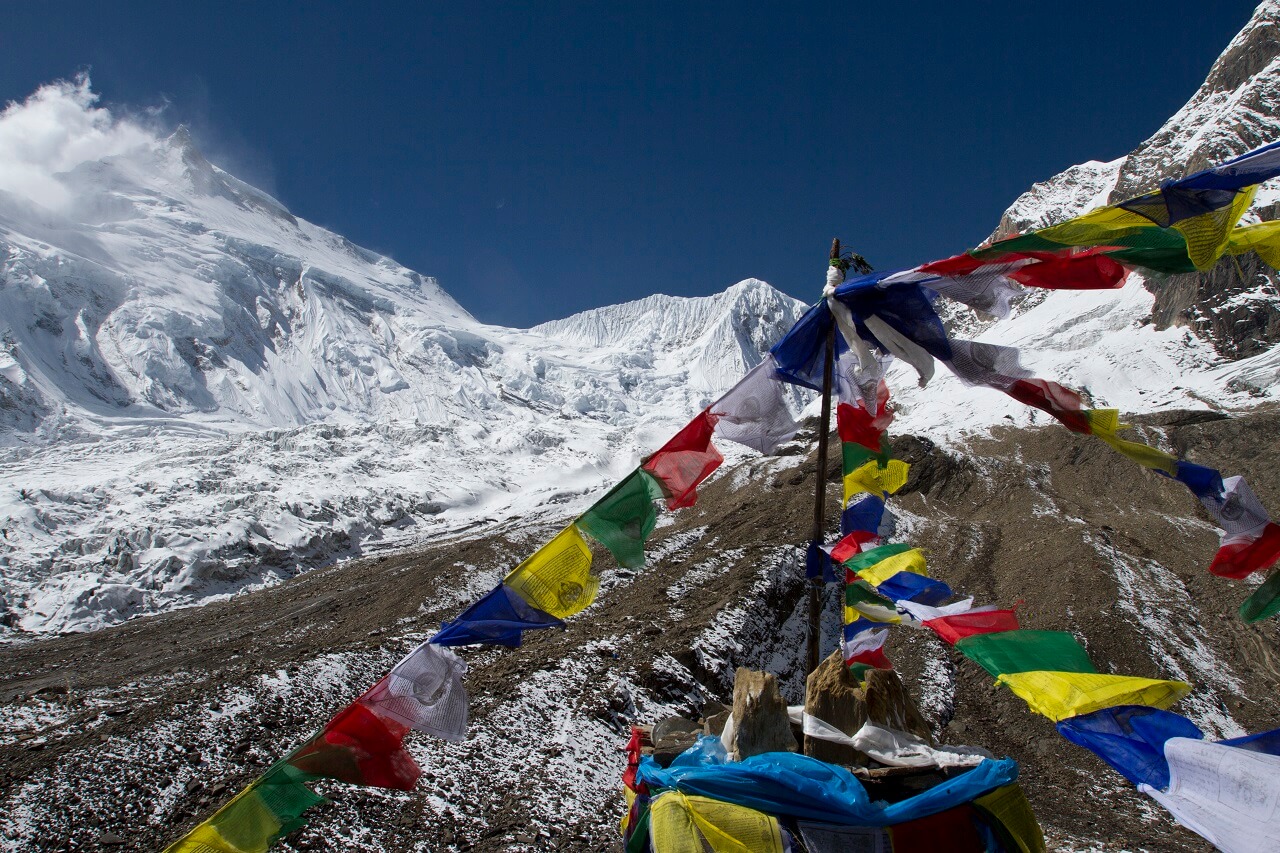
Manaslu Base Camp is an excellent side trip of Manaslu Circuit Trek. The entire trip to the base camp of the world’s 8th highest mountain takes about 6 hours for average trekkers.
The trail to the Manaslu Base Camp diverts from the Manaslu Circuit route in Samagaon. There are two different alternatives to go to the base camp. The first one is to take the course to Birendra Lake, then head to the base camp. Another one is to walk out of Samagaon, take the left lane, and head directly to the base camp. A small Chorten surrounded with colorful prayer flags marks the Manaslu Base Camp.
2. Birendra Lake (3,620m)
Birendra Lake is by far the most popular side trip in Manaslu Circuit Trek. Formed from the melting ice of Manaslu, you can reach this glacial lake in about half an hour from Samagaon.
Most of the trekkers visit this pristine lake on the acclimatization day in Samagaon. To visit this lake, you’ll have to follow the trail opposite to Mount Manaslu Hotel. The roads to the lake can be slightly tricky, so keep your eyes on the path.
3. Kalmachum Lake (3,800m)
Kalmachum Lake, also known as Kal Tal, is a high altitude lake situated at an elevation of 3,800m. You’ll have to hike for an entire day from the village of Prok to reach this lake.
Dense forests with Langurs, fir, and pine surround the trail to Kalmachum Lake. The first few hours of the hike is steep uphill, which later turns to a gradual walk until you arrive at the lake. You can see the splendid view of Prok and Kok village from the top.
4. Hinang Gompa (3,100m)
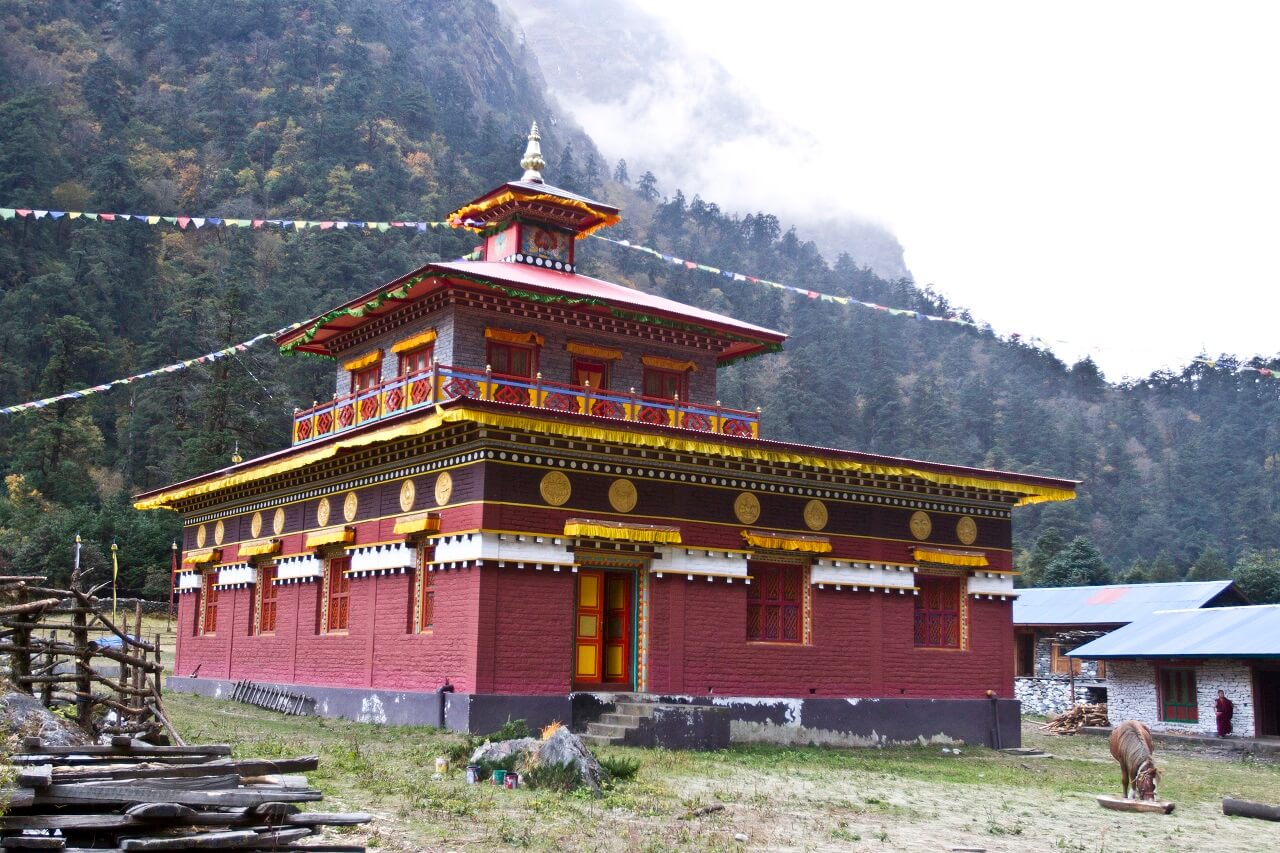
Hinang Gompa is a beautiful monastery that sits on the top of a hill decorated with Mt. Himalchuli in the backdrop. The road to this monastery diverts from 20 minutes away from Lihi village.
This monastery is a decade old and currently also serves as a Lama school. If you hike further up from the monastery, you’ll also get to visit Hinang glacier.
5. Serang Gompa (3,100m)
Located in the foothills of Shringi Himal, Serang Gompa is one of the most secluded and spiritual monasteries in Manaslu Circuit. Since the valley surrounding gompa is said to be the place where Guru Padmasambhava once meditated, it is one of the must-visit side trips in the trek.
Shringi Himal on the backdrop also carries a religious significance. Dense woodland, beautiful Chorten, Mani walls, and suspension bridge encompass the route to the monastery.
Best Time to Trek Manaslu Circuit
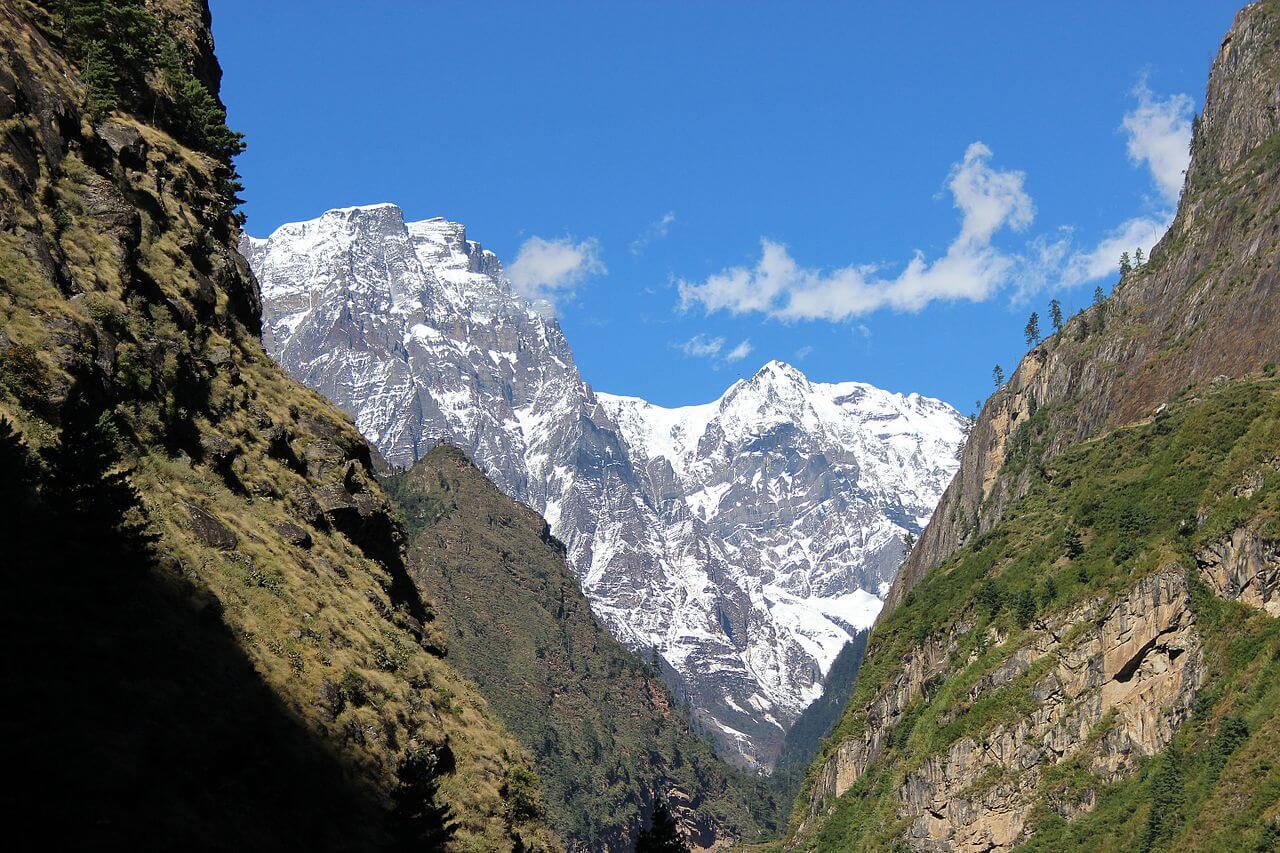
The best time to trek in Manaslu Circuit is during Spring (March to May) and Autumn (September to November). Since the weather conditions during these seasons tend to be moderate, and the skies are usually clear, people consider it to be the most favorable time to go trekking in Nepal.
Traveling during Spring and Autumn means the temperature is relatively moderate for walking and tends to remain more stable. You also enjoy the marvelous views of the mountains and landscapes as the skies remain clear even during the days.
Unlike most of the treks in Nepal, Manaslu is not a year-long trekking destination. Since you’ll be walking through the landslide-prone areas, it is not advisable to trek to Manaslu during the Monsoon (June to August).
Winter (December to February) are usually cold and snowy. You’ll have to walk through the moraines of the glaciers and cross over Larkya La Pass on this trek. Therefore, trekking in winter will be quite tricky. So, it is not advisable to trek to Manaslu during this time of the year.
Here’s a table with average temperature and rainfall details throughout the year for locations en-route to Manaslu Circuit:
Manaslu Circuit Trek Difficulty
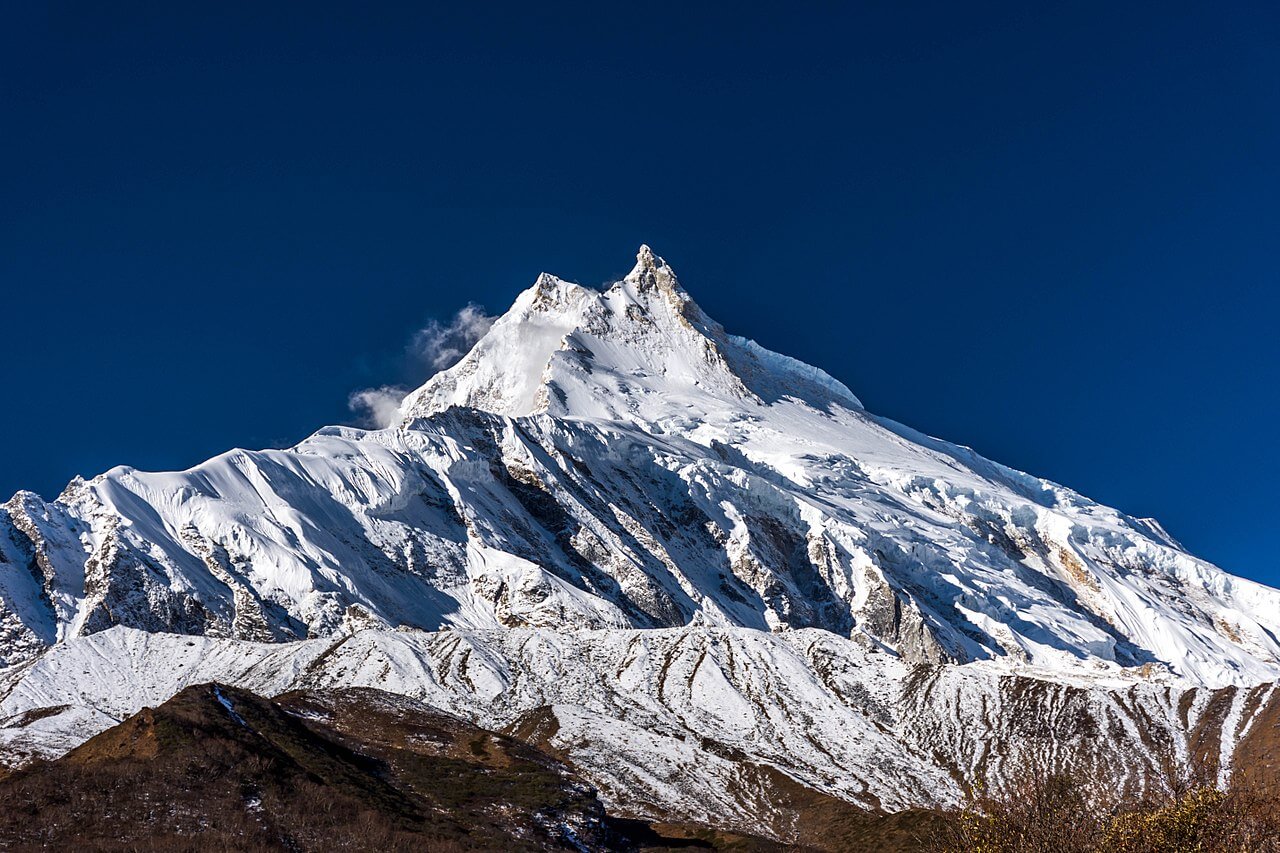
Manaslu Circuit Trek is a wild and remote adventure destination in the high Himalayas of Nepal. This trek is considered to be relatively strenuous and challenging as the trekkers will have to hike through rustic villages, diverse terrains, moraines, and Himalayan passes.
The trek covers approximately 177 km of the total distance. On the standard 18-days itinerary, you’ll have to walk around 10-12 days averaging 15-20 km per day.
This trek also covers massive altitudinal variations, starting from 815m at Soti Khola to 5,135m at Larkya La Pass. The biggest challenge of the entire trek is to cross the Larkya La Pass. Therefore, it is advisable to be cautious regarding the altitude and make sure to know the symptoms of Acute Mountain Sickness (AMS).
The weather in the Himalayas is unpredictable and harsh, especially in the upper reaches of the trek. Although the days are moderately warmer, the temperature drops extensively during the nights. Therefore, it is highly recommended to prepare yourself for the harsh weather. A waterproof hiking boot, decent down jacket, and a proper sleeping bag are highly advisable while trekking in Manaslu.
Physical fitness and mental preparation should be highly considered to take on the challenge of Manaslu. Before committing yourself to the adventure, make sure to train well, and engage yourself in the cardio-related activities as much as possible.
Manaslu Trek Permits
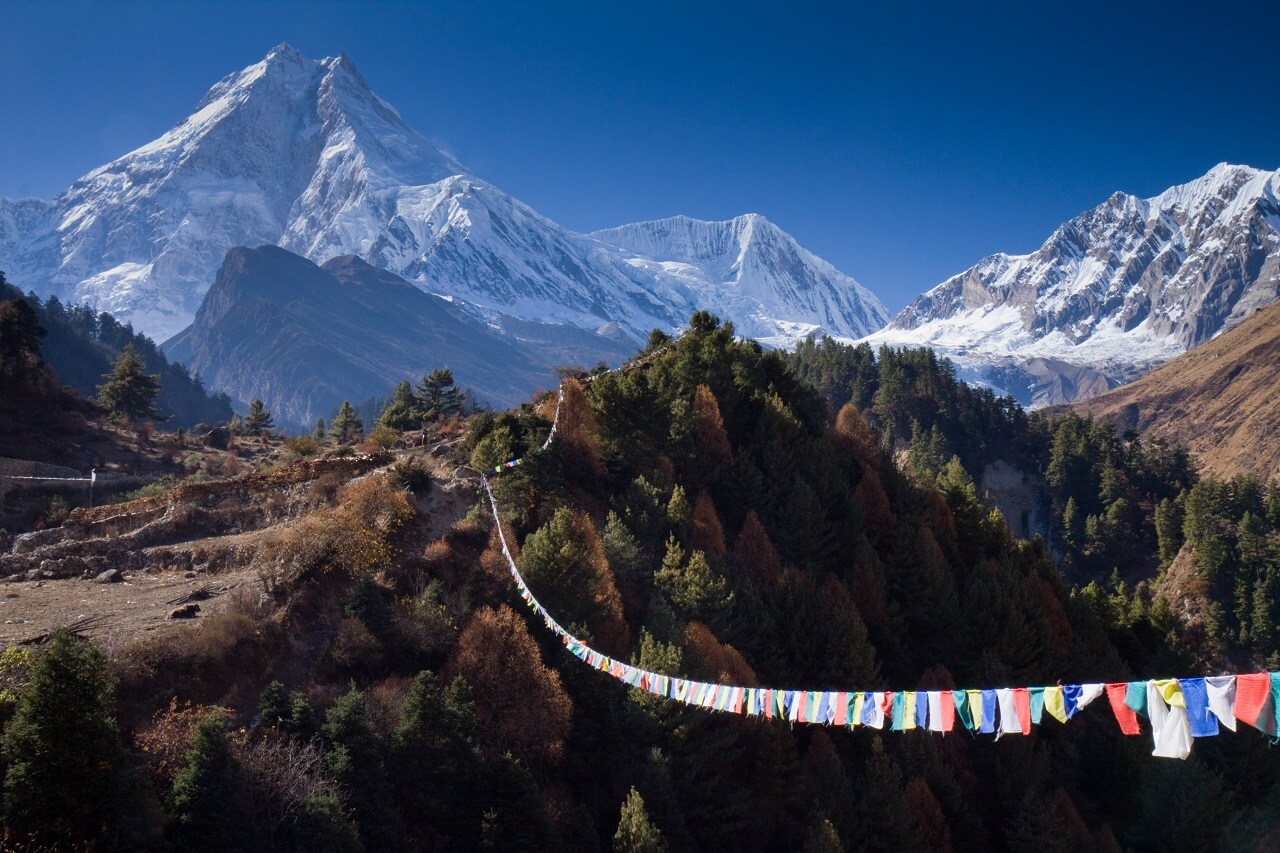
To maintain sustainability, the government of Nepal has declared the Manaslu region as a restricted area applicable from Jagat to Dharapani. So, you need to acquire a special restricted area permit (Manaslu RAP) while trekking to Manaslu. In the Autumn season (September to November), the cost of the special permit for Manaslu is $70 per person for the first week with an additional fee of $10 each day after that. For the rest of the year, the cost drops to $50 for the first week with an additional fee of $7 per day. You do not require a printed photograph for the special permit as the photograph will be uploaded online and printed out with the permit.
You will also need to acquire MCAP (Manaslu Conservation Area Project) Permit as well as ACAP (Annapurna Conservation Area Project) Permit for this trek. Both ACAP and MCAP cost about $27 per person for international trekkers. For SAARC nationals, the cost of both the permits is only $2. The price of these permits remains the same throughout the year. Both these permits require printed photographs.
You can issue the restricted area permit (Manaslu RAP) from the Department of Immigration. You can fill up the permit form online at http://online.nepalimmigration.gov.np/trekking-permit .
You can issue the MCAP and ACAP at following Entry Permit Counters:
- Nepal Tourism Board, Kathmandu – ACAP & MCAP
- Nepal Tourism Board, Damside, Pokhara – ACAP
- ACAP Entry Permit Center, Besisahar, Lamjung – ACAP
Usually, you can not issue the entry permits from any other counters in the trail. However, in exceptional circumstances, other permit counters also grant the licenses with a 100% additional charge.
Additionally, if you choose to extend your Manaslu Circuit Trek with Tsum Valley, you’ll have to issue a separate restricted area permit. It will cost you $40 per person for the first seven days with an extra $7 each after the week during the Autumn. During the rest of the year, the cost drops to $30 per person for the first week with an additional $7 each.
Also, trekking independently is not allowed in the Manaslu region. The government rules state a minimum of 2 trekkers along with a guide/porter is mandatory to do the Manaslu Circuit Trek.
Insurance for the Trek
We recommend you to get travel insurance while trekking in Manaslu Circuit Trek. Unlike most of the trekking routes in Nepal, trekking in Manaslu is quite a challenge and requires serious commitment.
Since this trek is remote and isolated, there are no proper health posts on the trail. If any trekkers get into severe medical conditions, the only way out of this trek is helicopter evacuation.
Make sure to buy individual travel insurance that comprises all the necessary medical costs, helicopter evacuation, trip cancellation charges, theft, and natural disasters. If you’re looking for decent travel insurance, we recommend you to buy it from World Nomads.
Guided vs. Independent Trek
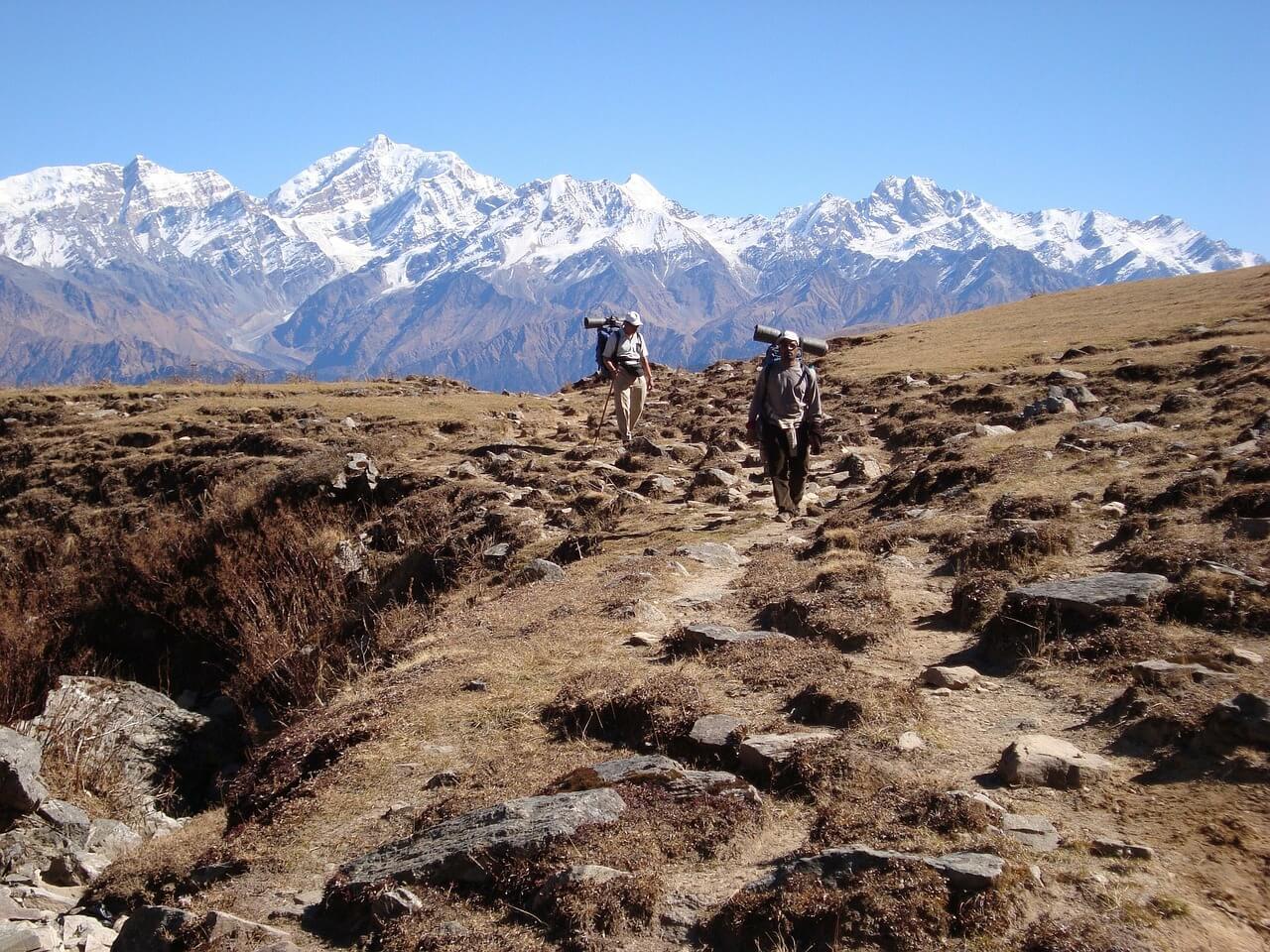
Manaslu Circuit Trek falls under the restricted area, which requires a mandatory trekking staff, either a registered guide or porter cum guide, to trek in this region. The Government of Nepal has declared that any foreign trekkers trekking to the Manaslu region must have a special permit to travel the area.
As per the policies, a minimum of two trekkers with a registered trekking guide is mandatory for this trek. Therefore, trekking independently in Manaslu Circuit is not possible for foreign tourists.
The trail to Manaslu is remote and challenging with very few dedicated trekkers making their way in this region. Additionally, there are a few places, marked landslide-prone zone. Therefore, it is essential to have a guide while trekking in Manaslu Circuit.
However, if you’re willing to go without a guide, the only alternative is to hire a porter cum guide. While hiring a porter-guide may cost you a little cheaper than registered guides, most of them do not speak fluent English.
Accommodation and Food
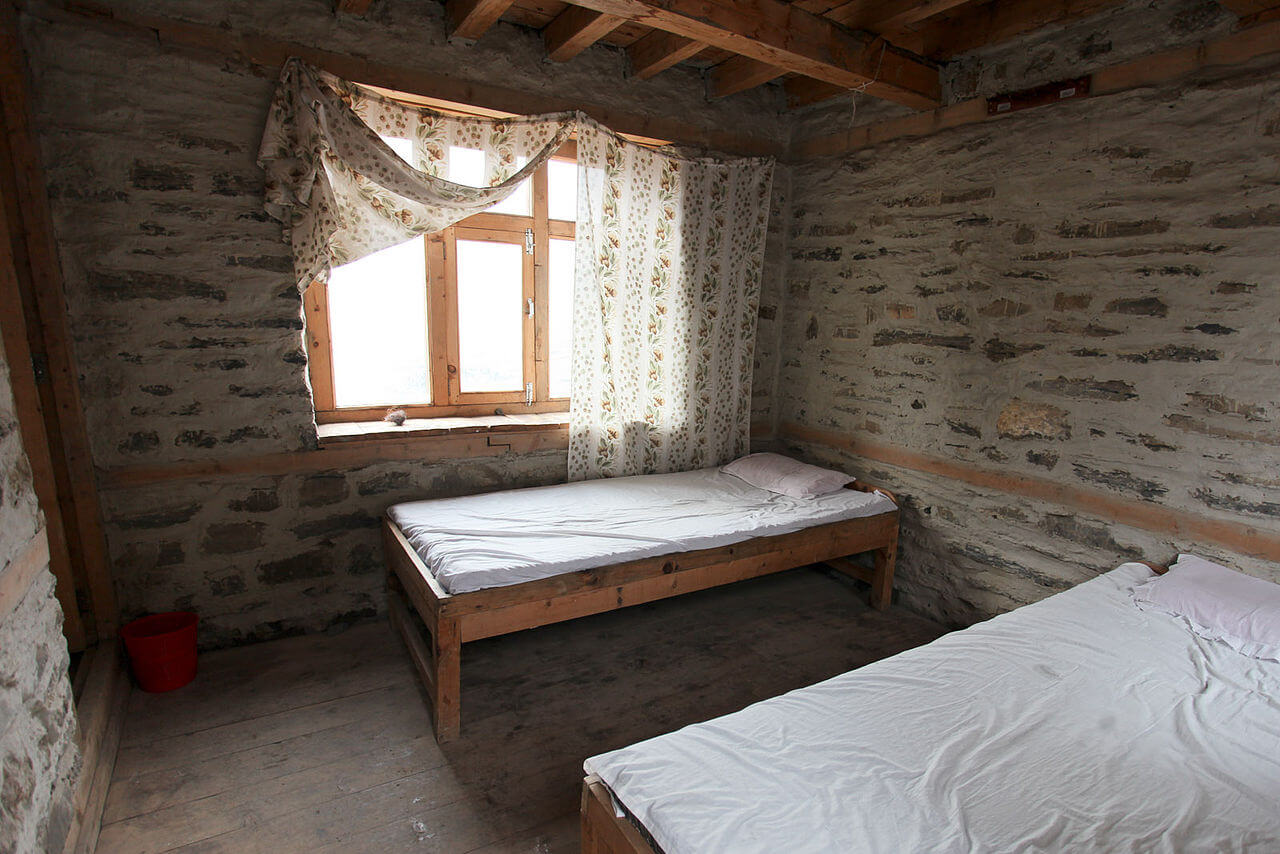
Teahouses and local lodges facilitate the entire trail of Manaslu Circuit, except in Dharmasala. In Dharmasala, you may occasionally have to sleep under a tent. The local communities of the region operate the teahouses and lodges in the Manaslu region.
The rooms are quite basic, with two standard single beds. The toilets are mostly shared and are outside the teahouse at some places. The heating facility is only available in the dining hall.
Unlike Everest and Annapurna treks, there are no luxury hotels in Manaslu. Most of the lodges do provide a hot shower facility; however, you may have to pay extra money for the service.
The teahouses of Manaslu also provide a menu with a variety of western food. The food somewhat costs cheap in the lower reaches of the trek and increases along with the elevation rise. Also, the food choices on the menu will get limited in the higher section of the trek.
Although the menu offers a variety of western foods, Dal Bhat is the most popular food during the trek.
Manaslu Circuit Trek Cost
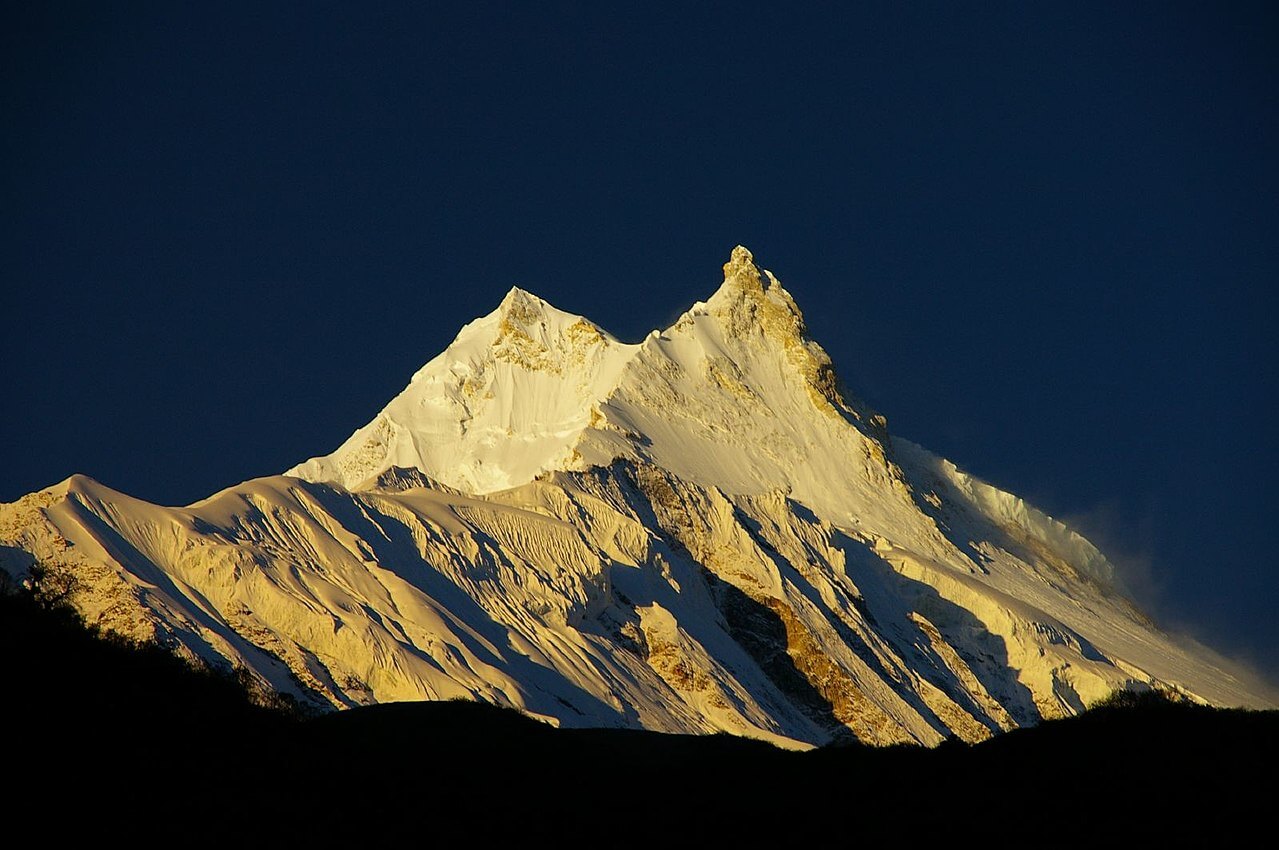
The cost of Manaslu Circuit Trek depends upon various factors such as duration, mode of transportation, lodging, and food. Although this trek is slightly expensive compared to Langtang Valley or Annapurna Base Camp, the remote and untouched beauty of Manaslu is worth every penny.
Since Manaslu trek lies in the restricted zone, you need a restricted area permit to enter the region. The special permission for Manaslu is $70 per person for one week. After the first week, it’ll cost an additional fee of $10 each day during the Autumn. However, the cost drops to $50 with an additional fee of $7 each day for the rest of the year. You’ll also need ACAP and MCAP for Manaslu trek, which will cost you approximately $27 each.
Additionally, if you choose to extend your Manaslu Circuit Trek with Tsum Valley, you’ll have to get a separate restricted area permit. The charge of Tsum Valley permits costs $40 per person for the first seven days with an extra $7 each after the week during the Autumn. For the rest of the year, the cost drops to $30 per person for the week with an additional $7 each day.
The teahouses are relatively cheap in Manaslu, costing you as little as $6 to $9 per night with an additional $5 per meal. The local buses to Soti Khola from Kathmandu costs you about $10 per person. However, traveling by jeep is more expensive, costing you roughly $150 to $200 per person.
Since Manaslu Circuit Trek lies in the restricted area, it is mandatory to have a licensed guide or a porter on the trek. A licensed guide will cost you about $20 to $25 per day while porters cost you about $15 to $20 per day. You can hire a porter-guide which will cost you $18 to $22 per day.
Packing List for Manaslu Trek
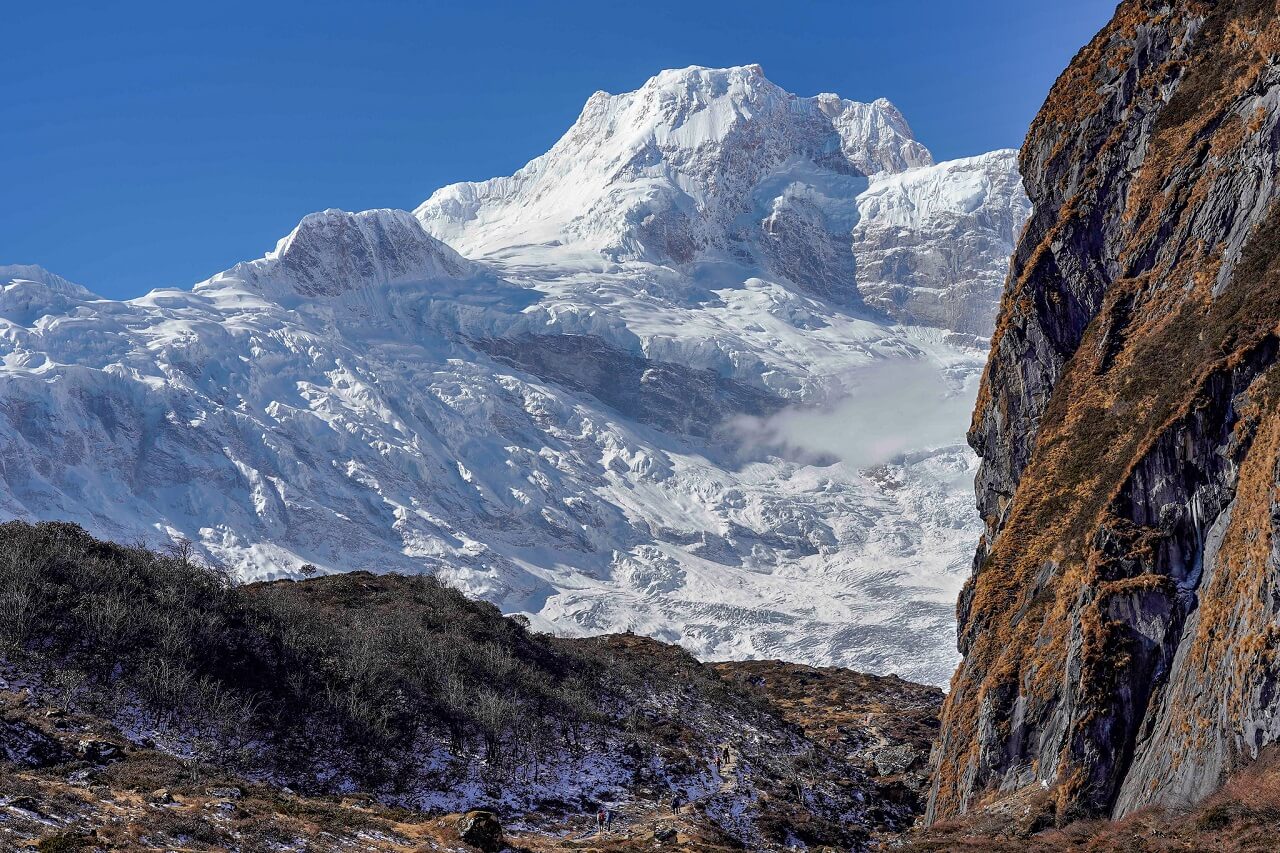
If you’re planning to experience the thrill of trekking to the remote and inaccessible areas of Manaslu, make sure you’re carrying the right equipment. While it is quite a dilemma when it comes to what to pack for the trek, it matters how and when you’re planning to travel.
Since Manaslu does not permit the individual travelers, you’ll have to hire a porter. The porter will carry the substantial portion of the weight, leaving you with the daypack. Hiring a porter does not mean you should be packing everything you can think of for the trek. Although you’ll have someone to help you with the luggage, make sure to pack your bags with right gears.
Here are some of the essential gears you need to pack while trekking to Manaslu Circuit:
- Duffel Bags
- Trekking Shirt: 5-7 shirts, make sure to balance both long and short.
- Trekking Trousers: We recommend you to pack at least 2 trekking trousers along with a couple of shorts.
- Base Layer: Make sure to pack a couple of wool base layers to keep yourself warm in the upper reaches of the trek.
- Insulation Layer: A decent quality of fleece jacket will do!
- Outer Layer: Warm down jacket that will mainly be used in the higher altitudes when the weather gets extreme.
- Waterproof Shell Jacket: Pack a pair of waterproof jackets as you may encounter rain in the trail.
- Breathable Underwear: We recommend you to carry 5-6 pairs of moisture-wicking underwear.
- Hiking Boots: Invest in high-quality waterproof hiking boots. Make sure the boot is lightweight and comfortable.
- Trainers/Sandals: It is handy to carry a pair of either trainers or sandals to wear them in the teahouses.
- Hiking Socks: You should carry 4-6 pairs of hiking socks. Any brand or label works as long as they are breathable and moisture-wicking. Do not bring cotton socks as they soak easily and may lead to blisters.
- Thermal Socks: We recommend you to pack at least a pair of thermal socks to keep your feet protected from the cold in the higher altitudes.
Head Wears:
- Sun Protection Hat: It is mandatory to carry a protection hat to keep your face protected from the harsh sun.
- Beanie: An absolute must to keep yourself warm, especially during the evening and night.
- Buff/Neck Gaiter: This small piece of gear comes in handy to protect your neck from the cold winds and also helps you stay protected from the dust.
- Inner Gloves: Pack light inner gloves as they can be useful when the temperature is moderate.
- Outer Gloves: You’ll be wearing them in the upper reaches of the trek. Outer gloves need to be insulated, warm, and waterproof.
Sleeping Bags:
Sleeping bags are hands down one of the most crucial gears when it comes to trekking in Manaslu region. With basic rooms and sleeping facilities, you can never rely on the teahouses for warm, decent blankets.
In the lower altitudes, this may not seem much of a problem, but once you get above 3,000m, the temperature even inside the teahouses can get cold.
Therefore, investing in a high-quality, 4-season sleeping bag is an absolute must! If you’re not willing to any chances, buy a sleeping bag that has the minimum rating of -10 degrees Celsius.
Important Accessories:
- Trekking Poles
- Water Bottle
- Basic Medical Kits
- UV Protection Sunglasses
- Water Purification Tablets
- Hand Sanitizers
- Sunscreen/Lip Balm
- Trekking Towels
- Portable Chargers
Network Information
If you’re willing to stay connected with your family and friends, we suggest you use CDMA networks over any other service providers in the region. Although NTC and Ncell are the two major telecommunication service providers in the country, they barely come to work while trekking to Manaslu.
One thing you should know beforehand with CDMA networks is that they do not work with every other mobile phone. Therefore, you should buy a phone in Kathmandu to make the most out of their service. The CDMA phones are available in nearly all the mobile shops in the city, and they come quite cheap.
Useful Tips
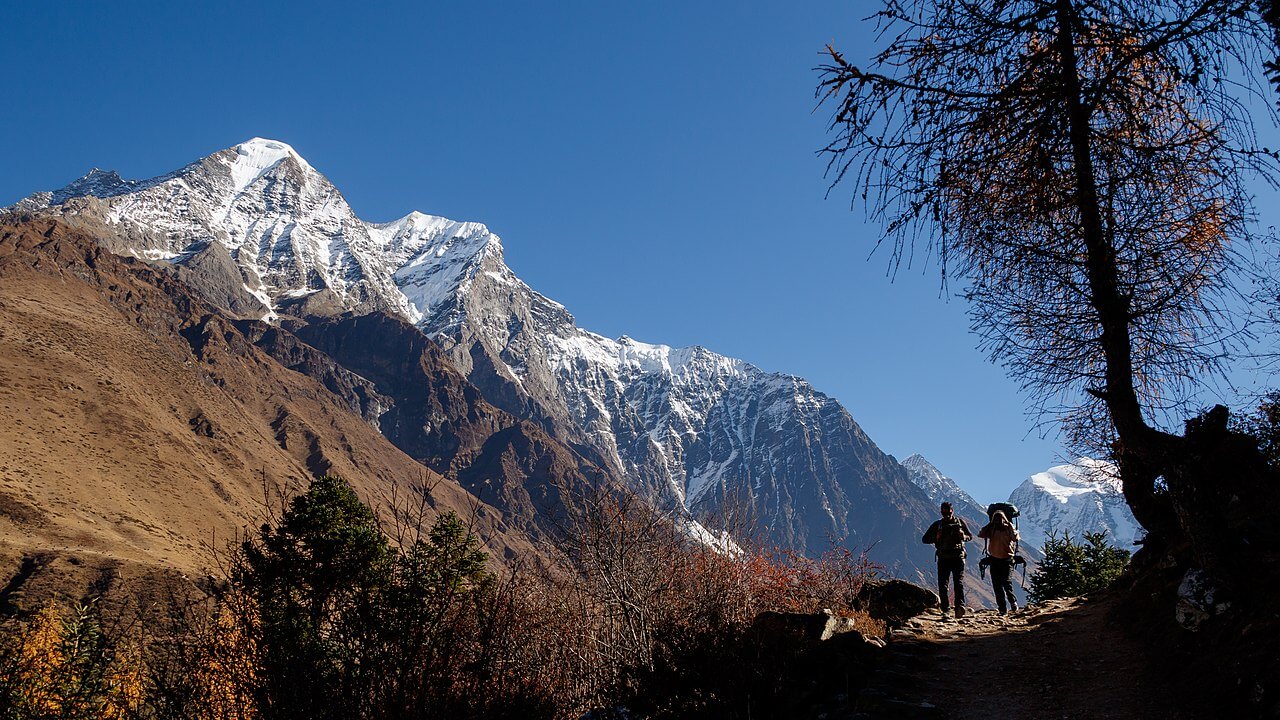
- Manaslu Circuit is one of the most remote and strenuous treks in Nepal. Please make sure to prepare yourself both physically as well as mentally before heading off to the wild.
- Altitude is a constant threat. As the highest elevation point of the trek is whooping 5,135m, it is essential to acclimatize well, take the necessary precautions, and stay hydrated throughout the trail.
- The trails in the Manaslu region are not appropriately marked. Be aware of the route. Always walk with a guide/porter and do not wander off alone in the trail.
- There are several landslide-prone areas in the region. Be careful and watch out for the rocks!
- The trail can be slightly risky when wet and snowy. Therefore, invest in high-quality hiking boots and make sure to pack well for the trek.
- Drinking water may not be safe to drink. A water purifier will be great to have.
- Not all tea houses provide charging facilities. Carrying a portable charger would be handy.
Accommodation in Kathmandu
Thamel is the major tourist hub of Kathmandu. Surrounded by hotels, travel agencies, shops, and restaurants, here you can find accommodations for any budget from cheap hotels to luxury hotels.
However, there are plenty of places outside Thamel where you can find decent hotels in Kathmandu. Some of the accommodation options in Kathmandu are:
Recommended Travel Agencies for Manaslu Circuit Trek
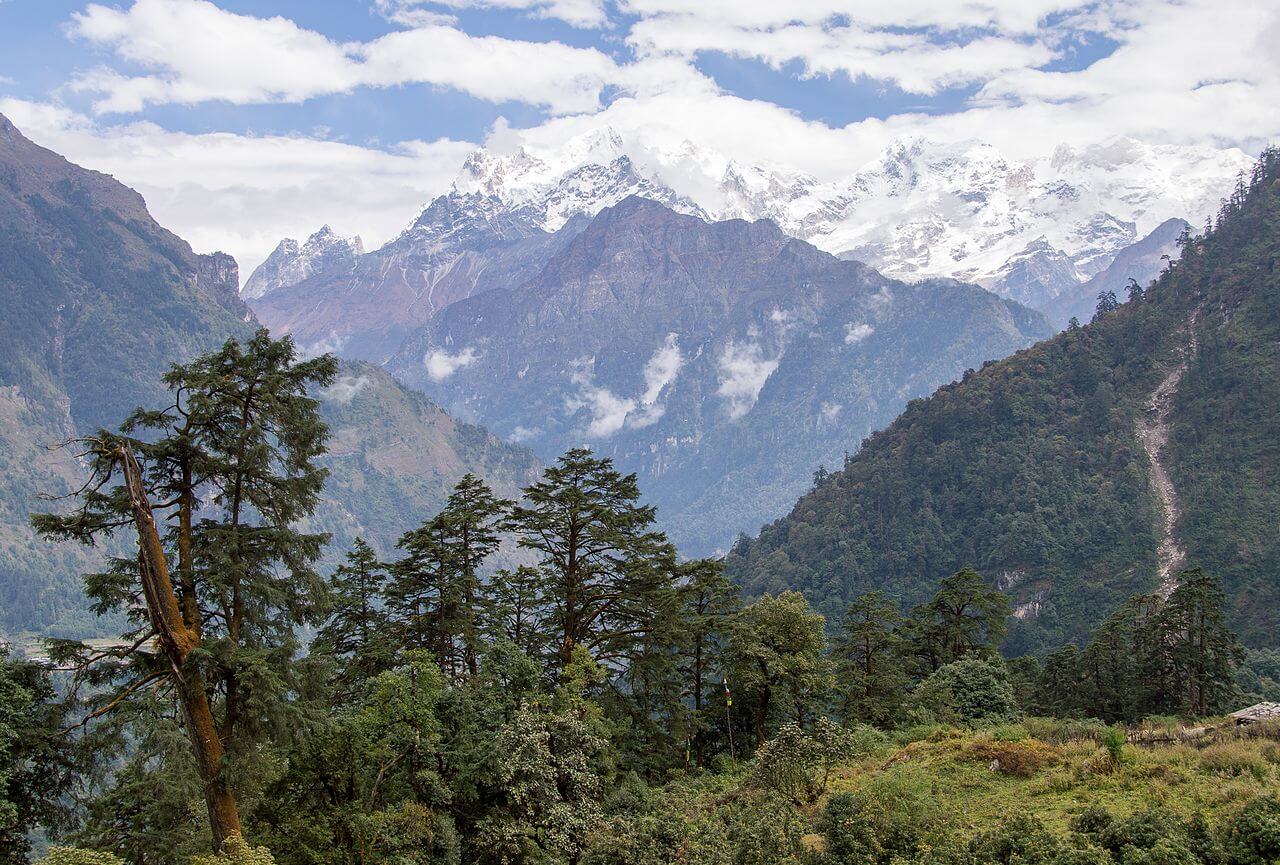
There are thousands of trekking companies that operate the Manaslu Circuit Trek in Nepal. Make sure you’re traveling with an authorized trekking company while trekking in Nepal.
While trekking in the remote and challenging trail of Manaslu Circuit, it is essential to book the trip with an experienced company that ensures breathtaking experience while concerning the clients’ safety.
Some of the best trekking companies in Nepal for Manaslu Circuit Trek are:
- Himalayas on Foot
- Magical Nepal
- Mosaic Adventure
- Nepal Eco Adventure
Recommended Books and Guidebooks
- Manaslu: A Trekker’s Guide
- Lonely Planet Nepal (Travel Guide)
- The Rough Guide to Nepal
- Birds of Nepal
- The Climb: Tragic Ambitions on Everest
- Into Thin Air: A Personal Account of the Mount Everest Disaster
- High Adventure
- The Snow Leopard
1. Is Manaslu Circuit Trek doable?
Although Manaslu Circuit Trek is strenuous and challenging trekking routes in Nepal, this trek is entirely doable. However, you have to maintain a certain level of physical fitness to do this trek. Be aware! Since this is a high altitude trek, you’re also at risk of suffering from Acute Mountain Sickness (AMS).
2. Can I do the Manaslu Circuit Trek solo/independently?
No, the government of Nepal does not permit solo or independent trek in the Manaslu region. As per the government’s rules, it is mandatory to have a minimum of two trekkers accompanied by either a guide or a porter to trek in the Manaslu region.
3. What is the standard of accommodation in Manaslu?
The teahouses and lodges in Manaslu Circuit are basic with two single beds and no heating facilities. The toilets are standard and on sharing basis throughout the trail. Most of the tea houses provide a hot shower but will charge you extra bucks for it.
On the upper reaches of the trek, the accommodations might get draughty and dark. Therefore, we recommend you bring a sleeping bag and a headlamp for this trek. Teahouses are available throughout the trek with the only exception in Dharmasala. At Dharmasala, you may have to spend the night in a tent.
4. Is it safe to drink water in the trek?
No, the water in teahouses is mostly from tap or streams, which is not safe to drink directly. Bottled water is also available throughout the trail. However, the bottled water is slightly expensive and adds more trash on the trail. Therefore, we highly recommend you to carry a water purifier or tablets.
5. Do I need travel insurance before trekking to Manaslu?
Yes, travel insurance is highly advisable while trekking in Manaslu. Since Manaslu is a remote and isolated trek, we suggest you have specific travel insurance for this trek. Make sure your travel insurance covers the cost of necessary medical facilities, theft, natural disasters as well as helicopter evacuations.
Manaslu Circuit Trek is an excellent alternative to the commercial trekking routes like Annapurna and Everest Base Camp. Tucked in the remote region in the Himalayas of Nepal, Manaslu is a sanctuary for adventure enthusiasts and avid trekkers.
As this is one of the most demanding treks of Nepal, this trek demands a serious commitment and physical fitness.
Similar Posts
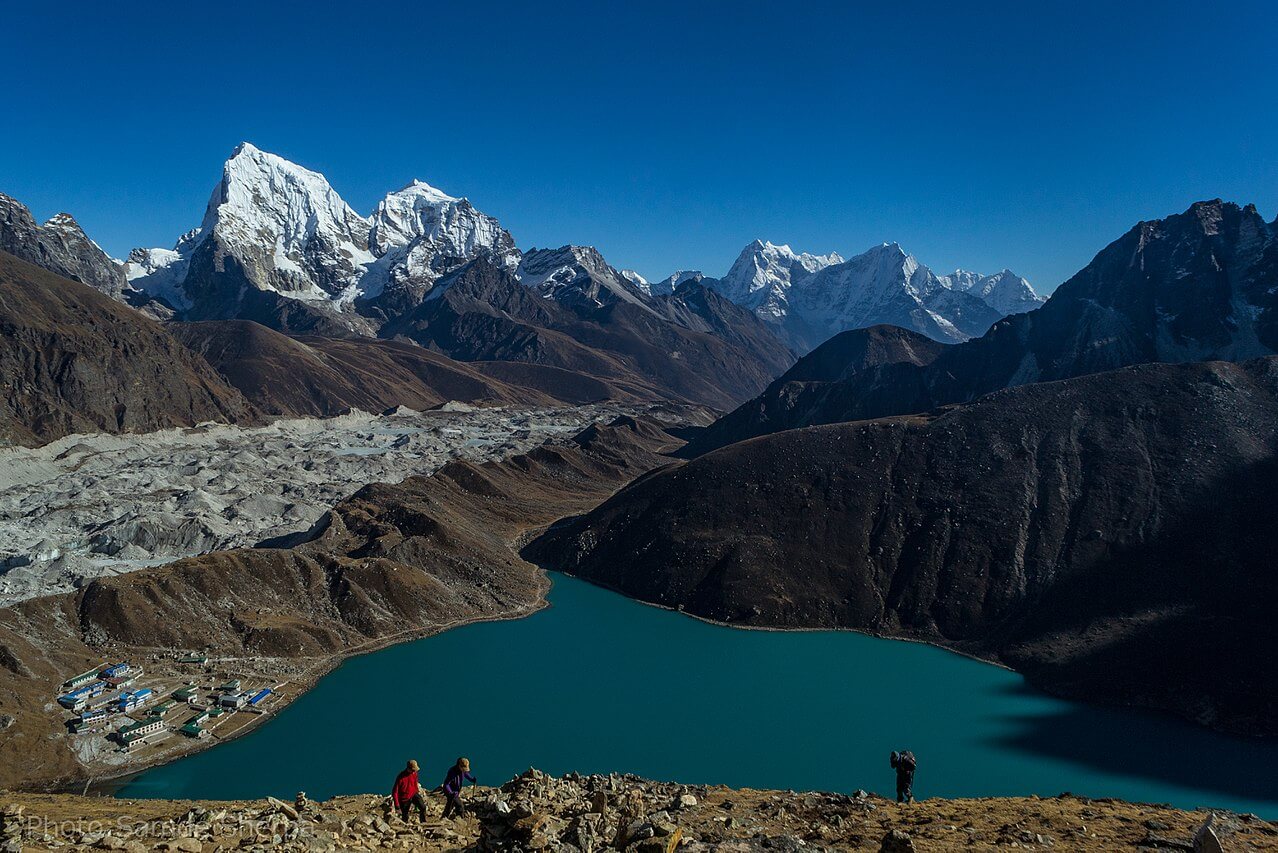
Gokyo Ri Trek
Gokyo Ri Trek, the best alternative trail to the Everest Base Camp Trek, offers exceptional views of the Himalayan peaks along with lakes and glaciers. Gokyo Ri Trek is a moderate trek in the high Himalayas of the Everest region. Instead of traveling to the more commercial Everest Trek, trekkers often choose this itinerary to…
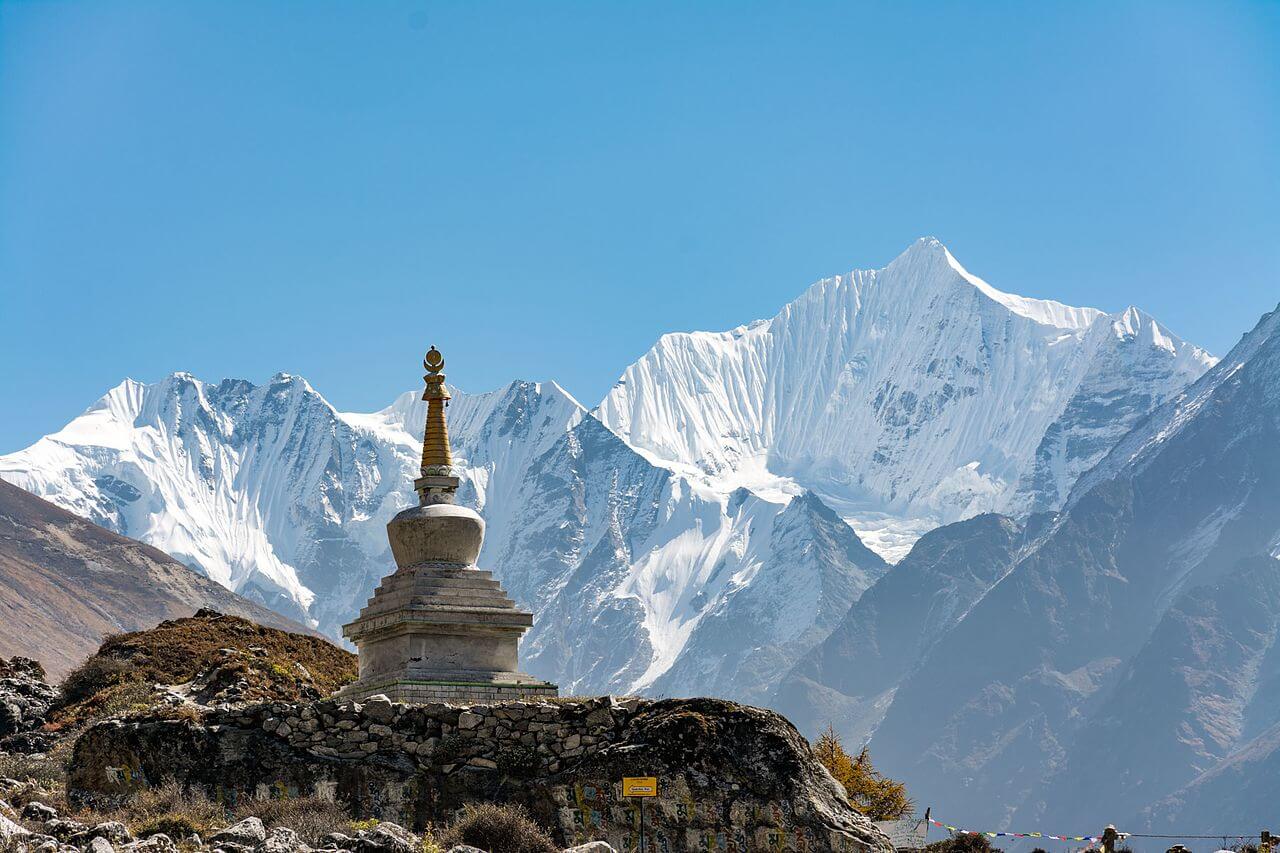
Langtang Valley Trek
Langtang Valley is a classic trekking destination, located only 61.8km away from aerial distance, north of Kathmandu. Although the Langtang Valley Trek is relatively short, accessible, and cheap, the trails are quieter with less number of trekkers compared to other classic trekking destinations in Nepal. The trek is ideal for both experienced trekkers as well…
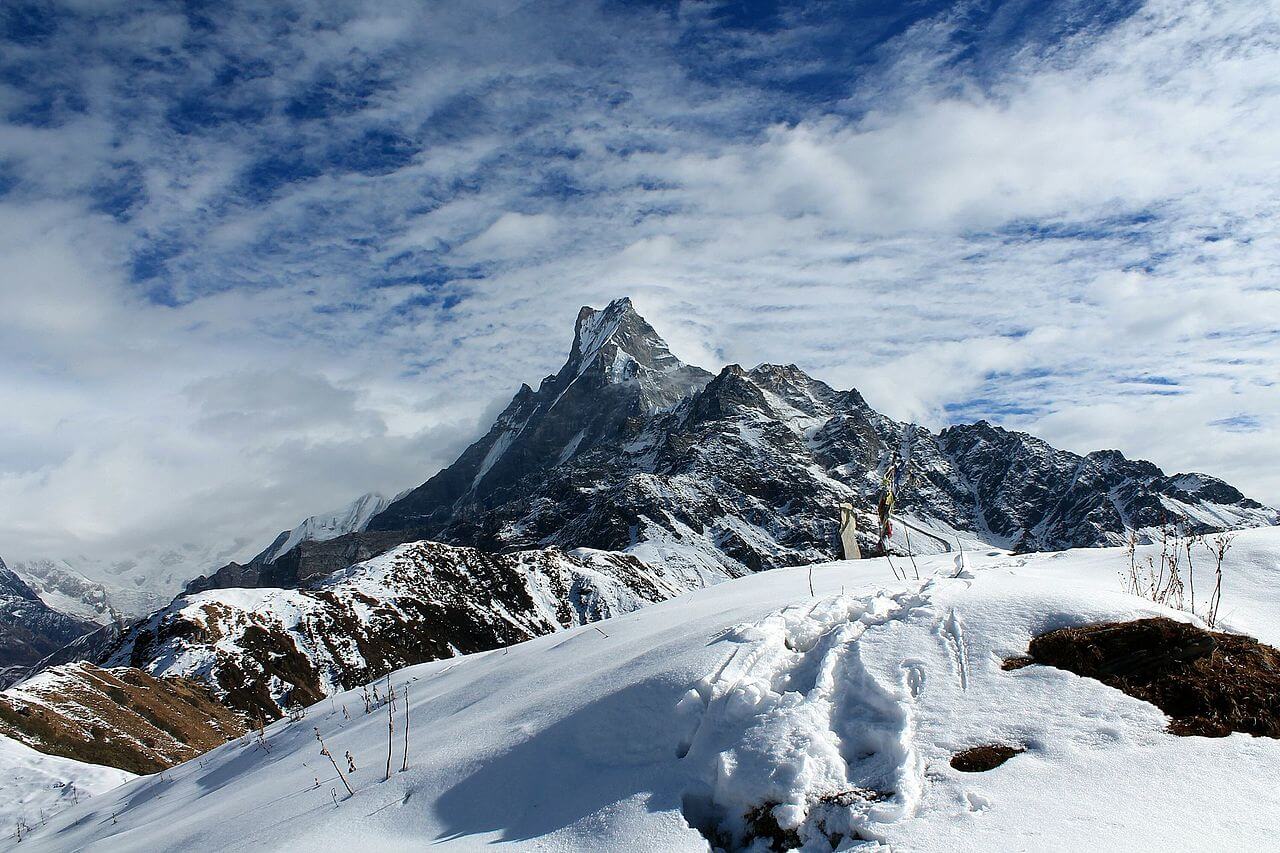
Mardi Himal Trek
Mardi Himal Trek is a hidden gem for the dedicated trekkers and backpackers. Located eastwards of the classic Annapurna Base Camp, this trekking route is yet to witness a large crowd like other commercial treks in Nepal though it officially opened for all in 2012. The richly diverse terrains of Mardi Himal takes you across…

The World on my Necklace
A Travel Blog by Katie Chavez
Complete Guide To the Manaslu Circuit Trek
This post may contain affiliate links. If you make a purchase through an affiliate link, I will earn a commission at no extra cost to you. Thanks for your support.
The Manaslu Circuit Trek is a trekking route in Nepal that encircles the imposing Mount Manaslu, the eighth-highest peak in the world.
This 13-day trek takes you through diverse landscapes, snow-capped peaks, rugged terrain, lush valleys, and traditional Tibetan-influenced villages.
The Manaslu Circuit Trek is known for its remote and pristine beauty, offering an authentic Himalayan experience away from the crowds of more popular trekking routes.
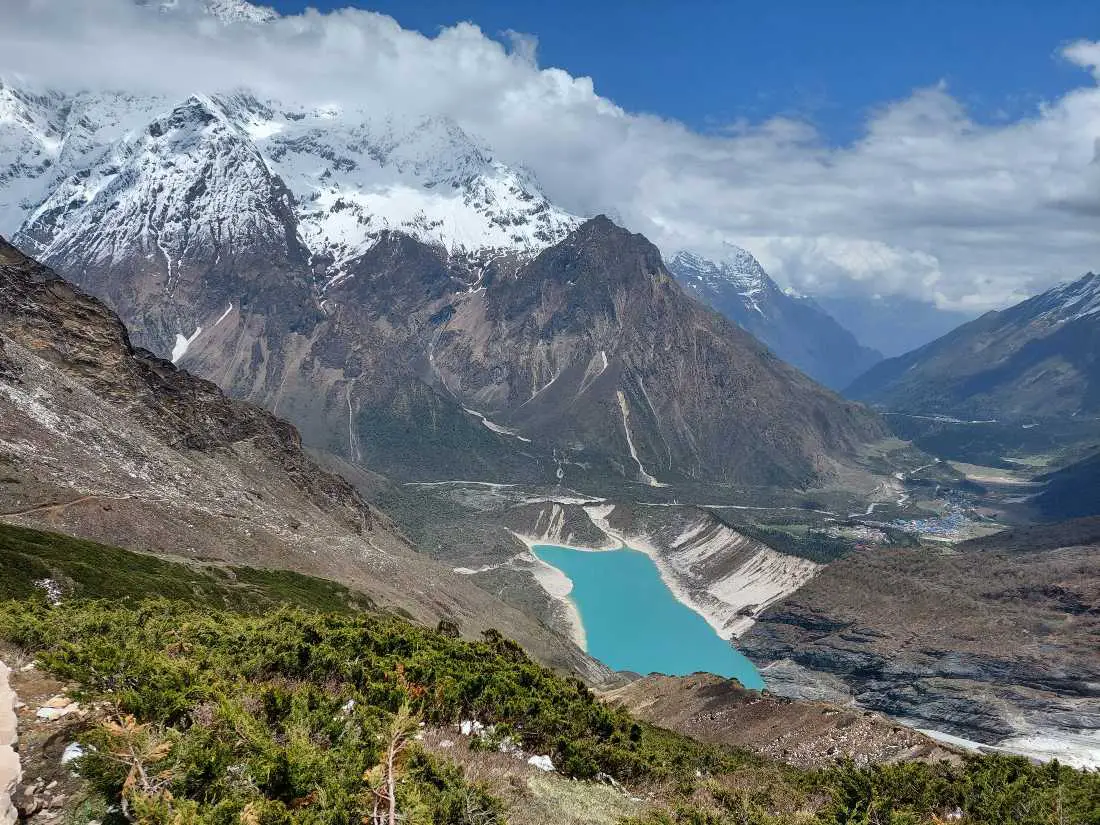
Things To Know Before Embarking on the Manaslu Circuit Trek
High altitude.
The Manaslu Circuit Trek reaches elevations exceeding 5,000 meters (16,400 feet), including the challenging Larkya La Pass at approximately 5,106 meters (16,752 feet). Altitude sickness can be a concern, requiring acclimatization and careful monitoring of symptoms.
Remote and Isolated Terrain
The Manaslu Circuit traverses remote and rugged terrain, far from major urban centers. Facilities such as lodges and medical assistance are limited, necessitating self-sufficiency and emergency preparedness.
Variable Weather Conditions
Weather in the Himalayas can be unpredictable, with conditions ranging from clear skies to heavy snowfall and blizzards. you must be prepared for cold temperatures, high winds, and potential weather-related challenges.
Long Trekking Days
The trek typically involves long days of hiking, often spanning 6 to 8 hours or more, with steep ascents and descents. Stamina and physical fitness are essential for completing each day’s trekking itinerary .
Permits and Regulations
The Manaslu Circuit Trek requires obtaining special permits from the Nepalese government. Independent trekking is not allowed in the Manaslu Region. Only a local registered local company can issue the permit.
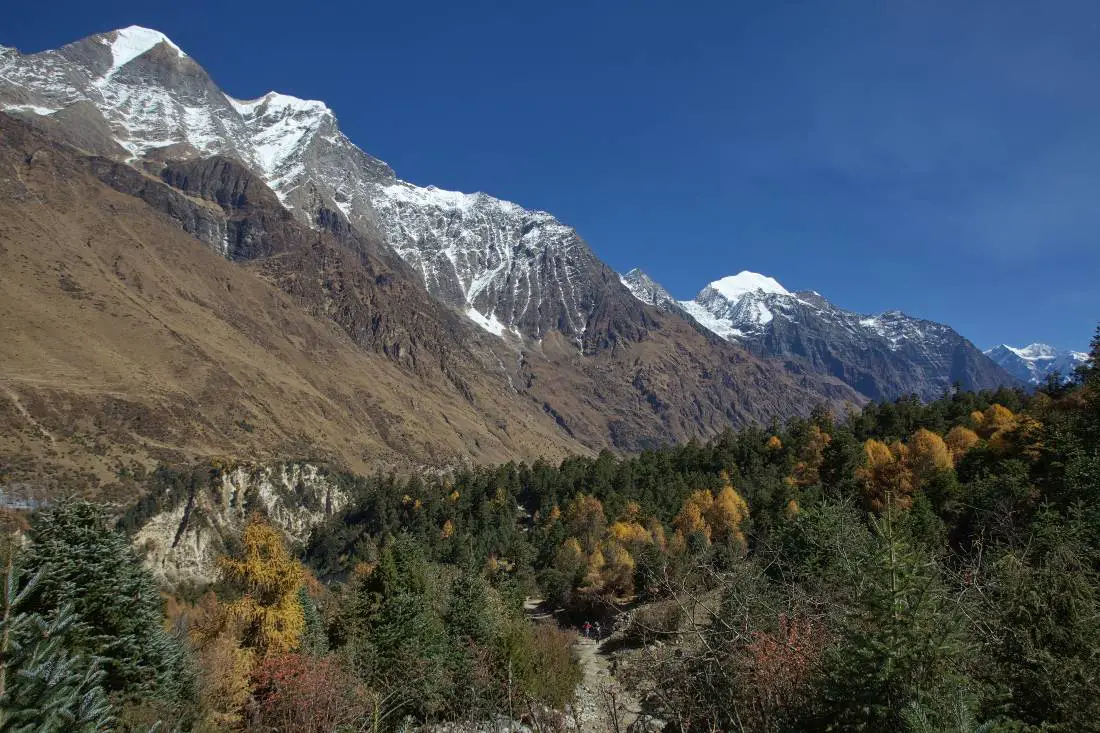
Itinerary For The Manaslu Circuit Trek
Day 1: kathmandu to macha khola.
Your adventure begins with a scenic journey from Kathmandu to Macha Khola. This can be done either by private jeep or local bus. The drive takes approximately 6-8 hours, offering glimpses of the countryside and the foothills of the Himalayas.
Macha Khola, a small village nestled along the Budhi Gandaki River, serves as the official starting point for the Manaslu Circuit Trek. Here, you’ll settle into your teahouse accommodation and prepare for the trek ahead.
Day 2: Machha Khola To Jagat
The trail from Machha Khola follows the Budhi Gandaki River, initially through a narrow path along the Khoralabesi village. You’ll encounter several small streams cascading down the mountainsides, eventually merging with the Budhi Gandaki.
One of the highlights of this day is Tatopani, a natural hot spring where you can take a relaxing dip to soothe your tired muscles after the first day’s travel.
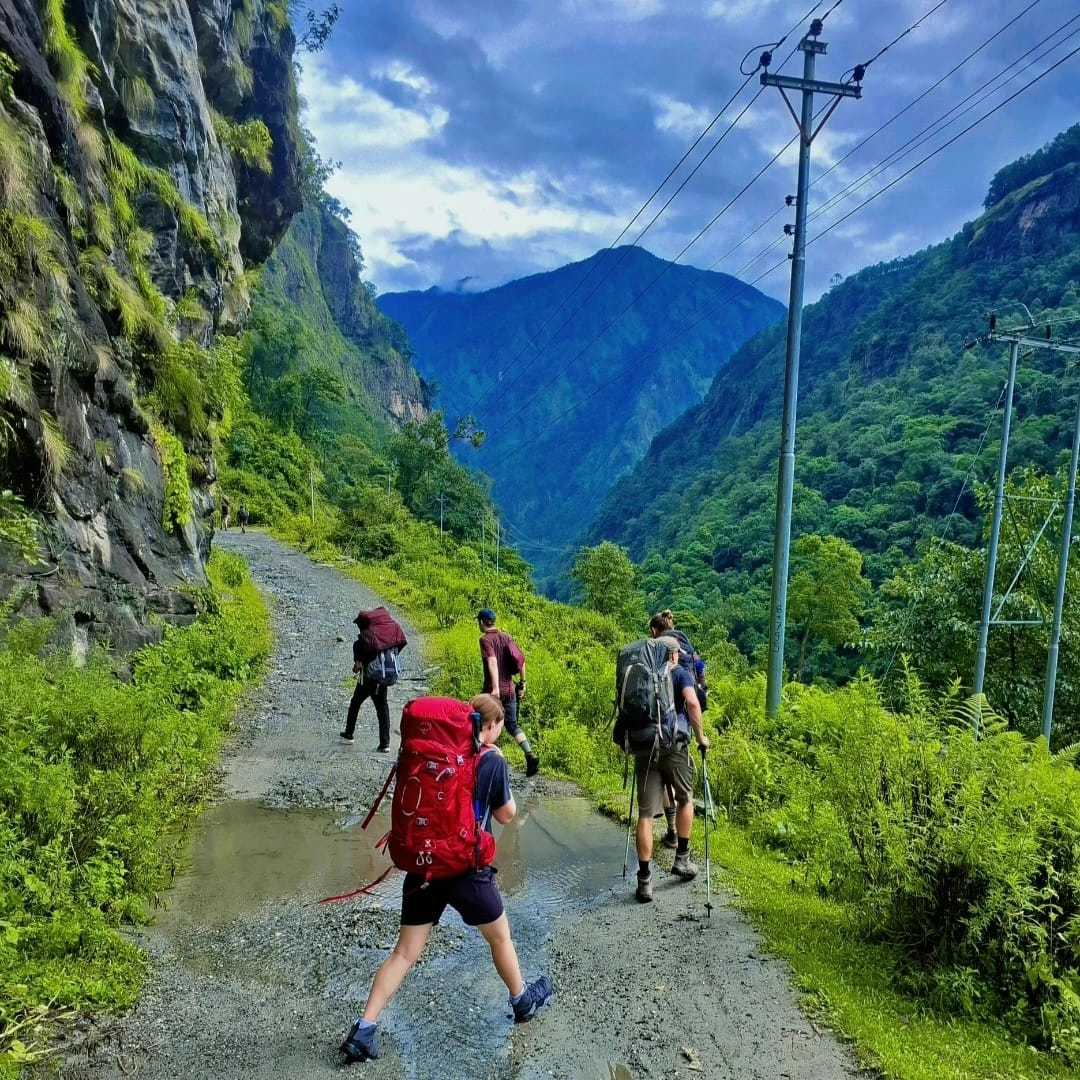
Day 3: Jagat To Deng
You’ll begin by climbing a rocky ridge to reach Salleri, a small village with captivating views of Mount Sringi. As you descend towards Setibas, you’ll notice the increasing presence of mani walls, indicating the growing influence of Tibetan culture in the region.
The valley widens, and the trail continues past stone houses along Ghat Khola. You’ll encounter a long suspension bridge, offering a thrilling experience as you cross the roaring river below.
The trail climbs towards Philim, a large Gurung village showcasing traditional architecture and local life.
After traversing through lush millet fields, you’ll reach Ekle Bhatti, a small teahouse settlement, which serves as your lunch stop or overnight stay depending on your pace.
The final stretch to Deng involves a gradual ascent through farmlands and meadows.
Day 4: Deng To Namrung
The trek from Deng to Namrung is the fourth day of the Manaslu Circuit Trek, offering a beautiful journey with diverse landscapes and cultural encounters. Here’s what you can expect:
The trail from Deng takes you through a fascinating mix of valleys, rivers, and quaint villages, gradually ascending towards Namrung. You’ll begin with a short descent to the Budhi Gandaki Riverbed, offering a different perspective of the valley.
The trail then leads you across a suspension bridge to Rana Gaon, a small village with traditional stone houses and agricultural fields. Next, you’ll encounter Bhimphedi, a picturesque spot with teahouses, followed by a gentle climb to Gap, a village known for its apple orchards.
Enjoy the scenic views and potentially savor some fresh apples during the season. Ghap is a good spot to take a lunch break and refuel for the remaining trek. After Ghap, the trail enters a captivating section with dense forests, cascading waterfalls, and vibrant flora and fauna.
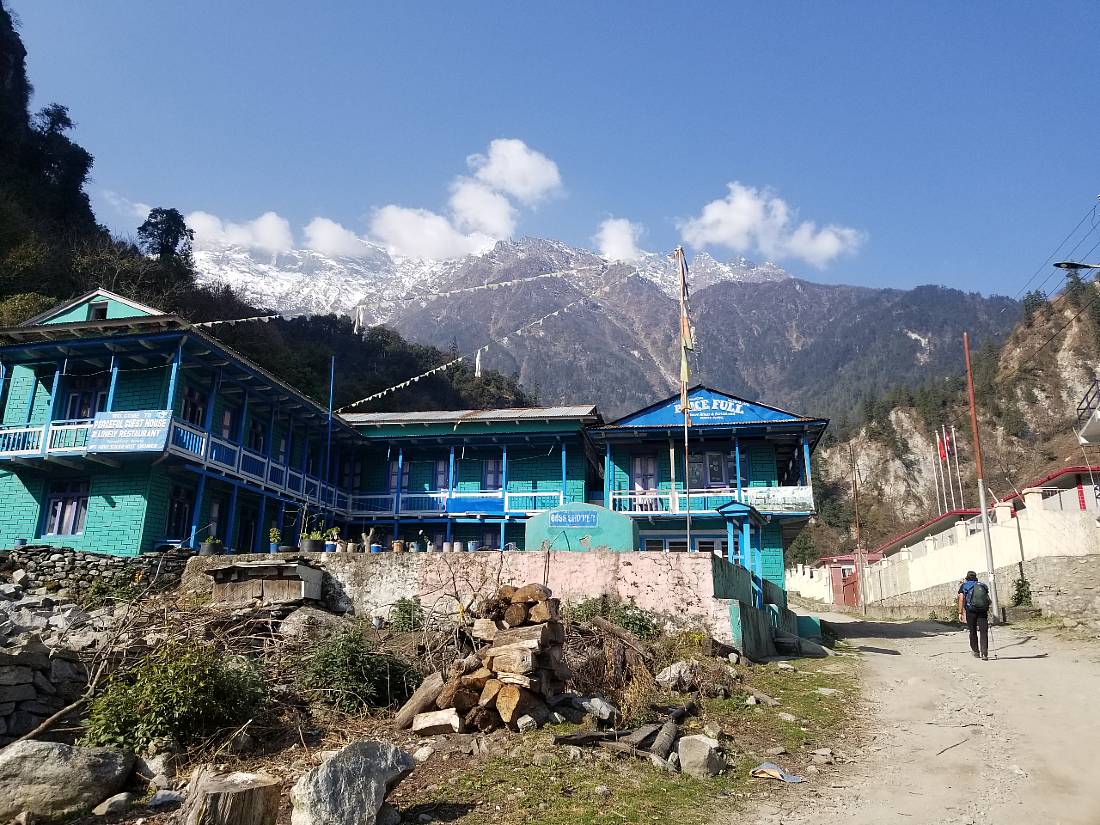
Keep an eye out for colorful birds and interesting plant life. As you approach Namrung, you’ll start noticing an increase in mani walls and colorful prayer flags, reflecting the growing Tibetan Buddhist influence in the region.
Namrung, a charming village nestled at an altitude of 2660 meters (8727 ft), is your destination for the day. Here, you’ll find comfortable teahouses with breathtaking views of the Manaslu Himal, including Manaslu itself.
Day 5: Namrung To Lho
As you leave Namrung, the trail is adorned with many mani walls and colorful prayer flags, signifying the strong Tibetan Buddhist influence in the region.
The initial part of the trek takes you through Upper Nupri, a beautiful area with traditional stone houses and yak pastures.
The path then enters a scenic forest section with towering fir, rhododendrons, and oak trees. Keep an eye out for interesting birdlife and the vibrant flora of the region.
You’ll reach Lihi village, showcasing unique architectural styles with flat roofs and stone houses. Interact with the locals and learn about their way of life.
As you ascend further, the trail opens up to spectacular views of the Manaslu range, including Manaslu itself, Peak 29, and the Naike Peak. The landscape becomes more dramatic, offering a glimpse of the beauty that awaits you on the Manaslu Circuit Trek.
Day 6: Lho To Samagaun
You will follow a higher trail along the lateral moraine of the Pungen Glacier. This route offers closer views of the glacier and Peak 29 but may involve some rocky sections.
Whichever route you choose, you’ll eventually reach Shyaula Kharka, a small herder settlement with traditional stone houses and yak pastures.
The trail then opens up to breathtaking views of the Manaslu range, including Manaslu itself, Himalchuli, and Ngadi Chuli.
Samagaun, a beautiful village nestled at an altitude of 3530 meters (11,581 ft), is your destination for the day. Here, you’ll find comfortable teahouses with breathtaking views of the surrounding mountains.
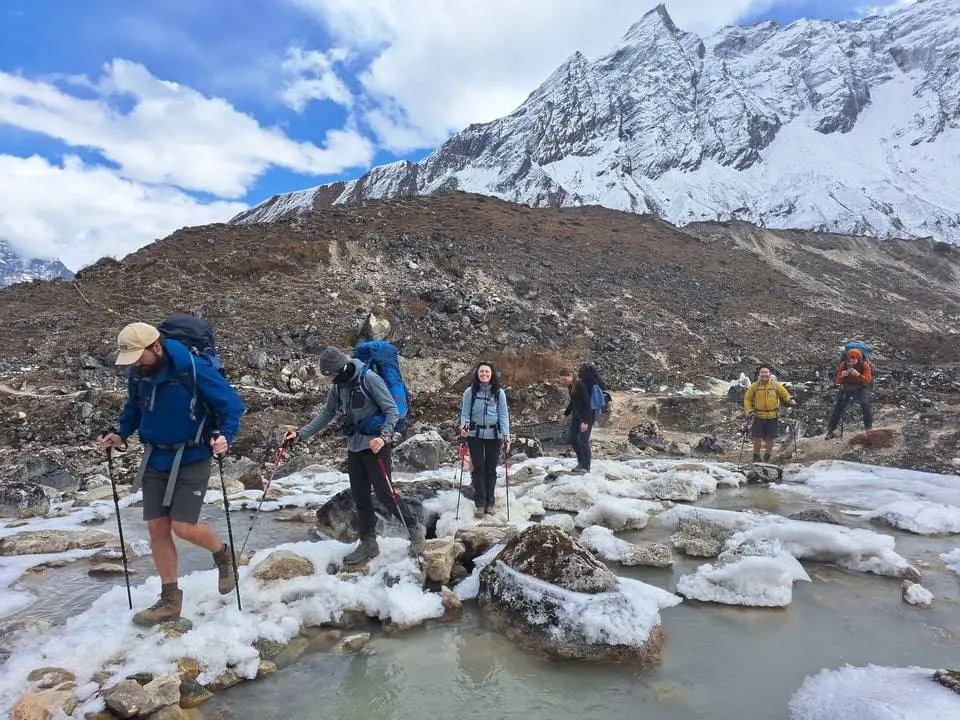
Day 7: Acclimatization Day in Samagaun
On this day you will hike to Manaslu Base Camp (4500 meters) – This is a more challenging hike that offers stunning views of Manaslu and the surrounding peaks.
Be sure to discuss this option with your guide to ensure it’s suitable for your acclimatization progress
A successful acclimatization day in Samagaun paves the way for a safe and enjoyable journey through the higher sections of the Manaslu Circuit Trek.
Listen to your body, prioritize rest, and enjoy the beautiful surroundings!
Day 8: Samagaun To Samdo
You’ll begin with a gradual descent towards the Budhi Gandaki River, offering a different perspective of the valley.
After crossing the river on a suspension bridge, the landscape transforms into a more arid and rocky terrain, resembling a high-altitude desert.
You’ll encounter yak herder settlements and their grazing pastures along the way.
The trail then steadily ascends through this unique landscape, offering panoramic views of the Manaslu range, including Manaslu itself and the surrounding peaks.
Samdo, a small village nestled at an altitude of 3875 meters (12,713 ft), is your destination for the day. You’ll find comfortable teahouses with even more dramatic close-up views of Manaslu.
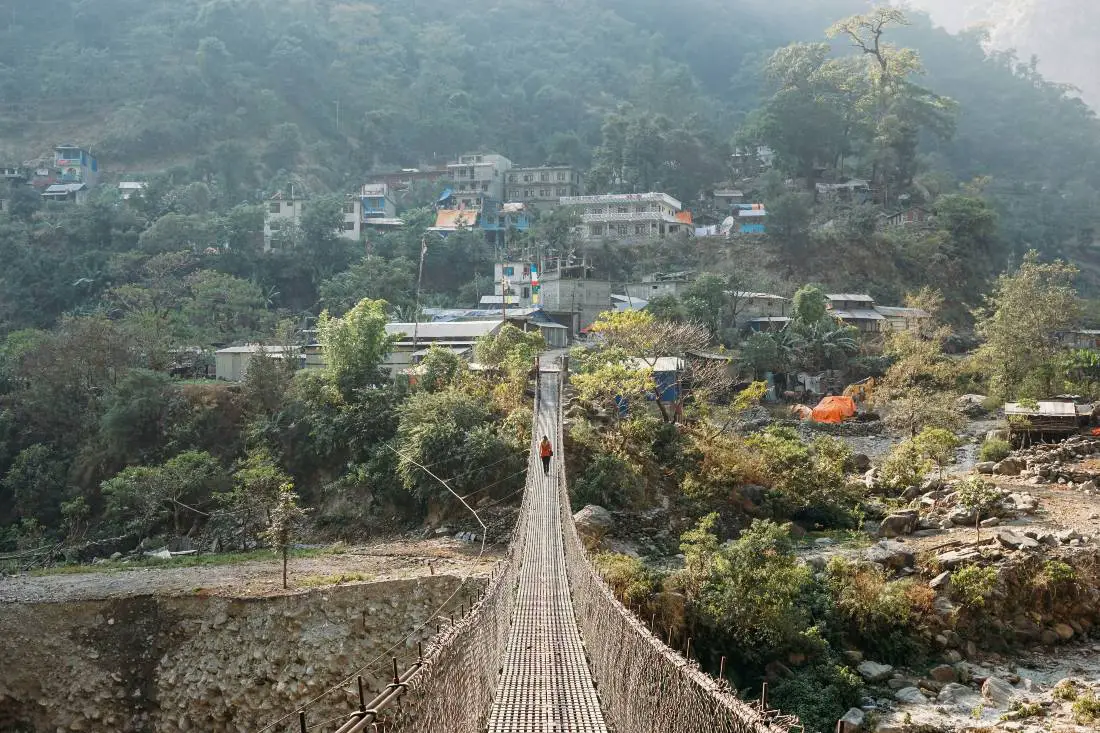
Day 9: Acclimatization Day in Samdo
Similar to your acclimatization day in Samagaun, spending an acclimatization day in Samdo (at 3875 meters) is crucial for success on the Manaslu Circuit Trek.
You will hike to the Tibetan border on this day. This can be a challenging but rewarding hike depending on the specific route chosen. It helps your body to acclimatize your body for Larke Pass.
Day 10: Samdo To Dharamsala
It’s a challenging yet rewarding leg that takes you through a high-altitude landscape with dramatic scenery and prepares you for the upcoming Larkya La pass crossing.
You’ll start with a steep and challenging climb through scree slopes, demanding a slow and steady pace.
The trail continues alongside the Larkya Glacier, offering a unique perspective of the glacial terrain. Keep an eye out for crevasses and follow your guide’s instructions carefully.
Dharamsala, also known as Larkya Phedi, is a small village situated at an altitude of 4470 meters (14,665 ft). This is your destination for the day and serves as the base camp before tackling the Larkya La pass.
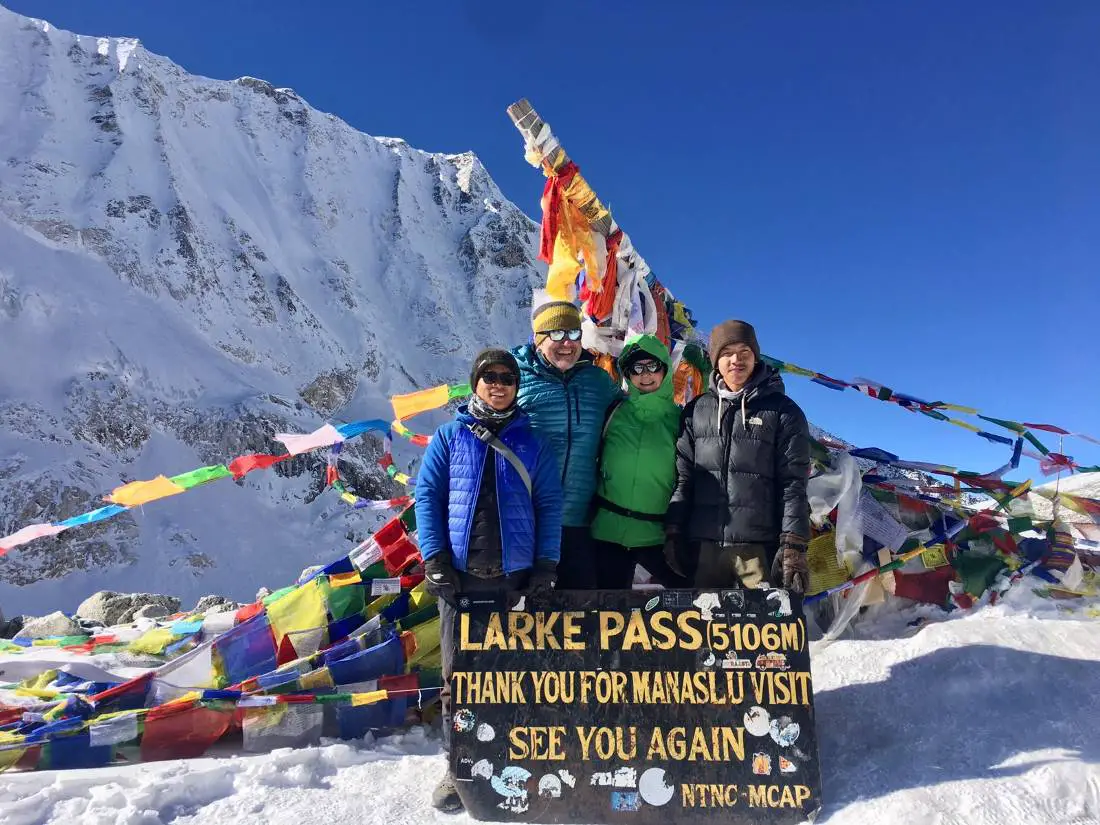
Day 11: Dharamsala To Bhimthang Via Larke Pass
This is the day you have been waiting for. You’ll wake up very early for a pre-dawn start to avoid the afternoon sun and potential snowmelt on the pass.
The initial ascent from Dharamsala involves a steep climb through moraine and scree slopes, demanding a slow and steady pace with frequent breaks.
As you gain altitude, the air will become thinner, so listen to your body and take rest breaks whenever needed.
The final push to the pass involves a rocky section that might require using your hands for balance.
Reaching Larkya La, the highest point of the Manaslu Circuit Trek, is a moment of immense achievement.
Here, you’ll be rewarded with breathtaking panoramic views of Manaslu, Himchuli, and the surrounding Himalayan ranges. On a clear day, you might even see glimpses of Annapurna peaks in the distance.
The descent from Larkya La towards Bimthang is initially steep and involves navigating loose scree slopes. Use hiking poles for extra support and stability.
The trail then enters a more scenic valley with pastures and streams.
Day 12: Bhimthang To Dharapani
You’ll begin with a gradual descent through a scenic valley with pastures, streams, and lush vegetation. Enjoy the contrasting landscape compared to the previous day’s terrain.
The trail then leads you to a suspension bridge over the mighty Budhi Gandaki River. As you descend further, you’ll enter the lower Manaslu region, with more permanent settlements and cultivated fields.
Dharapani, a charming village nestled at an altitude of 3720 meters (12,205 ft), is your destination for the day. This is a popular stop on the Annapurna Circuit Trek as well.
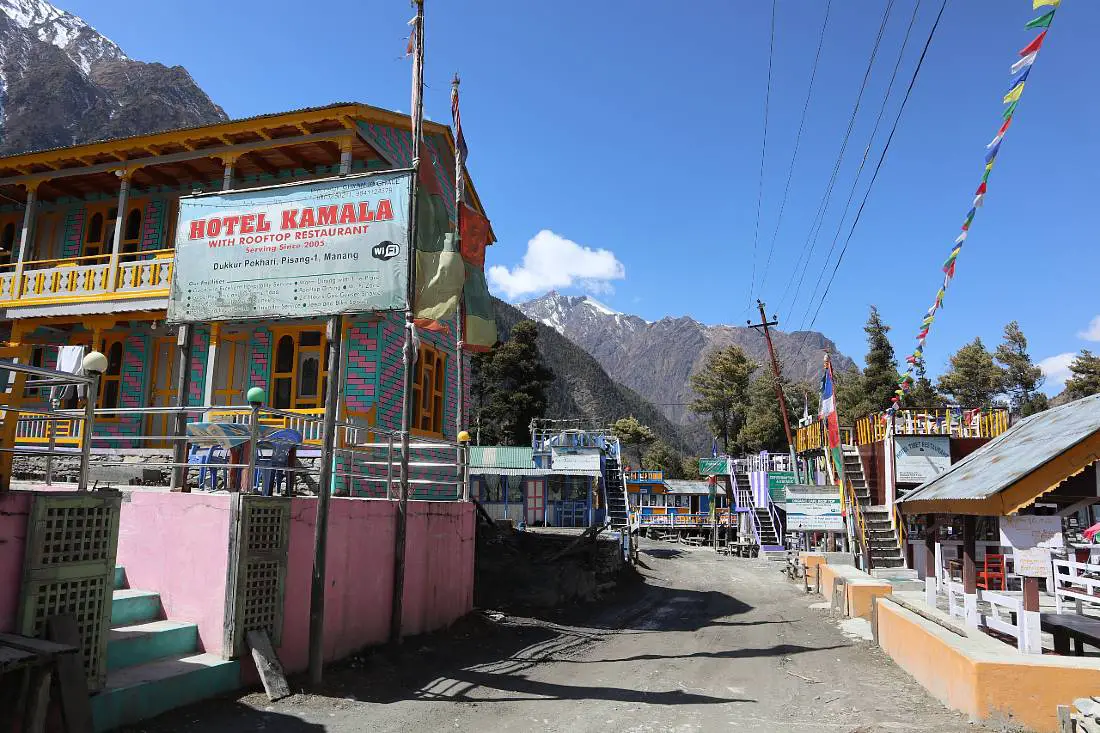
Day 13: Dharapani To Besisahar
The trail leads you to a suspension bridge over the mighty Budhi Gandaki River.
As you descend, you’ll enter the lower Manaslu region, with more permanent settlements and cultivated fields.
Besisahar, a bustling town nestled at an altitude of 794 meters (2,605 ft), is your final destination on the Manaslu Circuit Trek. This is also the starting point for the popular Annapurna Circuit Trek .
Day 14: Besisahar To Kathmandu
From Besisahar, you can take a local bus back to Kathmandu. The journey takes approximately 10 to 12 hours, depending on traffic and road conditions.
The bus ride can be quite bumpy and dusty, so be prepared for a long journey. Tickets can be purchased at the bus station in Besisahar.
I hope this inspires you to hike the Manaslu Circuit Trek, I certainly want to do it after reading this!
Leave a Reply Cancel reply
Your email address will not be published. Required fields are marked *
This site uses Akismet to reduce spam. Learn how your comment data is processed .
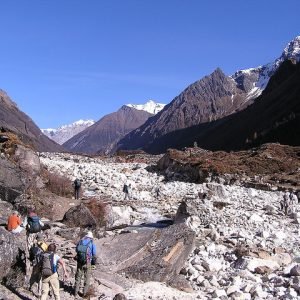
The Ultimate Guide to the Manaslu Circuit Trek
Nestled in the heart of the Nepalese Himalayas, the Manaslu Circuit Trek is widely regarded as one of the best moderate multi-day treks in Nepal. Circumnavigating the spectacular Mount Manaslu (8,163m), the eighth highest mountain in the world, this thrilling journey takes you through remote valleys, high mountain passes, and charming villages.
As you follow ancient trade routes across the Manaslu region, you’ll be rewarded with some of Nepal’s most stunning scenery and fascinating cultural encounters. From the lush forests of the Budhi Gandaki river valley to the arid high-altitude landscapes of the Tibetan plateau, the astonishing diversity of this trek appeals to all hikers.
While less crowded than popular treks like the Everest Base Camp and Annapurna Circuit treks, the Manaslu Circuit Trek still offers all the magic of the Himalayas. Read on to discover everything you need to know to plan your ultimate Manaslu Circuit trekking adventure.
Overview of the Manaslu Circuit Trek
The Manaslu Circuit Trek typically takes between 13-18 days to complete a full circuit of Mount Manaslu. The trek starts and finishes in the town of Arughat after completing a clockwise loop around the mountain.
The total trekking distance is around 160km, with most days covering between 5-8 hours of walking. You’ll cross over several high mountain passes exceeding 5000m in elevation. Proper acclimatization to the high altitude is essential.
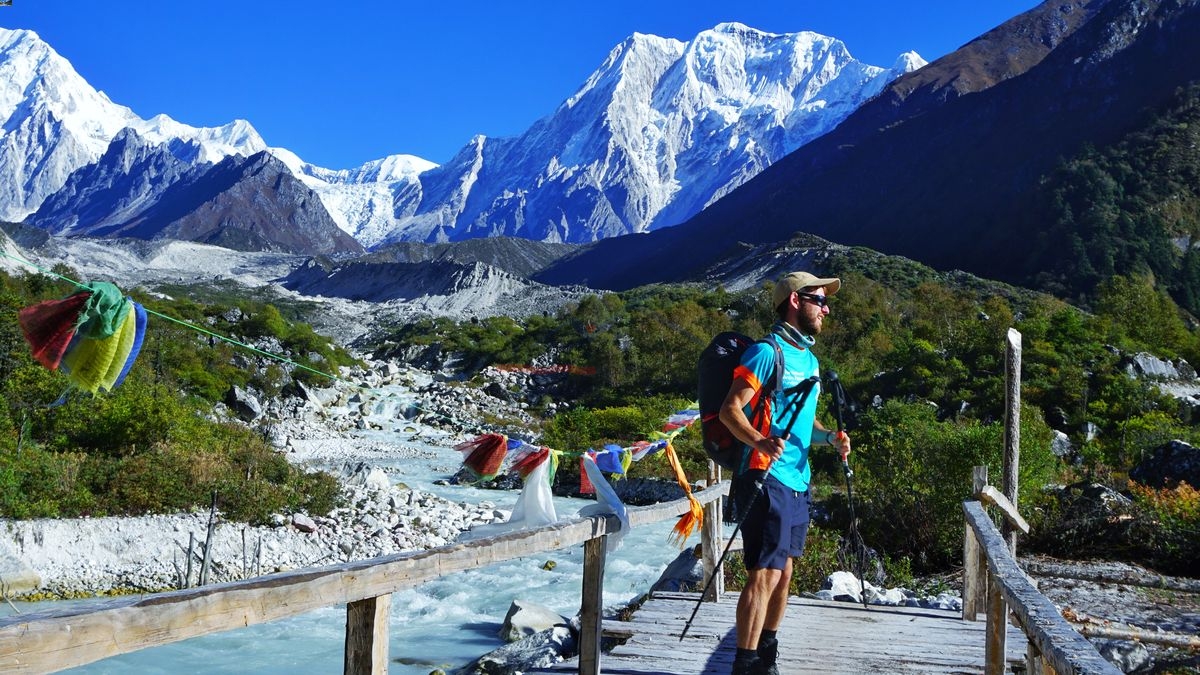
The route passes through remote areas with basic accommodation in tea houses or camping. As this region has only recently opened for trekking, the trails are less crowded than other major treks in Nepal.
The journey combines nature and culture as you witness incredible mountain landscapes as well as traditional Tibetan and Nepali villages. With the stunning scenery and warm hospitality, you’ll be captivated by the magic of the Manaslu region.
Key Highlights of the Manaslu Circuit Trek
- Breathtaking views of Mount Manaslu (8163m) and surrounding peaks like Ngadi Chuli (7871m).
- Crossing the high Larkya La pass (5213m) which links the Marshyangdi and Budhi Gandaki valleys.
- Seeing monasteries, chortens, and mani walls reflecting Tibetan culture and Buddhism.
- Visiting charming villages like Lho, Samagaon, and Bihi showcasing local Nepali lifestyle.
- Trekking through diverse landscapes from sub-tropical to alpine high mountain zones.
- Following quiet trails away from large trekking crowds.
- Spotting exotic wildlife like blue sheep, golden eagles, and Himalayan tahr.
When is the Best Time for the Manaslu Circuit Trek?
The Manaslu Circuit Trek is open from March to May in spring and September to November in autumn. These seasons offer ideal weather for trekking before and after the monsoon rainy season.
During spring, the trails are lined with vibrant rhododendron blooms while autumn showcases clear skies and the Himalayas at their best. Daytime temperatures average 15-20°C in the lower areas. Up high, temperatures drop below freezing at night.
Deep winter from December to February brings harsh cold along the trek, especially at higher elevations and passes. Travel can be hindered by snow. The summer monsoon from June to August sees heavy rain making the trails very wet and slippery.
Therefore, the prime times to trek the Manaslu Circuit are March-May and late September-November. This avoids the extremes of winter and monsoon seasons.
How Difficult is the Manaslu Circuit Trek?
The Manaslu Circuit Trek is considered a moderately difficult trek suitable for avid hikers with prior multi-day trekking experience at high altitude. Proper fitness level, acclimatization, and quality trekking gear are essential.
Here are some key points on the difficulty level:
- Days are long with 5-8 hours of walking on average. Fitness is key.
- High elevation with several passes over 5000m means good acclimatization is vital.
- Trail conditions can be rough or slippery in parts, especially over the Larkya La.
- Cold temperatures at higher altitudes coupled with strong winds.
- Basic tea house accommodation in small villages with shared long-drop toilets.
- Limited health facilities along the remote route.
With sound preparation, a moderate level of fitness, and gradual acclimatization to altitude, most people can complete the Manaslu Circuit Trek. Some strenuous days are compensated by more relaxed walking.
Trekking slowly and allowing extra rest days aids acclimatization. You must be comfortable with multi-day hiking and basic living conditions. Previous experience above 4000m helps considerably.
How to Get to the Manaslu Circuit Trek?
Most people begin the Manaslu Circuit Trek by bus from Kathmandu to Arughat (2 days) or Soti Khola (1 day) to reach the starting point. Jeeps can also drive to Arkhet which shortens the first day’s walk. You can arrange local transportation and permits through a trekking agency.
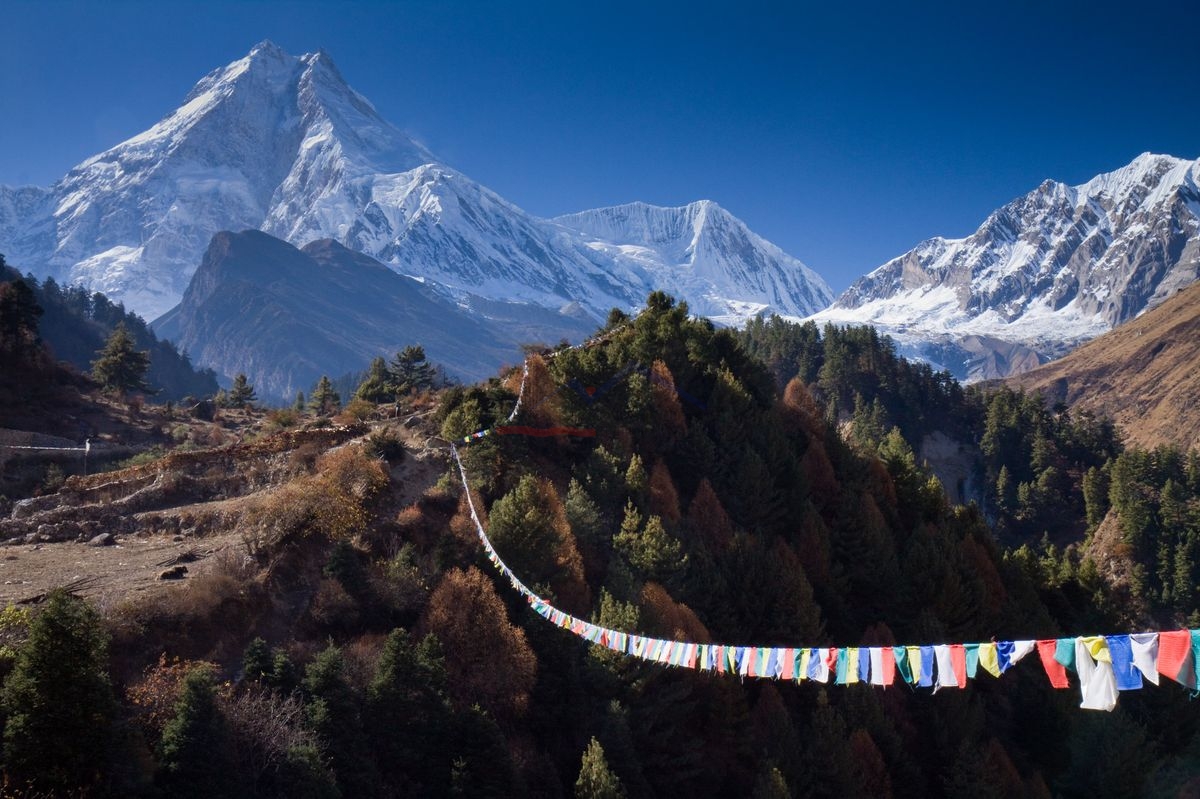
Here is an overview of reaching the Manaslu Circuit Trek start point:
- Local bus from Kathmandu to Arughat takes around 8 hours. From Pokhara, take a bus to Abu Khaireni then change.
- Jeeps can drive from Kathmandu to Arkhet in around 6-7 hours. Shorten day one walking.
- For the fastest start, hire a private jeep to Soti Khola which takes around 4-5 hours.
- Flights from Kathmandu to Tumlingtar then drive 3 hours to Soti Khola. Expensive but saves 2 days.
Arughat is the classic starting point to begin your Manaslu Circuit trek by foot. Travel time is compensated by spectacular overland journeys showcasing rural Nepal before reaching the trails.
Manaslu Circuit Trek Itinerary Overview
While the exact itinerary can vary slightly depending on your start point, pace and acclimatization needs, here is an overview of the standard Manaslu Circuit trek outline over 14 days:
- Day 1: Drive Kathmandu to Soti Khola
- Day 2: Trek to Machha Khola (Fish tail River)
- Day 3: Trek to Jagat village
- Day 4: Trek to Deng village
- Day 5: Trek to Namrung village
- Day 6: Acclimatization day in Namrung
- Day 7: Trek to Samagaon
- Day 8: Acclimatization day in Samagaon. Optional day hike.
- Day 9: Trek to Samdo
- Day 10: Trek to Dharmshala
- Day 11: Cross Larkya La Pass (5213m). Trek to Bimtang
- Day 12: Trek to Gho village
- Day 13: Trek to Dharapani then drive to Besisahar
- Day 14: Drive from Besisahar to Kathmandu
Detailed Day by Day Manaslu Circuit Trek Itinerary
Now let’s look at what each day of the Manaslu Circuit trek entails including highlights and important notes for trip planning:
Day 1: Drive from Kathmandu to Soti Khola (700m)
The journey to Soti Khola takes around 4-5 hours by private jeep. This arterial road leads into the heart of the Manaslu region. Enjoy views of rice terraces and jungle-clad hills before following the Budhi Gandaki River gorge. Stay overnight in simple local lodges.
Day 2: Trek Soti Khola to Maccha Khola (Fish Tail River) (870m)
(Walking: 6-7 hours)
After breakfast, cross the suspension bridge north over the Budhi Gandaki River. The trail leads through Sal forest and ascends on stone steps to the Gurung village of Labubesi. Descend back to the river bank at the confluence with the tributary Khola River. Cross another suspension bridge to Maccha Khola village for overnight stop.
Day 3: Trek Maccha Khola to Jagat (1410m)
Following the Budhi Gandaki, today’s trail climbs over several ridges along the empty riverbank. A tough climb takes you to the charming Gurung village of Jagat where the valley opens up. The entrance stone steps signify arrival in the Nepal Manaslu Conservation Area. Overnight in Jagat in local lodges.
Day 4: Trek Jagat to Deng (1860m)
(Walking: 5-6 hours)
Crossing the river early on, the trail weaves uphill through forests revealing views of Sringi Himal (7187m). Descend to cross the Budhi Gandaki on a long suspension bridge to Deng village. Surrounded by cliffs, Deng is the last permanent settlment until the trek returns here on the circuit.
Day 5: Trek Deng to Namrung (2660m)
Leaving Deng, enter the Budhi Gandaki gorge clad with pine forests. The walking involves lots of ups and downs today. Notice the change in architecture and people, reflecting Tibetan influences. Reach Namrung village, at the doorstep of the high Himalaya.
Day 6: Acclimatization Day in Namrung
wise to spend an extra acclimatization day here enjoying short walks around the village. This helps prepare for higher elevations ahead. Namrung Monastery is worth a visit to view morning puja.
Day 7: Trek Namrung to Samagaon (3530m)
Today crosses the Buddhi Gandaki on a bridge festooned with prayer flags then ascends steeply up the stone steps to the village of Lho. The trail stays high above the river with grand views of Manaslu. The hike ends at Samagaon with its famous monastery and Mount Manaslu views.
Day 8: Acclimatization Day in Samagaon
Spend a second acclimatization day exploring Samagaon. Hike up to the Buddhist nunnery of Pungen Glingsgompa or take the day hike to Pungyen Gompa for closer views of Manaslu. Careful preparation is key before the high pass crossing.
Day 9: Trek Samagaon to Samdo (3860m)
(Walking: 3-4 hours)
A relatively easier day follows the Budhi Gandaki River to the tiny seasonal herding settlements of Dharamsala. The trail finally enters the Tibetan-style village of Samdo. Incredible views of Mt Manaslu, Simnang Himal, Rupina La pass and Larke Peak surround.
Day 10: Trek Samdo to Dharmshala (4460m)
Continue following the Budhi Gandaki north as the valley opens into a wider plateau. Pass more seasonal dwellings like Larkya Bazaar. The high altitude landscape becomes starker and windier. Reach Dharmshala for the night before the big pass crossing.
Day 11: Cross Larke La Pass (5213m), trek to Bimtang (3720m)
(Walking: 8-10 hours)
The longest day begins with a steep ascent over moraine to cross the highest point, Larke La pass (5213m). Enjoy stunning mountain views then begin the long knee-jarring descent to Bimtang. Pass glaciers and summer grazing land to enter the quiet Bhudi Gandaki valley.
Day 12: Trek Bimtang to Gho (2515m)
From Bimtang, follow the Burdin Khola River downstream through rhododendron forests. The landscape becomes greener with classic Nepali hill scenery. The pretty village of Gho is a welcome sight after the high pass crossing. Enjoy a hot shower!
Day 13: Trek Gho to Dharapani, drive to Besisahar (760m)
The last day of walking reaches Dharapani village back on the Annapurna Circuit. From here take a jeep or bus down to Besisahar. Celebrate completing the Manaslu Circuit Trek!
Day 14: Drive Besisahar to Kathmandu (1300m)
The 7-8 hour bus ride back to Kathmandu gives time to reflect on the amazing Manaslu trek. You’ll arrive tired but elated after conquering this ultimate Himalayan adventure!
What to Pack for the Manaslu Circuit Trek?
Planning your gear and packing list is an important part of preparing for the Manaslu Circuit trek. You will need clothing and equipment suitable for both warm and colder mountain conditions.
As you will be carrying your own pack each day, it is essential to pack as lightly as possible without sacrificing essential items. Here is a recommended Manaslu Circuit trek packing checklist:
- Hiking boots – waterproof with good ankle support
- Trekking poles – help with steep ascents and descents
- Quick-dry hiking shirts and pants
- Fleece jacket and insulated down jacket for warmth
- Waterproof shell jacket and pants
- Warm hat, gloves and buff/scarf
- Under layers including thermal leggings and long sleeve tops
- Comfortable socks and underwear
- Sleeping bag – rated down to -10°C or lower
- Inner sleep sheet for tea house lodges
- Hydration pack or water bottles
- Sunglasses and sunscreen
- Headlamp with spare batteries
- Small first aid kit
- Toiletries – eco-friendly soap, toothbrush etc
- Light towel – quick dry travel towels are best
- Any personal medications you require
Hire local porters to carry the majority of gear or join a fully organized camping trek to minimize your load. Good fitness will allow you to enjoy the trek rather than struggle under a heavy pack.
Is a Guide Required for the Manaslu Circuit Trek?
Booking through a registered trekking agency allows you to trek the Manaslu Circuit with an experienced local guide. This is recommended for navigation, arranging accommodation and permits, porters, and gaining insight into the region. Guides also ensure your safety and proper acclimatization.
You can trek independently without a guide and arrange tea house stays as you go. However, a guide provides security in case of emergencies along this remote route. Guides carry safety equipment like satellite phones, oxygen and first aid kits.
Having a guide helps bridge language barriers when interacting with locals. A knowledgeable guide will enhance your overall trekking experience while allowing you to focus on enjoying the trail.
Manaslu Circuit Trek Difficulty and Altitude Considerations
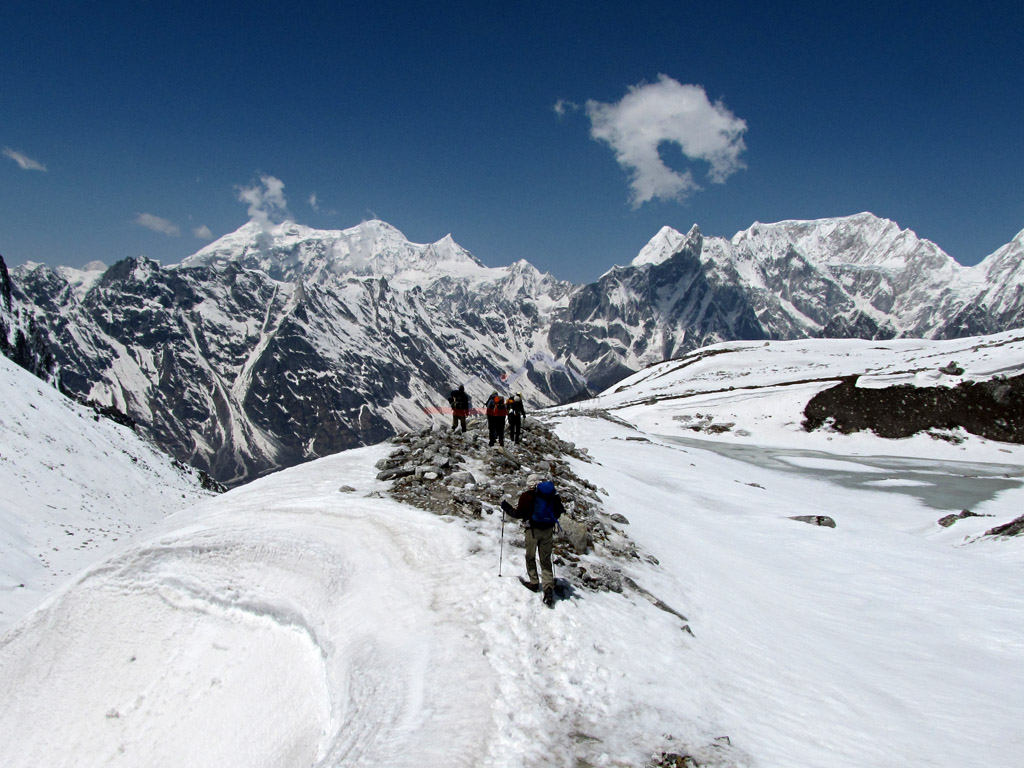
The Manaslu Circuit involves long days hiking at altitude with rough trail conditions in sections. Take care to build your fitness, walk at a gradual pace, and allow rest days to acclimatize. Here are some tips to help overcome the difficulties:
Acclimatization
- Trek slowly. Limit gains in sleeping elevation to 300-400m per day.
- Schedule 2 full rest days in Namrung and Samagaon villages to acclimatize.
- Stay hydrated and eat carbohydrate-rich meals.
- Avoid alcohol and smoking.
- Listen to your body and rest if feeling unwell.
Altitude Sickness
- Recognize signs of AMS (headache, nausea, fatigue). Descend immediately if severe.
- Bring prescription medication like Diamox to aid acclimatization.
- Trek with an agency that provides emergency oxygen if needed.
Trail Conditions
- The circuit has steep ascents and descents, especially around the Larkya La.
- Trails can be slippery or unstable. Use trekking poles for balance and stability.
- Start hiking early to avoid afternoon storms and freezing temperatures.
- Follow your guide’s pace and route for optimal safety.
- Wear proper hiking boots with sturdy ankles.
By taking precautions and working within your physical limits, the Manaslu Circuit trek is achievable for fit hikers who take time to acclimatize. Reap the rewards of completing one of Nepal’s greatest treks!
Permits and Costs for the Manaslu Circuit Trek
The Manaslu region was opened for trekking only in 1991 and still maintains strict permit regulations. You must trek with an official guide as independent trekking is not allowed. All trekkers require:
- Manaslu Conservation Area Project (MCAP) Permit – $70 per week
- Manaslu Restricted Area Permit – $100 per week
- Annapurna Conservation Area Permit – $20 (if finishing in Dharapani)
Expect to pay around $1500 to $2000 per person for a fully organized moderate standard Manaslu Circuit trek including guide, porters, accommodation, permits, and transportation. Budget more for better hotels or camping treks.
A barebones teahouse-only budget trek can be done for under $1000 excluding international flights. Carefully compare packages to see what is included. Most trek prices are all-inclusive except meals and tips.
Is the Manaslu Circuit Trek Worth It?
For moderate multi-day trekkers seeking incredible scenery, cultural encounters and fewer crowds, the Manaslu Circuit Trek absolutely lives up to its reputation as one of Nepal’s finest journeys.
The natural beauty of Mount Manaslu coupled with the raw adventure of crossing the Larkya La pass rewards you with stunning vistas and immense satisfaction of completing this ultimate circuit. Varied landscapes, Tibetan culture and charming villages add rich layers of interest.
While more logistical planning is required than for mainstream treks, the extra rewards of immersing yourself in this remote trans-Himalayan region make the Manaslu Circuit trek worth every step. Be prepared for basic accommodation and travel delays, but don’t let that deter you from discovering the magic of Manaslu!
- Everest Region
- Annapurna Region
- Ganesh Himal Region
- Langtang Region
- Dolpa Region
- Manaslu Region
- Mustang Region
- Khumbu Region
- Mountain Expedition
- Peak Climbing
- Chitwan Jungle Safari
- Cultural Tour
- Jungle Safari
- Bird Watching
- Bungee Jumping
- Paragliding
- River Rafting
- Company Profile
- Legal Documents
- Trip Advisor Reviews
- Corporate Social Responsibility
- Privacy Policy
LICENSE NO: 1921/072
Any Questions? Inquire Now
Email address
Phone Number
Your Country —Please choose an option— Afghanistan Albania Algeria Andorra Angola Antigua and Barbuda Argentina Armenia Australia Austria Azerbaijan Bahamas Bahrain Bangladesh Barbados Belarus Belgium Belize Benin Bhutan Bolivia Bosnia and Herzegovina Botswana Brazil Brunei Bulgaria Burkina Faso Burundi Cabo Verde Cambodia Cameroon Canada Central African Republic Chad Chile China Colombia Comoros Congo (Congo-Brazzaville) Costa Rica Croatia Cuba Cyprus Czechia (Czech Republic) Denmark Djibouti Dominica Dominican Republic East Timor (Timor-Leste) Ecuador Egypt El Salvador Equatorial Guinea Eritrea Estonia Eswatini (fmr. "Swaziland") Ethiopia Fiji Finland France Gabon Gambia Georgia Germany Ghana Greece Grenada Guatemala Guinea Guinea-Bissau Guyana Haiti Holy See Honduras Hungary Iceland India Indonesia Iran Iraq Ireland Israel Italy Jamaica Japan Jordan Kazakhstan Kenya Kiribati Korea, North Korea, South Kosovo Kuwait Kyrgyzstan Laos Latvia Lebanon Lesotho Liberia Libya Liechtenstein Lithuania Luxembourg Madagascar Malawi Malaysia Maldives Mali Malta Marshall Islands Mauritania Mauritius Mexico Micronesia Moldova Monaco Mongolia Montenegro Morocco Mozambique Myanmar (formerly Burma) Namibia Nauru Nepal Netherlands New Zealand Nicaragua Niger Nigeria North Macedonia (formerly Macedonia) Norway Oman Pakistan Palau Palestine State Panama Papua New Guinea Paraguay Peru Philippines Poland Portugal Qatar Romania Russia Rwanda Saint Kitts and Nevis Saint Lucia Saint Vincent and the Grenadines Samoa San Marino Sao Tome and Principe Saudi Arabia Senegal Serbia Seychelles Sierra Leone Singapore Slovakia Slovenia Solomon Islands Somalia South Africa South Sudan Spain Sri Lanka Sudan Suriname Sweden Switzerland Syria Taiwan Tajikistan Tanzania Thailand Togo Tonga Trinidad and Tobago Tunisia Turkey Turkmenistan Tuvalu Uganda Ukraine United Arab Emirates United Kingdom United States of America Uruguay Uzbekistan Vanuatu Venezuela Vietnam Yemen Zambia Zimbabwe
Tel: +977 1 4531610 , 01-4526721
Email: [email protected]

Nepal Sanctuary Treks
Best Trekking Agency in Nepal
- Annapurna Region
- Everest Region
- Langtang Region
- Other Regions
- Teahouse Lodge Trekking
- School Trekking in Nepal
- Customized Solo Trekking
- Customized Family Trekking
- Comfort Lodge Trekking
- Camping Style Treks
- Most Popular
- Mera Peak Expedition
- Island Peak Expedition
- Jungle Safari
- White Water Rafting
- Mountain Flight
- Bird Watching
- Nepal SightSeeing Tour
- Authentic Local Experience
- Lumbini Circuit
- Lower Mustang Biking
- Mountain Biking Escapade: The Last Forbidden Kingdom
- Ultimate Off-road Challenge Biking from Kathmandu to Pokhara
- Kathmandu Valley RIM Biking: A cleaner escape from bustling city
- Explore splendid nature and rich culture-Biking Kathmandu-Chitwan-Pokhara
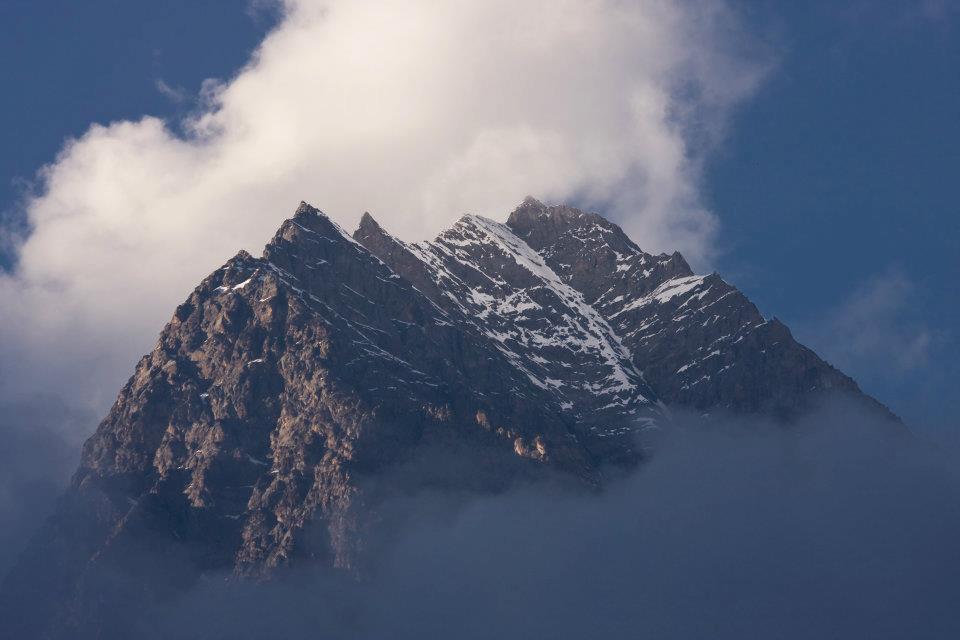
Manaslu Trek: An ultimate guide to most popular tea-house trek
Manaslu Trek is least visited trekking region compared to other trekking regions and is in a very remote area, but Manaslu offers an ultimate adventure trek.
It is famous for small teahouses where trekkers can take rest and have a cup of tea with an amazing scenic view of snow-capped Himalayan ranges.
Table of Contents
Manaslu: Eighth highest mountain in the world
Manaslu is the eighth highest mountain on the earth at 8,163 meters (26,781 ft) above from the sea level. Manaslu is located in the Mansiri Himal in the west-central part of Nepal.
The mountain name is first known as Kutan I. ‘tang’ being the Tibetan words used for the flat place, thereby describes the mountain’s general summit. Later the name of the mountain was changed to Manaslu.
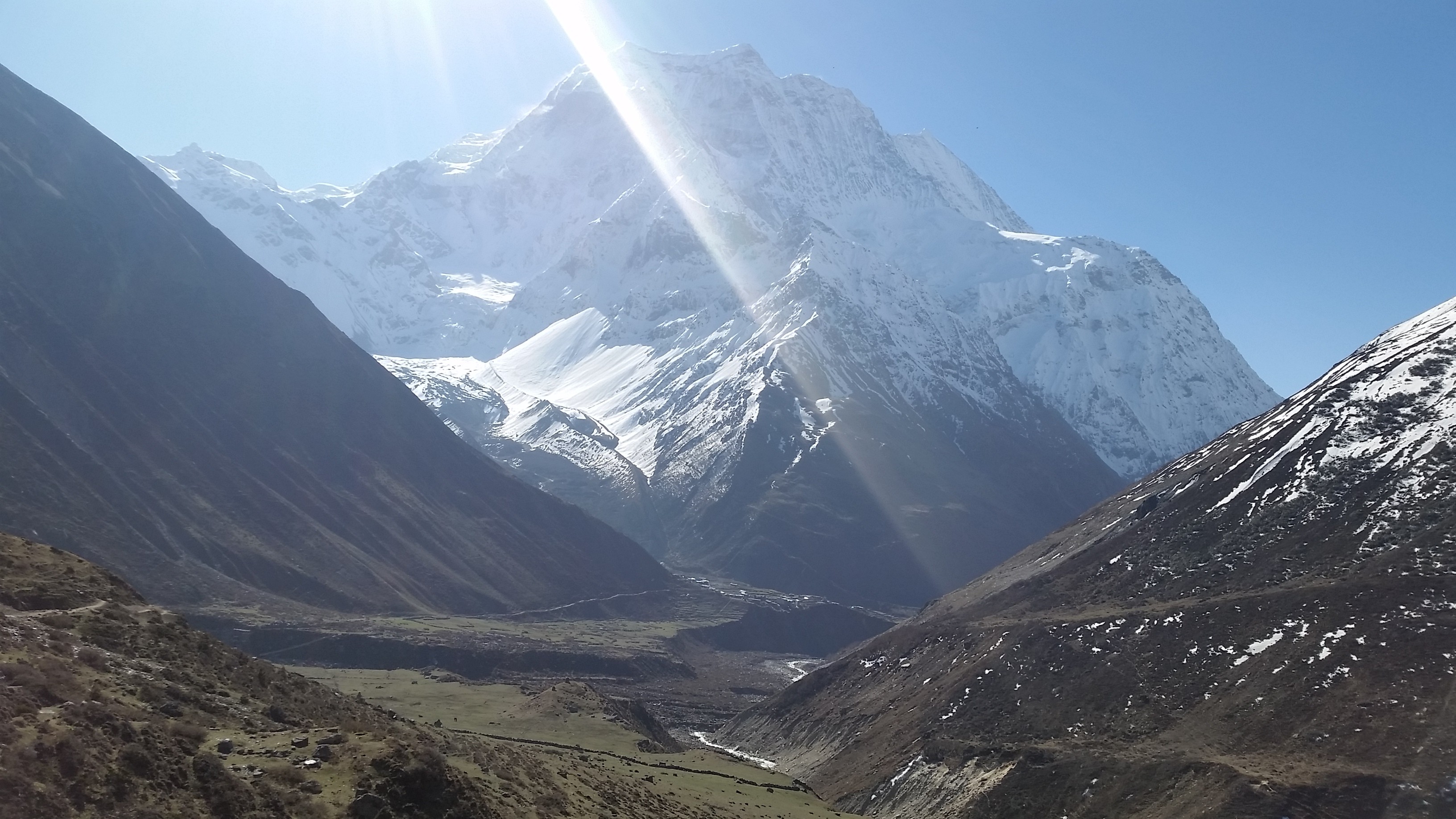
‘Manaslu’ means ‘mountain of the spirit.’ Manaslu word comes from Sanskrit word Manasa; it means intellect or soul.
Manaslu is one of the adventurous trekking among other trekking in the Himalaya region. It is the highest peak of Gorkha district and is located about 40 miles east of Annapurna.
The Manaslu region was opened for trekking only in 1992.
The mountain’s long ridge and valley glaciers offer feasible approaches from all directions, and it culminates in a peak that towers steeply above its surrounding landscape and is a dominant feature when seen from far.
Beauty of Manaslu
Manaslu trek offers a jaw-dropping view of snow-capped mountain range and the ancient trail along with mix culture, heritage and hospitality of authentic Hindu and Tibetan-style Buddhist village.
The beauty of Manaslu is unbeatable. The trekking trail follows an ancient salt-trading route along the spectacular Burhi Gandaki River. The highest point in this trek is the ‘Larkya La Pass’ at an elevation of 5,106 meters (16,752 ft).
Manaslu Trek is famous for the beauty of the high Himalayas as well as local ethnic culture, traditional lifestyle, old monasteries and local people with unique houses.
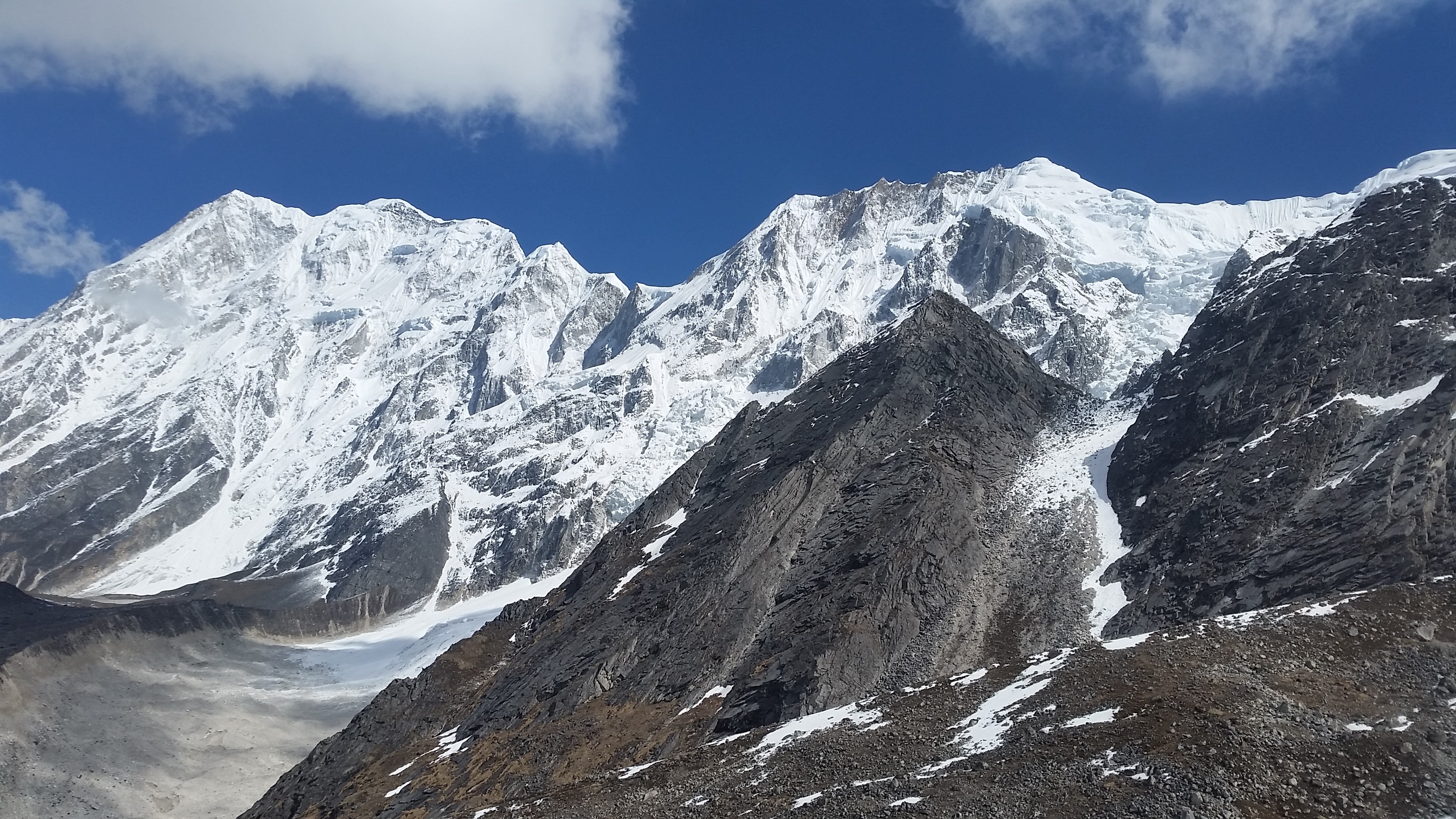
Manaslu is mainly inhabitant with two regions: Nubri and Tsum. Most people visited the Nubri valley after tourism board announced it as a touristic place in 1950.
And Tsum still out of touch with modernity. You will see traditional lifestyle, art, and culture. The local people are mostly of Tibet and speak their language. Different people with different cast live in a different place.
In the central part of the region, the large number of Gurung people are the main ethnic who have joined Brigade of Gurkha and closer to Tibet, the Bhutias, akin to Sherpa people who follow Buddhist.
Earlier climbers to Manaslu region
In 1956, 9 May, Toshio Imanishi and Gyalzen Norbu first climbed the Mount Manaslu. The Japanese team was lead by Maki Yuko, also known as Aritsune Maki. Next successful climb on 19 May 1971 by Kazuharu Kohara and Motoki, group of 11 Japanese teams.
While climbing Mt. Manaslu only a few make it happen, but most people fail to climb the highest peak. Many foreigners were failed to reach at 8000 meters. On November 9, 1986, Jerzy Kukuczka, Artur Hajzer climbed the eighth highest peak.
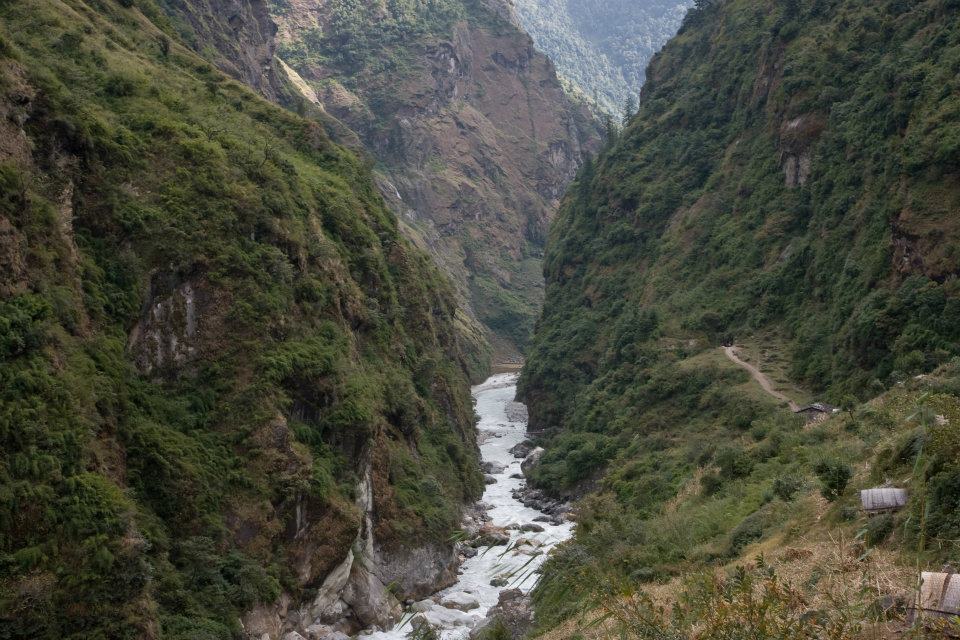
Carlos Carsolio, the youngest and being the fourth person of eight-wonderland in history reach the summit of Manaslu. During the climb, most people died due to the high altitude.
Manaslu trek forms section of the Great Himalaya Trek. Tourists are the important part of GHT which connects to the rural life, provides the essential commodities and school for children.
The trekking trail to Mount Manaslu has only one route which starts from the Gorkha district of Arughat Bazaar and ends in Syange.
The Manaslu trek is a challenging and strenuous trek. The trail can be shorter or longer depending upon your walking hour per day. Along the trek; there are many tea houses and the breath-taking scenery that will make your heart melt in each step.
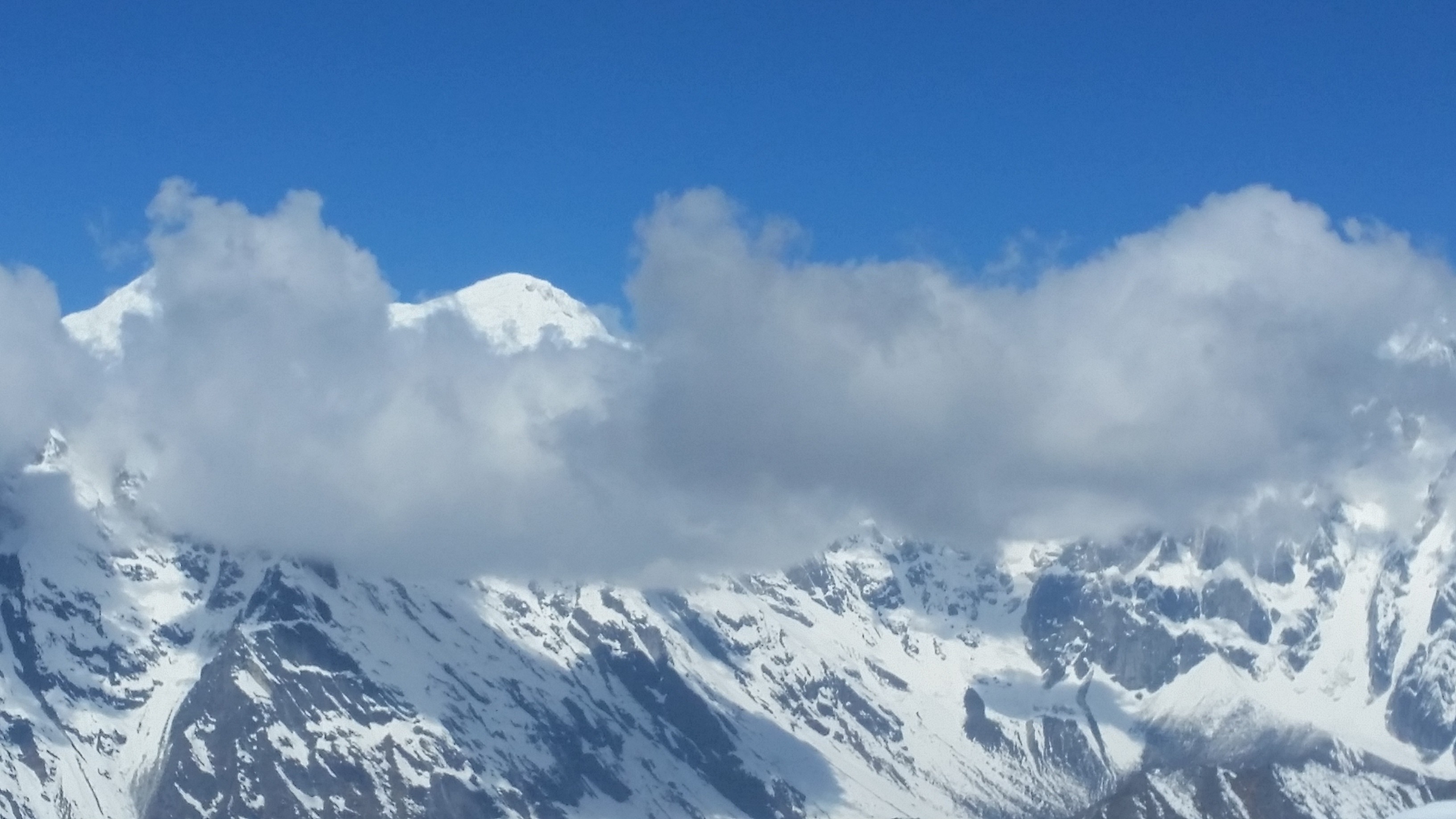
Manaslu Trekking: An amazing tea-house experience
Manaslu is now popular for the tea houses trek. There are many teahouses available on the trail where you could stay overnight or take rest and have some tea during the trek.
Now, these tea houses developed into mountain lodges offering foods and accommodation in nominal price.
Local people manage most of the teahouses, and tourists love to stay in the tea-houses because they get chance to know the local people’s daily lifestyle, tradition, culture which are rarely seen in the rural area.
Trekking Permit
A trekking permit is required to trek any part of Nepal. But before you go there, you need trekking permits, cost, and other information.
There are two types of cost of permits according to the season. You should pay US$ 70 per week and after seven days US$ 10 per day per person. This applies only from September to November month.
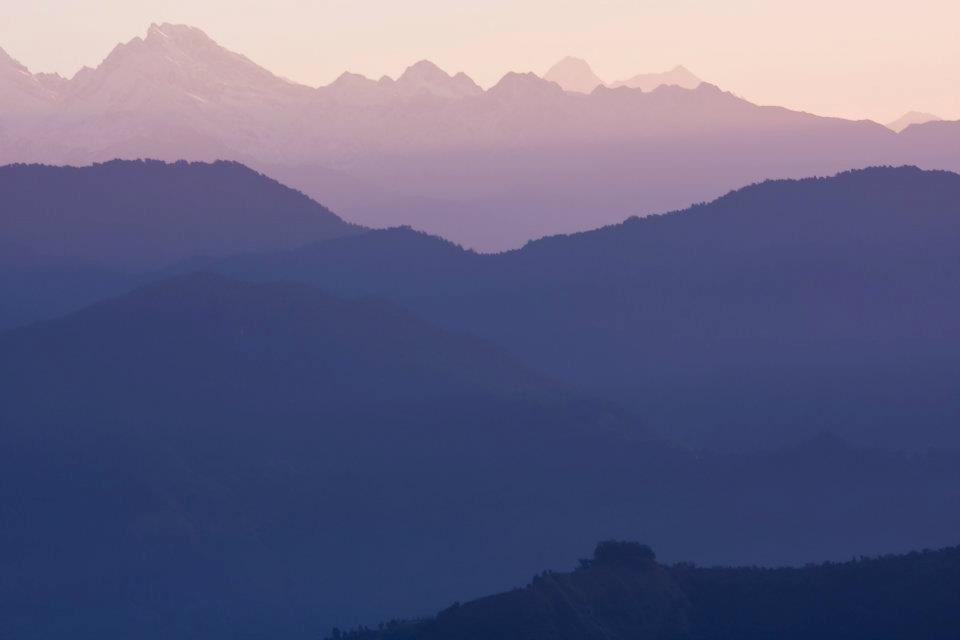
Similarly, from December to August, the cost is US$ 50 per week and after seven days US$ 7 per day. If you want to trek more than one places, then you need more than one permits. Each permit requires details for the route and region.
The trekkers should pay entry fees including 13% Vat to trek Conservation Areas and Trekkers Information Management System (TIMS). Entry fees to trek Conservation Areas are following:
- For SAARC countries: Nepali Rupees 200
- For other countries: Nepali Rupees 2,000
Nepal Tourism Board which is located in the Kathmandu issues entry permits.
Choosing a trekking agency
There are many trekking agencies in Nepal. If you are looking for the best trekking agency, then Nepal Sanctuary Treks is the best agency in Kathmandu Valley.
Nepal Sanctuary Treks carefully plan and pay attention to detail and design trek itinerary just the way you want and deliver all information required for client’s safety, comfort, and pleasure.With the support and guidance of our trek specialist, you can co-create a trekking itinerary to suit your style, taste and physical fitness.
https://www.nepalsanctuarytreks.com/about-us/why-nepal-sanctuary/
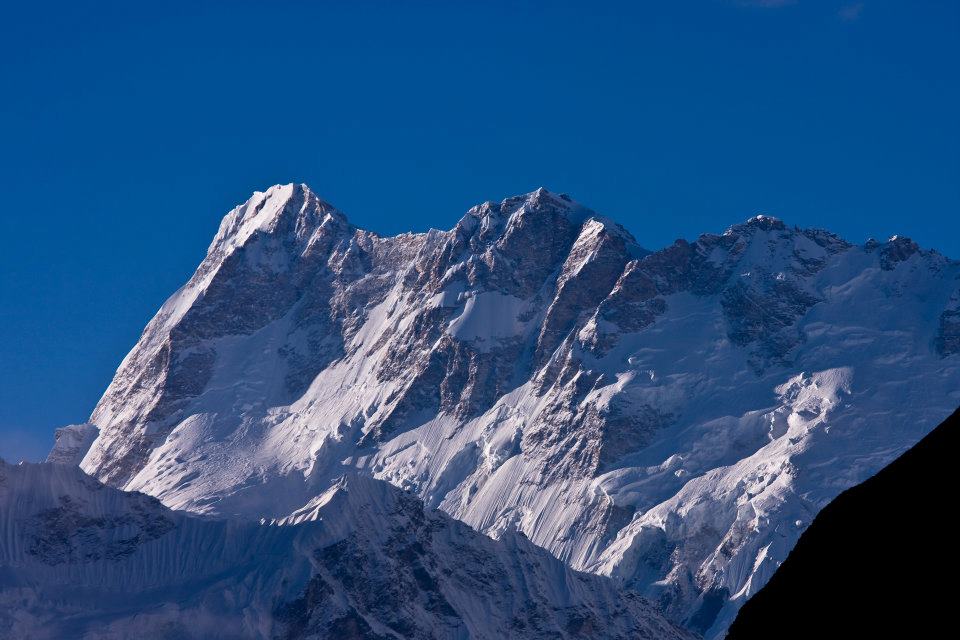
Manaslu Circuit Trekking
Manaslu Trek has one route to reach the peak and another route to return. The Manaslu Trekking is restricted area trek, so consequently, before organizing Manaslu trek, we must take permission for Manaslu region.
It is considered to be one of the challenging and finest trekking adventures of Nepal. The trek could make shorter or longer on the length of your walking days from the starting point to ending point.
The trek for Arughat starts from Kathmandu and takes about 6-7 hours by jeep. You can also travel by local bus. However, it takes a long time.
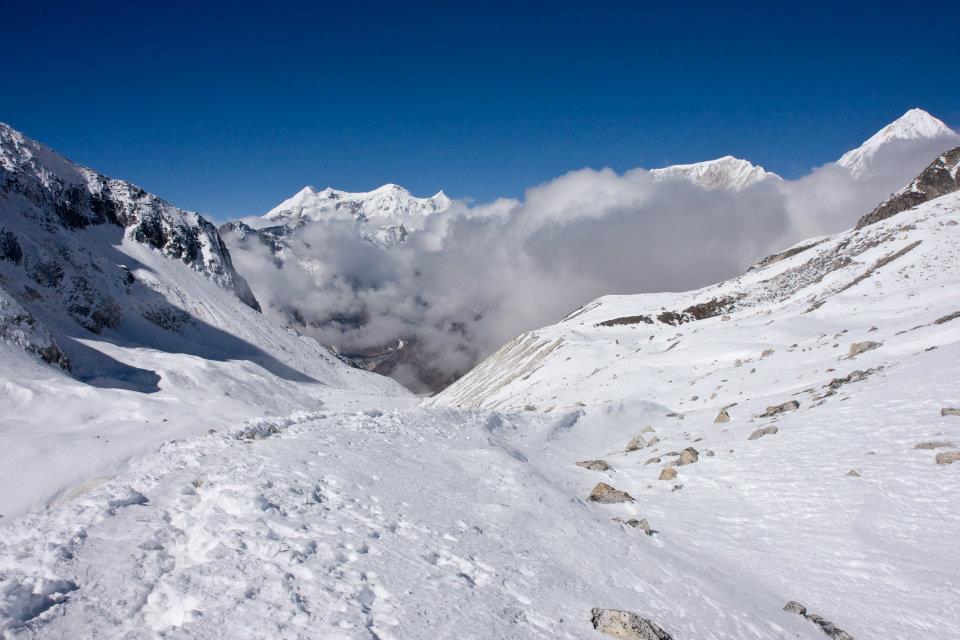
Arughat is the small local bazaar, lies in the bank of the river and has some lodges to spend the night there. The necessary things that you need for the trip are; instant foods and others items can be bought there.
Manaslu Trek begins from the Soti Khola. From Arughat to Soti Khola you can go by bus or private vehicle, but the road is not properly managed. Most people go there by local bus.
The road ends in Soti Khola, and then the walk continues to Manaslu from there. You need more effort to climb up the hills starting at a minimum elevation of 730 m. You can get a pretty nice view of beautiful green hills from the Soti Khola.
From Soti Khola to Lapubesi after about 6-7hours of the walk, through the Sal forest and some villages, green field you will reach villages of Lapubesi which is an inhabitant of Gurung people.
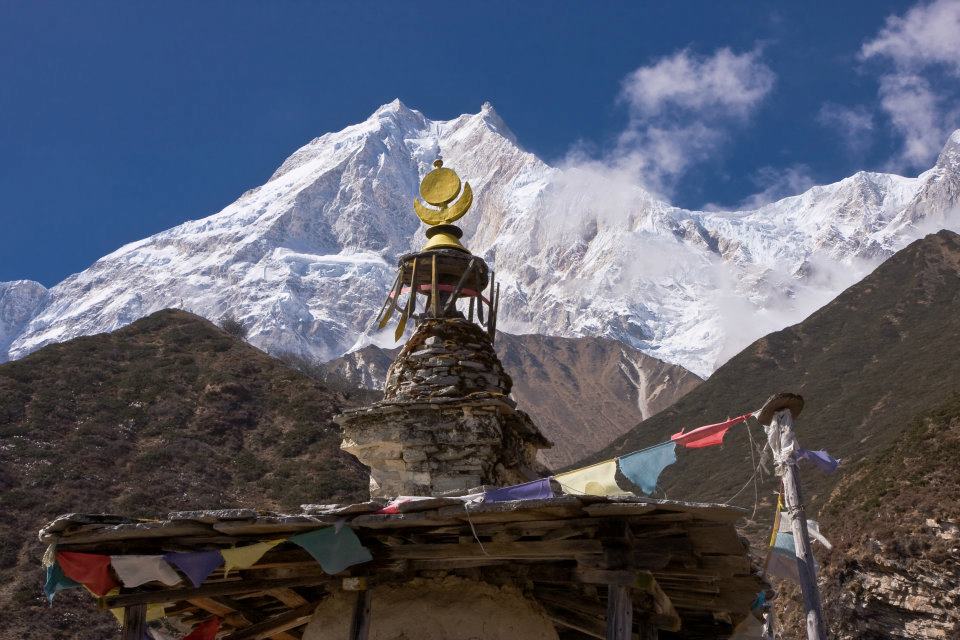
The Gurung people live in the central part of Nepal, of areas such as Gorkha, Baglung and the high slopes of Annapurna. They are Tibetan-Gurung people, farmers who grow rice, millet, maize which are daily works.
They follow both Hindu and Buddhist religions, although they have their religion, with certain rituals and ceremonies. The Gurungs still combine with the belief of the two dominant religions of Nepal.
The trail continues to Khorlabesi for around 7-8 hours of walk from Lapubesi. Crossing the path of the jungle, sometimes up and sometimes steep downside of hills and reach Khorlabesi villages.
You can see pretty scenes of hills and villages then towards to Jagat.
Around 6-7 hours of walk from Khorlabesi, you will reach your next point Jagat. To reach Jagat, you have to go through lots of ups and downs, hills and rock but it makes your mood much better than before.
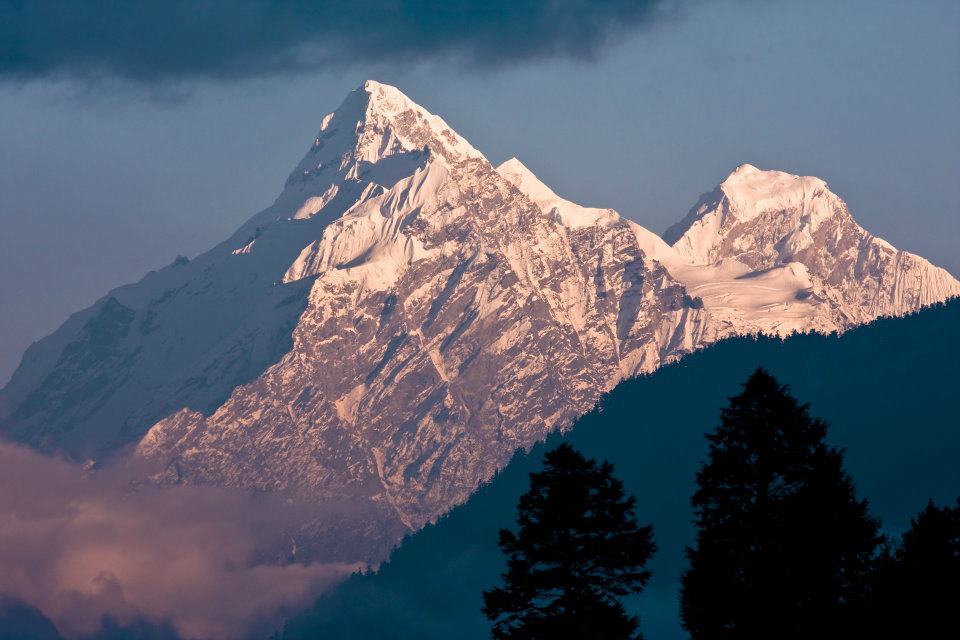
Jagat to Deng takes about 5-6 hours of trekking which passes through the pine forest, Philim villages, and Ekle Bhatti. Ekle Bhatti is a small teahouse where you can take rest and have a cup of tea.
After some hours later you will reach to Deng, a silent valley with small hotels settlement.
Trek to Namrung, after leaving Deng you walk continuously to Ghap to Namrung villages. Namrung is a small village inhabited by Bhote, Lama peoples.
Their main occupation is agriculture and animal husbandry. They raise maize, barely, potato as crop and oats, nut, as fruits. They have their own culture and religion.
The local people want to preserve their historical culture and religion, so they have open Historical Cultural Lakpa Dhundup Museum at Namrung prok VDC.
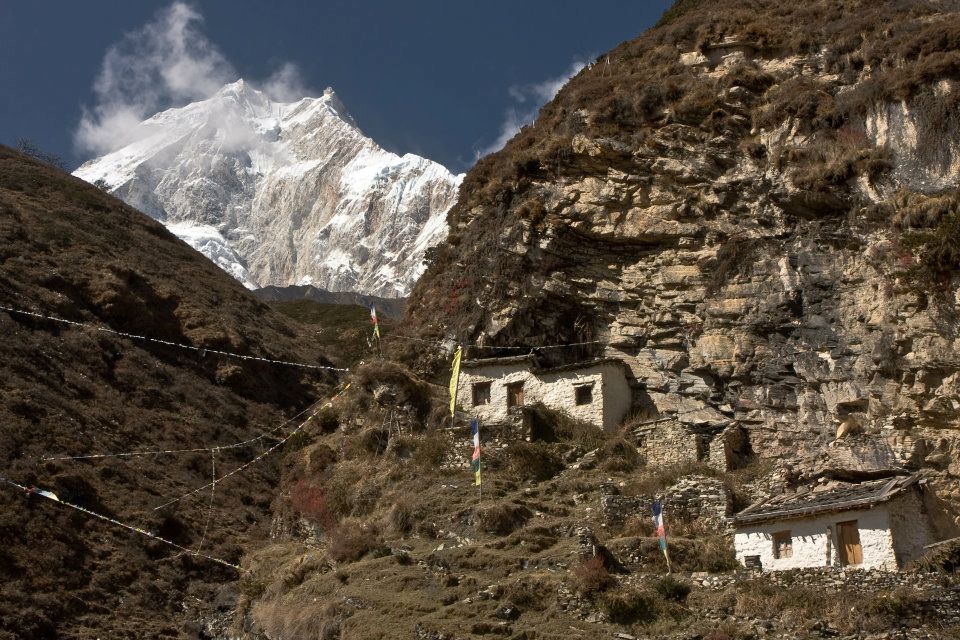
You will walk through villages, beautiful waters, rhododendron forest with white Langur monkey and also you can see beautiful views of Himalayas peak including Ganesh Himal and Himchuli.
The next trek to Samagaon takes 6-7 hours to arrive there. While walking towards Samagaon following Lihi, Sho, Lo, Shyale villages, hilly terrains and bushy forests.
Samagaon is a beautiful village surrounded by prayers flag, and they follow Buddhist Religion. Also, it offers amazing views of Himalayas peaks including Manaslu, Himchuli and peak 29.
During the walk to Samagaon, you can also visit Birendra Tal, Phungen Gompa.
It is a short walk of around 3-4 hours to Samdo after leaving Samagoan. Samdo, the most beautiful place of Manaslu. The places are especially known for yak herding.
This village has more animals and fodder shelter than human settlement. This place offers excellent views of Simrang Himal, Hiunchuli himal, Ngadi Himal, Larkhye Peak, Cheo and Kang Guru Himal.
Next trek to Dharamsala, a hut made by the stone of three rooms and a roof but doesn’t have doors and windows. Everyone can go into Dharamsala, but there’s nothing inside.
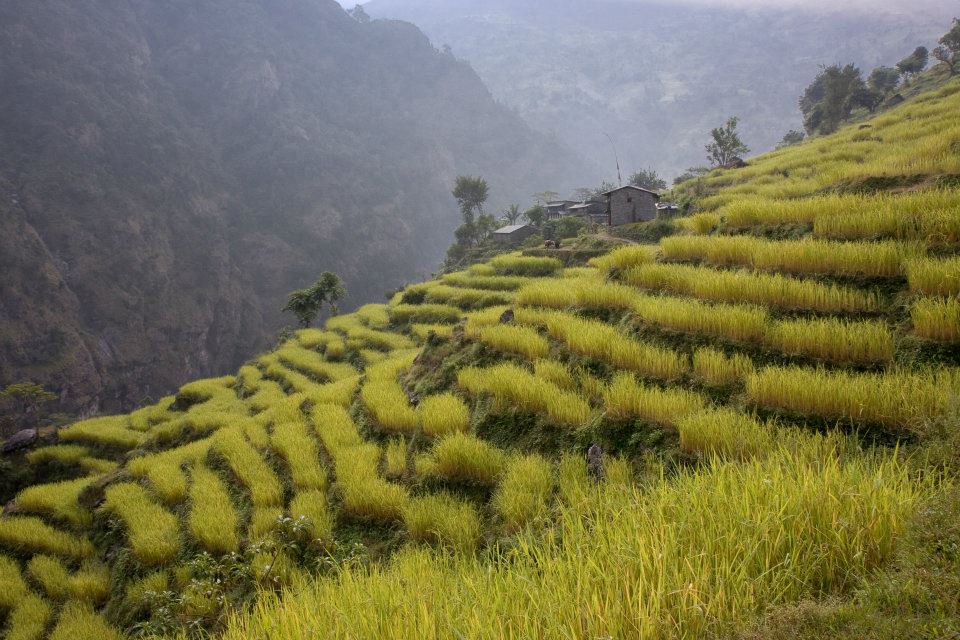
To reach Dharamsala from Samdo; it takes around 4-5 hours of walk passing through Larke Bazaar “a seasonal Tibetan Market.” Dharamsala is also known as Larkya Phedi which is a final part of Manaslu Circuit before Larke Pass.
Larkya Pass
Larkya Pass is the maximum altitude of 5,106 meters.
From Dharamsala, you will climb steadily up to reach the top of Pass. Finally, you will see breath-taking panoramic views of snow-capped Himalayas peak of Mount Manaslu, Annapurna II, Himlun Himal and other mountains.
You can snap the pictures of the beautiful Himalayas and videos too before descending to Bhitmag. Many trekkers become sick due to its maximum altitude.
Bimtang-Tilje-Dharapani
Leaving the beautiful Mount Manaslu behind and start descending to Bimtang takes 3-4 hours and trek to Tilje around 6-7 hours of walk. Passing the rhododendron forest take you to Karachi; one of the highest cultivated village of Nepal.
Then continue to walk to Gho villages where few lodges are available. After few hours of walk, you will reach Tilje village which has better lodges then Gho villages.
After a short walk from Tilje, crossing Marsyangdi Khola through on a long suspension bridge finally, you will reach Dharapani. Dharapani is a small village where small hotel and lodge are available.
Chamche-Besisahar
Chamche is the final trail of Manaslu Trek from Dharapani following Tal villages. Chamche is the most popular place for Annapurna Circuit Trek route with several lodges and accommodation facilities.
Then walk down to Besisahar, which is the headquarters of Lamjung district. Here different cast and religion of people live in one community and have a different culture.
From here, you can get vehicles such as a jeep or local bus and drive to Kathmandu about 7-9 hours.
Manaslu Trek Map

Manaslu Trek Itinerary
Manaslu trek is one of the challenging and demanding trek. Before Manaslu trek, you need to manage itinerary on your daily basis traveling routine.
The well- planned and managed itinerary ensure the best itinerary that makes you trek enjoyable.
You can follow the link below for best itinerary:
https://www.nepalsanctuarytreks.com/package/manaslu-circuit-trek/
Ten facts About Trekking in Manaslu Region
1. Mount Manaslu is an eighth highest peak in the world which opened in 1992. It is still under restricted trekking area of Nepal. It offers stunning views of Manaslu Peak including Ngadi Chuli, Himalchuli, and Boudha Himal.
2. Manaslu is an inhabitant of different ethnics groups such as Gurung, Lama, Bhotias, and Tibetan. They have different cultures. There many ancient monasteries, ethnic heritage and culture and unique houses made of stone.
3. Manaslu Trek is famous for small teahouses. The teahouses are built and managed by the local peoples. Tourist loves to stay there and get opportunities to know closely about local lifestyle.
4. Manaslu Trekking has countable visitor than Annapurna Base Camp Trek, Everest Base Camp Trek, and other trekking which makes entire Manaslu region unspoiled and more exclusive.

5. Manaslu is mainly inhabitant with two regions: Nubri and Tsum. Most people visited the Nubri valley after tourism board announced it as a touristic place in 1950. And Tsum is still out of touch with You will see traditional lifestyle, art, and culture.
6. Crossing the higher pass of Larkya Park at elevation 5,106 meters. Descending to Bimtang is more difficult than climbing. Descending towards Bimtang must use some technical trick. From Bimtang, the back view of Mt. Manaslu is amazing.
7. Toshio Imanishi and Gyalzen Norbu were the first to climb Mount Manaslu on 9 May 1956.
After them, many Japanese teams have climbed the summit of Manaslu but got failed. Mount Manaslu called Japanese Mountain and also known as Killer Mountain because of its frequent icefall, and high altitude trekker gets sick or kill.
8. Mount Manaslu which is in Gorkha district has lots of offers historically as well geographically such as Manakamana Temple, Lower Manaslu Trek, Tsum Valley Trek, Nubri Valley Trek. Manaslu Trekking route starts from Arughat and ends in Besisahar.
9. The spectacular scenario of rhododendron forest, perfect views of mountain ranges, a combination of rich culture, natural beauty and biological diversity.
10. The Tsum Valley Trek in the region has beautiful views of surrounding mountains peak, but extra trekking permit is compulsory need to travel there.
Precautions to take in Manaslu Region
Before you travel there, you need to know all things about Manaslu region such as about high altitude, weather, hygiene and daily health care. Firstly, you can easily become dehydrated at high altitude.
The lower air pressure will force you to breath more quickly and deeply. So, you will have a drink a lot of water than you normally would have. The most common symptoms include thirst, dry lips, nose or mouth, headache and feeling fatigued.
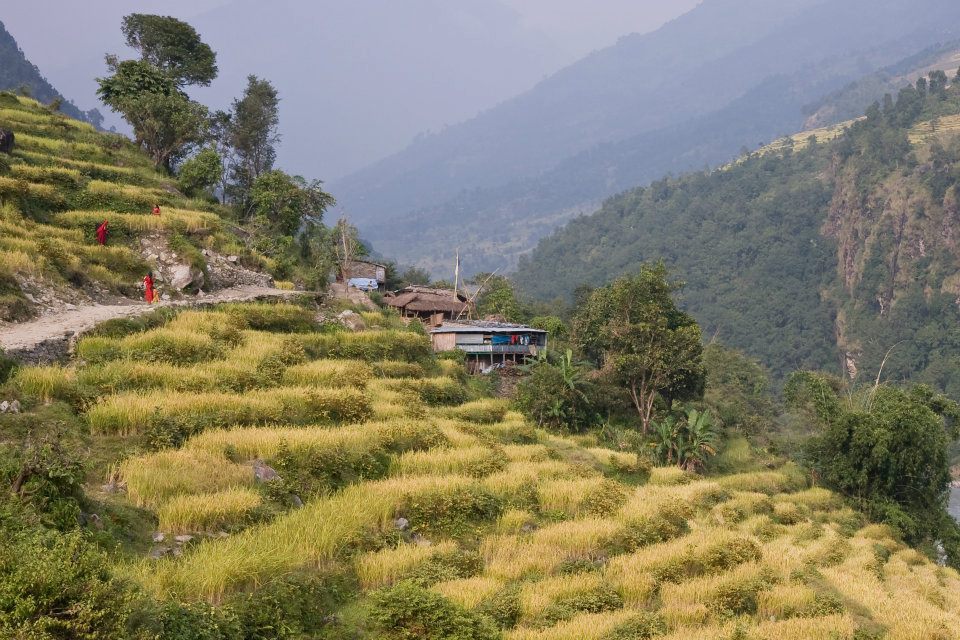
You should drink at least 3 liters everyday trekking. Also, it is important to maintain your daily hygiene in a remote area which might affect your health and brings hand sanitary with you.
Due to cold weather, you might get sick, so warm clothes such as down jacket, electrical socks, hat, etc. are most necessary things that must have with you.
Tsum and Ganesh Himal Trek and Nubri Valley
Tsum valley and Nubri valley is one of the famous and hidden treasures of Manaslu region. Tusm words come from the Tibetan word ‘Tsombo’ which means vivid. Tsum valley is mostly the origin of Tibetan and people in that valley speak unique dialect.
Tsum valley offers the beautiful forests covered with rhododendron tree and a stunning view of Ganesh Himal.
Tsum valley always combines with Manaslu Circuit. The trail starts from the Arughat and continues the low, high passing through the forest and small villages.
Manaslu Trek passes through the Tsum Valley. The place is famous for the ancient Buddhist monastery. Geographically the valley called ‘Tsum Tso Chuksum’ which means thirteen provinces ruled as a single territory.
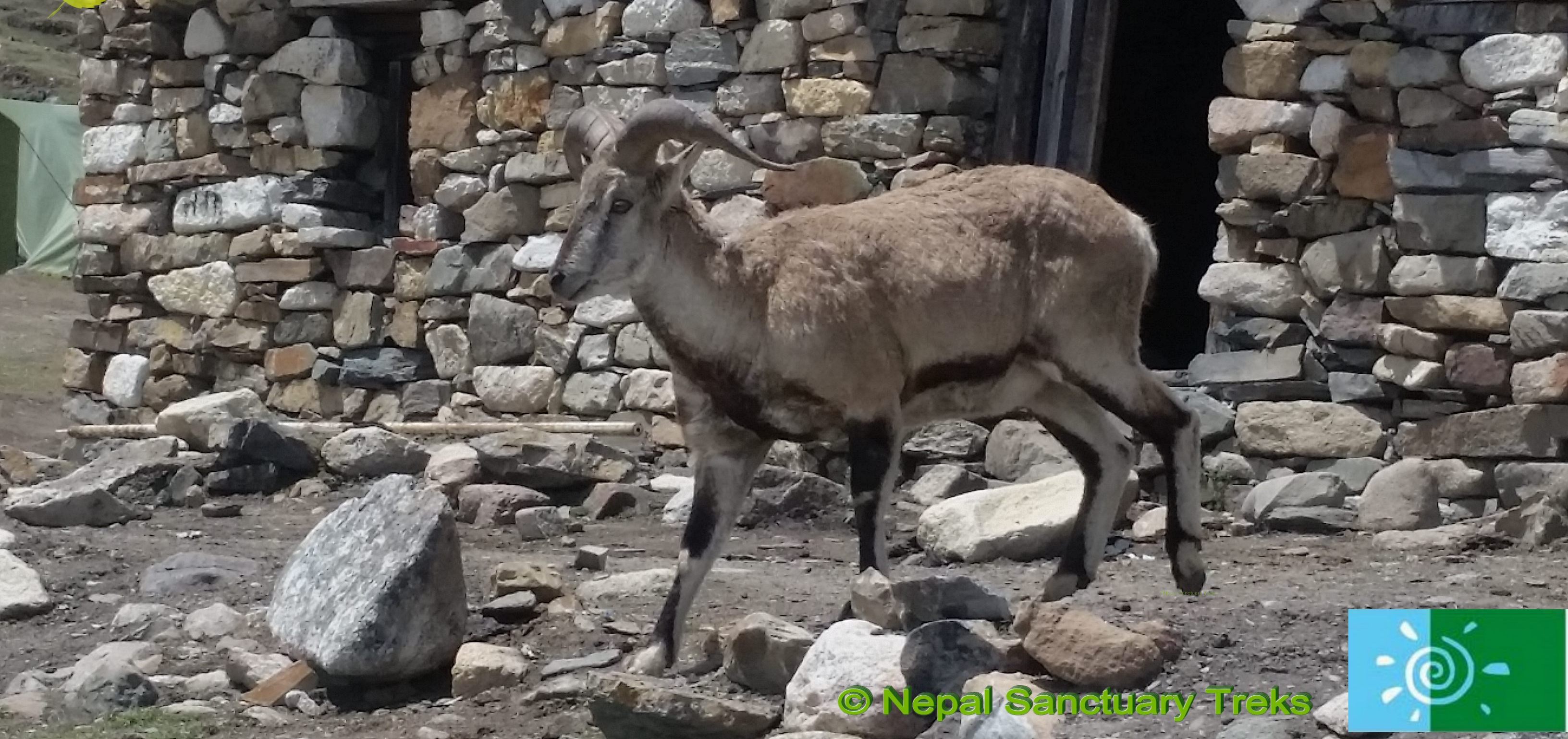
Nubri Valley also connects with Manaslu trek. Nubri valley still follows the traditional culture, art and it is untouched by the modernization.
Weather and Difficulty in Manaslu Region
Manaslu trekking is one of tough trekking compared to other mountain treks. The best time to visit Manaslu is Autumn and Spring season. Autumn months starts from October to November and March to May.
The weather on this season is pretty much fine than other seasons. In Monsoon and Winter seasons it hard to trek in Manaslu due to the rainfall and high coldness.
So How to start your Trip?
Firstly, the question might strike in your mind about How to start your Trip? It’s not that difficult; you can contact Nepal Sanctuary Treks.
Nepal Sanctuary Treks is the best trekking agency of Nepal. We would be glad to consult you via phone, Whatsapp or email if you feel further discussion. Our trekking professional will assist you to provide proper guidelines, process and more information on Manaslu trek.
Nepal Sanctuary Trek contact details:
G.P.O Box 5493
House No. 1246, Lamtangeen Marg, Chundevi-4, Kathmandu
Tel: +977-1-4426721, 4431610, 4434542
Email: [email protected] , [email protected]
Related Blog
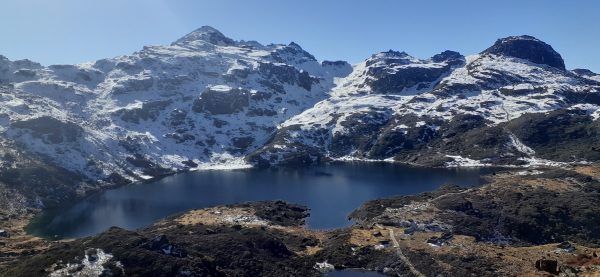
Makalu Base Camp – Trek into the heart of the wildest Himalayas
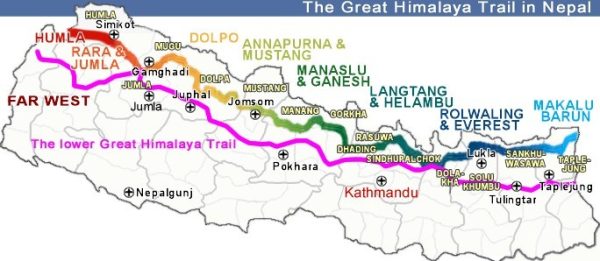
The Great Himalaya Trail: Explore the most exciting hidden corners of Nepal
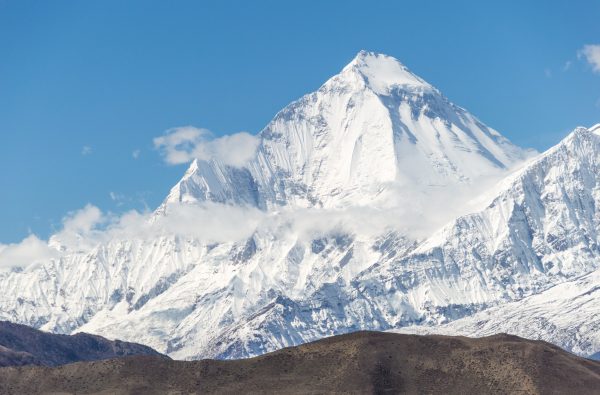
Dhaulagiri Circuit Trek: a Demanding Trek to the Stunning Mountain
Affiliations & recommendations.


Manaslu Circuit Trek: The Ultimate Guide
Jackson Groves
Posted on Last updated: July 10, 2023
Categories HIKING , NEPAL
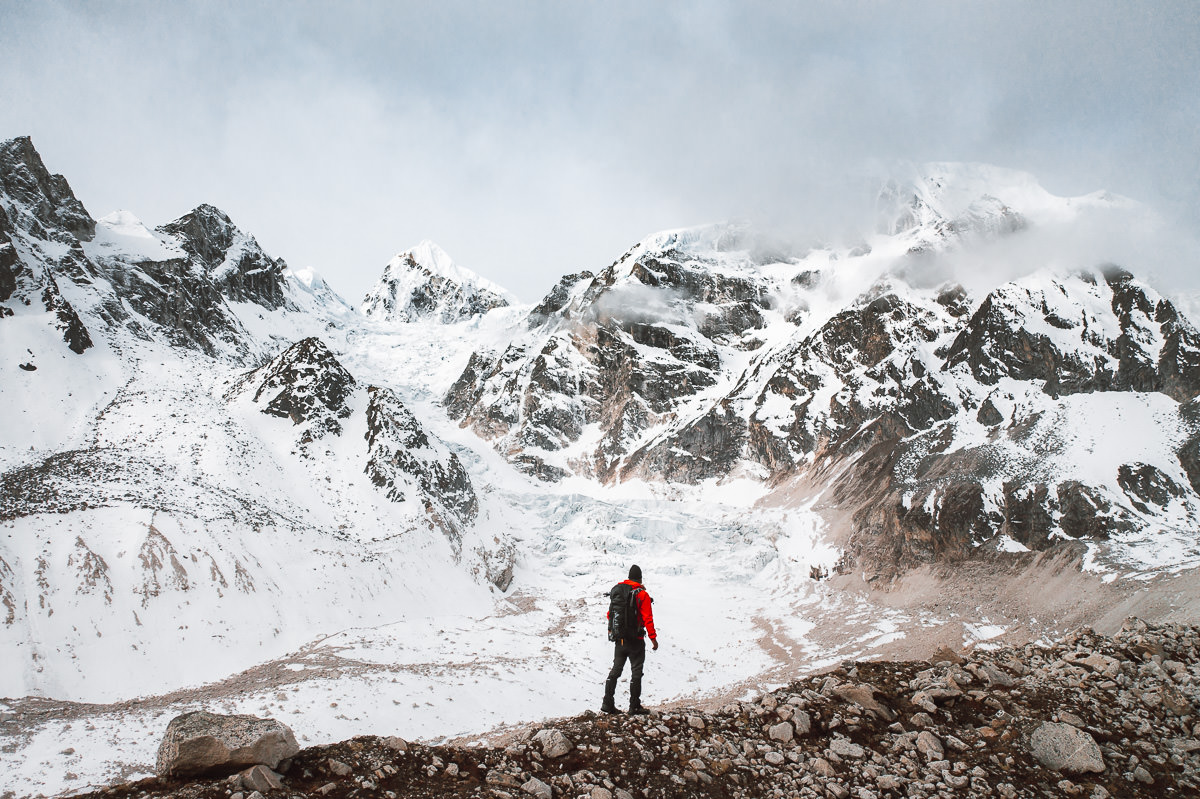
The Manaslu Circuit Trek is an off-the-beaten-path trail in the Himalayas of Nepal. The route leads you up and around the base of Mount Manaslu as you stay each night in different Tibetan villages along the way. The scenery is incredible, especially the last few days of the circuit as you reach heights of above 5000 meters while crossing the Larke Pass, also known as Larkya La Pass.
TRY THE 3 BEST TREKS IN NEPAL

Manaslu Circuit : My personal favorite 2-week trek through Tibetan villages and stunning scenery. Less crowded and more authentic.
Annapurna Circuit : The most beautiful & scenic 2-week trek in Nepal although can be crowded at times.
Everest Base Camp Trek : The most iconic 2-week route reaching the famous (EBC) Everest Base Camp at 5,300m.
I highly recommend this circuit for those who looking to avoid the crowds of Annapurna Circuit and the Everest Base Camp Trek. The highlight of this circuit is the authentic culture of the Tibetan villages along the way and takes you around Manaslu, the world’s eighth-highest mountain at 8,163 meters (26,781 ft).
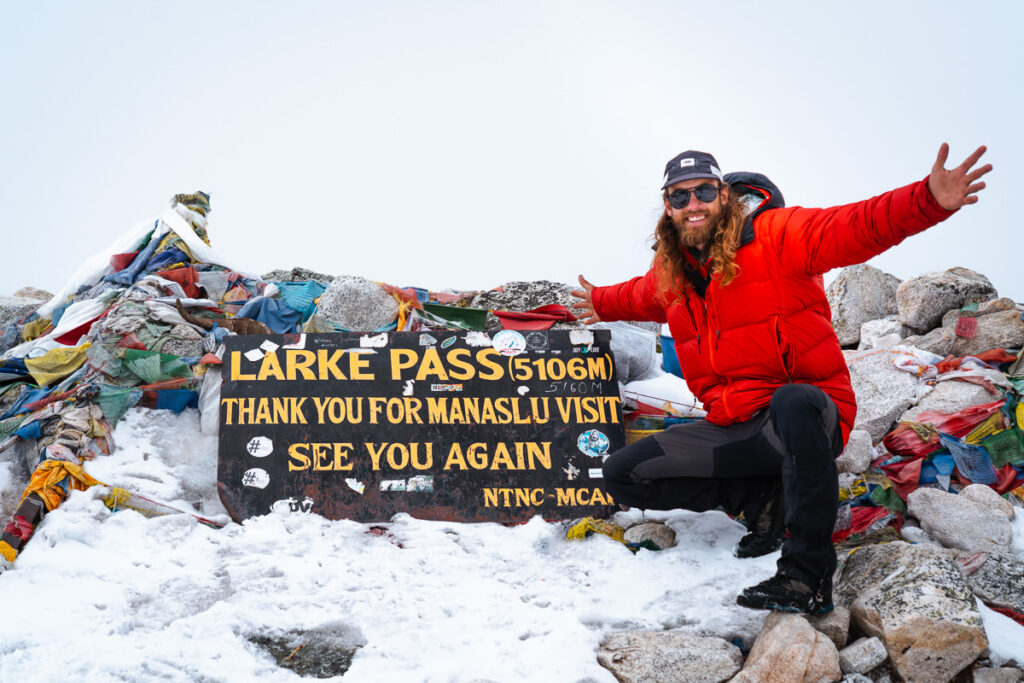
Before sharing my experience on the trek with One Globe Travel in the second section of this blog post, I will detail all of the information you have to know in this complete guide about the Manaslu Circuit Trek.
You can use my discount code ‘ JACKSON5 ‘ for 10% off the total price of your trek with One Globe Travel , which is a pretty handy saving of almost $200! To book the trek with One Globe Travel you can visit their site by CLICKING HERE or contact them via the details below:
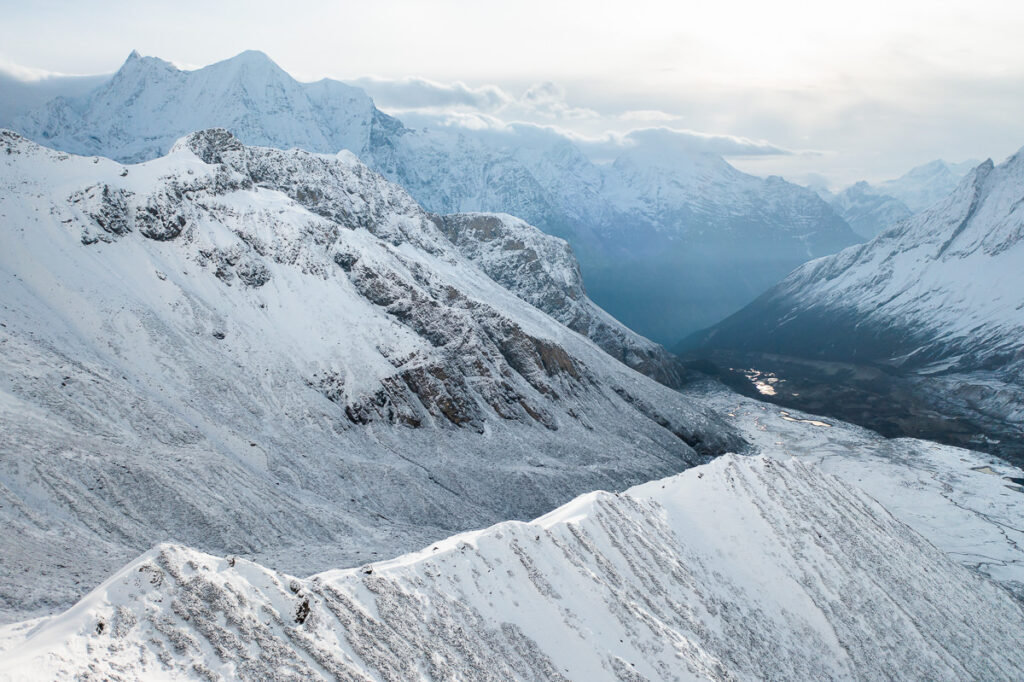
THE MANASLU CIRCUIT TREK GUIDE
In this blog post, I will cover everything you need to know about the logistics of the Manaslu Circuit Trek and also share with you my experience on each day of the trek in the form of a short journal entry and my photos from that day. This will give you an idea of what to expect and a great insight into the scenery you will find on each day of the trek.
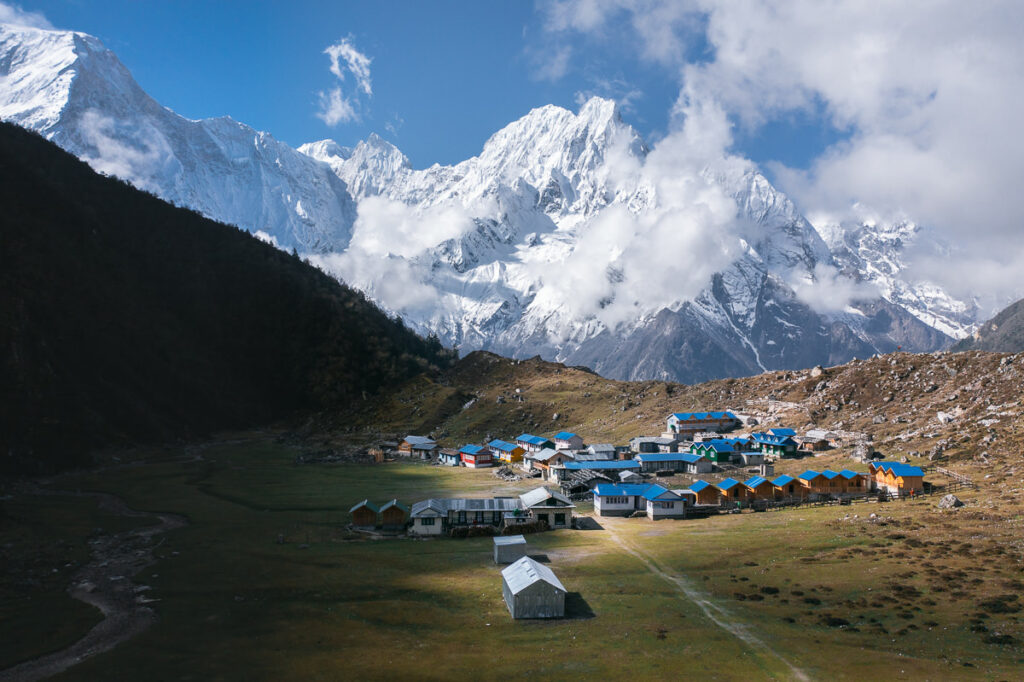
MANASLU CIRCUIT TREK DETAILS
- Distance : 180 km through-hike from Machhakola to Dharapani
- Days required : 12 days
- Total Incline : ( with undulation) – 11,000 m
- Total Decline :(with undulation) – 9,800 m
- The highest point on the trek : 5200m, which was just above the Larke Pass (Larkya La Pass) on day 11.
- Difficulty : This trek was much harder than Everest Base Camp Trek as it was 30% longer, much steeper, and less commercialized. Having said that, it was basic walking and there was nothing technical. Our longest day was 27km with 1600m of incline. If you can handle the altitude of 5,200m and can walk each day for 6-10 hours, you will be fine on this trek. The acclimatization profile was very good as you have 11 days to reach the highest point, so it eases you into it.
- Permits : Your tour operator will take care of these in each town and for the Manaslu Circuit Trek it isn’t possible to hike independently. You must hike with a guide and there must be at least two in your group, as well as the guide.
- Guide : A guide is required on this trek and the guide manages all of the logistics, distances, directions, and tea houses. The directions weren’t always very clear like on the Everest Base Camp trek and having the guide manage all of the logistics was great. I went with One Globe Travel and highly recommend them.
- Accommodation: Guest Houses, also known as Tea Houses, are available along the way where you will sleep in a comfortable bed and have access to showers (extra charge) and restaurant facilities. Very comfortable accommodation and great after a long day of hiking. Most of the villages were Tibetan, which gave us a great insight into their unique culture.
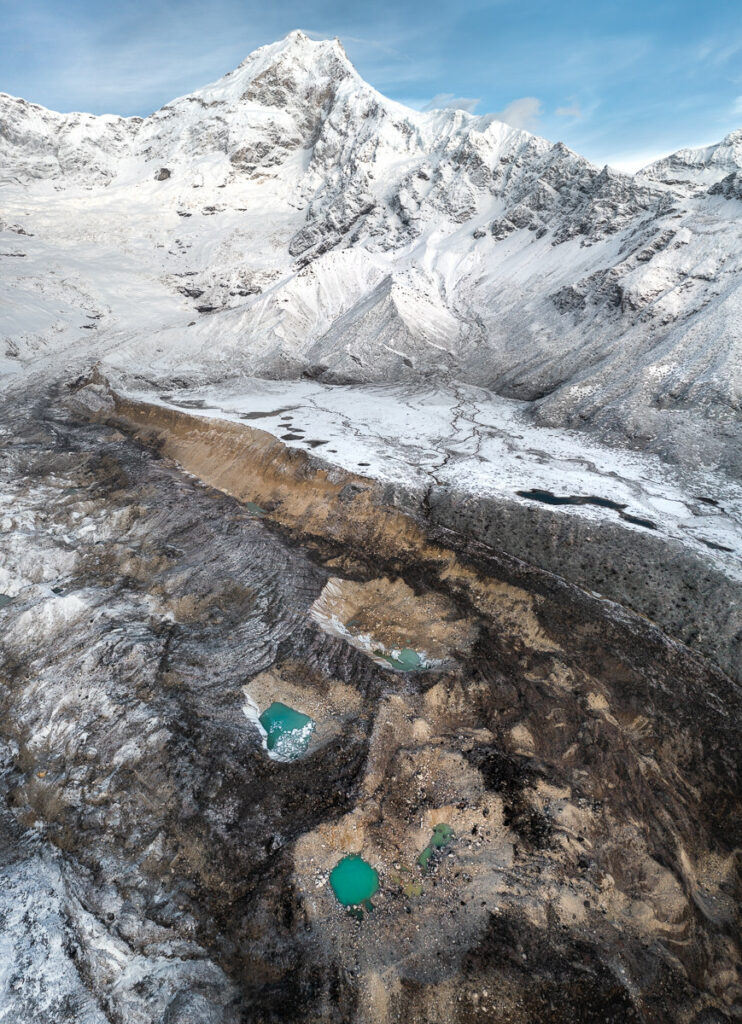
TOP 3 PLACES TO STAY IN KATHMANDU

- Ultimate Luxury: The Dwarika’s Hotel – Luxury, Spa-service, Pool
- Best Value : Aloft Kathmandu Thamel – Swimming Pool, Gym & Great Restuarant
- Budget Choice: Hotel Jampa is easily the top cheap hotel in Kathmandu
KEY POINTS ABOUT THE MANASLU CIRCUIT TREK
- This circuit is way less crowded than Everest Base Camp and the Annapurna Circuit. It is growing in popularity but it’s still a great time to trek this circuit before it hits the mainstream.
- The Manaslu Circuit trek is off-the-beaten-path and remote. However, there are teahouses in each village along the way so each night you get a great sleep in a bed with blankets, have access to showers, eat great meals in a restaurant, and can charge your electronics and cameras.
- The trailhead can be reached by car so there is no need to pay for expensive domestic flights.
- The first few days of the circuit run along the trail next to the river in a deep gorge called the Buri Gandaki with lots of suspension bridge crossings. The trek transitions to the snow for the last few days although you can trek with regular hiking boots while enjoying the massive snowy mountains on either side of the trail.
- The scenery is constantly changing and you will experience a subtropical jungle while at lower elevations before entering the Himalayan foothills. Finally, you will reach the Larkya La above 5,100 meters / 17,000 feet.
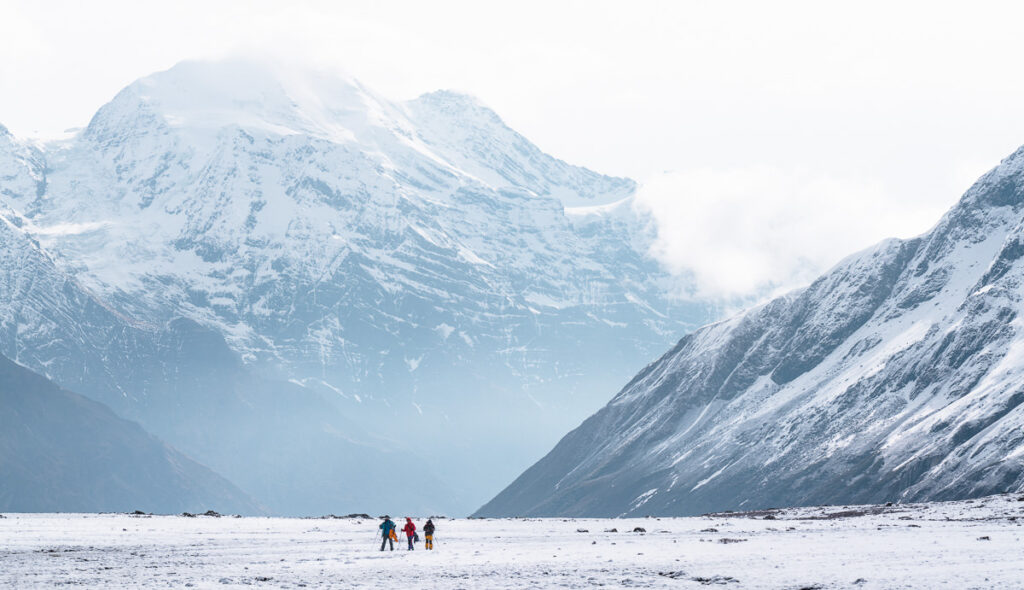
BOOKING A GUIDE FOR THE MANASLU CIRCUIT
The Manaslu Circuit Trek does require a guide. Everest Base Camp and Annapurna Circuit can be done independently but the rules on the Manaslu Circuit are stricter about having a guide. I did the trek with Samip from One Globe Travel , which is one of the top trekking companies when it comes to Manaslu Circuit. The owner, Nawang, is a Tibetan himself, which is the main culture you will experience along the circuit.
The trek costs around $1800 USD with One Globe Travel as of 2021 and includes all transfers, accommodation, meals, drinks permits, and even the hotel stay before and after the trek at a 4.5-star hotel with a rooftop pool. I honestly had a great time, the guide was great and I can wholeheartedly recommend One Globe Travel. They even helped me many weeks after the trip during the lockdown in Kathmandu.
Book now: One Globe Travel
Email: [email protected]
Phone Number: +977-01-4003071/72/73
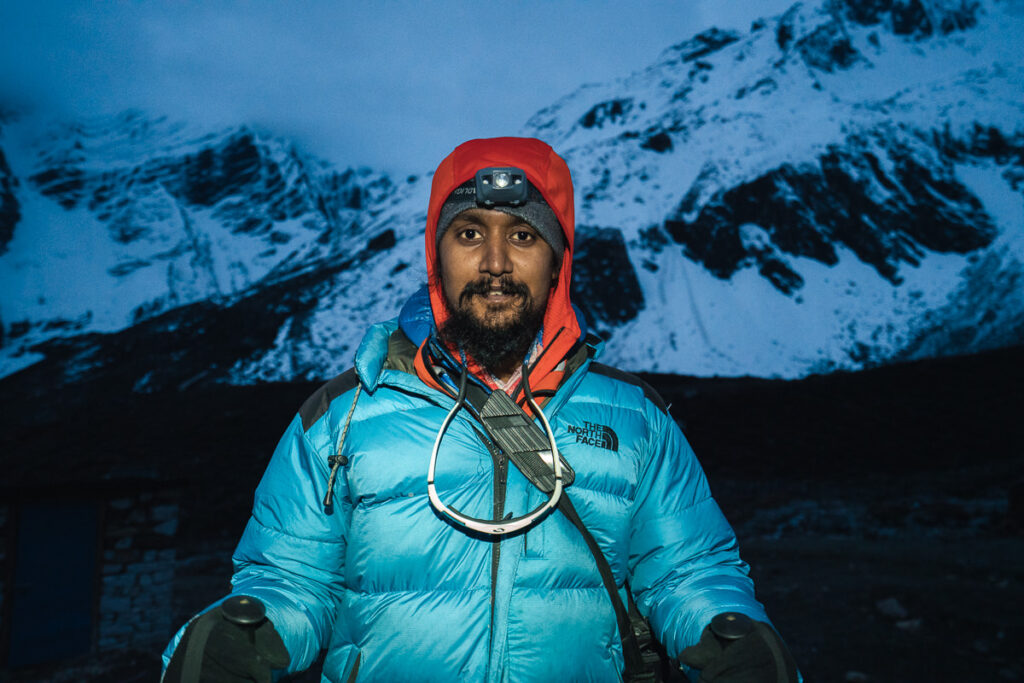
MANASLU CIRCUIT TREK PACKING LIST
I pack pretty light and managed to wash most of my clothes each afternoon/night for the first half of the trip. In the latter stages of the trip, it was pretty cold so we weren’t sweating as much and we wore our warm gear basically nonstop while at the teahouses and there was no real need for multiple outfits. This is just a guide and it worked quite well for me with no complaints from my set-up.
You won’t need a sleeping bag as there are blankets in each guesthouse and when it got cold I just wore my down jacket. This meant I didn’t have to carry a sleeping bag for 12 days, although our guide did.
- 1 pair of pants that maybe convert to shorts
- 1 pair of shorts
- 1 Warm or thicker pair of hiking pants
- 1 Long sleeve quick-dry shirt
- 1 Long-sleeve thermal shirt
- 2 Short-sleeve t-shirts
- 1 Thermal long underwear
- 4 pairs of quick-dry underwear
- 1 Lightweight down jacket
- 1 Heavy-duty summit down jacket
- 1 Neck Buff
- Hiking boots
- Microspikes
- 1 pair of warm summit socks
- 2 pairs of regular socks
- Trekking poles
- Water filter
All of this should fit into a backpack no bigger than 50L and be less than 15kg. I actually took a 40L camera bag, which you can see in the photos so I went super light. My camera gear included a DJI Mavic Pro 2 drone, 100-400mm, Mirrorless body, 16-35mm lens, 24-105mm lens, GoPro Max, Sony RX100, and a tripod. Without all of that, a 30L backpacking bag would have been enough.
Having said that, our guide and one of the girls on the trek had an 80L pack. I would say a 60L pack would be just about right for this trek and you would have lots of space assuming you wouldn’t need to fill it up.
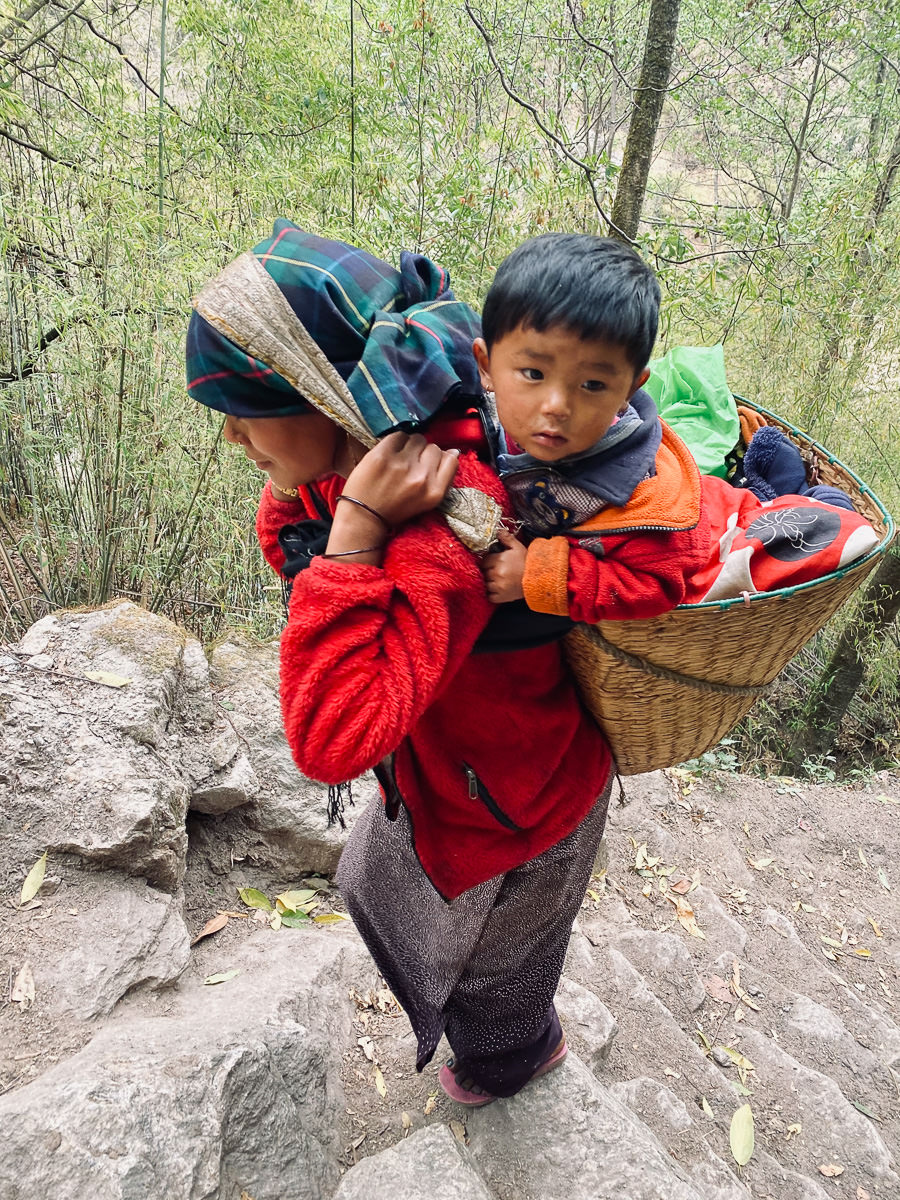
TREKKING THE MANASLU CIRCUIT: WIFI/ELECTRICITY AVAILABILITY
Wifi: Costs anywhere from $free to $4 to use wifi at the guesthouses. Buy an NTC Sim before you go. It worked early on in the trek with a weak signal and I was able to get emails and chat on Facebook messenger all the way up until about day seven and then we were off-grid.
Lots of the tea-houses say they have free wifi but then will blame the weather that it isn’t working. If you really do need it, test the wifi before picking your tea-house. Overall we had some minimal connection about 40% of the time on the trek. Samaguan had decent wifi and we stayed there for two nights so caught up with all of the news and action online.
Electricity: You will have to pay anywhere from $free at low elevations to $5 to charge your power banks, cameras, and phones. The key is to get a fat power bank. Pay to charge that then charge everything from your power bank. My power bank lets me charge my phone and four camera batteries before it would be done.
Most of the places we stayed let us charge our gear for free but when it is busy they usually charge as they run off gas or solar in many of the tea houses.
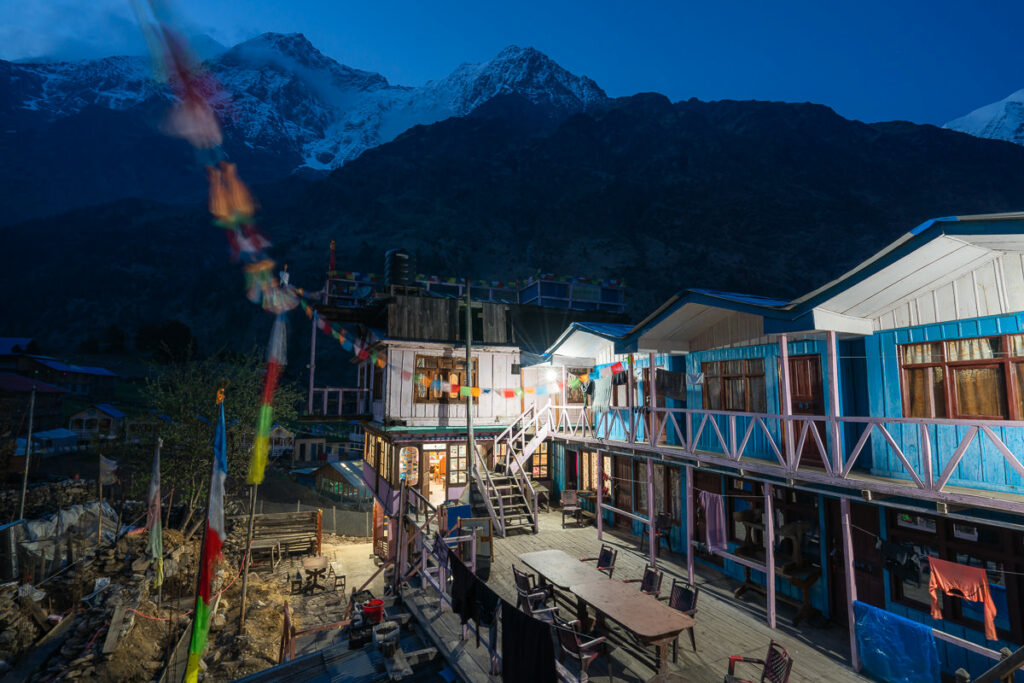
MANASLU CIRCUIT ITINERARY
There are many ways to alter the route on the Manaslu Circuit just as there are lots of different options for day trips on your acclimatization days. However, for the sake of giving you a rough idea of what your itinerary and acclimatization profile will look like this is a proposed itinerary and what my trek entailed but depending on the weather, your guide, and your preference it can be altered.
- Day 1, Machhakholagaon (862m) to Jagat (1,330m) – Distance: 26km, Incline 1512m
Day 2, Jagat (1,330m) to Deng (1880m) – Distance: 21km, Incline 1636m
Day 3, Deng (1880m) to Prok (2275) – Distance: 14km, 1082m
Day 4, Acclimatisation day: Prok day-trip to Kal Tal Lake (4100m) – Distance: 13km, Incline 1600m
Day 5, Prok (2275m) to Namrung (2661m), Distance: 10km, Incline 660m
Day 6, Namrung (2661m) to Lho (3200m), Distance: 11km, Incline 900m
Day 7, Lho (3200m) to Samagaon (3500m), Distance 8km, Incline 600m
Day 8, Acclimatisation day: Day trip to Pungen Gumba (4200m), Distance 17km, Incline: 800m
Day 9 , Samagaon (3514m) to Samdo (3862m), Distance: 9km, Incline 600m
Day 10, Samdo (3862m) to Dharma Shala (4466m), Distance 7km, Incline 700m
- Day 11, Dharma Shala (4466m) to Bhimtang (3709m) via Larke Pass 5134m, Distance: 18km, Incline 800m
Day 12, Bhimtang (3709m) to Dharapani (1860m), Distance: 25km, Incline 350m
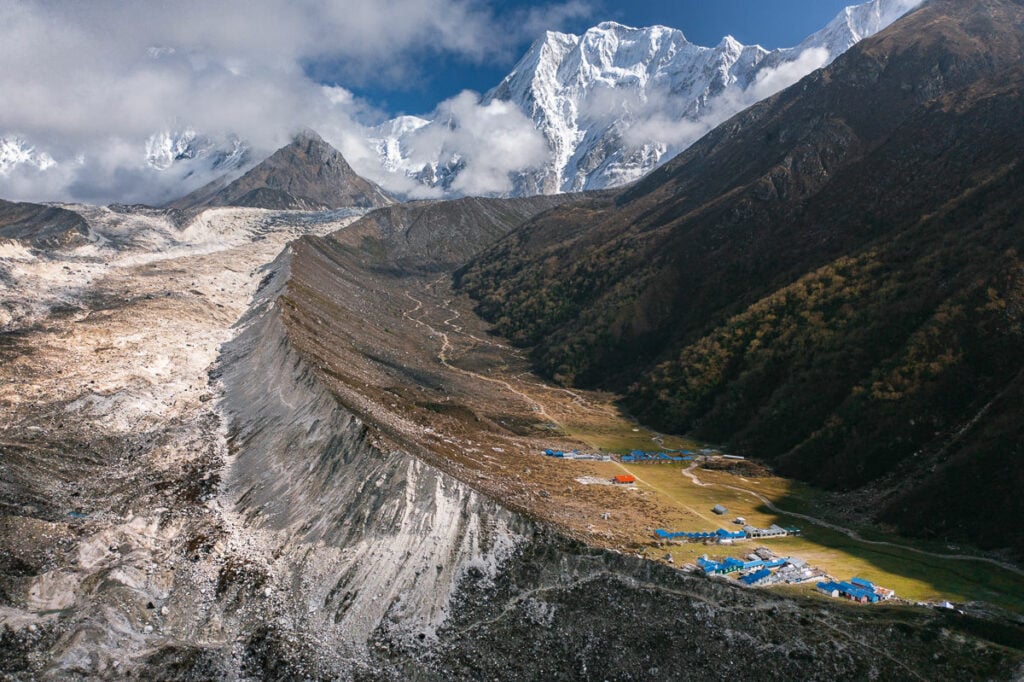
MY MANASLU TREK VIDEO
I filmed from start to finish to give you an insight into how the trek looks and what to expect. I hope you enjoy the video.
MY EXPERIENCE ON THE MANASLU CIRCUIT TREK
For each day of the trek, I will share the details of the route for that day, a few highlights of mine personally that I wrote each night while trekking, and some of my favorite photos from that section of the route.
Day 1 , Machhakholagaon (862m) to Jagat (1,330m) – Distance: 26km, Incline 1512m
The first day of the trek begins in the small town of Machhakholagaon . You will quickly find your place alongside the Budhi Gandaki River, which follows the gorge. The trail is a dusty road blasted into the cliffside for the most part although there are a few narrow sections including a number of river crossings (no wet feet) and suspension bridges. Expect to be exposed to the sun with little tree cover and be greeted by some steep staircases that will be a shock to the legs on the first day of trekking.
Day 1 Highlights:
- Setting off out of the town in golden light. Felt lucky to be here and excited for what was to come. With little idea of the landscapes in store, it was a truly adventurous atmosphere surrounding our group.
- Following the raging river, all day provided some stunning scenes. Around each turn and beyond each set of stairs we found a beautiful view. Mountains high our necks hurt towered above us on either side, with the river winding its way through like a serpent.
- On a very hot day, the Coca-Cola at our lunch break really hit the spot. Temperatures stung the skin as we battled through 25km and 1500m of incline underneath a piercing sun.
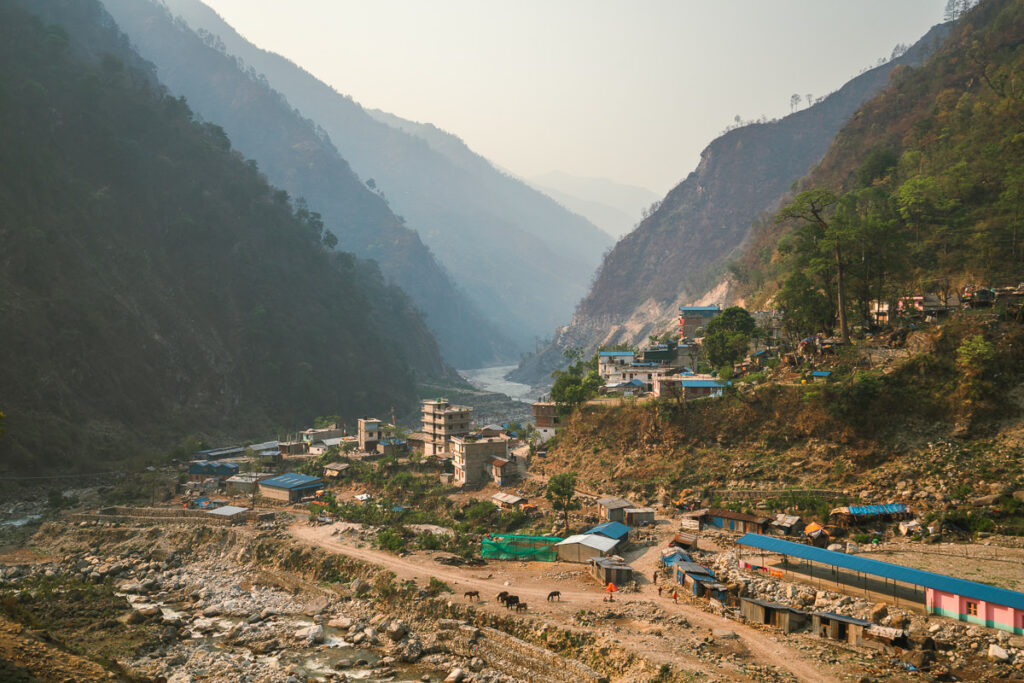
We woke a little bit sore and tired as our bodies adjusted to life on the trekking route. From Jagat, the trail wound through sub-tropical forests, alongside small rivers and quiet villages where we often stopped for a cup of tea.
The valley opens up in the early stages of the trail, which reaches Ghatta Khola river. One of the interesting parts about the route today is the very long suspension bridge in Philim, which is a large Gurung village. Later in the day, the route passes through a wild gorge as you criss-cross the river on suspension bridges before passing through the bamboo forests to the Deng Khola river. After crossing the river, you’ll reach the tiny village of Deng.
Day 2 Highlights:
- The layers of mountains were sometimes five or six deep as I began to wonder how we could be so high, yet so far below these peaks.
- Reaching camp today just before sunset was a great feeling. Back-to-back days of 20Km+ day with 1500m of climb means I surely deserved a Gorkha beer!
- The suspension bridges are always fun and today we crossed a couple of very high passes. There’s always an element of risk and excitement with these suspension bridges as they’re tattered with holes and battered by rockfall.
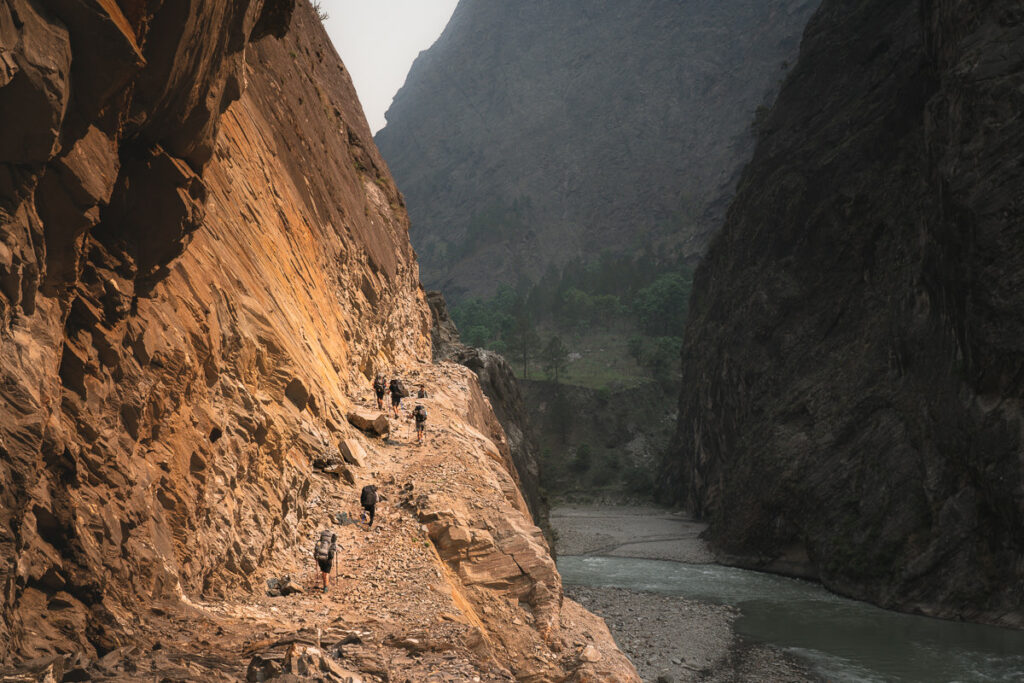
After breakfast in Deng, the trail takes you to one of the most important and culturally significant sections of the trek. Firstly, you will cross the Budhi Gandaki river and make the climb up to the bridge, where you’ll ascend further to join a trail from Bhi. The trail then leads you through the lush forests, alpine vegetation, and small villages. This is the first time the major peaks will start to appear in the distance.
Today is a shorter day and after a final ascent through the forest, you will reach Prok, a Tibetan village situated on a very scenic plateau beneath towering peaks. Green and yellow farming fields create a patchwork display of colors in this traditional town. It’s time to settle in because on this itinerary, we stay in Prok for two nights.
Day 3 Highlights:
- Sitting inside a tiny tea house, precariously perched on a cliff-side when a storm hits. As the rain hits the tin roof and the wind blows wildly all I can think about is how isolated people in this region are and how inhospitable the weather can be. That gets more and more apparent the higher we climb.
- A few stunning suspension bridges today with a lush green forest below contrast against the cool hues of the glacial river. Nepal is truly beautiful.
- We reached our guest house for the night in Prok, which is a very small village. I sat in the kitchen loft with the 81-year-old grandmother and the wife for Tibetan tea as we watched the Daal baht process. The kitchen and entire house were traditional Tibetan style. The grandmother spun her prayer wheels and through our guide’s translation told us she feels Tibetan, not Nepali. Having two of the guys on the trek translate gave us unique insight into the experiences and life of a Tibetan from the pre-Chinese occupation era.
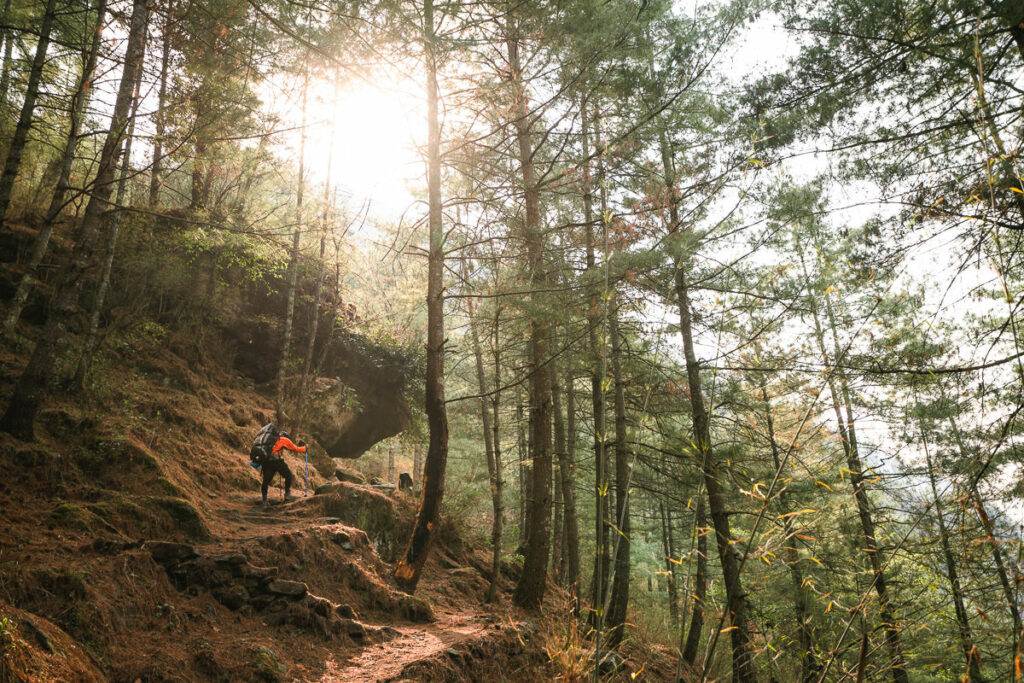
Today was a pretty heavy day with a very steep climb up to Kal Tal lake. The route is basically straight up and winds along switchbacks through the forest. Along the way, we passed a beautiful monastery and several meditation huts and accommodations scattered throughout.
The total climb was more than 1500m over less than seven kilometers so it is very steep and coming down gave the legs a huge workout. Today capped off over 6000m of an incline in just four days so it was a pretty aggressive start to the trek.
On a sunny day, this alpine lake is spectacular. Crystal clear water and towering, snowy mountain peaks provide an epic backdrop. We were a bit unlucky with the weather as it was grey and gloomy but still spectacular.
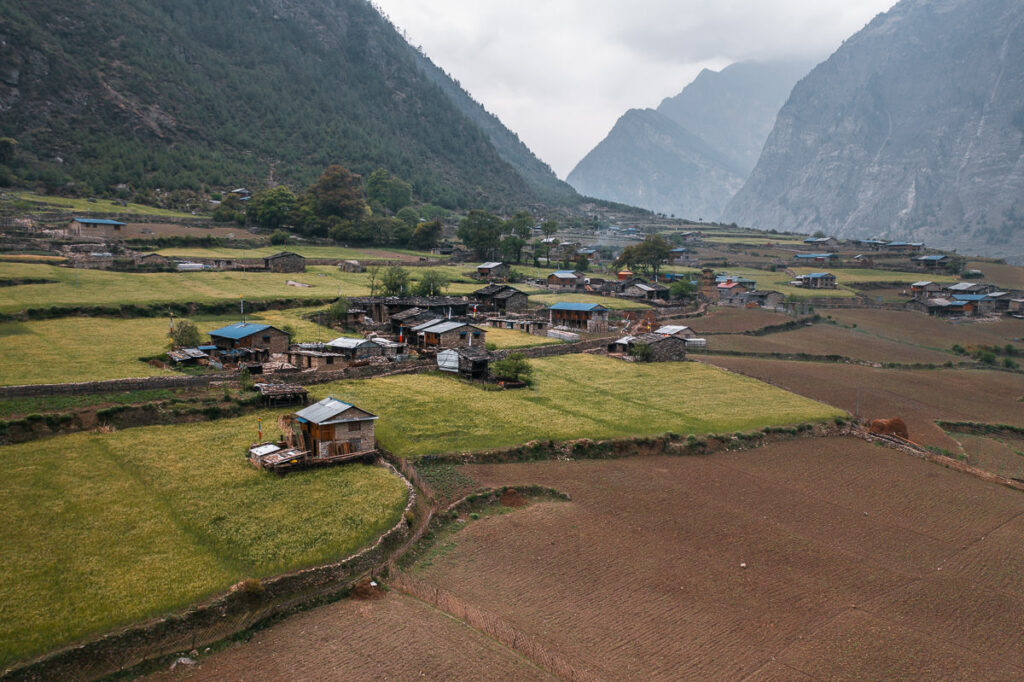
View this post on Instagram A post shared by Jackson Groves (@jackson.groves)
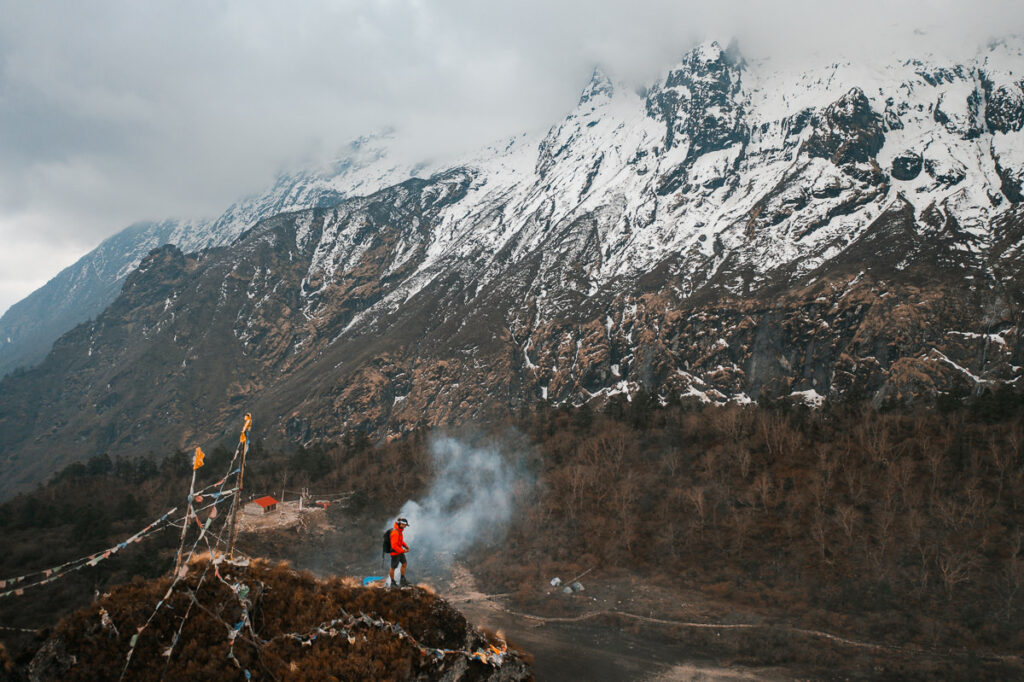
Finally, an easy day arrived and we all needed it badly. After 6000m of incline and 80km on the first four days of the trek in some pretty heavy sun, we were spent. Today seemed like a stroll in the park as we meandered our way to Namrung, taking just a few hours.
The path today is in the phase of switching out of the sub-tropical forest into the alpine forest so it had a mix of everything. At the entrance to each town, we can now find lots of ancient scripts displayed at the entry path.
Day 5 Highlights:
- A shorter day from Prok to Namrung was just what the doctor ordered so when we rolled into Namrung in the early afternoon, we all breathed a sigh of relief to have time to rest our bodies.
- A steaming hot shower for $2.50 on the fifth day of a trek is always money well spent. Clean, refreshed, and ready to push on.
- We bought a pack of cards for $1 at Namrung and had a few different games rolling throughout the night. It’s fun to enjoy the good vibes amongst this really chill group from Nepal.
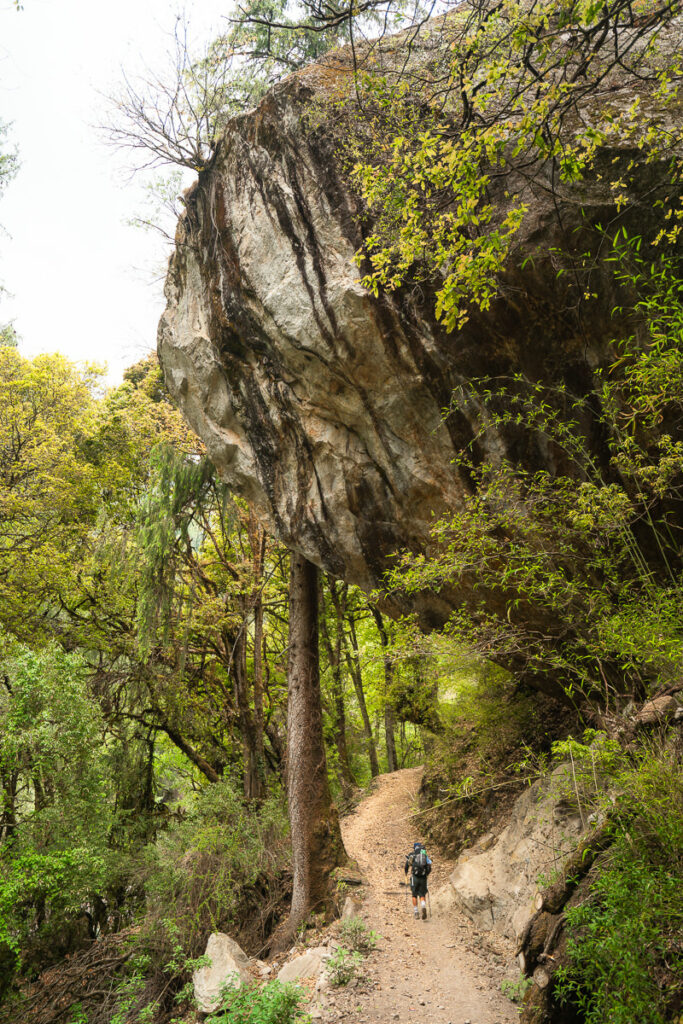
The trek to Lho leads us through wild sections of oak, fir, and rhododendron forests throughout the climb higher up into the valley. The air is beginning to thin for the first time so the pace is slightly slower today but with just 11km to cover, it was a touristic day with some nice cultural sites and stupas throughout the route.
Day 6 Highlights
- Larkye our Manaslu dog has officially joined us. Despite being asleep as we headed off from Namrung, he quickly caught up to us and has hardly left my side since.
- Lunchtime was at a small village with an epic view across the fields and up towards towering hills. Spicy noodles out in the sunshine had us feeling incredibly relaxed and on the recovery after the first four savage days of the trek.
- Sunset from Lho was very grey and cloudy but in the midst of blue hour, Manaslu appeared. It was the first time we’d all laid eyes on the 8000er and it was a pretty majestic moment.
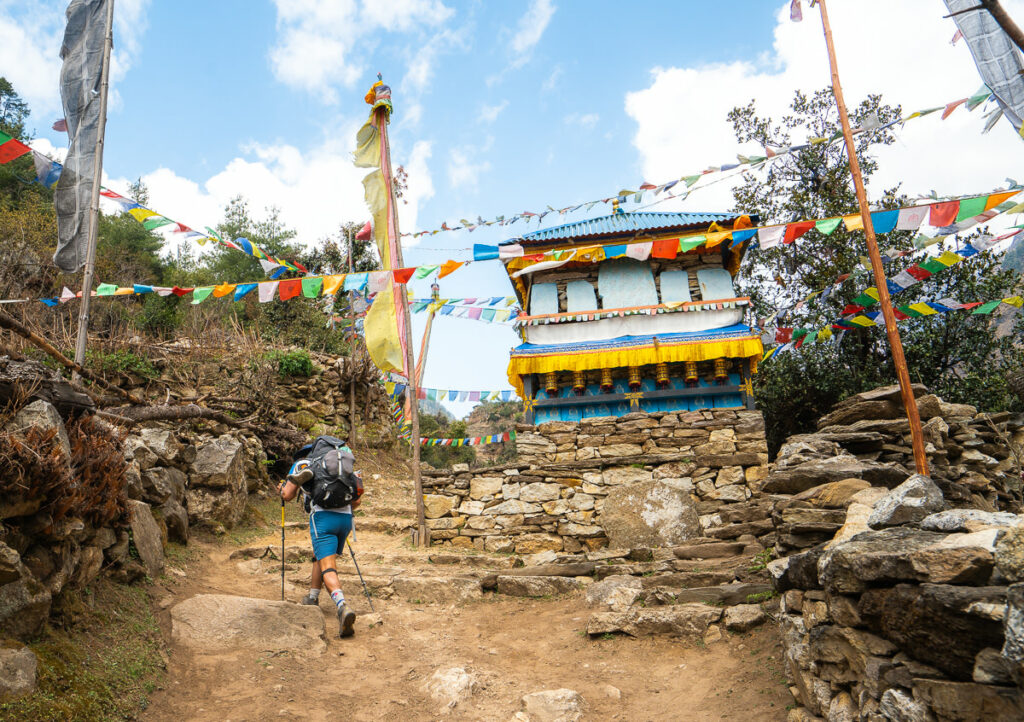
Today the climb continues up the valley and enters the high alpine pastures. Expect to see lots of Yaks grazing across the expansive hills and steep mountainside. One of the best suspension bridges of the trip with a huge mountain backdrop was the highlight of the day.
At our tea break, we had views of snow peaks in all directions and that’s where I shot most of the photos you can see below. From our lodge, we will have an incredible view directly up at Mount Manaslu that towers over the valley and we would stay here for two nights.
Day 7 Highlights
- A blue hour from the rooftop and an incredible sunrise with views of Manaslu was such a memorable start to the day. I felt like I was in Switzerland. We all had breakfast together on the rooftop and it might just be the most scenic fruit muesli I’ve ever had.
- A tea break on our way to Samaguan gave us the best views yet as the clouds were yet to engulf the surrounding peaks. I ripped out the 100-400mm and got some incredible shots of the snowy ridges as the clouds swept through.
- Our first WiFi of the trip at Samaguan was a great chance to catch up on the real world. We quickly realized nothing much had changed and were grateful to be out in the wilderness of the Himalayas.
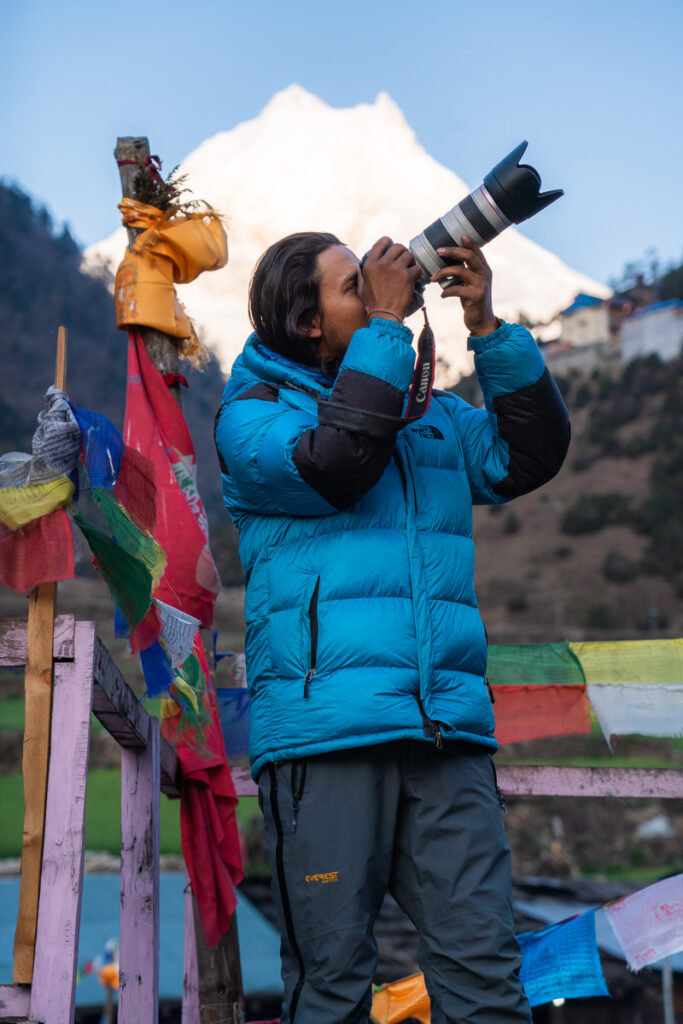
This was by far one of my favorite days of the trip aside from the Larke Pass day. Pungen Gumba is a monastery site at 4200 meters. It sits directly beneath Mount Manaslu at the top of a huge plateau in an ampitheater of mountains. I set off on my own at 4 am to make the 8-kilometer trek in the dark hoping to see some alpenglow or sunrise colors with a clear Mount Manaslu.
The weather gods shined on me and the effort up the rocky hill to the monastery provided me with the best views of the entire trip.
Day 8 Highlights
- After a rainy night before we committed to a sunrise mission. I left solo at 4 am to Puneng Gumba, a monastery built into the cliffs at 4,100. The others joined me a little later and our efforts were rewarded with clear views of Manaslu and one of the most stunning locations I’ve ever explored. One of the best mornings of my life, just me and the dog up at 4,100 meters taking it all in.
- Sitting in the sun at the monastery, the other three finally arrived and brought some tea. Sipping on my cup I was just incredibly grateful to be out here. The views were just jaw-dropping.
- Yaks, foxes, and marmots up in the snow at Pungen Gumba were quite a cool wildlife sighting and the latter two came unexpectedly.
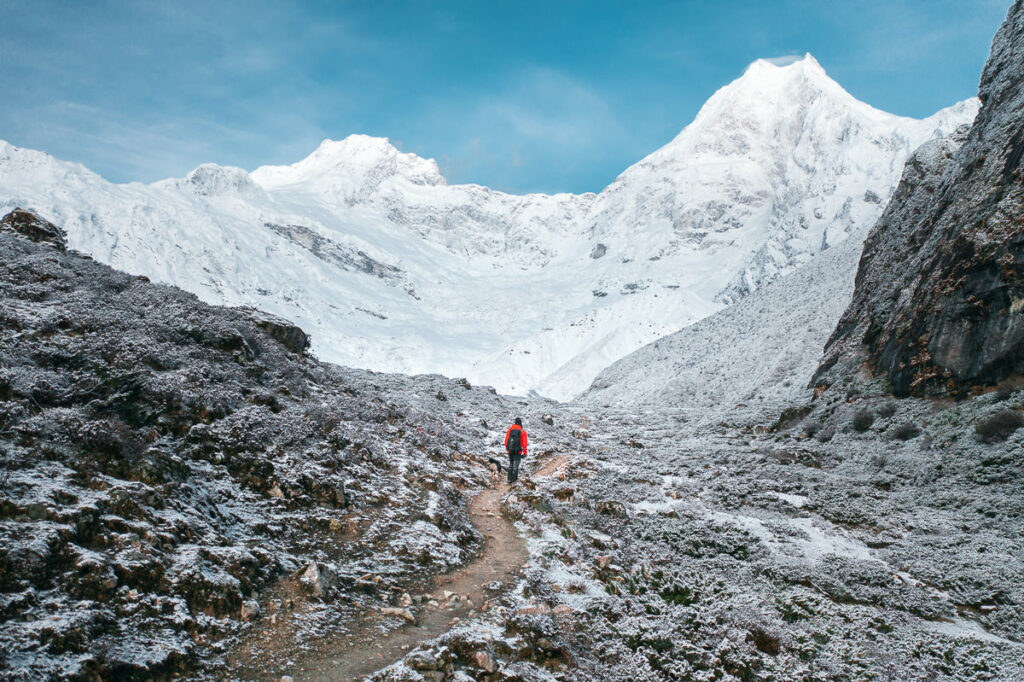
On day nine we began with a short visit to Birendra Lake before breakfast and then the trek heads up through the valley to the Tibetan village of Samdo. This is actually the highest Tibetan refugee camp in Nepal and is pretty remarkably perched on the cliffside.
Sunset at Samdo is truly a spectacle with peaks in all directions. Along the way, we will pass through Birch forests and we will see a few Marmots running to hide from us in their little holes. We will have the afternoon to relax and enjoy the views from our cute little village
Day 9 Highlights
- Our first rain was endured on the short trek to Samdo, a town at almost 4000m of elevation. Along the way, we passed hundreds of huge yaks who were more interested in grazing than us trekking through.
- Samdo was freezing but a warm fire at night in the tea house kept our spirits high. Cards, coffee, and incredible sunset sends us into day ten full of energy.
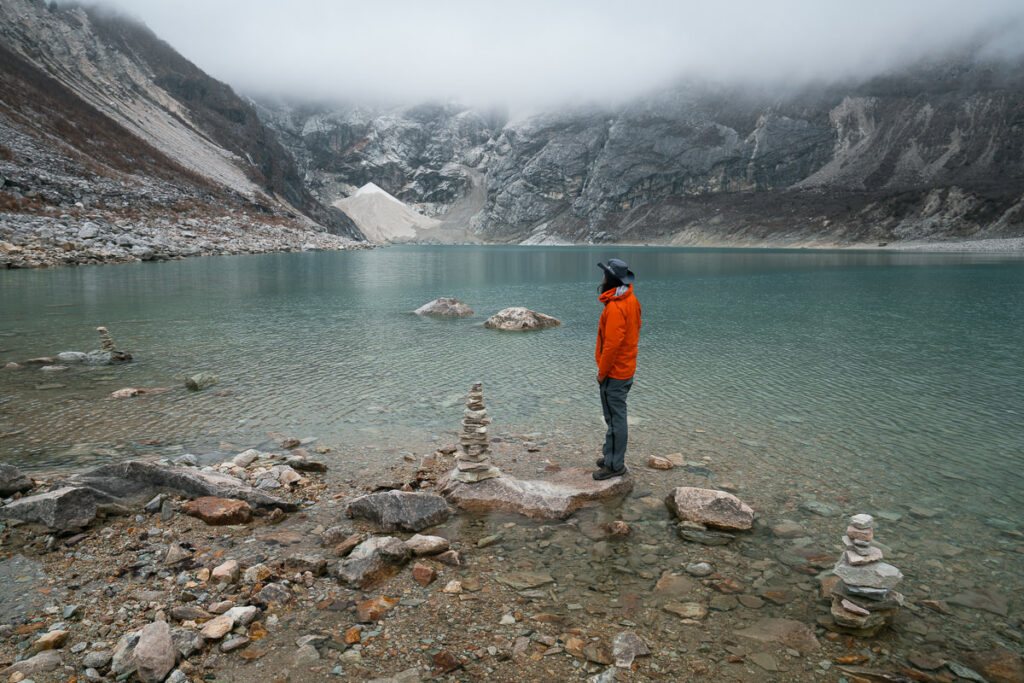
There’s just one day left until we cross Larke La tomorrow so today we ascend to the small base camp of Dharma Shala for the night. It’s bloody freezing here at almost 4500m and there’s no heater. It’s literally just a bunch of rooms perched up on the hill with one small kitchen. It’s a short walk to reach Dharama Shala taking just a few hours but you are at altitude, so you may begin to have a small headache if you are unlucky.
Day 10 Highlights
- I woke up and opened my door to the sight of fresh snow falling in Samdo. In the morning, the Tibetan refugee village was incredibly isolated and covered in a thick blanket of snow, which only exacerbated that feeling of being hidden in the mountains.
- At 4,460m, Dharma Shala is a freezing place to stay the night. With no fire or heater, we slept in all of our winter trekking gear. The hot bottle of water was the only thing adding any warmth to our bodies as we enjoyed our last sleep before attempting the Larke Pass.
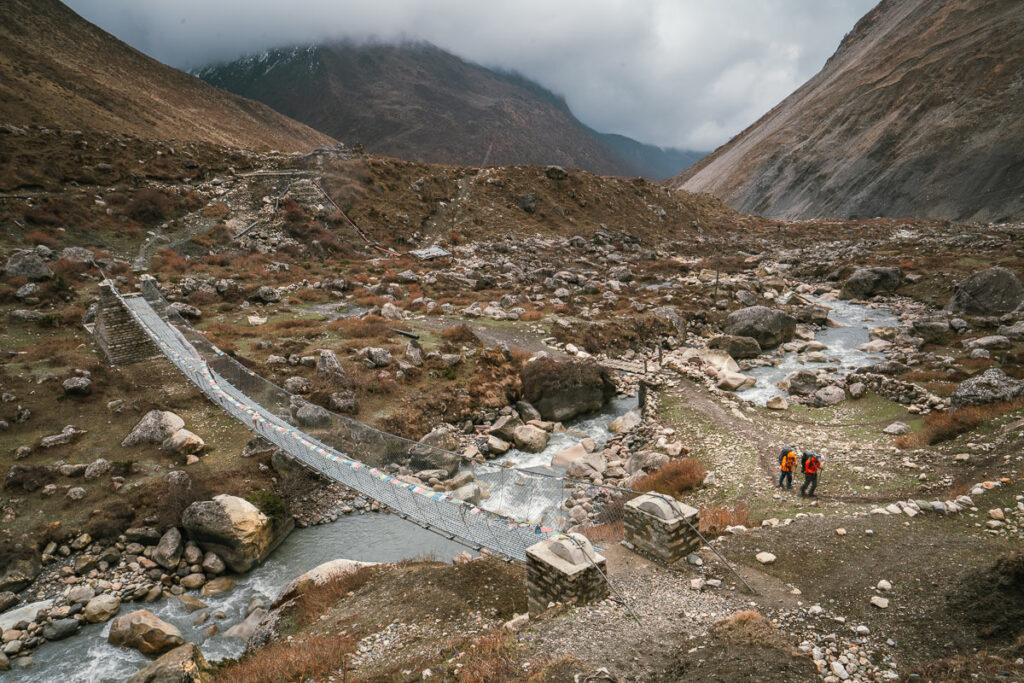
Day 11, Darmashala (4466m) to Bhimtang (3709m) via Larke Pass 5134m, Distance: 18km, Incline 800m
Today is the big day. We woke at 3:30 am and set off just after 4:30 am in time to catch the first moments of the blue hour and sunrise. It takes about three to four hours to reach Larke La at 5106 meters. Along the way, you have an amazing corridor with huge peaks on either side. This was one of my favorite sections of trail throughout the entire route.
At Larke Pass, it is time to have the prayer flags and take in the view and the achievement! The descent is quite steep and I even put on the micro-spikes for a portion of the downhill. The first village we reach is Bhimtang where we will stay for the night and enjoy a good rest.
Day 11 Highlights
- After a rainy and cloudy night, we were a little worried about our journey to Larke Pass would lack the incredible views it had promised. Upon waking up at 3:30 am, we could faintly make out the lines of the mountain ridges. We knew we had lucked out and were in for a day of clear weather.
- I walked the Larke Pass alone for the most part. I turned on some music as my head tilted from side to side trying to etch these incredible peaks and mountain views into my mind. I never wanted to leave nor forget this incredible corridor in the Himalayas of Nepal.
- Reaching Larke Pass at 5,106m was a milestone and something we had spent 11 days working towards. With just a slight headache, I was glad to reach the collection of prayer flags at the top and take it all in.
- The snowy descent down to Bhimthang was the type of adventure I crave. With microspikes on and a few slips, we enjoyed the high-tempo descent into town. We were thankful for a hot coffee and noodles as we huddled around the kitchen fire in Bhimthang. We had made it, safe and sound.

The final day of trekking is long and downhill. Your legs are tired from the day before but thankfully the incline is very rare and you basically just walk your way out of the alpine zone, into the forest, and then emerge to Dharapani beside the river. It was a long day with more than 25 kilometers to tick off but the walking was easy and going down in altitude is always a refreshing change. It was a good journey through the beautiful forests to reflect on the trek.
Day 12 Highlights
- Spicy noodle soup at mid-morning in a small hut with a lovely local serving us.
- A well-deserved beer (or two) at the Heaven Hotel in Dharapani to cap off an incredible journey.
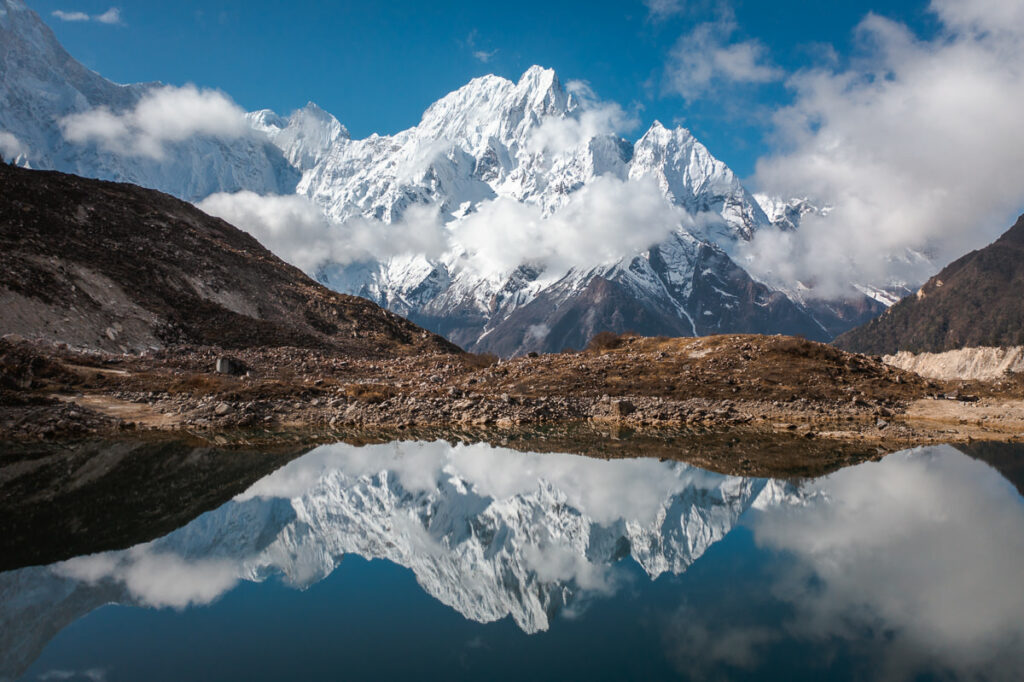
I hope you enjoyed this massive wrap-up of the Manaslu Circuit Trek. I loved photographing and filming the expedition and I truly loved the trail. I think it offers much more adventure than the other popular circuits in Nepal although let’s face it, any trek amidst the Himalayas is probably going to be epic. Do leave me a comment below if you have any questions or want to share any thoughts about your trek on the Manaslu Circuit. Happy hiking!
HAVE YOU READ MY OTHER NEPAL BLOGS?
I’ve been lucky enough to have many awesome adventures in Nepal, which you can check out below where I’ve listed some of my favorite blog poss from Nepal.
- The Most Iconic route: Everest Base Camp Trek
- The Most Scenic Route: Annapurna Circuit Trek
- My Favorite Trek in Nepal: Manaslu Circuit Trek
- An Easy Nepal Trek: Langtang Valley Trek
- A great beginner peak: Island Peak Climb (6,165m)
- My Favorite Climb in Nepal: Climbing Ama Dablam (6,812m)
- My first 8000er: Climbing Manaslu (8,163m)
- My toughest climb in Nepal: Climbing Makalu (8,463m)
- Where to stay: 16 Best Places to Stay in Kathmandu

Thursday 15th of August 2024
Epic views man! I hiked Everest basecamp last year and planning to trek Manaslu this Nov.
Thanks for the posts, I even followed some for hikes in Panama 😅
Tuesday 11th of April 2023
Beautiful photographs! I am also wondering what time of year you went?
Sunday 29th of August 2021
Bonjour, merci pour ce généreux partage et vos très belles images. A quel période de l'année avez vous fait ce trek ? Je vous souhaite une belle poursuite à vos projets.
Saturday 15th of May 2021
Well done, Jackson! Those sunrises and sunsets in the mountains look incredible. Can't believe you got to visit Tibetan villages before me too! Next time eat the tsampa with your hands haha
Ken McKinney
What a great writeup! I have a couple of questions: 1) what time of year did you do this trek? 2) I've previously hiked Annapurna and EBC, but I am older now and less fit. Would it be possible to make the Manaslu Circuit less difficult by doing shorter daily stages, or does lack of teahouses make this impossible?
Wednesday 22nd of June 2022
@Ken McKinney, He did it in March 2020. See his remarks about lockdown. And yes, it is possible to make it more manageable, the number of lodges is about the same as the number of lodges on the Annapurna Circuit in the 1990's.

The Manaslu Circuit Trek: Complete Guide
Posted on Last updated: September 22, 2023
For those who prefer ‘the road less traveled’ (which translates into fewer trekkers on the trail) and who enjoy pushing themselves physically and mentally, the Manaslu Circuit Trek in Nepal might just be the trek you are looking for!
Of course, it is not just about driving and motivating yourself; it’s also about the spectacular scenery, the thought-provoking cultures and lifestyles of interesting locals you will meet, and the camaraderie with your guide.
This complete Guide will give you all you need to know about the Manaslu Circuit Trek to enable you to make an educated decision as to whether this is the right trek for your adventure in Nepal.

The Manaslu Circuit Trek: The Basics on What to Know Before You Go
- Location: central-western region of Nepal in the lap of Mount Manaslu, situated within the Manaslu Conservation Area Project (MCAP)
- Starting point: departing Kathmandu for a 7 hr bus journey, the trek starts from Soti Khola and ends at Dharapani for the return bus journey
- Duration: 13 Days
- Trip grade: challenging
- Max altitude: 5,167 m / 16752 ft (at Larkya La Pass)
- Accommodation: basic trekking lodges known as teahouses
- Food: basic curry, noodles, soups, and porridge in the majority of teahouses, but tasty and plentiful
- Distance: 180 km
- Total incline : 11,000 m
- Total decline: 9,800 m
- Permits: Manaslu Conservation Area Permit, Annapurna Conservation Area Permit (as you are also entering this region) and a Restricted Area Permit
- Guide and Porters: you must trek with a guide in this region. Porters can also be hired through your trekking company, Magical Nepal, and it is possible to share a porter with a fellow trekker. Note that one porter can carry no more than 20kg in total.
Important Points to Consider on the Manaslu Circuit Trek
Here are some important points to know before you go. Nepal is one of the top adventure destinations in the world , and this trek is sure to show some of its best facets.
Manaslu Circuit Trek Difficulty
Let’s discuss the difficulty of this trek in more detail. If you are a regular hiker and particularly if you have trekked in the Himalayas before, you will have a good idea of your capabilities. This trek starts at an altitude of 800m / 2,624 ft and gradually, by daily increments of around 400m/ 1,312 ft, brings you to the height of 3,000m / 9,842ft on Day 6.
Daily, expect to walk around 6 hours, with a few days of longer walking. Crossing the Larkya La Pass at 5,160m / 16,929 is not only stunningly beautiful but the hardest day with 10 tough hours of walking.
Although it is around 3,000m when us humans may begin to feel some adverse effects such as a headache, with the built-in acclimatization days, altitude should not be a problem for the majority of healthy trekkers. We must add, however, that altitude-related problems are real, and every care is taken to ensure our guests’ safety, and we train our guides to recognize symptoms before they become serious.
The Manaslu Circuit is Remote
One of the main attractions of the Manaslu Circuit trek is that it goes through remote countryside and gets fewer trekkers than many of the other treks in Nepal. Although remote, it is only one day’s road journey from Kathmandu – no need for weather-dependent flights.
Another result of its remoteness and reduced numbers of trekkers is the fact accommodation is more basic than in more commercial areas. There will be a bed, a blanket, a shower, a reasonable food menu, and the necessary to recharge your electronic goods. Nothing fancy, but more than adequate!
Manaslu Circuit Weather
The Manaslu Circuit Trek starts at a low altitude with subtropical forests and weather. The days get cooler the higher you go until you reach, very possibly, snow underfoot at the Larkya La Pass. Like the majority of treks in Nepal, the best months to come are March, April, May, October, and November.
Clothing for the Manaslu Circuit Trek
See the packing list below for more details, but basically, layers to fit the warm lowland weather and the cold mountain climate, good (pre-worn) trekking boots, and we can also recommend a sleeping bag for extra warmth and hygiene! Available to buy or hire in Kathmandu.
Manaslu Circuit Scenery/ Wildlife and Culture
If it’s a cardio workout you want, we can suggest your local gym! But seriously, the main attraction on a trek in Nepal is the mountains! Manaslu is the eighth-highest mountain in the world, standing at 8,156 m (26,759 ft), and is surrounded by other huge Himalayan peaks, including Himlung and Annapurna II.
From the Larkya La Pass, there are jaw-dropping views of glaciers, a glacier cirque (possibly formed by ancient avalanches) and Himlung Himal, Gyaji Kang, and other great mountains.
At the start of the trek, you will travel through lowlands of rice and millet terraces and the Budi Gandaki gorge with waterfalls and plenty of suspension bridges to add to the fun.
Aside from the landscape, this conservation area is home to the Snow Leopard, Himalayan Marmot, Pika, Tahr, and many other species. It is also home to different Tibetan and Nepalese ethnic groups, making it a real cultural experience as well, particularly if you are interested to learn more about Tibetan Buddhism.
Wi-Fi and electricity on the Manaslu Circuit
Wi-Fi is not guaranteed. There’s no point arguing at the teahouse about it. Carry a local SIM card, which will be able to access the internet at lower altitudes. Electricity may be provided by solar, and you will be charged anywhere up to $5 USD per item to recharge your phone, camera etc. Carrying a good power bank is highly recommended.

Manaslu Circuit Highlights in a Nut Shell
- The overall beauty of the flora in both lowlands and high mountains
- Potential sighting of unique wildlife in two conservation areas
- Getting up at 3am to cross the challenging Larkey La Pass
- Being surrounded by some of the highest peaks in the world
- The mighty thundering Budi Gandaki River, waterfalls and hanging suspension bridges
- Seeing Tibet in the distance
- Feeling like the first trekkers to visit this remote area
- An astounding glacial cirque
- Meeting different groups of locals and learning of their culture
- Visiting Pungyen Gompa (monastery)
Packing List for Manaslu Circuit
Here is an exact packing list for this trek! See my hiking essentials post for links.
- 2 x Trekking pants, preferably those that zip down to shorts
- 1 x Warmer hiking pants for colder areas
- 1-2 x Long sleeved quick drying trekking shirts
- 1-2 x Long sleeved thermal shirt/ vest
- 2 x t-shirts
- 1 x Thermal long underwear
- Underwear for the duration (perhaps you will wash some out a couple of times, but consider the drying process)
- 2-3 x socks, including heavy duty wool ones
- 1 x Lightweight jacket for low altitude and warm days
- 1x Heavy down jacket
- 1 x Warm hat
- 1 x Cap for the sun
- Trekking poles (handy even if you are spectacularly fit!)
- Sunglasses
- Scarf/ buff and gloves
- Hiking boots (pre-worn)
- Microspikes (available in Kathmandu)
- Headtorch
- Sunscreen
- Water filter or sterilising drops/ tablets
- Powerbank
- Camera/ phone/ etc
Manaslu Circuit Trek Outline Itinerary, Altitudes and Times at a Glance
Day 1: Kathmandu to Maccha Khola (Drive)
Maccha Khola – 930 m / 3,051 ft – 7 hrs
Day 2: Maccha Khola to Jagat
Jagat – 1,340 m / 4,396 ft – 6 hrs
Day 3: Jagat to Pewa
Deng – 1,804 m / 5,918 ft – 6 hrs
Day 4: Pewa to Namrung
Namrung – 2,630 m / 8,628 ft – 6 hrs
Day 5: Namrung to Lho
Lho – 2,957 m / 9,701 ft – 4 hrs
Day 6: Lho to Sama Gaun
Sama Gaun – 3,530 m / 11,581 ft – 4 hrs
Day 7: Acclimatization Day (Day Trip to Manaslu Base Camp or Pungyen Gompa) Sama Gaun – 4,400m / 14,435 ft – 7 hrs
Day 8: Sama Gaun to Samdo
Samdo – 3,865 m / 12,680 ft – 3 hrs
Day 9: Acclimatization Day (Day Trip to Tibet Border)
Samdo – 5,000 m / 16,404 ft – 8 hrs
Day 10: Samdo to Dharmasala
Dharmasala – 4,460 m / 14,632 ft – 4 hrs
Day 11: Dharmasala to Bimthang via Larkya Pass
Bimthang – 3,590 m / 11,778 ft – 10 hrs
Day 12: Bimthang to Dharapani
Dharapani – 1,970 m / 6.463 ft – 7 hrs
Day 13: Dharapani to Kathmandu (Drive)
Kathmandu – 1,300 m / 4,265 ft – 8 hrs
Breakdown of the Day to Day Highlights on the Manaslu Circuit Trek
Day 1: kathmandu to maccha khola (7 hours drive).
The day starts off from Kathmandu, where we get a local bus along the Prithvi Highway until we reach the village Machha Khola, where we stay overnight. The alternative would be to hire a private jeep, which would be more comfortable.
Highlight of the day: the only real highlight is that you are off on your adventure! The scenery is pretty cool, too, although the road is dusty and bumpy in places.
Day 2: Maccha Khola to Jagat (5 to 6 hours hike)
Now, the trek begins! Follow the banks of the Budi Gandaki River along a dusty, twisting trail. You will get your first experience of suspension bridges as you cross and recross the river. The villages you see on the way are Gurung villages, with some steep stone stairs on the way.
With aching muscles, now you are really trekking! It is most likely a hot and sweating hike today. If you wish, you can rest and soak your legs in a hot water spring at Tatopani (literally translated to hot water).
Highlights of the day:
● Experiencing those suspension bridges!
● The mountains overhead.
Day 3: Jagat to Pewa (5 to 6 hours walk)

Still in the sub-tropical forests, where it is surprisingly warm, it is a definite benefit if your limbs are sore from yesterday! Buddhist prayer flags decorate the trails, and there are some interesting gompas (monasteries) on the way.
At a large Gurung village called Phillim, you will get your permits checked (just to make sure you have paid for the right to be here)! Rhododendron forests are colorful to hike in the spring. Crossing the Siyar Khola bridge, you come to the junction which leads to the interesting Tsum Valley (an adventure for another occasion, perhaps).
Pewa is a very small settlement with basic food, the best option being the delicious Nepali cuisine of dal bhat and pickles.
● The highlight is always the mountains reaching high into the heavens.
● Rickety old suspension bridges that test our nerves.
● Prayer flags fluttering in the wind.
Day 4: Pewa to Namrung (5 to 6 hours walk)

The trail takes you through a bamboo forest, across another suspension bridge, and a climb up to more villages. Look out for monkeys on the way! Now, you enter a landslide zone where you have to pay attention to the guide who will get you safely across.
Then, it’s an uneven zigzag trail up to Namrung. The trail proceeds to Ghap through several more landslide zones. At this point, you must be extra careful as you walk. Plus, you must be attentive to your guide’s instructions to maintain physical safety. After the landslide zone, you follow the trail up to Namrung. By now, the views are of major peaks, which your guide will point out to you.
● Looking out for monkeys on the way, but please don’t feed them.
● A kind of highlight is making it safely across the loose stones of landslide-prone areas.
● Having a good coffee at a modern restaurant in Namrung, should it be hopefully open. ● The Wi-Fi can be pretty good at Numrung. Again, hopefully!
Day 5: Namrung to Lho (3 to 4 hours walk)
More gorgeous rhododendron forests, together with forests of oak. Perhaps more interesting are the arched gates, prayer (mani) walls, and local Nurbri people dressed in Tibetan-like attire. If you look up, there are wonderful views of Manaslu and Manaslu North.
Now, at high altitude, you might begin to feel some slight ill effects such as a headache. Take note of this and advise the guide should it get worse. By walking steadily and slowly, and ensuring everyone is drinking plenty of fluids, the guide is well aware of the rise in altitude.
● First views of Manaslu up close.
● Feeling of peace amongst Buddhist peoples.
Day 6: Lho to Sama Gaun (3 to 4 hours walk)

Waking up to views of Manaslu and knowing it is a short day’s walk to Sama Gaun with its yak pastures, large gompa and shops brings a smile to your face.
● Walking through high alpine pastures with lots of grazing yaks there and on the nearby mountainsides.
● Shopping! Perhaps for some snacks, if anything that is available catches your eye. ● Best views so far of Mt Manaslu – and from your teahouse!
● Wi-Fi, hopefully!
Day 7: Acclimatization Day (Day Trip to Manaslu Base Camp or Pungyen Gompa, 7 hours walk)

Now, at an altitude of 3,530 m / 11,581 ft at Sama Gaun, it’s time to let your body adjust before going higher. The best way to acclimatize is to keep active! So, no, put that book away and put the hiking boots back on!
There are a couple of options. The first is hiking to Manaslu Base Camp, passing Birendra Tal (lake). The second option is to hike to Pungyen Gompa. The Gompa sits on the top of a plateau facing the mountains and is best visited for sunrise.
If you are feeling particularly tired and really do need to rest more than hike some more, you can make a shorter trip to just Birendra Tal, which provides something different to enjoy and experience.
● If you head to Puneng Gumpa, eating your packed lunch while gazing at the mountains has to be a highlight!
● There is also a possibility of seeing foxes in this area.
● By hiking to Manaslu Base Camp, there is a wonderful feeling of achievement as well as stunning mountain views.
Day 8: Sama Gaun to Samdo (2 to 3 hours walk)
Although a short day in terms of hours, the going is tough because of the altitude. Leaving the tree line, you climb a ridge and cross a wooden bridge over the Buri Gandaki River to reach the picturesque yak herding village of White Kani. Then on to Samdo. Since it has been a short day, you can walk on and visit Samdo Peak if you desire.
● Passing the mani walls with their Tibetan Buddhist mantras carved into them.
● Bird watching, as there are plenty of different varieties in the area.
Day 9: Acclimatization Day (Day Trip to Tibet Border, 8 hours walk)
After what was probably a cold night at Samo (this is where your own sleeping bag would be extremely helpful), you will be more than happy to strap on your boots and head out. Standing at the Tibet / Nepal border, there are views of Samdo Glacier and perhaps even some yak caravans.
Unfortunately, there are no signs saying ‘Welcome to Tibet’ to photograph, but you will be able to say you have seen Tibet! Do not be tempted to climb over the rickety fence into China!
● Seeing Tibet!
● Gazing at the Samdo Glacier.
Day 10: Samdo to Dharmasala (8 hour walk)
Trekking through rugged terrain with the mountains overhead has now become second nature! It is likely the mountains are covered in fresh snowfall, making it all the more magical. Dharmasala is another cold settlement to spend the night.
● Knowing that the interesting and challenging Larke La Pass is coming up!
● Being grateful for that extra thick jacket you packed before leaving home!
Day 11: Dharmasala to Bimthang via Larkya Pass: (10 hour walk: This is the highlight of the Manaslu Circuit Trek! And it will be a real challenge!)

Larkya La Pass is 5,160m / 16,929 ft and most likely covered in snow. It also involves getting up around 3am to make it over the pass before the high winds come up in the afternoon. Micro-spikes are mostly used for this crossing, which is another new experience for many people.
As for the views, you will see Himlung (7,126m/ 23,379 ft) near Tibet Kang Guru (6,981m /22,903 ft), and Annapurna II (7,937m / 26,040 ft) – all of which will take your breath away. On the descent, there are views of mountains and ice falls surrounding you, along with several glaciers.
● It’s probably not a highlight to get out of bed at 3am, but once you are up, the excitement builds!
● Prayer flags greet you as you reach the top of the pass, making you feel like you are a Himalayan mountaineer.
● Using micro-spikes on the descent brings more adventure to the day.
● Finally reaching the teahouse at Bimthang for some hot tea and great conversation.
Day 12: Bimthang to Dharapani (7 hours walk)
The final day of the trek, so enjoy the forests and the rhododendron bushes. As you descend, the landscape turns from glacial flood areas and forests to agricultural lands. It is a long downhill hike of around 25km, but you can breathe more easily at the lower altitude. Reach Dharapani for your final night in the Manaslu area.
● Bittersweet feeling of having completed the trek successfully.
● Perhaps a beer to celebrate at the final teahouse.
● Exchanging contact details with fellow trekkers.
Day 13: Dharapani to Kathmandu (8 hours drive)
A jeep at Tilije will take you to Beshi Sahar, where you catch the bus back to Kathmandu. Or arrange for a private jeep to meet you. You probably deserve that!
Highlight of the day:
● Another bittersweet day but with the promise of a really hot shower in clean surroundings back in your hotel in Kathmandu.
● Menu choices you now find so exhaustive it’s hard to choose!
Further Information on the Manaslu Circuit Trek
For further information of the Manaslu Circuit Trek, and other treks in the area, such as the Tsum Valley Trek and Manaslu and Tsum Vally Trek, or if you have any questions, contact Magical Nepal , who have amazingly experienced guides and friendly service. We hope to see you in the mountains soon!
Privacy Overview

MANASLU CIRCUIT TREKKING GUIDE

Pin 523 Tweet Share WhatsApp 523 Shares
MANASLU CIRCUIT TREK
The Essential Guide
So you’re thinking about tackling the Manaslu Circuit Trek? Great choice! Of the various treks we’ve done around Nepal, including Annapurna Circuit, Everest Three Passes, Langtang Valley and Upper Mustang, we think this is one of the best. The scenery is diverse and impressive, and in an age where development is proceeding at breakneck speed, the Manaslu Trek has the advantage of being quieter and much less impacted by road building. Additionally, Tibetan cultural influences at higher altitude lend a unique flavour to the experience that is notably different from other areas.
In this guide we’ll cover a whole range of essential topics including when to go, what to take, how to organise your trek, budgeting for your trek, accommodation, food, and much more. Want to know more about the Manaslu Circuit itinerary itself? Check out our day by day account of the trek . Want to see what the trek is really like? Watch our complete Instagram Stories from the journey ( part one / part two ), and check out our video below.

WATCH THE VIDEO
Read through our complete Manaslu Circuit trekking guide or jump to a particular section by clicking on the links below.
Read through our complete Manaslu Circuit trekking guide or jump ahead to a particular section by clicking on the links below.
MANASLU CIRCUIT ITINERARY | MANASLU CIRCUIT TREK MAP | WHEN TO GO | HOW LONG IT TAKES | MANASLU CIRCUIT TREK DIFFICULTY | HOW TO ORGANISE THE TREK | THE D.I.Y. APPROACH | HOW TO CHOOSE A GUIDE | BOOKING AN INCLUSIVE TOUR | MANASLU CIRCUIT PERMITS | MANASLU CIRCUIT TREK COST | TIPPING GUIDES AND PORTERS | MONEY ON MANASLU CIRCUIT | ACCOMMODATION | FOOD AND DRINK | DRINKING WATER | INTERNET AND CHARGING | WHAT TO TAKE | ALTITUDE AWARENESS | TRAVEL INSURANCE | TSUM VALLEY SIDE TRIP | MANASLU CIRCUIT TREK HIGHLIGHTS | THINGS WE WOULD DO DIFFERENTLY | GETTING TO/FROM THE TRAIL | GETTING TO NEPAL | TOURIST VISAS | EXTRA RESOURCES
MANASLU CIRCUIT ITINERARY MANASLU CIRCUIT TREK MAP WHEN TO TREK MANASLU HOW LONG THE TREK TAKES MANASLU TREK DIFFICULTY HOW TO ORGANISE THE TREK THE D.I.Y. APPROACH HOW TO CHOOSE A GUIDE BOOKING AN INCLUSIVE TOUR MANASLU CIRCUIT PERMITS MANASLU CIRCUIT COST TIPPING GUIDES AND PORTERS MONEY ON MANASLU CIRCUIT ACCOMMODATION FOOD AND DRINK DRINKING WATER INTERNET AND CHARGING WHAT TO TAKE ALTITUDE AWARENESS TRAVEL INSURANCE TSUM VALLEY SIDE TRIP MANASLU TREK HIGHLIGHTS WHAT WE’D DO DIFFERENTLY GETTING TO/FROM THE TRAIL GETTING TO NEPAL TOURIST VISAS EXTRA RESOURCES
*Some of the links in this post are affiliate links – if you purchase a product or service via these links, we may earn a small commission at no extra cost to you . This helps offset the cost of running this blog and keeps us travelling so that we can continue to produce great content for you. We greatly appreciate your support!*
MANASLU CIRCUIT TREK ITINERARY
Below is an overview of the Manaslu Circuit trek itinerary. This is not set in stone, just a suggested route. Some people stay in alternative villages along the way, or add an extra acclimatisation day at Samdo. Trekking distances and times are approximate.
*If you are concerned about altitude sickness, adding an extra day at Samdo is a good idea. From here you can do an acclimatisation hike to the Tibetan border at Rui La (4998m, 19km/10 hours) or easier hikes up the hills around the village.
**It is now possible to take a shared jeep from Tilche so you have the option of finishing the trek there instead of Dharapani
MANASLU CIRCUIT TREK MAP
We’ve marked the Manaslu Circuit trekking route on the map below, along with key villages and sights along the way. Tap the menu button at the top left for more details, to toggle layers on and off, and switch between satellite and terrain view.
To use an offline version of this map, download our KML file for use with Maps.me ( iOS / Android ) or Organic Maps ( iOS / Android ) , or the GPX file for use with alternative offline mapping apps such as Gaia ( iOS / Android ). See our expandable box below for tips on using these apps.
Download GPX | Download KML
HOW TO SAVE THIS MAP (ONLINE VERSION)
To save this map to use online on desktop or mobile just tap the star symbol at the top. When you open Google Maps on your phone, navigate to ‘Saved’ at the bottom, then swipe along to ‘Maps’ at the top. You’ll find this map in your list of maps.
On desktop, click ‘Saved’ on the left side, then ‘Maps’. Click the map, then select ‘Open in My Maps’ to access the interactive version .
Alternatively, just tap the rectangle symbol at the top right of the map in this blog post to view the My Maps version larger on desktop.
Unfortunately, it’s not possible to view this version of the map offline, but we’ve created a similar version for offline use as per below.
HOW TO SAVE THIS MAP (OFFLINE VERSION)
ORGANIC MAPS
Organic Maps is our go-to offline mapping app. We find it straightforward to use for planning routes in advance, as well as navigating on the trail. It doesn’t drain our phone battery, and it’s quick and easy to save and organise ‘bookmarks’. There are many trails already marked on Organic Maps, plus you can download and import a KML track of your route to the app.
To use Organic Maps, first download the app ( iOS / Android ). Hover over the region or country that you want to visit and the app will prompt you to download this map. Once downloaded, it can be viewed offline.
You can tap anywhere and save it as a ‘bookmark’ by tapping the star symbol at the bottom. Hit ‘Edit Bookmark’ to personalise the bookmark colour, organise your bookmarks into different folders, and rename them.
You can navigate easily or plan routes in advance by tapping your start point and selecting ‘route from’, then tapping your end point and selecting ‘route to’. Tap the car, walking, or cycling symbol at the top of the screen to indicate your mode of travel. If you want to plot a different route to the one suggested by Organic Maps, just tap a third (or fourth, fifth, etc.) bookmark between the start and end points and select ‘add stop’.
Organic Maps shows the distance and travel time, plus elevation profiles for hiking trails . Note that the estimated time isn’t always reliable, but we’ve always found the distance and elevation gain/loss to be largely accurate. It only shows very basic contour lines.
You can track your progress on the trail using GPS . The arrow shows your direction of travel. Tap the compass at the top right of the screen to keep the map in a fixed position (the arrow will rotate). Alternatively, tap the arrow at the bottom right of the screen to rotate the map in the direction of travel (the arrow will stay in a fixed position).
Note that Maps.Me works in almost the exact same way, but it has in-app ads making it less user friendly in our opinion.
Gaia ( iOS / Android ) is another offline mapping app that is very useful. It shows the contours in much more detail than Organic Maps, and you can download both the topographical and satellite view of your route in advance for offline use. The app has existing OpenStreetMap trails marked and you can import GPX tracks and view them offline. You can also create new routes online yourself and export them as GPX or KML files. You can navigate easily on the trail using the arrow that shows your GPS location. You can also check distances between places offline , however you will only get elevation profiles while online. There are a lot of useful features in the free version and even more benefits if you have a paid annual membership, so if you spend a lot of time outdoors it is worthwhile learning how to use the app to its full advantage.
In our experience, Gaia drains your phone battery much quicker than Maps.me, even in flight mode, so it’s best to shut down the app completely each time you finish using it.
WHEN TO TREK THE MANASLU CIRCUIT
Autumn/fall.
The best time to go trekking in Nepal is from September to November . The weather is generally dry and clear, with warm sunny days and excellent visibility. There’s a lower likelihood of weather related natural disasters at this time of year, making for a much safer trekking environment. The downside as far as the Manaslu Trek goes? The Manaslu Restricted Area Permit (RAP) is $100 per week during this period as opposed to $75 per week at all other times. Furthermore, given that it’s the best season, it’s also the busiest. Saying that, we hiked the Manaslu Circuit in October, had a great time, and still found it to be much less busy than other treks in Nepal.

A cold, crisp, clear morning view of Manaslu (8163 m) at first light, seen from Samagaun (3520 m) on the Manaslu Circuit in October

A clear morning view of Manaslu (8163 m) seen from Samagaun (3520 m) in October
The spring season from March to May is considered to be the next best option . The weather is generally clear although a little colder, particularly at higher altitudes. Mornings are sunny and flowers are in bloom. There is however a higher chance of rain, or even snow, and melting ice increases the chances of landslides or avalanches – something we experienced trekking to Annapurna Base Camp in April.
June to August is to be avoided. The monsoon is responsible for warm and wet weather, with cloud and mist making visibility extremely poor. We can testify to this. Our very first trek in Nepal was in June and we hardly saw a mountain. Leeches are a big problem at this time of year, as is the risk of landslides. As the Manaslu Region was one of the worst affected by the 2015 earthquake, there are many landslide areas – these can be more dangerous in wet weather.
In the winter, from December to February , temperatures in higher altitudes plunge. Snow and ice make this time of year unsuitable for the Manaslu Circuit Trek.
OUR RECOMMENDED TREKKING AGENCY
We partnered with Himalayan Masters for our Langtang Valley, Gosainkunda, and Everest Three Passes treks, and found them to be professional and committed to a high level of service
To enquire about your own trek, get in touch via email at [email protected] and mention the code HOGG5 to get a 5% discount off the cost of your trip
HOW LONG DOES THE MANASLU CIRCUIT TREK TAKE?
The whole Manaslu Circuit Trek can be done in 13 days. That includes 2 travel days getting to and from the trail. However, some itineraries suggest longer, including an extra acclimatisation day at Samdo and/or continuing to walk from Dharapani rather than taking transport.
On our own journey, we took 13 days to reach Dharapani where we joined the Annapurna Circuit . This included the standard acclimatisation day at Samagaun, the travel day by bus from Kathmandu to Arughat, and 2 days trekking between Arughat and Machakhola (now no longer required as the road goes all the way to Machakhola).

Surrounded by snowy mountains on an acclimatisation day trek to Pungen Gompa (4050 m)

Surrounded by mountains on an acclimatisation trek to Pungen Gompa (4050 m) from Samagaun
TREK DIFFICULTY
So how difficult is the Manaslu Circuit Trek?
We’ve seen this trek described as hard, strenuous and moderately difficult to name but a few. Which doesn’t really tell you a lot. However, there are some things we can say with certainty.
As far as the trail itself goes, the paths are mostly in good condition. No technical skills are required so the act of walking is pretty straightforward. There are a few exceptions where things can get a little tricky, such as when the trail detours around landslides. The ground in these areas can be a bit less firm and a bit more slippery, so extra care is needed here.
Over the course of the trek, you ascend in altitude from 700 m to 5106 m. This takes a considerable physical effort, and what’s more, it’s not all up, up, up. Much of the route, particularly in the early days, involves plenty of up and down – descending to cross the river, ascending again, then repeating the process further along the trail.

Time to put effort in on the trail. Climbing stone steps after crossing the Budhi Gandaki, on a morning of steep ups and downs from Dyang/Deng (1860 m) to Ghap (2050 m)

Putting some effort in on the trail. Climbing the stone steps after crossing the Budhi Gandaki, enroute from Dyang (1860 m) to Ghap (2050 m)
So given the physical effort required, it clearly helps to be as fit as possible. Saying that, you don’t have to be an athlete, far from it. People of all ages and levels of fitness complete the Manaslu Circuit Trek. The key point to remember is to hike at your own pace.
How Much Weight Will You Carry?
Aside from your physical fitness, this is the most important factor in determining how difficult the trek will be.
If you choose to carry all your own gear, clearly it will be more challenging. To make things easier for yourself, think carefully about what you need to take, and try to make your gear as lightweight as possible.
If you choose to hike with a porter as well as a guide, then the difficulty level becomes much easier. Carrying only a small daypack with a few essentials means the trek can be tackled by anyone with a moderate level of fitness.
CHALLENGE YOURSELF ON THE EVEREST THREE PASSES TREK

PLAN YOUR TREK WITH OUR GUIDE

TRAIL NOTES AND OTHER USEFUL INFO
HOW TO ORGANISE A MANASLU CIRCUIT TREK
The Manaslu region is a restricted area, and as such, it’s not permitted to hike the Manaslu Circuit Trek independently . You must be accompanied by at least one government authorised person and there are two options to choose from. The first is a D.I.Y. approach where you arrange a guide (and/or porter) and pay for food, accommodation and transport along the way. The second is to book a prepaid package tour which includes everything.
THE D.I.Y. APPROACH
If you plan on trekking by yourself, as a couple, or as part of a small group, there are a few things to consider before deciding who to hire. The two most common situations on the Manaslu Circuit are those hiking with a guide or with a guide and porter, but before you decide which is best for you, it’s important to think about what you need. To help with that decision, first we’ll outline the differences between the various options, then go on to discuss how best to choose a guide and what to look for.
Guides, Porters & Porter Guides: Which Setup To Choose
If you’re relatively fit and can keep the weight of your bag to a sensible level (around 15 kg), then you probably don’t need a porter. In which case, hiring a guide makes the most sense.
You can expect them to have a good level of English, know the trail and places on it well, and be more likely to have knowledge about the history, culture and geography of the area. Saying that, it can very much depend on the trekking company you choose and the individual guide provided. A guide generally costs $20-30 USD per day , although some agencies may charge more.
Porter Guide or Porter
If you don’t want to carry all your own gear then you’ll need to hire at least a porter or a porter guide. A porter is the cheapest option at around $18-25 USD per day , while a porter guide costs around the same as a guide . So, how to choose?
Well, a porter will be cheaper, but it’s probable that they will speak very little English. You can expect very little other than that they carry your bag. Porters can carry up to 30 kg (maximum, but less is better), so you generally only need one for every two trekkers. While trekking with just a registered porter is possible, it’s important to note that this is not very common.
A porter guide will be more expensive (roughly the same as a guide). They tend to be trainee guides who will also carry your gear, although perhaps not as much as a porter. You can expect them to have better English than a porter, although not as good as a guide (this may vary with experience). Having a porter guide (or guide) with good communication skills can make a big difference. Unlike other regions where it’s possible to trek independently, guesthouses and lodges on the Manaslu Circuit are used to dealing with guides, not trekkers.

Kim and our guide, climbing the trail from Samdo (3640 m) to Dharamsala/Larke Phedi (4460 m)

Kim and our guide, climbing the trail from Samdo (3640 m) to Dharamsala (4460 m)
Guide & Porter
If you don’t want to carry your gear and are not limited by an overly tight budget, then this is likely the best option for you: a knowledgeable guide to lead the trail and communicate on your behalf, as well as a porter to carry your gear.
This setup is most cost effective when you have a group with an even number of trekkers, as you generally only need one porter for every two trekkers. Most agencies allow up to five people per guide, the total cost being shared among the group.
How To Choose A Guide
The trekking industry in Nepal is huge and there are no shortage of registered companies and accredited guides competing for business. As such, it can seem a bit of a minefield when it comes to finding and choosing a guide, especially when looking online.
Finding a guide in Kathmandu
If you have a few days in Kathmandu and are comfortable not having anything pre-booked, it is definitely advantageous to shop around in person. It is much easier to get a sense of a trekking company and a guide when you meet them face to face. There are many trekking agencies in the Thamel area of Kathmandu, which is also the main backpacking hub and an ideal place to base yourself.
Organise a guide before travelling to Nepal
If you’re organising a guide before you go, a recommendation from someone you know and trust goes a long way. Just make sure you get a guarantee of who your guide will be. We’re aware of people arranging with a particular company for a certain guide, only to arrive and discover that they have a different guide. As the guide is the person you’ll be spending all your time with, they are the most important factor.
If you don’t have a recommendation but still want to organise a guide before you go, you can browse guide profiles here and here . Both sites outline the guides’ daily rate, experience and contact details so you can get in touch directly and discuss options with them.
Local trekking agencies commonly sell package tours but it is usually possible to arrange something more bespoke if you contact them directly to outline what you need and want, such as a guide only option
Our Recommended Trekking Agency
Our recommended trekking agency is Himalayan Masters , a company we’ve partnered with on two major treks, Langtang Valley/Gosainkunda and Everest Three Passes. They can arrange guide only, guide plus porter, or inclusive packages for a Manaslu Circuit trek, whatever suits your needs.
The company is professional, committed to a high level of service, and competitively priced. They are the third company we’ve trekked with in Nepal, and we can honestly say that Himalayan Masters provided us with the best guided experience we’ve had. What’s more, having met numerous other Himalayan Masters guides on the trail, and getting feedback from the trekkers with them, we’re confident that our positive experience with the company is one shared by others.
To enquire about a trek with Himalayan Masters just contact them via email at [email protected] to discuss your plans, and quote our referral code ‘ HOGG5 ’ for a 5% discount off your trip cost.
Trekking Solo
If you’re a solo trekker and want to hook up with others to share the costs of a guide, then take a look at this page . Here you’ll also find people looking to partner up in order to get the Manaslu Restricted Area Permit (RAP). A minimum of two trekkers is needed to get the permit, although it is possible to get around this ( see permits section ).
Female Guides
If you would like to hire a female guide, there are a few companies out there who can help with this. 3Sisters Adventure Trekking is an agency based out of Pokhara which is very highly regarded.

Appreciating the view at the Numla Khola suspension bridge between Shyala and Samagaun

Appreciating the view at the suspension bridge over the Numla Khola, between Shyala and Samagaun
Things to consider when choosing a guide
Whether you’re getting organised ahead of time or finding someone in Kathmandu, here are the main things to keep in mind.
Talk to as many guides/agencies as possible to compare prices and services.
Ask about the guide’s experience with the trek.
Have a conversation to gauge their level of English.
Ask if they have had any safety training and ask to see the certificate if they say yes. Ask how they would handle an emergency situation.
Ask whether they will drink alcohol on the trek (not necessarily a deal breaker, just use your judgement).
If after this you’ve found someone you’re comfortable with, here are a few things to remember when finalising your arrangement.
Check that they are properly registered and insured (ask to see proof).
Agree on the daily rate, number of days and total price.
Agree on who pays for your accommodation and food (it’s most cost effective to pay for yourself along the way rather than paying up front to the trekking agency).
Confirm that the guide covers their own food and accommodation along the way (this is usual).
Agree that you have the final decision on which guesthouse/teahouse you’ll stay in at each place. A guide will often have a preferred place to stay for their own reasons which may not align with yours. This works best if you’re paying for your own accommodation as you go.
Make sure your guide (and porter) is well equipped
Make sure your guide and porter have everything they need prior to setting off on your Manaslu Circuit trek. If you’re hiring an experienced guide through a long established agency, then chances are they will be well prepared for conditions on the trail. However, this isn’t always the case. Younger, more inexperienced guides often don’t have the equipment they need. Porters too can sometimes lack what we would consider to be basic trekking necessities. We’ve seen some young porters with trainers on their feet that were practically falling off.
Check that your guide and porters have the following.
Warm clothing for higher altitudes (down jacket, gloves, hat, etc.)
Proper boots in good condition
Suitable waterproofs
Sleeping bag (it’s common for guides and porters to sleep in lodge dining areas on the Manaslu Circuit if it’s busy and there are not always enough blankets)
What To Expect From A Guide (And Porter)
Having a professional and experienced guide is invaluable when it comes to your time on the trail, making for a safe and hassle-free journey, and giving you the opportunity to learn more about the history, culture, and geography of the land.
You will usually meet a guide (and porter) in Kathmandu prior to your trek, travel to the trailhead together, and then return to Kathmandu together at the end.
During your trek a guide will stick with you on the trail, recommend the best spots to stop for lunch, and suggest overnight accommodation options. At busy times, they may be able to call ahead and pre-book a room for you (depending on phone service). They will act as your go-between at each guesthouse, arranging your room, taking your food orders, and settling the bill. It’s normal for a guide to run through the following day’s itinerary each evening, giving you an overview of the trail, trekking time, and any other relevant information. Your guide will always be around at your guesthouse, but they won’t stick by you constantly. You will have plenty of freedom to hang out in your room or the dining room, read your book, chat with other guests, play cards, etc. Guides sleep and eat in the same guesthouse as you, always in a separate room.
Porters often trek at their own pace, meaning you won’t always be with them on the trail. It’s common for you to pack your porter bag before breakfast and have it ready for them, and for your bag to already be in your room when you arrive at your guesthouse for the evening. On the Manaslu Circuit trek, porters will sleep and eat at the same guesthouse as you, again in a separate room.
MORE TREKKING & HIKING ADVENTURES

Hiking, Bothy Stays and Wild Camping on Skye

Everest Base Camp Trek: The Essential Guide

Everest Three Passes Trekking Route Guide

Everest Three Passes Trek: The Essential Guide

Gosainkunda Helambu Trekking Route Guide

Gosainkunda Trek: The Essential Guide

Langtang Valley Trekking Route Guide

Langtang Valley Trek: The Essential Guide

What To Pack For Trekking In Nepal

Our Complete Hiking Gear: What We Use and Why

Our Backpacking Camping Gear: What We Use and Why

A Guide To The Moray Coast Trail

9 Things To Know About Trekking In Georgia

West Highland Way Route Sections: A Stage-By-Stage Guide

A Guide To Trekking In The Geghama Mountains, Armenia

West Highland Way: The Ultimate Guide

Udziro Lake Hiking Guide

A Guide to Borjomi-Kharagauli National Park

Borjomi-Kharagauli NP: Panorama Trail Hiking Guide

Hiking From Ushguli To Chvelpi Via Latpari Pass

Mestia to Ushguli: Svaneti Transcaucasian Trail Hiking Guide

Chuberi to Mestia: Svaneti Transcaucasian Trail Hiking Guide

A Guide To The Kelitsadi Lake Trek

Black Rock Lake Trek in Lagodekhi National Park

Trekking from Tusheti to Pankisi Valley

Trekking from Shatili to Omalo via Atsunta Pass

Hiking from Juta to Roshka via Chaukhi Pass

Truso Valley Hiking Guide

Hiking To Gergeti Glacier And Gergeti Trinity Church From Kazbegi

Kojori To Tbilisi Day Hike

Upper Mustang Trek: The Essential Guide

Upper Mustang Trek Itinerary: A Day By Day Account

Annapurna Circuit Trek: The Essential Guide

Annapurna Circuit Trek Itinerary: A Day By Day Account

Manaslu Circuit Trek: The Essential Guide

Manaslu Circuit Trek Itinerary: A Day By Day Account

Jeju Olle Trail: Routes 13 to 18-1

Jeju Olle Trail: Routes 7 to 12

Jeju Olle Trail: Routes 2 to 7-1

Jeju Olle Trail: Routes 18 to 1

Camping The Jeju Olle Trail: Everything You Need To Know

Wat Pha Lat: Hiking To Chiang Mai’s Hidden Temple

Fann Mountains Trekking Routes & Travel Guide

The Scottish Bothy: An Introduction

Trekking in Tajikistan’s Fann Mountains: Haft Kul (7 Lakes) to Alauddin Lake

Hiking Hallasan: South Korea’s Highest Peak

Saryangdo: The Best Day Hike in Korea
Booking an inclusive tour.
If you want to have everything packaged together in an inclusive tour, there are no shortage of options out there. Group tours with international companies such as Exodus and Intrepid include all of your transport, accommodation, and guide, plus meals on certain tours. These international companies tend to work with the very best local trek operators, so you can expect very professional service, highly experienced guides, and a pricetag to match.
Less expensive package tours run by local trekking agencies may just include your days on the trail and won’t necessarily be group treks with set departure dates. The professionalism and experience of the guide can vary greatly. You can browse a range of options on Tourradar.
Alternatively, contact our recommended local trekking agency directly, Himalayan Masters , who offer inclusive packages for a Manaslu Circuit trek from $995 USD. As outlined in the ‘How To Choose A Guide’ section above, we and other trekkers we’ve met have had a highly positive experience trekking in Nepal with them. To organise your trek, get in touch via email at [email protected] and mention our referral code ‘ HOGG5 ’ for a 5% discount off your trip cost.
The pros and cons are the same with any inclusive tour. Everything is organised for you, but the costs can be considerably higher and freedom to choose is limited. So it entirely depends on what you need and want. If you have limited time and want to simply relax and enjoy your trip, without any of the hassle of organising the logistics along the way, then booking a tour could be for you.
Things to remember when booking a tour
Depending on the tour you book and the company you book with, different things will be included. Here are a few key questions to ask.
Transport How will you be getting to and from the trail (private jeep or public bus?)
Accommodation Will you be sharing a room and with how many people?
Food Can you order what you like or are your choices limited?
Drink What drinks are included and how many a day?
Permits Are all permits included in the cost of the trek?
MANASLU CIRCUIT TREK PERMITS
In order to do the Manaslu Circuit Trek, there are three separate permits required per person. Here we’ll outline what they are and how much they cost. Your trekking agency can get all three permits for you.
Restricted Area Permit for Manaslu (Manaslu RAP)
The restricted area status stems from the fact that it shares a border with Tibet. This permit is needed between Jagat and Dharapani.
There are two different costs depending on the season:
September – November: 100 USD for 7 days ($15 for every additional day)
December – August: 75 USD for 7 days ($10 for every additional day)
For a standard 13 day Manaslu Circuit Itinerary, 7 days in the restricted area is enough and there is no need to pay for extra days.
This permit can only be obtained from the Department of Immigration by a fully licensed trekking agency. You will need to provide your passport.

An example of the Manaslu Restricted Area Permit (RAP)

The Manaslu Restricted Area Permit (RAP)
A minimum of two trekkers travelling together is needed to get this permit , but if you’re a solo traveller, there is a way around this. There is a practice of “ghost permits”. This is where a trekking agency uses another person’s passport who isn’t trekking to get a second permit. Alternatively, agencies who have guides trekking with solo travellers on the same dates can apply for the permit as if they were together, then trek separately on the trail. We met people who had done just that. If you’re travelling solo, you’ll need to discuss these options with your guide and their company.
Manaslu Conservation Area Project (MCAP Permit)
The MCAP Permit is to help protect the ecosystem of the area and help improve the lives of the local population.
The MCAP Permit costs 3000 NPR per person (local currency only)
You can get this permit yourself from the Nepal Tourism Board in Kathmandu or your guide can get it for you. To get the permit you need your passport and two passport photographs.

An example of the Manaslu Conservation Area Project Permit (MCAP)

Manaslu Conservation Area Project Permit (MCAP)
Annapurna Conservation Area Project (ACAP Permit)
The Manaslu Circuit crosses into the Annapurna Conservation Area, just below Bimthang on the way to Dharapani. This permit is needed as far as Besisahar.
The ACAP Permit costs 3000 NPR per person (local currency only)
As with the MCAP, you can get this permit yourself from the Nepal Tourism Board in Kathmandu or your guide can get it for you. To get the permit you need your passport and two passport photographs. It looks pretty much the same as the MCAP permit.
There is no need for a TIMS Card (Trekking Information Management System) on the Manaslu Circuit, although you would need one if you were continuing on the Annapurna Circuit.
SEE MORE OF NEPAL ON THE LANGTANG VALLEY TREK

PLAN YOUR LANGTANG VALLEY TREK WITH OUR COMPLETE GUIDE

DETAILED TRAIL NOTES AND OTHER INFO FOR THE LANGTANG TREK
MANASLU CIRCUIT TREK COST
So, how much does the Manaslu Circuit trek cost? Your overall budget will depend on a variety of different factors. We’ll look at a ballpark figure for both the D.I.Y. Approach and an inclusive tour, then break down the costs for permits, guides and porters, accommodation and food, and transport.
INCLUSIVE TOUR
For a standard 13 day tour, prices start from around $950 USD per person with a local trekking company, although it’s worth noting that there are few options at this price. There is quite a range beyond this with some international group tours costing $2000 USD or more. The majority of packages lie somewhere between $1000 – $1600 and can be anything from 11 -18 days.
If you’re thinking about booking a tour, remember to check all the inclusions, ask questions of the operator, and look at reviews before making a decision.
Planning to pay as you go? Using the amounts outlined in the individual sections below, here’s an estimated figure for the cost of a Manaslu Circuit Trek based on trekking staff, accommodation, permits, food and transport to/from Kathmandu.
Based on two trekkers travelling together with one guide , you could expect to pay around $600 – 750 USD per person for a 13 day trip .
Based on two trekkers travelling together with one guide and one porter , you could expect to pay around $900 – 1050 USD per person for a 13 day trip .
As outlined in the permit section, there are three permits required for the Manaslu Circuit. The combined cost of these permits will be $150 (Sept-Nov) or $125 (Dec-Aug) .
If you’re a solo traveller there may be extra costs if you need a ‘ghost permit’ ( see permits section )
Guides & Porters
Let’s say a guide will cost on average $25 per day and a porter will cost on average $23 per day .
For a standard 13 day trip a guide will cost $325 and a porter will cost $300
For a guide and porter together that would be $625
Obviously, the more people you share this cost with, the cheaper it will be per person.

Porters loading up and getting ready for the day ahead at Jagat (1340 m)

Porters loading up and getting ready for the day ahead at Jagat (1340 m)
Accommodation
The standard price for a twin room in our experience was 600 NPR .
The cheapest price we paid was in Dharapani (500 NPR), and the most expensive was in Samdo (650 NPR). Whether the room is used by one person or two, t he price is the same.
Based on 12 nights, let’s say an accommodation budget of 7500 – 8000 NPR for two people is reasonable . That would be around $60 USD . Many trekking agencies online suggest that a room is $6-10 USD per night, however in our experience $6 would be at the high end of the scale.
Food and Drink
Food and drink costs can vary widely from person to person depending on how much you consume, but the following figures should provide a good guide.
On our 12 days of actual trekking we spent an average of 2000 NPR per day per person .
The early days at lower altitudes were cheaper at around 1500 -1800 NPR per person.
From Lho onwards our daily food costs were around 2000 -2500 NPR per person.
Our most expensive day was at Dharamsala which cost us 3400 NPR per person.
This was for three meals a day and plenty of hot drinks, especially at higher altitudes. Prices creeped up at first then shot up significantly at much higher altitudes where supplies are harder to come by. Finally, having bought plenty of snacks in Kathmandu we never had to splash out on anything to keep us going between meals.
Given these figures, a daily food budget of $15-20 USD should be plenty , with $20 being generous.
Including a bit for the travel days either side, a total food budget of $200 – 250 USD per person is certainly sufficient.
Transport costs vary widely depending on whether you travel by local bus or private jeep.
Taking the local bus options to and from Kathmandu should cost no more than a total of $20 USD per person .
A local jeep from Dharapani to Besi Sahar at the end should cost no more than a maximum of $20 per person .
This would bring total transport costs to a maximum of $40 USD per person.
A private jeep to and from Kathmandu would cost around $200-250 USD each way (total for vehicle, not per person).
Service Charge & Taxes
It’s standard for trekking agencies to charge a fee for their services and to cover the cost of government taxes. You can expect this to be no less than $50 USD per person.
TIPPING GUIDES AND PORTERS
While tipping trekking guides and porters is not essential, it is recommended, expected, and is generally a good thing to do. It rewards them for their service and helps supplement relatively low wages.

A couple of hardworking porters ready for their lunchtime dal bhat after a serious uphill stretch

How Much Should You Tip?
So how much should you tip? The following figures are generally accepted guidelines.
Recommended Minimum Amount
500 NPR ($4 USD) per person, per day for guides
400 NPR ($3 USD) per person, per day for porters
For larger groups tip 10% of total tour cost to be split between all trekking staff
How good was the service?
While it is good practice and expected to tip, if for some reason you’re unhappy with the level of service then it’s entirely up to you whether you tip less, or maybe even not at all. This could be anything from poor communication to bad advice, or perhaps even drunkenness. On the other hand, if your guide or porter has gone above and beyond, then by all means tip more if you can afford to.
MONEY ON THE MANASLU CIRCUIT
The amount of money you need to take on the Manaslu Circuit Trek will depend on whether you’re on an inclusive tour or taking the D.I.Y. Approach. If you are on an inclusive tour then you’ll only need money for any snacks or drinks over and above what’s included in your package. If you are paying as you go, then you’ll need to have enough cash to cover all costs: accommodation, food, drink, etc. ( see budget section )
Everything is payable in the local currency, Nepalese Rupees (NPR). Take plenty of small denomination notes as change is not readily available on the trail, particularly at higher altitudes. If you have a few days in Kathmandu beforehand, pay for things in big notes to build up your supply of small ones. Also beware that ATMs have max withdrawal amounts, and your bank may have a max daily withdrawal limit, so you may not be able to withdraw the total amount that you need all in one day.
There are no ATMs on the trek and you must pay in cash for everything.
LOOKING FOR ANOTHER BIG TREKKING ADVENTURE?
Why not trek to K2 Base Camp on one of Pakistan’s most rewarding active adventures?
Book with Epic Expeditions and get 5% off with our code WHOLEHOGGISEPIC
ACCOMMODATION & FACILITIES ON THE MANASLU CIRCUIT
Accommodation is in guesthouses (often called teahouses) along the way. These guesthouses are often clustered together in small settlements to cater for trekkers, or occasionally by themselves in quieter spots. In larger places, like Samagaun and Lho, they sit alongside or nearby the homes of locals.

The K.L.S.P. Jungle Hotel (2260 m) tucked away in a secluded spot between Ghap and Namrung

This region of Nepal was badly affected in the 2015 earthquake, with many guesthouses and homes being damaged or destroyed. However, most rebuilding has been completed and new places continue to spring up all the time.
So what’s accommodation on the Manaslu Circuit like? If you’ve trekked in Nepal before then you’ll know what to expect. The accommodation is similar to what you find on other treks, although generally more basic than on the Annapurna Circuit, for example. Places do vary in size, decor and state of repair, but most things are pretty standard.
Rooms have two single beds and usually a small window. Pillows and blankets are always provided but a sleeping bag is a must (don’t expect the blankets to be particularly fresh or clean). Think of the blanket as supplementary to your sleeping bag when it gets cold.

A twin room at the Larke Peak Hotel in Machhakhola (869 m). Pretty standard at lower altitudes but rooms are more basic higher up.

A twin room at the Larke Peak Hotel in Machhakhola (869 m). Standard at lower altitudes, with rooms more basic higher up
There are most often shared toilet facilities rather than en-suite bathrooms on the Manaslu Circuit Trek. These can be inside the main building or in an outhouse. It can be a western style toilet or a squat. Things tend to become more basic in places at higher altitude. You’ll need to have your own toilet paper, and soap isn’t always provided so make sure you have hand sanitiser too. Generally speaking, used toilet paper goes in a bin (read battered old metal can or such like) next to the toilet. You flush the squat toilet by scooping water out of the nearby bucket with whatever receptacle is provided.
Dining Room
There’s always a dining room where meals are served, and it’s a good place to get to know your fellow trekkers. The higher you go, there will usually be a fire in the dining room around dinner time, although this is by no means guaranteed.

Many guesthouses have a courtyard or garden too, like this one at Raju Hotel and Lodge in Samagaun (3520 m)

Many guesthouses have a courtyard or garden too, like this one at Raju Lodge in Samagaun (3520 m)
Showers are available over the first few days, but chances for a hot shower dwindle the higher you go. Gas needs to be transported by mules and it’s more important for cooking and heating. It’s sometimes possible to get one for a fee, but you might be standing in a cold room under a spray with very little pressure. Best to be prepared to keep yourself clean with wet wipes and look forward to a hot shower when you reach Dharapani.
Busy Trekking Season
Rooms can be scarce, particularly in the peak trekking season. If there are a couple of big tour groups on the trail then it can be harder to find accommodation in some smaller places. It’s not unknown for guides to call ahead to guesthouses they’re familiar with to secure a room. Porters will also often go ahead to get rooms for their clients if it’s a busy time. Something worth discussing with your guide.
Accommodation at Dharamsala/Larke Phedi (4460 m)
Accommodation options are limited at Dharamsala, the last place you stay before heading over the Larke Pass. For a long time there was only one old lodge, with a row of tents outside for trekkers and some dank, musty rooms on offer. There are now two newer prefab lodges as well, but even so, if the trail is busy then expect everywhere to be full.

The new pre-fab lodges at Dharamsala (4460 m) providing more room for trekkers the night before the Larke Pass (5106 m)

The new pre-fab lodges at Dharamsala (4460 m)
It’s worth planning to arrive here early to secure a room, or have someone from your trekking party go ahead if possible. Either way, discuss this day with your guide in advance.
FOOD & DRINK ON THE MANASLU CIRCUIT
Food and drink on the Manaslu Circuit is similar to what you find on Nepal’s other treks, although options are usually more limited than on busier routes like the Annapurna Circuit. Those options become even more limited throughout the trek as altitude increases, while prices go up as the cost of fuel and transporting goods gets higher.
POINTS TO NOTE
You are expected to eat dinner and breakfast at your guesthouse. Lunch will generally be at a different place somewhere along the trail unless it’s a short day and you arrive at your destination earlier.
Try to order the same as the people you’re trekking with. Your food will usually arrive more quickly and less fuel will be needed to cook it.
Think carefully before ordering meat. Refrigeration, storage and kitchen standards mean that eating veggie is the safest option.
So what can you expect to see on the menu? Let’s take a look at what’s on offer and get an idea of how much it all costs. For more info, check out this article with example menus from guesthouses throughout the trek.
While trekking the Manaslu Circuit we ate Dal Bhat almost every day for both lunch and dinner. A combination of dal (lentils), veg curry, pickle, rice and vegetables (sometimes), this staple of the Nepali diet is a great option. It comes with a guaranteed refill of rice and curry, and usually some extra dal too. The vegetable component varies depending on what or if there’s anything growing in the garden (and it pretty much disappears the last few days before the Larke Pass).
An added benefit is that it’s usually ready pretty quickly – great if you’re stopping for lunch and don’t want to wait an hour. Dal Bhat is what all guides and porters eat so it’s constantly being prepared, unlike more western style dishes which always have to be made to order. And as the whole cooking process requires less energy, this means that it’s better for the environment too.

Although it sometimes seems a more expensive choice, the option for free refills makes it worth it, and this meal will give you all the energy you need. Dal Bhat ranges from 500 – 900 NPR on the Manaslu Circuit.
Main Dishes
Standard dishes on menus are soups, pasta dishes, various fried rice dishes, momos (a kind of dumpling), pizzas, and of course, Dal Bhat. Some dishes have meat options but this is something to be wary of. Lots of dishes have egg and some tuna (from a can). Prices range from around 500 – 800 NPR for a main meal, depending on what you get and the altitude you’re at.
Breakfast options generally range in price from 400-600 NPR and include porridge, pancakes, omelettes, boiled eggs, and various breads (Tibetan bread, buckwheat bread, chapatis, and so on).
Hot drinks are on the menu at every guesthouse, with an often huge range of options stretching from regular black tea and coffee to masala tea, lemon ginger honey tea, and hot chocolate. Prices range from 50 – 250 NPR per cup, depending on altitude and the drink ordered. ‘Pots’ (thermal flasks) of various sizes are also always available, which is sometimes good value and sometimes not – one guesthouse’s medium pot is another one’s small. Take a look at the size of the pots before ordering if you want to make sure!
Unlike other treks in Nepal, snacks (chocolate bars, etc.) are not widely available to buy. You can usually get some biscuits but that’s about it. When they are available, they tend to be very expensive. It’s a good idea to buy enough in Kathmandu to see you through the whole trek – only as much as you can sensibly carry of course!
DRINKING WATER ON THE MANASLU CIRCUIT
The Manaslu Circuit is physically demanding and drinking plenty of water is a must. The first few days at lower altitudes can be hot, so expect to need a lot of water. At colder, higher altitudes you might feel less thirsty, but drinking lots of water helps you acclimatise. Planning to have at least two litres of water while trekking each day is a good place to start.
Where To Get Water
Filling up water is easy. Taps in, at or outside guesthouses mean there are plenty of places to fill up your bottles and/or water bladders. This can be at the place you’re staying, a lunch stop, or a communal tap used by locals. If you find yourself empty on the trail, there are often streams of cold, clear water that do the job nicely.

There’s always somewhere to fill up water, but it won’t always be as fancy as this

There’s always somewhere to fill up, but it won’t always be as fancy as this
Sterilisation
Use an effective sterilisation method to make sure your water is safe to drink.
Our preferred method is the Steripen Ultra . It uses ultraviolet light to kill bacteria and treats one litre of water in 90 seconds. The bulb has a lifetime of around 8,000 treatments, making the initial cost (about $100 USD) seem cheap when you realise how many litres of water that is. If you happen to use up the bulb, the company will replace it for free. We use our Steripen in conjunction with a filter to keep any weird floaty bits out. It’s quick and hassle free, especially when compared to using purification tablets, and the Ultra model is rechargeable via USB.
Other popular means of sterilisation are Lifestraw , Grayl , Water-To Go , a squeeze filter system , and of course water purification tablets (we always have a few strips of these as a backup). Personally, we like the versatility of the Steripen . It allows us to sterilise water in 1L Nalgene bottles before filling up our water bladders for use with our backpacks.
Bottle or Water Bladder
Should you use a water bladder, water bottle, or both? A combination of both works well for us, but it’s totally down to personal preference.
We’ve used water bladders/reservoirs for many years. Having 2-3 litres in your backpack at the start of the day makes drinking water on the go easy. No stopping to get your bottle out, just drink from the handy tube. These days we use the excellent Hydrapak Shape-Shift Reservoir .
We always have our Nalgene Tritan Wide Mouth 1L bottles with us too. They’re great for using at the guesthouses or when wandering around the villages, and for sterilising 1L of water at a time for the bladders. They work well in conjunction with Steripen’s wide mouth bottle filter , perfect for getting rid of any particulates in the water.

Bottled Water
Bottled water is available to buy throughout the trek, but we would advise against this for a number of reasons.
First | With the sterilisation methods outlined above, there is absolutely no need to buy bottled water, in the mountains of Nepal or virtually anywhere.
Second | All plastic waste is supposed to be carried out of the mountains, but in reality, this doesn’t always happen. Instead, the environment is polluted either by burning plastic or unsustainable waste disposal.
Third | As if those reasons aren’t enough, think about your wallet. As well as creating a huge amount of unnecessary waste, you’ll also spend a fortune if you buy bottled water each day (one bottle can cost over 300 rupees at altitude).
Fill up your water bladders and bottles the night before.
This is handy for two reasons: one, it will save you time in the morning; and two, water sources can sometimes be frozen first thing in the morning, especially at higher altitudes.
Liking This Guide? Pin It For Later!
Internet, wifi, sim cards and staying charged.
If you’re looking to stay connected while trekking the Manaslu Circuit, the options are fairly limited.
Wifi is increasingly available at guesthouses throughout the trek. There is sometimes a charge for using the internet (300-500 NPR), but aside from a few places such as Samagaun, coverage is patchy and the speeds can be very slow.
4G sim cards and packages can be bought at the airport, or from numerous vendors in the Thamel area of Kathmandu. They’re great in the city but as soon as you leave the coverage is patchy.
Some recommend Nepal Telecom (NTC) for 3G/4G coverage, while others recommend Ncell. It’s safe to say that in the mountains, neither are really great, although NTC seems to be better for phone signal and data connection on the Manaslu Circuit trek (NTC is also what most of the trekking guides seem to use). We had Ncell sim cards during our trek and found that after the first day they were useless – no data connection at all. Considering that wifi is freely available in virtually all Kathmandu bars, cafes, restaurants and hotels, think about whether you really need that sim card in Nepal.
Heads up – we bought a 60 day sim card package from a tourist shop in Kathmandu to cover our 40 day trek. We paid what we later realised was a ridiculously inflated price. After 30 days, our data allowance ran out. We later discovered that Ncell don’t sell packages for longer than 30 days and we had been conned. Returning to the shop in Kathmandu, we got our money back after threatening to involve the police. Something to bear in mind if you’re going to be in Nepal for longer than a month.

It’s possible to get wifi in certain guesthouses in Samagaun

It’s possible to get wifi in guesthouses in Samagaun
Staying Charged
With a minimum of 12 days in the mountains, you’ll no doubt need to charge batteries at some stage. While sockets and electricity are freely available for the first couple of days, this doesn’t last long. Beyond this, if you need to charge batteries there is usually a cost, which could be 200 NPR or more, depending on the item you want to charge.
For cameras in particular, it’s always advisable to have a spare battery or two. And if like us you’re toting around multiple cameras, video cameras, and other electrical items, then a power bank never goes amiss. Just remember that someone’s going to have to carry all the extra weight.
Another option is to pack a lightweight solar panel . We’ve been using one for a few years now, and in sunny conditions, it really is amazing how quickly it can charge things.
WHAT TO PACK FOR THE MANASLU CIRCUIT TREK
There are two things to keep in mind when packing for your trek: one, only take what you need, and two, make your bag as light as possible.
Beyond that the season will also play a part. You can expect to need more warm clothes in the colder months. Also, crampons may be needed if there’s ice and snow on the pass (your guide and trekking agency can advise on this before leaving Kathmandu).
If you’re taking camera equipment and carrying your own bag then you might want to make a few trade-offs to keep the weight down. On the other hand, if you plan to trek with a porter then this will make choosing what to take a bit easier – just don’t overload your porter of course. Also, bear in mind that it’s very common to leave excess baggage at hotels and guesthouses in Kathmandu.

Try to keep your bag as small and light as possible (more like the 50 litre one on the right). Your body will thank you for it on the trail!

Attempt to keep your bag as small and light as possible (more like the 50 litre one on the right). Your body will be thankful for it on the trail!
PACKING LISTS
Below you’ll find our packing lists for the Manaslu Circuit Trek. The first outlines the clothing you should take and the second is a list of equipment we recommend for the trek. Not everything is essential but all of it is useful.
You need to be prepared for all weather conditions and eventualities. Quality gear and the right materials will make a big difference to your enjoyment and how much/little you need to pack.
Layers are important – you need a baselayer (like this ), a mid-layer (like this ), an insulating layer (like this ), plus a top shell (like this ).
Avoid cotton clothing as it will quickly become smelly and be very difficult to dry when wet – particularly at higher altitudes. Opt for merino wool instead. It keeps you cool when it’s hot and warm when it’s cool, and amazingly won’t stink even after days of wearing it. It will dry relatively fast too.
Make sure you have a separate change of clothes for the evening/sleeping in and get out of those sweaty clothes as soon as you arrive at your guesthouse. Changing your clothes, including your socks, will keep you much warmer.
Break in your hiking boots before you trek! Blisters and hot spots can ruin your hike. Pack Compeed just in case.
CLOTHING LIST
Merino T-Shirts x 3 His / Hers
Merino Thermal Baselayer His / Hers
Merino Thermal Leggings His / Hers
Merino Underwear x 3 His/ Hers
Sports Bra x 2
Fleece His / Hers
Down Jacket His / Hers
Rain Jacket/Shell His / Hers
Waterproof Trousers His / Hers
Quick Drying Hiking Trousers (preferably with zip-off shorts) His / Hers
Trousers to wear in the evening (Lightweight, similar to above)
Trekking Socks x 3 His / Hers
Warm Socks to wear at night x 1
Gloves Liner & Waterproof Outer
Sunglasses (plus a spare pair)
Hiking Boots His / Hers
Waterproof sandals / Crocs (for evening)
Belt You might lose weight on the trek!
Equipment, Gear & Miscellaneous Items
As Manaslu Circuit is a ‘teahouse trek’, you don’t need much in the way of specialist gear or equipment. There are however a few items which are essential.
Most obviously you’ll need a good backpack. Osprey backpacks with their Anti-Gravity (AG) back system are the most comfortable and easy to carry we’ve ever used. We highly recommend them. Look for a backpack capacity between 40-70L, depending on how much you plan to carry and how long you’ll trek for. If you’re joining an inclusive tour or trekking with a porter, you’ll need a comfortable day pack for your water, snacks, camera, warm layers, etc.
Sleeping Bag
There are always blankets but we recommend taking your own sleeping bag. We used these 3 season Rab down sleeping bags on our Nepal treks along with these silk liners . Down sleeping bags offer the best warmth to weight ratio, and can really pack down small. Using a compression sack will save even more space in your backpack.
Hiking Poles
Hiking poles are a huge help on the Manaslu Circuit, particularly if you’re carrying your own bag. There is a fair bit of ascending and descending over gravelly landslide areas, where hiking poles make a big difference. Cork handles are by far the best when it comes to hot sweaty palms and carbon fibre will help you keep the weight down. These poles have done us proud on countless treks.
Everything Else
For a comprehensive list of everything else you might need or want for the trek, click on the drop down menu below.
EQUIPMENT, GEAR & MISCELLANEOUS LIST
Backpack His / Hers
Day Pack (if you have a porter)
Eye Mask & Earplugs
Travel Towel
Water Bottle / Bladder
Scrubba & Suds (portable washing machine)
Washing Line
Travel Adapter
Solar Panel
First Aid Kit
Sunscreen (lips)
Lightweight Padlock (We needed this at Dharamsala – all other rooms had a lock)
Hand Sanitiser
Toilet Paper
Toiletries (soap, toothpaste, etc.)

OUR COMPLETE NEPAL TREKKING GEAR GUIDE
ALTITUDE AWARENESS
You will encounter many opinions in Nepal about how best to deal with altitude acclimatisation, or what the best cures are for symptoms of altitude sickness . The best approach? Do your own research beforehand. Consult your doctor if you’re considering taking preventative medication like Diamox, and have a clear understanding of the correct way to take it. Don’t assume that all guides and porters know the facts, no matter how confident they sound. And don’t believe any nonsense about garlic soup or other supposed remedies. Stock your medical kit with plenty of paracetamol and ibuprofen in advance.

Trekkers descending from the Larke Pass (5106 m)
Altitude sickness becomes a concern at altitudes of around 2500m and above. It can affect anyone and everyone, regardless of age, sex or physical fitness. Just because you’ve been unaffected at altitude in the past, does not mean you’ll be unaffected every time. On the other hand, if you have a history of suffering from altitude sickness, chances are you’ll be affected again (this is the case for Kim). The higher you go, the higher the risk. The best approach is to ascend slowly. The general rule of thumb at higher altitudes is not to sleep more than 300-500 metres higher than the previous night.
As we said, the best way to be confident at altitude is to know the score before getting there. There’s a lot of misinformation and contradictory advice flying around the trail, so knowing your facts will ensure you react smartly to any symptoms instead of potentially endangering yourself.
TRAVEL INSURANCE
Getting the right travel insurance cover is essential preparation for your Manaslu Circuit Trek. It’s important to check exactly what is and isn’t covered under the policy.
Trekking At Altitude
Not all policies will cover trekking at altitude. You will need cover for trekking above 4500m. This isn’t usually covered as standard, but many travel insurance policy providers will have activity pack add-ons that you can pay extra for to be covered for trekking at this height. It’s also wise to ensure you have Search and Rescue and Medical Evacuation cover included. Always check the exclusions of your policy carefully.
Trekking In Nepal
Some travel insurance companies have specific exclusions or conditions when it comes to trekking in Nepal. The excess for helicopter evacuation, for example, may be considerably higher for Nepal than elsewhere. This is due in part to a scam in recent years whereby trekkers who become ill are pressured or encouraged into flying out of the mountains by helicopter for medical attention. Unscrupulous guides, doctors and even some trekkers have profited from this. The result has been more expensive insurance policies, with some insurers threatening to no longer provide cover unless the government takes action.
Travel Insurance Providers
Whether you are already travelling or not, two travel insurance policy providers that you can get cover with for trekking in Nepal are World Nomads and True Traveller (UK/EEA residents only). Both have activity pack add-ons to cover you for trekking up to the required altitude, and can cover you for search and rescue. Get a quote and see what suits you best. Having used World Nomads for a while, we opted for True Traveller for our last Nepal trip as they were significantly cheaper when factoring in the adventure activities we needed cover for.
For the full lowdown on choosing a travel insurance policy check out this post .
GET A QUOTE
TSUM VALLEY SIDE TRIP
A side trip up the Tsum Valley offers a multitude of spectacular views, a fascinating insight into a distinct culture, and a chance to better acclimatise before continuing on with the Manaslu Circuit.
This secluded valley, thick with pine forests and lined with waterfalls, lies in the shadow of mountain giants such as Himalchuli (7893 m) and Ganesh Himal (7140 m) . There are opportunities to visit Ganesh Himal Base Camp (4200 m), Milarepa’s Cave and Poshyop Glacier.

There are plenty of great mountain views while trekking up the Tsum Valley

There is no shortage of great mountain views while trekking up the Tsum Valley
Only opened for trekking and tourism in 2007, the Tsum Valley is an area that’s had limited interaction with the outside world. As such you can experience a unique buddhist culture in the villages along the way. The people have their own dialect and traditions, including polyandry, a system in which women have more than one husband. In addition, many archaeological and religious relics are well preserved.
The trek up the Tsum Valley takes you to an altitude of around 4200 m before descending the same way to rejoin the Manaslu Circuit at around 2000 m. This makes it perfect for acclimatisation and could help reduce the chances of any altitude sickness symptoms later on the trek.
How long does the Tsum Valley Side Trip take?
Adding a Tsum Valley Side Trip onto your trek will take an extra 6 – 8 days. This depends on your pace of travel, plus how much you choose to see and do while you’re there. Speak to your guide/trekking agency to work out the details.
Tsum Valley Side Trip Permit
As the Tsum Valley is also a restricted area, it requires a restricted area permit (RAP) on top of the Manaslu RAP. Similarly, it can only be obtained on your behalf by a licensed trekking agency and there must be a minimum of two trekkers ( see Permits section ).
Again, there are two prices depending on the time of year:
September – November: 40 USD per person for 7 days ($7 for every additional day)
December – August: 30 USD per person for 7 days ($7 for every additional day)
MANASLU CIRCUIT TREK HIGHLIGHTS AND LOWLIGHTS
For us there were many highlights on the Manaslu Circuit Trek, while there were barely any lowlights.
Manaslu Circuit Trek Highlights
Pretty much all of the Manaslu Circuit Trek was enjoyable for us, however there are some real standout moments.
Firstly, the Tibetan villages of Samagaun and Samdo . The setting of both of these villages is spectacular. They are also big enough (particularly Samagaun) to feel like real villages with local homes, not just settlements that have sprung up for trekkers. We enjoyed wandering the streets, people watching, and visiting the Buddhist monasteries in the area.
Secondly, the Larke Pass . Wow. The scenery here is eerily beautiful and completely different to any other day. The sense of achievement reaching 5106m after ten days of trekking can’t be underestimated. It knocked the socks of any other pass we have traversed in Nepal.
Thirdly, we really enjoyed the initial descent from Bimthang on our last trekking day. Because you descend so quickly, the change in landscape is very noticable. The scenery around the Annapurna Conservation Area boundary is jaw-droppingly beautiful; a milky blue river tumbling down from snow covered peaks, surrounded by slivers of sandy beach and leafy trees. Divine!

Looking back up to the mountains, from the trail below Bimthang

Looking back up to the mountains from the trail below Bimthang
Manaslu Circuit Trek Lowlights
Honestly, there aren’t many. We don’t enjoy trekking on roads, so the short sections of dirt road at the very start and end were definitely the least enjoyable parts of the trek. However, they weren’t particularly busy and so didn’t annoy us too much.
THINGS WE WOULD DO DIFFERENTLY
On the whole, we are happy with how our Manaslu Circuit Trek went, but there are a few things we would do differently if we had our time again.
Firstly, we would start the trek at Machakhola instead of Arughat . We took the public bus from Kathmandu to Arughat and so just started walking from there, although at the time it was possible to take another bus as far as Soti Khola. These days, as outlined in this updated guide, the road goes to Machakhola, so it’s best to start there.
Secondly, we would stay in Samdo for an extra night . Partly to acclimatise better, and partly because we liked the area so much. It would be good to hike to the Tibetan border and back on the extra acclimatisation day.
Thirdly, we would include a side trip up the Tsum Valley . We had the time, but we just didn’t really know about it until it was too late.
GETTING TO AND FROM THE TRAIL
The start of the Manaslu Circuit is best accessed from Kathmandu. With increased road access in recent years, the trail now begins at Machakhola (rather than Soti Khola), and can end anywhere from Tilche or Dharapani to Besisahar.
There are two main ways to get to and from the trail. One, a combination of public bus and local jeep, or two, private jeep. We’ll first take a look at the options for getting to the trail, then at the options for getting back.
As you must trek the Manaslu Circuit with a government authorised person (usually a guide), he/she will likely be able to assist with the logistics of booking bus seats and dealing with local jeep drivers. If you’re on an inclusive tour then this will all be taken care of.
GETTING TO THE TRAIL
Public bus and local bus/jeep.
The most cost effective option is to take the public bus from Gongabu Bus Park in Kathmandu to Machakhola. This takes from 8-10 hours with a lunch stop along the way and costs around $10 USD. The road is hilly and rough in places and any bad weather can adversely effect the road conditions, likely resulting in a longer journey.

A local bus stopped in the village between Arughat Bazar and Soti Khola, pretty similar to the bus that comes from Kathmandu

A local bus stopped in the village between Arughat Bazar and Soti Khola, a bus that’s pretty similar to the one from Kathmandu
Tips For The Bus
Your bag will be put up on the roof of the bus and not always handled with the care you’d like. Keep anything valuable or breakable with you inside the bus. And be there to get your bag when it’s passed/dropped down at the end of your journey.
Take advantage of the deliciously fresh Dal Bhat at the local lunch stop canteen. At around 200 NPR, it’s the cheapest meal you’ll be having for quite some time.
Private Jeep
This is the quickest and most convenient way of getting to the trail, but it is also more expensive by far. It costs around $240 – 260 USD for the vehicle.
The major benefits are time saving, extra comfort, flexibility (not bound by the bus schedule and can stop when you like) and a safer place to store your bags.
RETURNING FROM THE TRAIL
local jeep from tilche/dharapani .
After arriving at Dharapani, for many years most people have chosen to take a local jeep to Besisahar. However, the road has now extended up the valley to Tilche (5 km before Dharapani), so it’s possible to end the trek and take a jeep from there. Your guide and trekking agency will be able to advise on prices.
Local jeeps with a 9 passenger capacity run between Chame and Besisahar several times a day. During the busy trekking seasons you can expect them to be roughly every hour. Tourist prices are around 1500 – 1800 NPR per person and the journey takes about 3 – 4 hours.
Public Bus from Besisahar to Kathmandu
Buses are frequent from Besisahar to Kathmandu, via Mugling, where the road joins the main highway between Pokhara and Kathmandu. This should cost no more than $10 USD.
Public Bus from Besisahar to Pokhara
Heading on to Pokhara? Buses are regular and can be smaller local affairs or large tourist coaches. The journey takes around 4 – 5 hours and costs around $10 USD.
Private Jeep from Tilche/Dharapani
Prices are similar to those at the beginning of the trek ($240 – 260 USD per vehicle) and can of course take you to Pokhara or Kathmandu. It is advisable to have this arranged ahead of time.
Continue on the Annapurna Circuit
Not done trekking yet? Just join the Annapurna Circuit by heading in the opposite direction to Chame!

Morning sunlight strikes the Annapurna Massif, seen from the village of Ngawal (3680 m) on the Annapurna Circuit

Morning sunlight hits the Annapurna Massif, seen from Ngawal (3680 m) on the Annapurna Circuit
GETTING TO NEPAL
The easiest way to get to Nepal is by flying and this is how the vast majority of people arrive. A number of different airlines operate flights out of the country’s only international airport, Tribhuvan International Airport on the outskirts of Kathmandu. However, there are very few long distance flights so you can expect to stop and transfer somewhere in Asia or the Middle East, depending on your direction of travel.
Get your flights organised at the earliest possible opportunity. During busy times, such as the peak trekking season from September – November, flights are often fully booked.
CHECK OUT FLIGHT OPTIONS HERE AND NOW
The other option is to arrive overland from India, crossing the border at Sunauli. Take a look at this post on Seat 61 to learn how to go about it.
HOW TO GET A NEPAL VISA
Tourist visas are available on arrival at Tribhuvan International Airport and at all land border crossings that are open to foreign travellers.
In order to get a visa on arrival you’ll need four things:
- A passport valid for at least six months
- At least one blank page in your passport
- The visa fee in cash (US Dollars is best)
There are three different visa options and prices:
- 15 Days – 30 USD
- 30 Days – 50 USD
- 90 Days – 125 USD
While this is available for most foreigners, citizens of some countries are required to get a visa prior to arrival, while those from SAARC countries can get their visa free of charge. See this for more details.
Maps & Guidebooks
There are plenty of shops in Kathmandu selling detailed trekking maps of the Manaslu Circuit. Although you must trek with a registered guide, it’s good to learn as much as can about the area, and have an idea about places on the trail, elevation changes, etc. Maps are great for this.
You can get prepared by sourcing a map online before you travel. And if you want to dive a little deeper, there are guide books specific to the Manaslu area . For a more general guide book check out the Lonely Planet Nepal Guide or the Rough Guide to Nepal .
Mapping Apps
We would also suggest having a mapping app on your phone that can be used offline . Using a mapping app on the trail is a great way to get an appreciation of where you are, distances travelled, elevation gained, etc.
Organic Maps ( iOS / Android ) (very similar to Maps.me, but with less ads) which is easy to use and has a straightforward interface. You can download maps for the area beforehand and use it offline with the GPS on your phone. The trekking routes for the Manaslu Circuit are marked in the app, and you can also download our KML file of the trekking route to the app.
We also use the Gaia GPS app ( iOS / Android ) when we want more detailed topographical info, ensuring that we’ve downloaded the relevant map region online in advance. Again, the Manaslu Circuit trekking route is already marked on the map in Gaia, but you can also download our GPX of the route.
You can download our GPX and KML files for the Manaslu Circuit Trek in the map section above , with the main villages and sights marked along the way. Just be sure to download the apps first.
THANKS FOR READING!
If you’ve found this guide helpful, please consider leaving us a small tip. Your support is greatly appreciated and helps cover the costs of running this blog.
Kim and Del Hogg
If you’ve found this guide helpful, please consider leaving us a small tip.
Your support is greatly appreciated and helps cover the costs of running this blog.
That’s it for our essential guide to the Manaslu Circuit Trek. We hope you found it useful.
Don’t forget to check out our Manaslu Trek itinerary and day by day account .
Have you trekked in Nepal before? If not does this sound like something you’d love to do? Share your thoughts in the comments below.
ORGANISE YOUR TRIP
Liked This Guide? Pin It For Later!
See more from asia.

The Essential Ayutthaya Guide

Images Of Tajikistan

The Curious Case of the Soviet Bus Stop

What To See & Do In Tainan

Finding Frunze: Soviet-era Art & Architecture In Bishkek

Where To Eat & Drink In Tainan

The Essential Pamir Highway Guide

Pamir Highway Road Trip: An Alternative 15 Day Itinerary

The Best Beaches On Jeju Island

A Quick Guide To Dadaocheng: Taipei’s Oldest District

A Taste Of Northern Thailand: The Best Lanna Cuisine in Chiang Mai

3 Great Local Markets Around Chiang Mai

Songkran Festival In Chiang Mai

Veniks and Hot Pots: A Morning at Almaty’s Arasan Baths

Hidden Alma-Ata: Soviet-era Art and Architecture in Almaty

World Nomad Games 2018

Our Favourite Places To Eat And Drink In Bishkek

7 Days In The Gobi

A Guide to Hahoe: Korea’s Most Charming Folk Village

How To Visit The Tsaatan Reindeer Herders, Mongolia

A Guide to Kurokawa: A Japanese Onsen Town

True Gobi Welcome

The Essential Guide to a Budget Gobi Desert Tour

The Essential Tongyeong Guide

Diving Jeju Island South Korea

The Essential Seoul City Guide

A Week On The Olle: A Video From Jeju’s Island Walking Trail

Longshan: Impressions of Taipei’s Oldest Temple

Teaching English in Korea: Work, Travel & Save

Korean Food: Kimchi Jjigae

7 Best Things To Do In Taipei

Yokjido: A Korean Island Guide

Taipei Night Market Culture: A Quick Guide

A Day Trip From Taipei: Jiufen, Shifen & Pingxi

The Essential Busan City Guide

Bijindo: A Guide to Korea’s Sleepy Island Getaway

Manaslu Circuit Trek is now being famous route among trekkers, this one is such a great informative article for the trekkers who want to trek in this route. Thanks for such a great post
Wow! Great post – thank you so much! I’ll be heading to Nepal in March of 2025 and Manaslu has definitely peaked my interest. It sounds like you did Manaslu and Annapurna Circuit back to back. How long did this take you? Would you recommend doing this, or would you suggest sticking to Manaslu and adding on Tsum Valley? I’m also wondering how Manaslu compared to Three Passes for you.
Thanks in advance!!
Cheers from Canada
very nice article thanks
The article is quite long but found very informative with simple explanation. Manaslu Circuit Trek, one of the least explored region of Nepal compare to Everest and Annapurna.
Glad you found it informative, we tried to cover all the aspects that would be useful to people planning this trek. It is becoming more popular but is definitely not as busy as the Everest and Annapurna regions. This remains one of our favourite treks in Nepal and we are always happy to recommend it as an interesting and adventurous option.
What a wonderful post. Thank you for sharing
You are very welcome, thank you
Extraordinary blog. I took pleasure in scrutinizing your articles. This is extremely a marvelous scrutinized for me.
Details of Manaslu Circuit Trek if anyone wants to explore Off the beaten Path Restricted Region Trek In Nepal.
Great share! Such a nice content, Good you explained everything in detail it has been a great help. Thank you for such detailed description of the destination.
Wonderful & very informative blog. Thanks for sharing such a informative and useful travel post. Thank you for such detailed description of the destination. Good you explained everything in detail it has been a great help.
I really can’t thank you enough for this amazing guide.
You’re welcome!
Thanks for this lovely post. I trekked the Annapurna circuit back in 2017 and Three passes back in 2019, and then, you could sleep for free at the guesthouses (less so in everest region) if you had dinner and breakfast there. Has that changed? Are they charging per bed/room regardless of where you eat? Thank you!
wonderful content
such informative articles about the Manaslu circuit trek love to see more articles in the future too.
Wow i have really enjoyed reading and watching your video ,thanks for great information so i am even more exited to be booked on this trek 28 October this year. Can you tell me what you filmed the footage on please ? I will be taking a Digi pocket 2 and a Cannon M50 camera so i am also wondering if charging is available at Dharamasala . I sympathize with you re your upset tummy as i had one for 7 days last year during our Khopra Ridge Trek , turned out to have been food poisoning after a check … Read more »
Hi Ian, glad you enjoyed our video and guide, that’s great you’ll be experiencing this trek for yourself soon! This video was shot using our previous camera set up: Canon 700D with a couple of different lenses, a GoPro Hero 4, and the Mavic Air drone. We don’t recall there being any charging available at Dharamsala, but it was a few years ago so it’s possible this could have changed. Perhaps it’s best to have a power bank for battery charging. Have a wonderful time on your trek! Cheers, Kim
wow, great article.
Hi, we loved your blog for preparing for the Manaslu Circuit and we have done it one month ago. So thanks a lot for the informations! We did the tour with the Tsum Valley and that was great. For us personally it was the highlight of the tour. Maybe some updates on your blog: – The weather is more difficult to predict due to the climate change and therefore the general recommendations about when is the best time to travel are not so coherent anymore. This year, for example, there was no snow in winter and in spring for it, … Read more »
Hi Matti, thanks for your informative feedback! Yes, we were trekking in Nepal in March and April this year and were surprised by how much snow there was. The weather is less and less predictable, and we were glad we had microspikes with us. We would love to trek in the Tsum Valley some day, it definitely seems like a great addition to a Manaslu Trek, especially given that the start of the trek is at Macchakhola these days, and possibly even Jagat in the future. Cheers, Kim
very interesting story thanks for sharing with us.
Wow! I must say yours is one of the best travel blogs I’ve ever come across! Extensive, objective information and great tips – something that is hard to find in the world of influencers. I appreciate that you are honest about both the ups and downs during your treks, not just sugarcoating everything. Me and my husband are planning to do the Upper Mustang (now Circuit trek – thanks to your blog). But Manaslu also sounds amazing. Which one would you recommend if you were to choose one? I have been to Annapurna base camp and Manang, while we did … Read more »
Hey Tara, thanks for the kind words and we’re happy to have helped! Honestly, it’s very hard to pick between the two treks because they are soooo completely different. If you’re looking for a classic ‘teahouse trekking’ experience, then Manaslu is like this, but with fantastic and varied scenery along the way. Upper Mustang is quite different to other Nepal treks like ABC or Manaslu, with more of a focus on the culture of the region, and a more traditional and homely feeling in the guesthouses. The landscape is completely different too, very dry without the classic ‘snowy peaks’ views. … Read more »
this blog is so amazing, always enjoy reading it
what a mesmerizing places. )

WORK WITH US
We use cookies to ensure we give you the best possible user experience on Going the Whole Hogg. By continuing to browse this site, we assume you're happy with this.
Cookie and Privacy Settings
We may request cookies to be set on your device. We use cookies to let us know when you visit our websites, how you interact with us, to enrich your user experience, and to customize your relationship with our website.
Click on the different category headings to find out more. You can also change some of your preferences. Note that blocking some types of cookies may impact your experience on our websites and the services we are able to offer.
These cookies are strictly necessary to provide you with services available through our website and to use some of its features.
Because these cookies are strictly necessary to deliver the website, refusing them will have impact how our site functions. You always can block or delete cookies by changing your browser settings and force blocking all cookies on this website. But this will always prompt you to accept/refuse cookies when revisiting our site.
We fully respect if you want to refuse cookies but to avoid asking you again and again kindly allow us to store a cookie for that. You are free to opt out any time or opt in for other cookies to get a better experience. If you refuse cookies we will remove all set cookies in our domain.
We provide you with a list of stored cookies on your computer in our domain so you can check what we stored. Due to security reasons we are not able to show or modify cookies from other domains. You can check these in your browser security settings.
We also use different external services like Google Webfonts, Google Maps, and external Video providers. Since these providers may collect personal data like your IP address we allow you to block them here. Please be aware that this might heavily reduce the functionality and appearance of our site. Changes will take effect once you reload the page.
Google Webfont Settings:
Google Map Settings:
Google reCaptcha Settings:
Vimeo and Youtube video embeds:
You can read about our cookies and privacy settings in detail on our Privacy Policy Page.
We specialize in providing exceptional, personalized service and expert guidance to ensure an inspiring journey. Feel free to reach out to us for more details and embark on a remarkable trekking experience!
Manaslu Circuit Trek
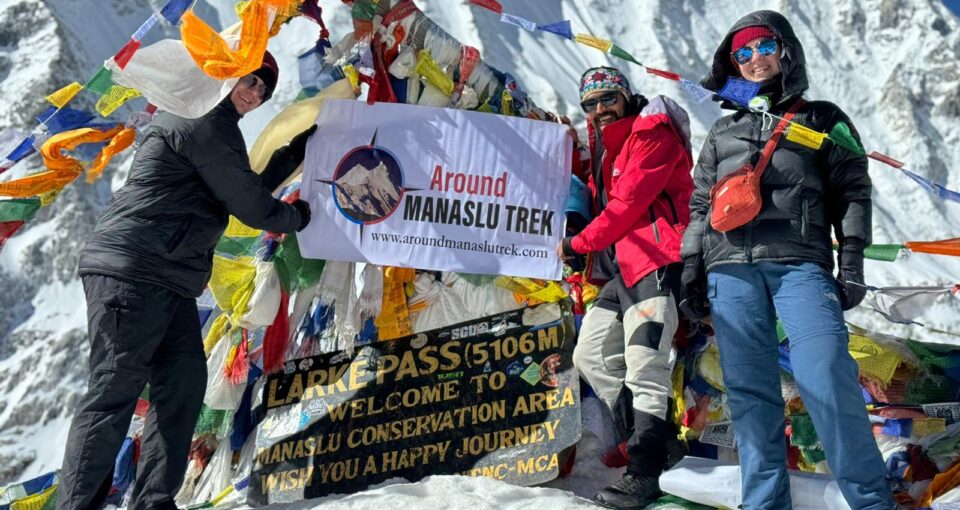
The Manaslu Circuit Trek is one of the best teahouse trails in Nepal; it stands out for its unique blend of culture, with a strong influence of Buddhism, and its picturesque teahouse trail. It is an off-the-beaten-path trek , circles the majestic Mount Manaslu crossing the challenging Larkya La Pass at an altitude of 5,106 meters, provides stunning views, diverse landscapes, and cultural insights. Lasting 12 days, the Manaslu Circuit Trek ranks among the most captivating and sought-after trekking routes in Nepal, trailing closely behind the Everest Base Camp and Annapurna Base Camp treks in popularity.
Table of Contents
Manaslu is a popular remote area located in the central west part of the Himalayas in Nepal. It reckons in the sub-tropical Himalayan foothill to dried Trans-Himalaya high meadow bordering Tibet, China. The elevation of its sub-tropical zone varies from 1000 meters to 2000 meters; whereas the sub-alpine zone ranges from 3000 meters to 4000 meters. Its zone above 4500 meters is called an arctic zone.
Historical Access Restrictions : The Manaslu region was closed to foreigners until 1991. Although it is now a popular tea-house trekking route, certain areas remain restricted or controlled zones, requiring special permits for foreign visitors.
Thrilling Adventure at Larkya La Pass: Exploring Nepal’s Manaslu Circuit Trek
Throughout the Manaslu Circuit Trek, Larkya La Pass at 5,106 meters stands out as the most challenging and thrilling high pass in Nepal’s Himalayas. At its summit, trekkers are treated to breathtaking views of Manaslu, Manaslu North, Samdo Peak, Naike Peak, Larke Peak, and Cheo Himal. The pass lies between Dharmasala and Bimtang, marking the highest point of the trek. In winter, heavy snowfall can make crossing Larkya La Pass difficult, often blocking the trail near the summit.
We, the Around Manaslu Trek, with our local crew and experienced team, specializes in leading treks throughout the Himalayas. Offering various multi-package treks in the Manaslu region for 2024/2025, we customize trek itineraries based on preferences and holiday duration. With licensed local guides from the Manaslu region, our high success rate ensures safety and enjoyment, even under challenging conditions. This restricted trekking journey promises unparalleled scenery, including the majestic Mt. Manaslu (8,163m), the world’s eighth highest peak, making it an ideal choice for those seeking tranquility, wilderness, and cultural immersion amidst Nepal’s rural landscapes.
Manaslu Circuit Trek Highlights
- Stunning Mountain Views : The trek provides awe-inspiring views of Mt. Manaslu, the eighth highest mountain in the world, along with other towering peaks like Himalchuli, Ganesh Himal, and others.
- Rich Cultural Experience : Encounter diverse ethnic communities such as the Gurungs, Nubri, Tsum, and Bhutias, each with their own distinct traditions, architecture, and way of life. Explore ancient monasteries, chortens, and prayer flags that dot the landscape.
- Tsum Valley : Visit the secluded Tsum Valley, known for its ancient Buddhist monasteries, pristine landscapes, and the warm hospitality of its inhabitants.
- Larkya La Pass : Challenge yourself with a crossing of the Larkya La Pass at 5,106 meters, offering breathtaking panoramic views of the surrounding peaks and valleys.
- Tea House Experience : Enjoy the unique opportunity to stay in traditional teahouses along the trail, offering a glimpse into the local way of life.
- Off-the-Beaten-Path : Experience the tranquility of a less crowded trekking route compared to other popular treks in Nepal, providing a sense of solitude and adventure.
- Natural Beauty : Immerse yourself in the stunning landscapes of the Manaslu region, including lush forests, terraced fields, and pristine rivers and waterfalls.
- Wildlife : Spot various wildlife species such as the elusive snow leopard, Himalayan tahr, blue sheep, and a variety of bird species in the region’s conservation areas.
Why to trek Manaslu Circuit
The Manaslu Circuit Trek offers a wealth of experiences and surpasses other trekking regions in Nepal with its diverse elements. Key features include:
- Cultural Richness : The trek showcases Buddhist culture, enriched by the presence of the Nubri, Tsum, Bhutia, and Gurung ethnic groups, who have resided in the region for over 700 years. Their culture closely resembles Tibetan culture. The region is dotted with significant Buddhist sites like Pungen Gompa , Mu Gompa, and Syala Gompa.
- Natural Wonders : The trek passes through diverse wildlife habitats, verdant forests, and across raging rivers via suspension bridges, all set against the backdrop of a breathtaking necklace of mountains.
- Endangered species such as red pandas, snow leopards, Himalayan tahr, Asian black bears, Himalayan musk deer, and blue sheep.
- More than 110 bird species, 35 mammals, and 3 reptiles.
- The Himalayan honey bee (Apis laboriosa), known for producing Mad Honey and being the world’s largest honey bee.
These elements make the Manaslu Circuit Trek an exceptional journey, offering an unparalleled mix of cultural immersion, natural beauty, and wildlife diversity.
Outline Itinerary
Detailed itinerary of manaslu circuit trek, day 01 kathmandu to machha khola (710 m / 2,362 feet).
Manaslu Circuit Trek begins from Kathmandu offering scenic greenery views of the Hilly region of Nepal following the bank of Trishuli River until reaching Benighat, then moving toward Aarughat, Soti Khola and finally Machha Khola. It takes an entire day to reach Machha Khola Khola.
Day 02 Machha Khola to Jagat (1370m / 4494feet)
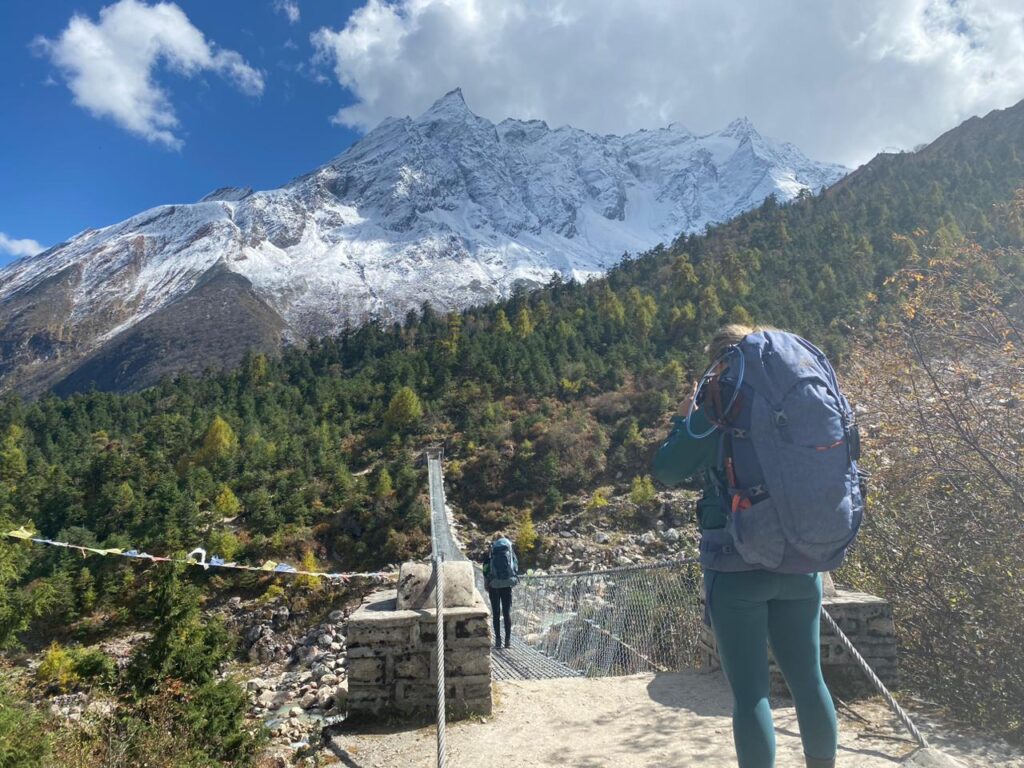
After beginning the wonderful trek to Machha Khola, the trek then moves toward Jagat village leaving behind Tatopani and Dobhan villages. In between Machha Khola and Dobhan, there is a traditional Gurung village called Khorla Besi. On reaching Tatopani i.e hot water, you can take a warm bath and relax for a while. The trek continues following the bank of the Budhigandaki River and crosses a suspension bridge just to arrive at Dobhan. The Nepali meaning of Dobhan is the interflow of two rivers. Following the waves, you can see the river getting flattened at Yaru village where you need to cross a long cantilever suspension bridge to reach Jagat. Jagat – a Gurung village where you will see a checkpoint to verify the entry permits of the trekkers. From today, you are entering the restricted area.
Day 03 Jagat to Deng (1,804m / 5920 feet)
The very next day, the trek ascends to Salleri and descends to Sirdibas. Then the valley widens and reaches the Ghatte Khola River. Meanwhile, you will be blessed with several prayer flags and gompas. There are some stop points where you can get local alcohol to try. However, it’s all up to you whether you want to try it or not. On the trail, you will encounter beautiful rhododendron forests, hanging cliffs, and towering peaks which are the highlights of the trail.
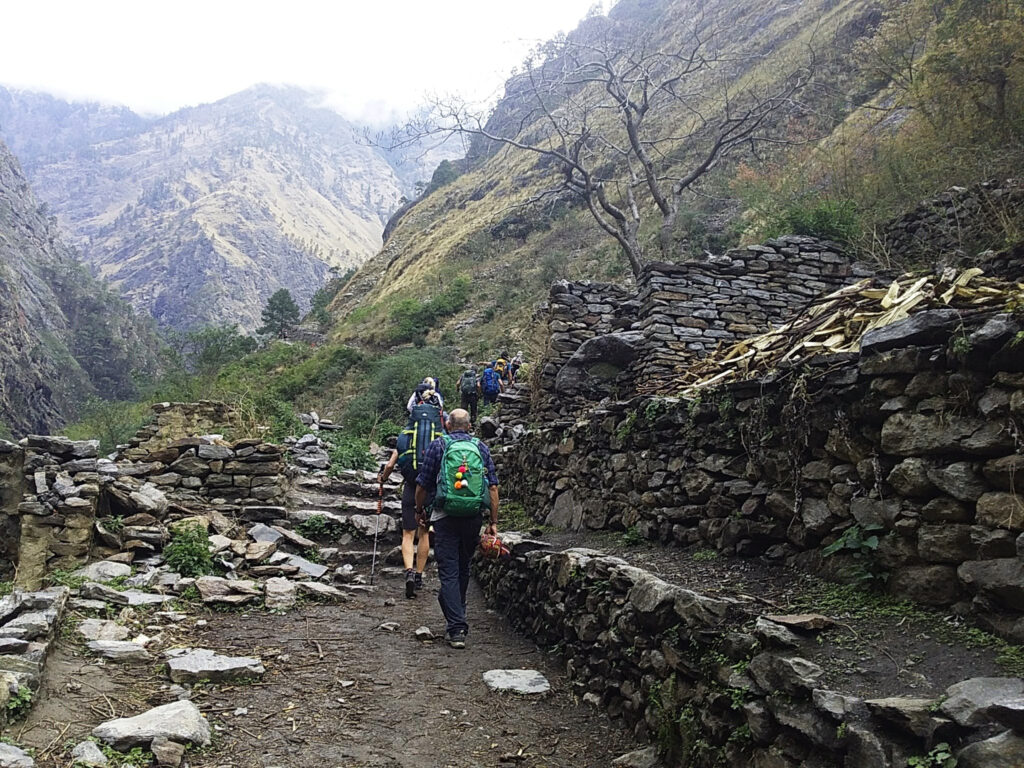
The trail continues walking upstream to a suspension bridge and reaches Philim – a Gurung village, and crosses the millet fields to the village of Ekle Bhatti. After a few minutes’ walk, the trail makes an entry to grassy slopes and crosses the Budhi Gandaki River. After that, trekking along the west bank for a while and crossing the east bank, you then return to the west side to follow the trail. Now, the trail widens and you pass through bamboo forests to Deng Khola and reach Deng village.
Day 04 Deng to Namrung (2,630m / 8628feet)
After having breakfast in Deng, you then further start your trek. This is one of the important days of the trek which you will be experiencing. First, cross a suspension bridge over the Budhi Gandaki River, and climb a ridge of Rana and Bihi Phedi. Now you will be passing through Lush forests and ethnic communities of the Manaslu region. Meanwhile, some beautiful peaks begin to appear in distance.
Today, you will be heading toward Prok which is a beautiful vintage point for the astounding view of snowcapped Siringi Mountain. Along the way, you will pass through several Gompas and crosses the Budhi Gandaki River. And the trail follows dense forests which reside inside the Manaslu Conservation Area, then you take a last steep climb to reach Namrung village.
Day 05 Namrung to Samagaon (3,530m / 11581 feet)
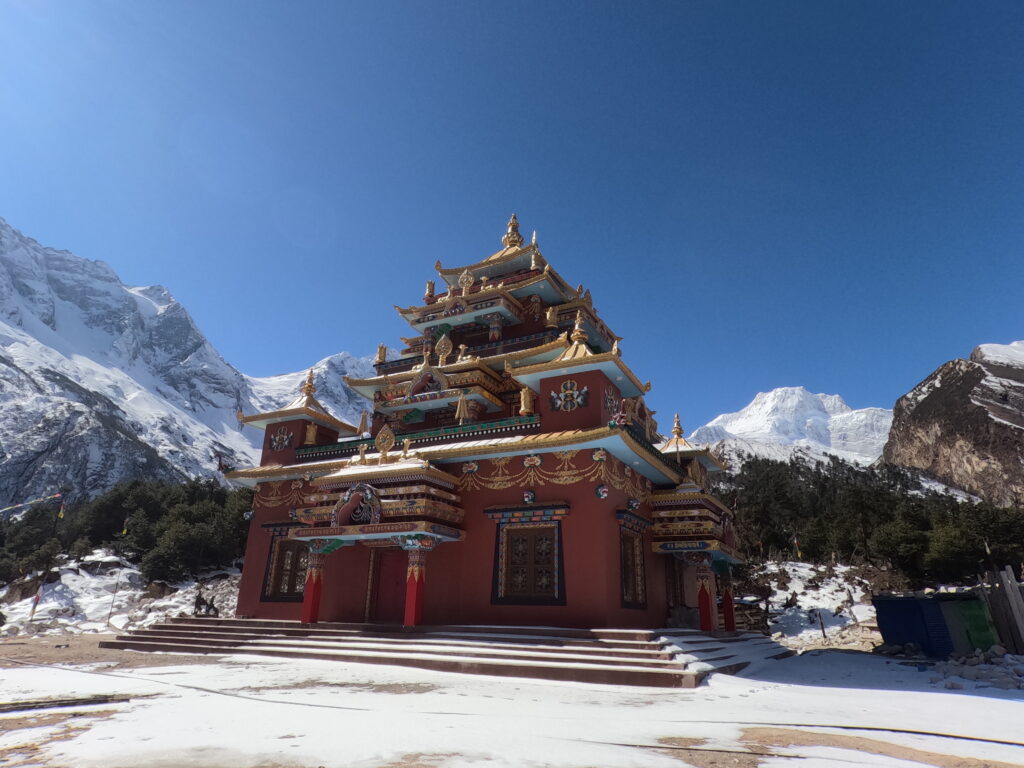
Today in the morning after having breakfast, you may like to walk around Namrung and get the best view of Siringi Himal, Ganesh Himal, and Himchuli. After that, you will pass through a few beautiful small villages like Lhi. Lhi is a beautiful small village having many stupas and barley terraces. In this area, you will get to witness the lifestyles of the Nubri people and explore the Tibetan lifestyle and cultures while passing through several mani walls, and lush terraces before entering Fir. You then encounter rhododendron and oak forest in between Lhi, Sho, and Shyala villages before reaching Samagaon. You will notice the amazing scenery of Mt Manaslu from Lho.
Day 06 Rest in Samagaon (Side trip to Manaslu Base Camp)
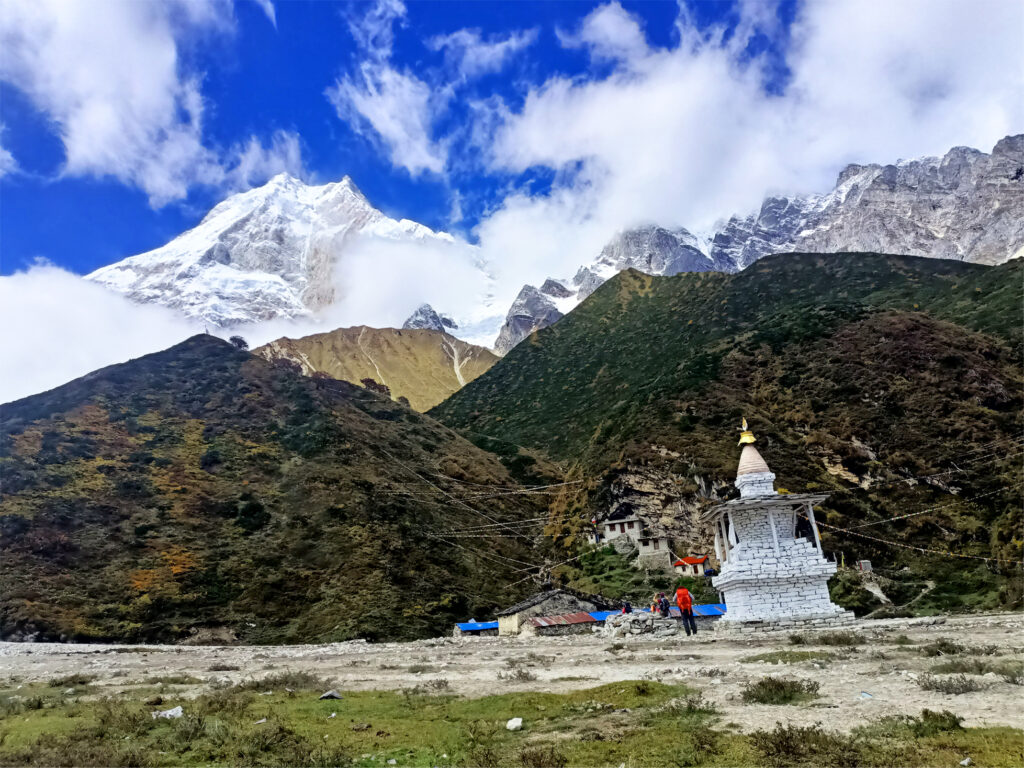
Begin your day with a nutritious breakfast at your teahouse in Samagaon. Prepare for the day’s side trip by packing essentials such as water, snacks, extra layers, sunscreen, and a hat. Set out on the hike towards Manaslu Base Camp, starting on a trail that offers spectacular views of the surrounding landscapes.
As you ascend, take regular short rest breaks to hydrate and enjoy snacks while appreciating the breathtaking scenery. The hike to Manaslu Base Camp involves a steady climb and can take several hours, so pace yourself and enjoy the journey.
Upon reaching Manaslu Base Camp at around 4,800 meters (15,748 feet), take time to marvel at the stunning views of Mount Manaslu and the surrounding peaks. This is an excellent opportunity for photos, rest, and hydration before beginning the descent.
Start your return hike to Samagaon, taking your time to safely navigate the trail and soak in the panoramic views on the way down. Once back in Samagaon, enjoy a well-deserved lunch at your teahouse.
In the afternoon, explore Samagaon village. Visit the Pungyen Monastery, interact with locals, and learn about their Tibetan-influenced culture and traditions. Take a gentle walk around the village to further aid acclimatization and appreciate the peaceful surroundings.
- Acclimatization day
- Have a refreshing breakfast and spend the day around Samagaon
- You can take a small hike on a little hill near Sama Village where you will find an old gompa called Pungyen Gompa while you may explore Sherpa culture and witness thousands of mani stones with a Buddhist text.
Day 07 Samagaon to Samdo (3,875m / 12713 feet)
- Descend to the Budhi Gandaki river and follow the bridge over the side stream
- Pass through several mani walls and get an amazing view of the mountain
- Get closer to the Tibetan border
- After reaching Samdo, explore nearby villages and hike to Samdo Peak. You can find the Larkya trail on the left side above the valley
Day 08 Acclimatization day at Samdo and visit to Tibetan border
Start your day with a hearty breakfast at your teahouse in Samdo. Prepare for the day’s adventure by packing essentials such as water, snacks, extra layers, sunscreen, and a hat. Begin your hike towards the Tibetan border, following a trail that gradually ascends and offers stunning views of mountains, valleys, and the Syacha Glacier.
Take a short rest break along the way to hydrate and enjoy a snack while soaking in the majestic views. Continue your hike, ascending steadily towards the border. Reach the Tibetan border at around 4,800 meters (15,748 feet), and spend some time appreciating the panoramic views and the unique experience of being so close to Tibet. Take photos, rest, and hydrate before starting your descent.
Carefully make your way back to Samdo, taking in the beautiful scenery along the way. Arrive back at your teahouse and enjoy a well-deserved lunch. After lunch, explore Samdo village, visiting the local monastery and interacting with villagers to learn about their Tibetan culture and traditions. Take a leisurely stroll around the village, enjoying the tranquil atmosphere and beautiful surroundings.
If you’re feeling up to it, take a gentle walk around the outskirts of the village for additional acclimatization, or simply relax at the teahouse and savor the views. End your day with a nourishing dinner, sharing experiences with fellow trekkers and guides. Spend the evening hydrating and relaxing, ensuring you’re well-rested for the next day’s trek.
Day 09 Samdo to Dharmasala (4,460m / 14632 feet)
- Climb to reach Dharmasala – an adventurous day
- Enjoy the scenic view of the Himalayan range while walking through a rugged trail.
Day 10 Dharmasala to Bhimtang (3590m / 11778 feet) via Larkya La (5160 m / 16929 feet)
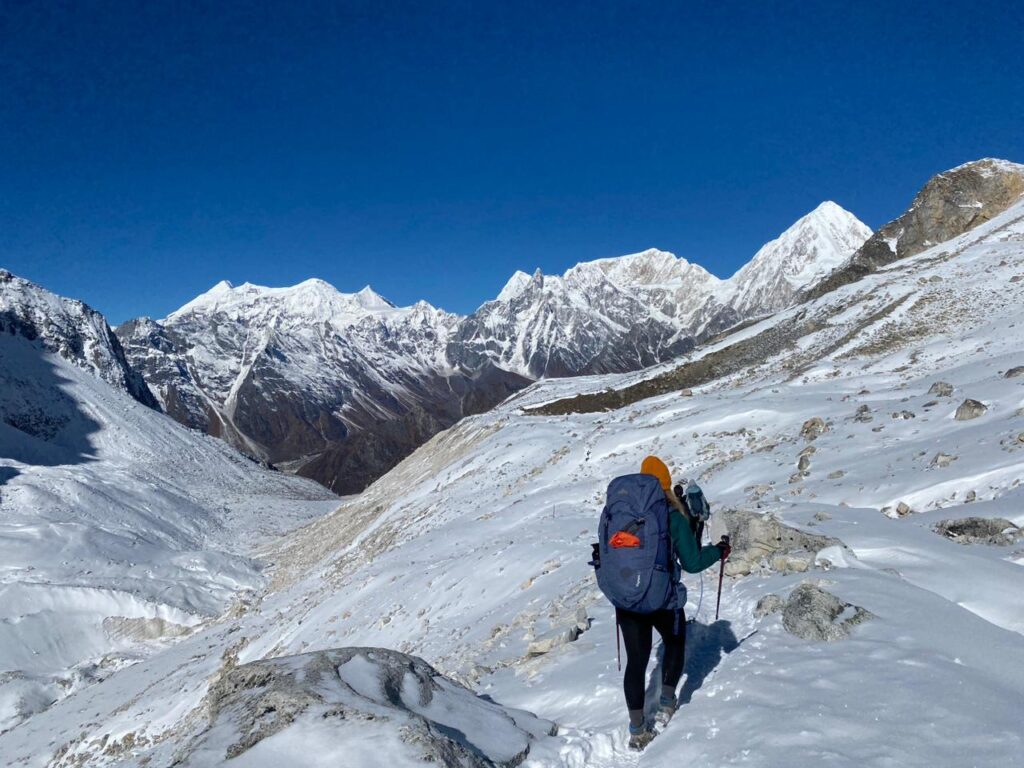
- Today is the special day of the trek – a challenging part of the trek
- Crosses Larkya La Pass steadily – the highest altitude of the trek before the afternoon
- Spend special time at the pass and get enjoyed the view of Himlung, Kang Guru, and Annapurna II
- And down toward Bimthang, it takes around 3 hours
Day 11 Bhimtang to Dharapani
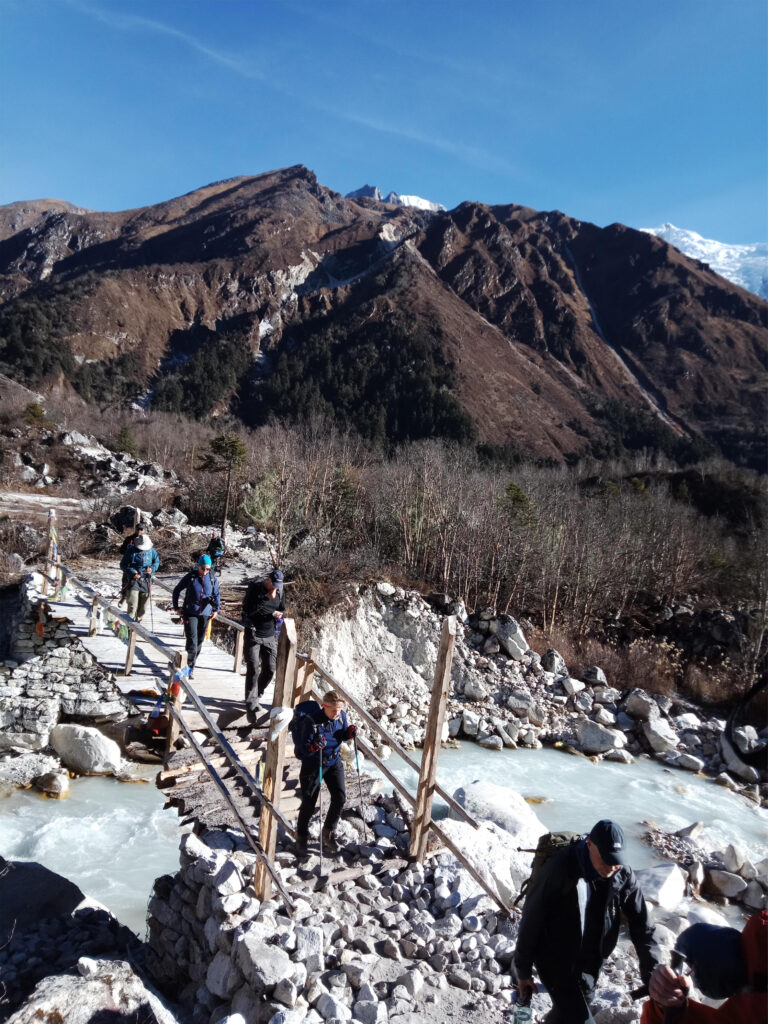
- Descend through pine and rhododendron forests, passing through several small settlements.
- Enjoy views of the Lamjung Himal and cross a river before reaching the village of Tilije.
- Overnight stay in Tilije.
- Continue descending through villages and terraced fields.
- Pass through the village of Thonje and cross a bridge to enter the Annapurna region.
- Reach Dharapani, where you’ll join the Annapurna Circuit trail.
- Overnight stay in Dharapani.
Day 12 Dharapani to Kathmandu
- Take a shared jeep or bus from Dharapani back to Kathmandu (approximately 7-8 hours).
- Arrive in Kathmandu and transfer to your hotel.
- Spend the evening relaxing and celebrating the completion of your trek.
Price Includes
- 3 times (Full board) meal per day during the trek
- Seasonal Fruits
- Tea house accommodation during the trek (twin shared accommodation)
- All land transportation as per itinerary (Kathmandu to Soti Khola and Dharapani to Kathmandu by local bus)
- A professional government licensed trekking guide
- All required permits (Restricted area permit, TIMS, Manaslu Conservation Area Permit, and Annapurna Conservation Area Permit)
- Travel and rescue arrangements only
- Duffel bag to carry your equipment and trekking map
- All necessary paper works
- Farewell dinner
- Basic medical kit
- All government and local taxes
- A porter (A porter can carry up to 15 – 20 kg – 1 porter for 2 trekkers)
- Private jeep (Kathmandu to Soti Khola drive)
- All airport-hotel transfers
- Boutique hotel accommodation in Kathmandu with breakfast included (Optional:4-star hotel)
Price doesn’t Include
- International airfares
- Lunch and Dinner in Kathmandu
- Tips for guide and porter
- All additional costs (such as beverages, shopping, etc)
- Travel and rescue insurance
- All the things not mentioned in the inclusion
Alternatives treks to Manaslu Circuit Trek in Manaslu Region
Manaslu circuit trek offers a remarkable experience for every adventurer as it passes through the 8th highest Mountain Manaslu (8163m). It combines the amazing mountain ranges with diverse flora and fauna along with rich cultural and archaeological sites. Around Manaslu Trek often called Manaslu Circuit Trek is one of the most popular treks which encircles Mt. Manaslu. During the trek, trekkers are gifted with a wide variety of stunning mountain sceneries as well as Tibetan origin culture.
Concerning Manaslu’s historical and cultural aspects, the government has issued a special permit for foreigners to visit this area. Foreigners must issue permits from the Department of Ministry. Mainly, Autumn and Spring are the best seasons and busiest times in Nepal. So booking the Manaslu trek earlier means securing a place on tour in Manaslu.
List of alternatives treks to Manaslu Circuit Trek in Manaslu Region:
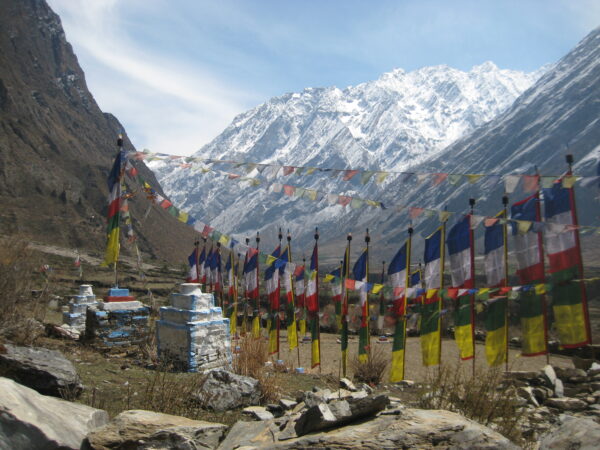
Tsum Valley Trek

Manaslu Circuit with Tsum Valley Trek
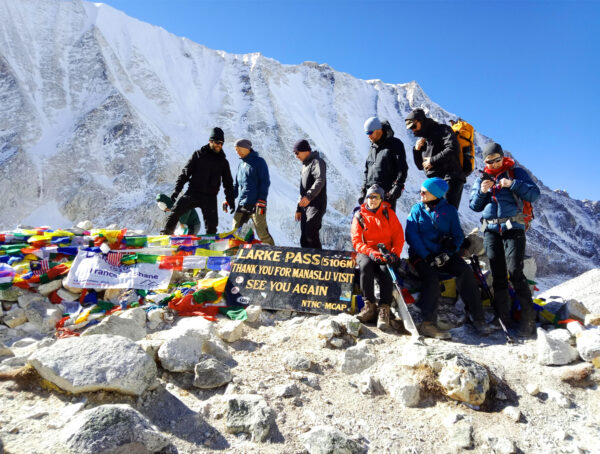
Manaslu Luxury Trek
Best time to trek manaslu circuit.
Apparently, there are two seasons for adventure in subtropical Nepal Himalayas – A dry season of winter begins around late August and ends at end of November, and a wet warmer season starts in early March and ends at end of May.
In fact, the most popular time for Manaslu circuit trek is Autumn (September to November) and Spring (March to May) . That is why trails become busy in these seasons. However, Manaslu is open for trekking. Even trekkers leave for trekking to Manaslu in winter (December to February) and summer (June to August). To be true, if you want to avoid crowds, winter and summer can also be the best time for you. Winter of Nepal is not like the winter of Canada and many European countries where the winter season is really a harsh one.
Nepal is diversified into 3 different geographical regions – Mountain, Hilly, and Plain regions. It causes variations in the temperature of Nepal in different places. But your trek begins in the Hilly region, goes through the Mountain region, and comes back to the Hilly region. Basically, the temperature in trekking zones tends to be average throughout the year, with an average high between 24 to 30 degrees Celsius and average lows of 12 to 1 degrees Celsius .
Read more at best time to trek in Nepal
Food and Accommodation in Manaslu Circuit Trek
You will be served a full board basis meal, but only breakfast is provided while in Kathmandu. During the trek, 3 times meals (breakfast, lunch, and dinner) with one cup of tea/coffee will be served from tea houses. Every day, dinner and breakfast will be served at the same tea house where we stay overnight, while lunch will be taken in the tea house on the way to the trek. Please note there may not be a variety of foods as the region is not well established like the Annapurna and Everest region. You will usually have Tibetan bread, Dal-Bhat, Tsampa porridge, and other local foods.
While trekking the Manaslu Circuit, you will primarily be served Dal Bhat Tarkari , a typical Nepali meal, for lunch and dinner. The food options are somewhat limited compared to the more frequented Everest Region due to fewer teahouses and a smaller variety of available dishes.
For breakfast, you can expect to find options such as Tibetan bread served with honey or jam, porridge with local honey, or eggs prepared to your liking (boiled, fried, or scrambled) accompanied by chapati or toast.
Lunch often mirrors dinner with Dal Bhat being a common staple, but you may also find noodle soups like Thukpa, which are particularly comforting in cooler weather. Despite the limitations, the meals provided are nourishing and fitting for the trekking experience, ensuring you have the energy needed to explore this beautiful region.
Please read the following article to know the suggested food to eat while on the Manalsu trek.
- Manaslu Circuit Trek Food .
- What to eat during the Manaslu Trek
As you arrive in Kathmandu, you will be welcomed and picked up, then transferred to a Hotel if you order airport pick-up service. You stay in a hotel in Kathmandu. Several types of hotels can be found in Kathmandu. 5-star levels to boutique hotels and homestay are available to stay overnight. However, we normally provide a boutique hotel with breakfast included . Each member will get a separate room. While you are trekking, you are provided tea house accommodation as there is no luxurious hotel or lodges in the Manaslu region. So the trek is also called a tea house trek . In fact, you can not find a deluxe hotel in the Nepal Himalayas.
Manaslu Circuit Trek Difficulty (Altitude Sickness, Acclimatization, and Training)
All trekking routes in the Manaslu region reach up to 5,106 meters in altitude at Larkya La Pass, which can cause altitude sickness. While crossing Larkya La Pass, you may encounter altitude sickness. Therefore, before embarking on your Manaslu circuit trek, it is essential to understand its symptoms and the process of acclimatization. Note that although all the trekking in Manaslu is moderate, it can be quite strenuous. Nevertheless, a trekker aged between 58-65 years can successfully complete this trek with proper acclimatization.
Manaslu circuit trek often requires at least 5-6 hours of walking every day. Whereas, you also need to walk 8-9 hours on some days that including walking in Larkya la pass. Therefore, we suggest you get prepared with walking or jogging exercises every day 3 months prior to the trip. Then, you will be able to walk in physically demanding high altitude and remote places. To enjoy this trip, you should bring willpower and the ability to tolerate harsh conditions.
For detailed information, check out the Manaslu Circuit Trek difficulty .
Travel and Trekking Insurance for Manaslu Circuit Trek
Travel and trekking insurance is mandatory for the Manaslu Circuit Trek. While the risk of injury on the Manaslu circuit trek is relatively low, it is essential to have comprehensive insurance to cover medical expenses and emergency helicopter rescue costs in case of an unforeseen incident.
Your insurance should specifically cover a maximum altitude of up to 6,000 meters. Although high-altitude coverage is not typically included in standard travel insurance policies, it must be added separately. For more information on travel insurance, read “ Travel Insurance for Trekking in Nepal ” and also check out the article “ Helicopter Rescue Scam ” for additional insights.
Is travel insurance mandatory for Manaslu Circuit Trek?
Yes, travel insurance is mandatory for the Manaslu Circuit Trek. Due to the remote and challenging nature of the trek, it is crucial to have comprehensive insurance that covers high-altitude trekking, medical emergencies, evacuation, and trip cancellations. Ensure that your policy covers trekking up to 5,000 meters and includes helicopter evacuation services. This will not only ensure your safety but also provide peace of mind throughout your adventure.
Manaslu Circuit Trek – Packing lists/Trekking Gears
The packing list for Manaslu Circuit Trek differs in different seasons, which includes some important items. Trekking gears like Down Jacket, Sleeping bag, Hiking boots, Trekking Poles, Trousers, Sunglasses, T-shirts, Hiking socks etc are mostly required for the trip. Some of the items can be rented. But we suggest some personal things that you should bring with you to Nepal.
Check out a complete packing list for Manaslu ciruit trek to get detail about the trekking gears.
Necessary Permit for Manaslu Circuit Trek
Foreigners need 3 different permits to trek Manaslu. The permits are Restricted Area Permit, Manaslu Conservation Area Permit, and Annapurna Conservation Area Permit. Moreover, it needs a special restricted permit, which requires at least 2 trekkers and a local guide. It is mandatory for restricted area like Manaslu, Upper Mustang, Upper Dolpo Trek etc.
For detail go to Manaslu Circuit Trek Permits – Requirement and Fees
Manaslu Circuit Trek Transportation
Nowadays, local buses provide easy access to Soti Khola and Machha Khola, where the trek begins. Alternatively, you can choose a private vehicle, such as a jeep or Hiace, or opt for a shared jeep for a more comfortable ride.
Local buses take approximately 9 hours to reach Machha Khola. While this is a more budget-friendly option, it can be quite crowded, with fares around 1500 Nepalese rupees per person. On the other hand, private jeeps offer greater comfort and flexibility. They can be arranged through travel agencies or hotels and typically reach Machha Khola in about 7 to 8 hours. However, this option is more expensive, costing up to 220 USD.
Transportation Options We Provide
Beginning of the Manaslu Circuit Trek: You should follow the above itinerary. In the beginning, you need to travel to Machha Khola from Kathmandu via Soti Khola . It takes nearly 8/9 hours or 7/8 hours by local bus and private jeep respectively.
Ending of the Manaslu Circuit Trek: You will also complete your trip by driving back to Kathmandu. From Dharapani, you will return to Besisahar by shared jeep and then change to a local bus for a 7-8 hours Kathmandu drive.
Communication Medium in Manaslu Circuit Trek
Now Internet WiFi service is available in most of the teahouses. You also can get SAT phone to communicate with your friends and families paying a certain amount of charge. But local telephone hardly works in this region. Mobile networks (NTC and NCELL) do also provide coverage in this region.
Trekking Map
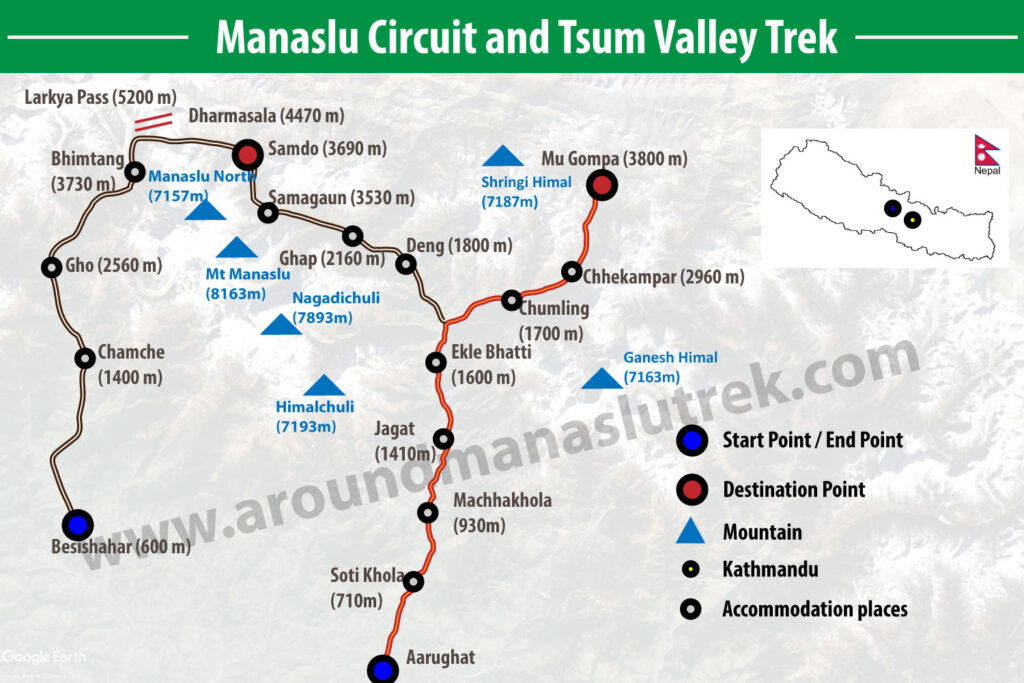
Tourist Visa Information for Manaslu Circuit Trek
All foreigners except Indian nationals require a visa to visit Nepal. Citizens of some countries like SAARC (South Asian Association for Regional Cooperation) countries and China do get free visas upon arrival in Nepal. However, the rest of the world’s people must issue visas to enter Nepal. You can easily get an arrival visa at Tribhuvan International Airport. You just require to have a passport with at least 6 months validity, a PP-size photo, and a visa fee, then you will get the visa in Nepal. As of now, the visa fee is $50 USD for 30 days which you can pay in cash.
There are a few countries like Ghana, Zimbabwe, Nigeria, Cameroon, Swaziland, Somalia, Liberia, Ethiopia, Iraq, Palestine, and Afghanistan; the citizen of these countries do not receive an on-arrival visa. They have to contact the embassy of Nepal or the nearest consulate.
Most foreign travelers can obtain a visa on arrival at Tribhuwan International Airport in Kathmandu, Nepal, provided their passport is valid for at least six months. Currently, both arrival and departure online applications must be submitted prior to your flight. For the latest regulations, please visit the official Nepal Immigration website: Nepal Immigration .
Manaslu Circuit Trek Gallery
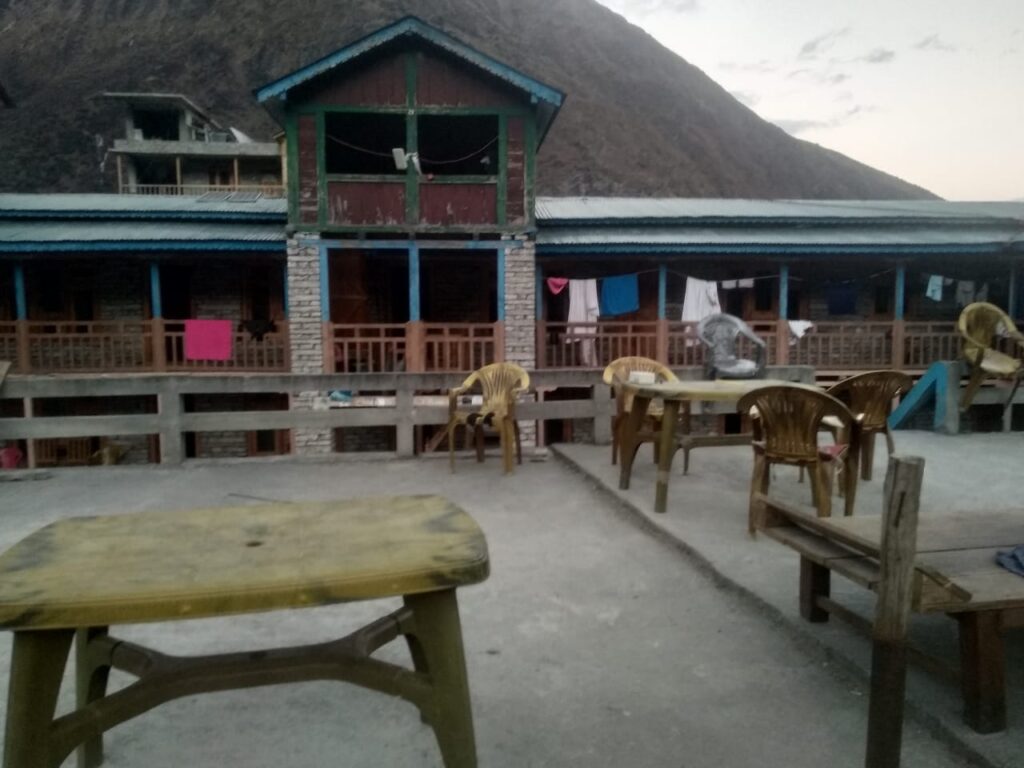
- We are determined to operate trekking on fixed departure dates despite a single-person booking.
- You can request your own group departure date, we will help you to find your trekking partner. Or we also operate private trip.
Fixed Departure Dates and Cost
Faqs of the manaslu circuit trek, how much does manaslu circuit trek cost, can i trek to manaslu without a guide and porter, how far is manaslu from kathmandu, how do i reach manaslu from kathmandu, where is manaslu located, is manaslu circuit trek better than annapurna circuit trek, how is the climate in the manaslu region, is manaslu helicopter tour possible like everest base camp helicopter tour, is natural water drinkable on the manaslu circuit trek, what is the highest altitude of the manaslu circuit trek, should i choose tsum valley or only go to manaslu circuit trek, is it possible to comeback to kathmandu by helicopter from manaslu base camp, is larkya pass difficult for beginner trekkers, which peak is the highest mountain in the manalsu region, does credit card work in manaslu region, do you customize the manaslu circuit trek, do i need oxygen for manaslu circuit trek, is this trek suitable for children and pregnant woman, who will pickup me at airport, can i do manaslu circuit trek alone, what is the cost of manaslu circuit trek permit, how much altitude do we gain during the manaslu circuit trek , how far is the tibetan border from samagaun, manaslu, how long does it take to hike manaslu, why to trek manaslu circuit trek with us.
Choosing the right trekking company can significantly enhance your Manaslu Circuit trek experience. Here are compelling reasons to consider trekking the Manaslu Circuit with us:
Expert Local Guides
Our team comprises experienced local guides who are not only well-versed in navigating the Manaslu Circuit but are also deeply familiar with the local culture, history, and environment. Their expertise ensures you have a safe, informative, and enriching trekking experience.
Tailored Itineraries
We understand that every trekker has unique needs and preferences. That’s why we offer customizable itineraries that can be adjusted to match your fitness level, interests, and time constraints, ensuring you get the most out of your Manaslu circuit trek.
Small Group Sizes
To enhance your trekking experience and ensure personalized attention, we maintain small group sizes. This approach fosters a closer group dynamic, allows for more interaction with your guide, and minimizes our impact on the environment and local communities.
Sustainable Trekking Practices
We are committed to sustainable tourism practices that protect the environment and contribute positively to local communities. By trekking with us, you’re supporting eco-friendly practices and helping promote economic benefits for the local people.
Comprehensive Support
From the moment you book your trek to the day you complete your journey, our team provides comprehensive support. This includes pre-trek preparation advice, assistance with obtaining necessary permits, and ensuring you have the right gear and information for a successful trek.
Safety First
Your safety is our top priority. Our guides are trained in first aid and emergency response, and we conduct our treks with the utmost care, including regular weather and trail condition checks. We also ensure that our treks are conducted in accordance with the latest safety standards and protocols .
Cultural Immersion
Our treks are designed not just as physical journeys but as cultural experiences. We provide opportunities to interact with local communities, participate in traditional customs, and learn about the rich cultural heritage of the Manaslu region, offering a deeper connection to the places you visit.
Quality Equipment and Accommodations
We provide high-quality camping equipment for treks that require it and select the best available teahouses for your comfort. Our aim is to ensure that your nights are as enjoyable and comfortable as your days on the trail.
Competitive Pricing
We offer competitive pricing without compromising on the quality of our services. Our packages are all-inclusive, covering permits, accommodation, meals on the trek, and transportation, ensuring you get great value for your investment.
Choosing to trek the Manaslu Circuit with us means commencing on an unforgettable journey that is safe, enjoyable, and deeply connected to the natural beauty and cultural richness of the Himalayas. Our commitment to excellence, sustainability, and the well-being of our clients makes us the ideal partner for your Himalayan adventure.
What Our Clients Say
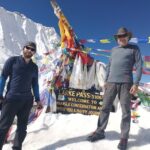
The team was professional and attentive to our needs
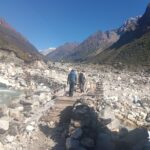
Manaslu Trek, not to be missed
We did the Manaslu Trek with Rajan our guide who was excellent. Not only knowledgeable and experienced but was very attentive to our needs anticipating and not only responding to our requests. The back office team, specifically Prash advised us in advance on preparations and handled administrations without a flaw. The trek itself is magnificent; moderate to challenging with amazing vistas all the way. It is also less travelled than the more classic treks around Annapurna or Everest Base Camp which is a plus. For us this was a father / son trip that is really a once in a life time experience.
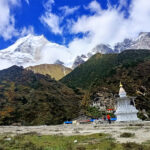
Best guide for nepal treks
One of the best guide and friendly too. Choose him without any hesitation. He always make sure the travellers are safe and sound. Best service and quality

Unvergesslicher Familienurlaub auf dem Manaslu Circuit
Während meines Aufenthalts in Nepal hatte ich das Glück, von meiner Familie besucht zu werden. Zusammen haben wir im März/April 2023 eine ausgedehnte Wanderung mit Nepal Holiday Treks and Tours unternommen. Diese führte uns um den Manaslu, den acht höchsten Berg der Welt, und in das malerische Tsum Valley.
Die Kulisse aus majestätischen Bergen, beeindruckenden Gletschern und malerischen Tälern war atemberaubend. Sie, zusammen mit der herzlichen Gastfreundschaft und den köstlichen Mahlzeiten, haben bei uns einen bleibenden Eindruck hinterlassen. Unser Guide Rajan und zwei Träger, die unser Gepäck trugen, begleiteten uns. Rajan besitzt ein ausgezeichnetes Wissen über die Region und hat persönliche Beziehungen zu den Gastgebern der besten Unterkünfte. Er hat ein gutes Gespür für die Bedürfnisse der Gruppe und plant die Tagesetappen entsprechend, so dass sich jeder wohl fühlt. Meine Eltern (ü50) konnten mit leichtem Gepäck wandern und waren dank Rajans stets verfügbarer Reiseapotheke bestens versorgt.
Seine kompetente, einfühlsame Unterstützung, sowohl physisch als auch psychisch, hat es uns ermöglicht, die Herausforderung des über 5000 Meter hohen Passes zu meistern. Ein unvergessliches Erlebnis! Für die besonders Energiegeladenen und Motivierten unter uns hatte Rajan immer zusätzliche Ziele und interessante Orte im Angebot. Ein Ausflug ins Tsum Valley ist definitiv empfehlenswert.
Travel Blog Posts
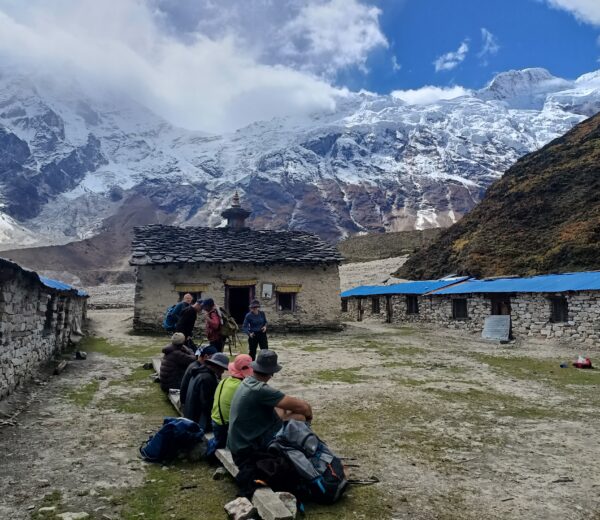
Manaslu Trek in August: A Comprehensive Guide
Weather and Temperature August is part of the monsoon season in Nepal, so trekkers can expect frequent rain showers, high […]
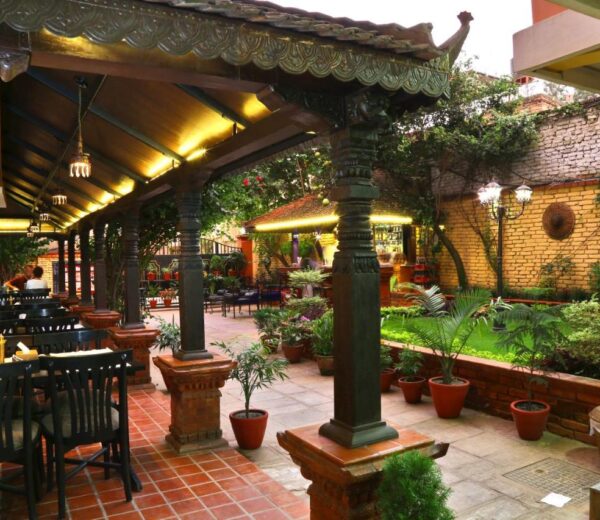
Best Boutique Hotels in Kathmandu, Nepal
Are you planning a trip to Nepal? If so, it’s essential to consider what you want to do while you’re […]
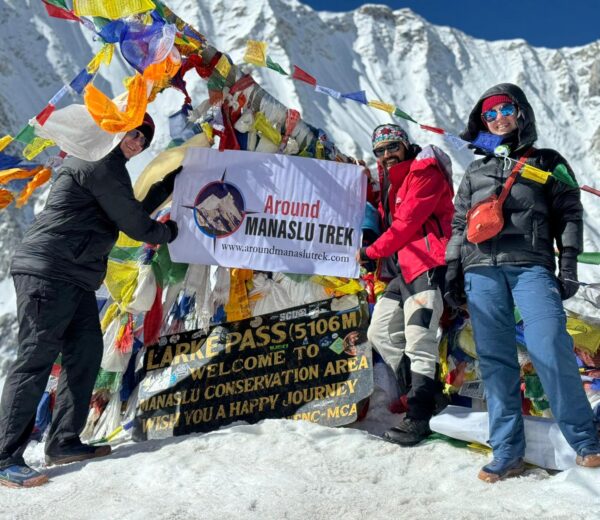
Safety Guidelines for Trekking in Manaslu: Your Ultimate Guide
Trekking in the Manaslu region offers an unparalleled adventure through some of Nepal’s most stunning landscapes. However, the rugged terrain […]
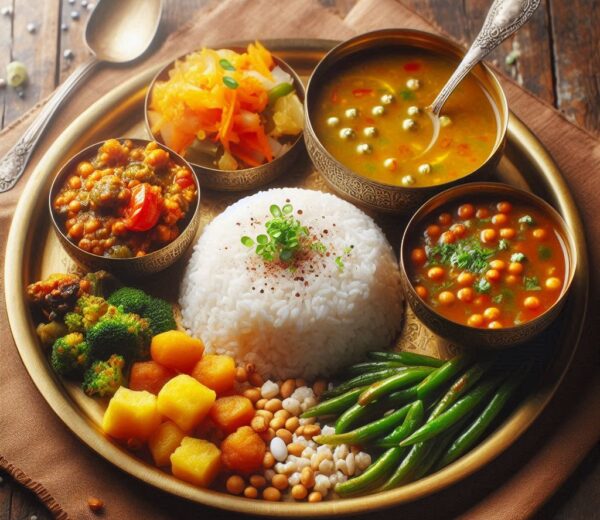
Dal Bhat Tarkari: Traditional Nepali Lentils, Rice, and Veggie Curry
Dal, Bhat, and Tarkari is Nepal’s national dish, embodying the essence of Nepalese cuisine. This traditional meal consists of lentil […]
Quick Inquiry
- You are here:
A Comprehensive Guide to the Manaslu Circuit Trek- things you must know
- Modified on Nov 29, 2023
Discover the hidden gem of trekking in Nepal with the Manaslu Circuit Trek . Nestled in the heart of the Himalayas, this trek offers a unique and less-crowded alternative to the more popular routes, providing an authentic Himalayan experience. In this guide, we'll delve into the details that make the Manaslu Circuit Trek a must-visit for adventurers seeking breathtaking landscapes, cultural richness, and a genuine connection with the mountains.
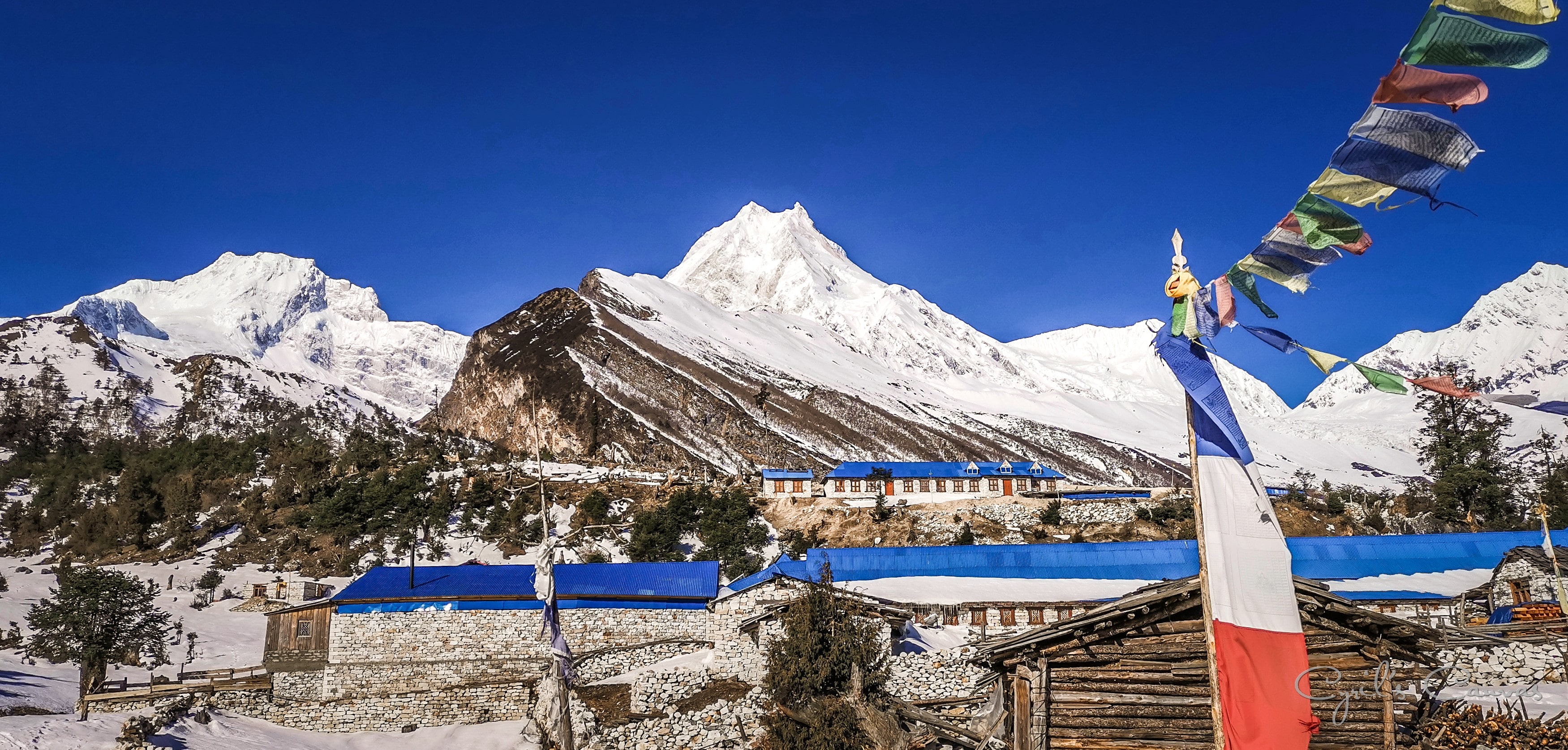
Table of Contents
Trekking route:.
Embark on an unforgettable journey as you navigate the circuit around Mount Manaslu, the eighth-highest peak globally. The trek commences in Arughat or Soti Khola, guiding you through enchanting villages, dense forests, and high-altitude landscapes. Key stops along the route include Deng, Namrung, Lho, Samagaon, and Samdo. The pinnacle of the trek is the challenging Larkya La Pass, standing at an awe-inspiring 5,160 meters.
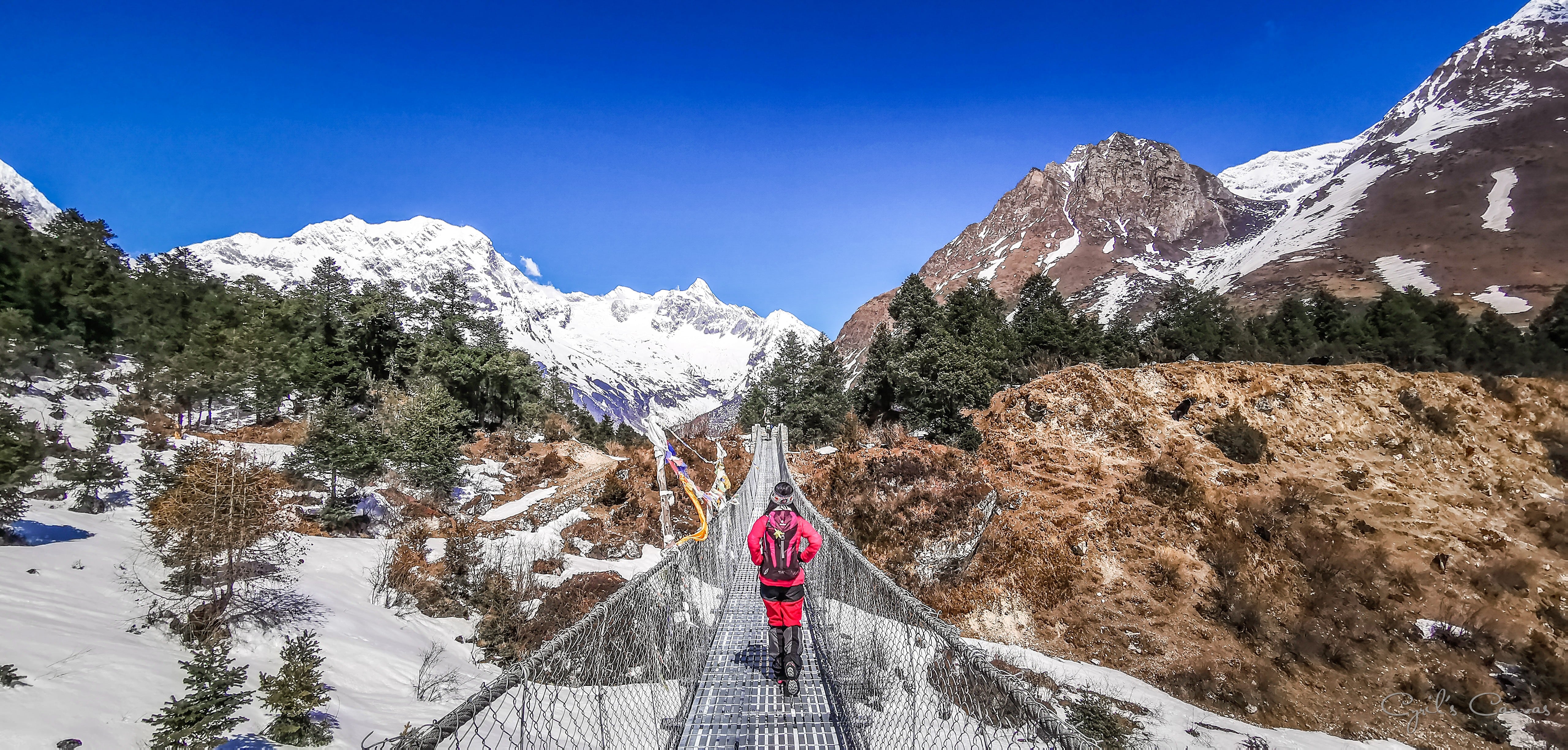
Prepare for your adventure by obtaining the necessary permits. A Manaslu Restricted Area Permit and a Manaslu Conservation Area Permit are essential, along with the requirement to be accompanied by a licensed guide.
Best Time to Trek:
Optimal trekking seasons are during the spring (March to May) and autumn (September to November), ensuring stable weather conditions and panoramic views of the surrounding peaks.
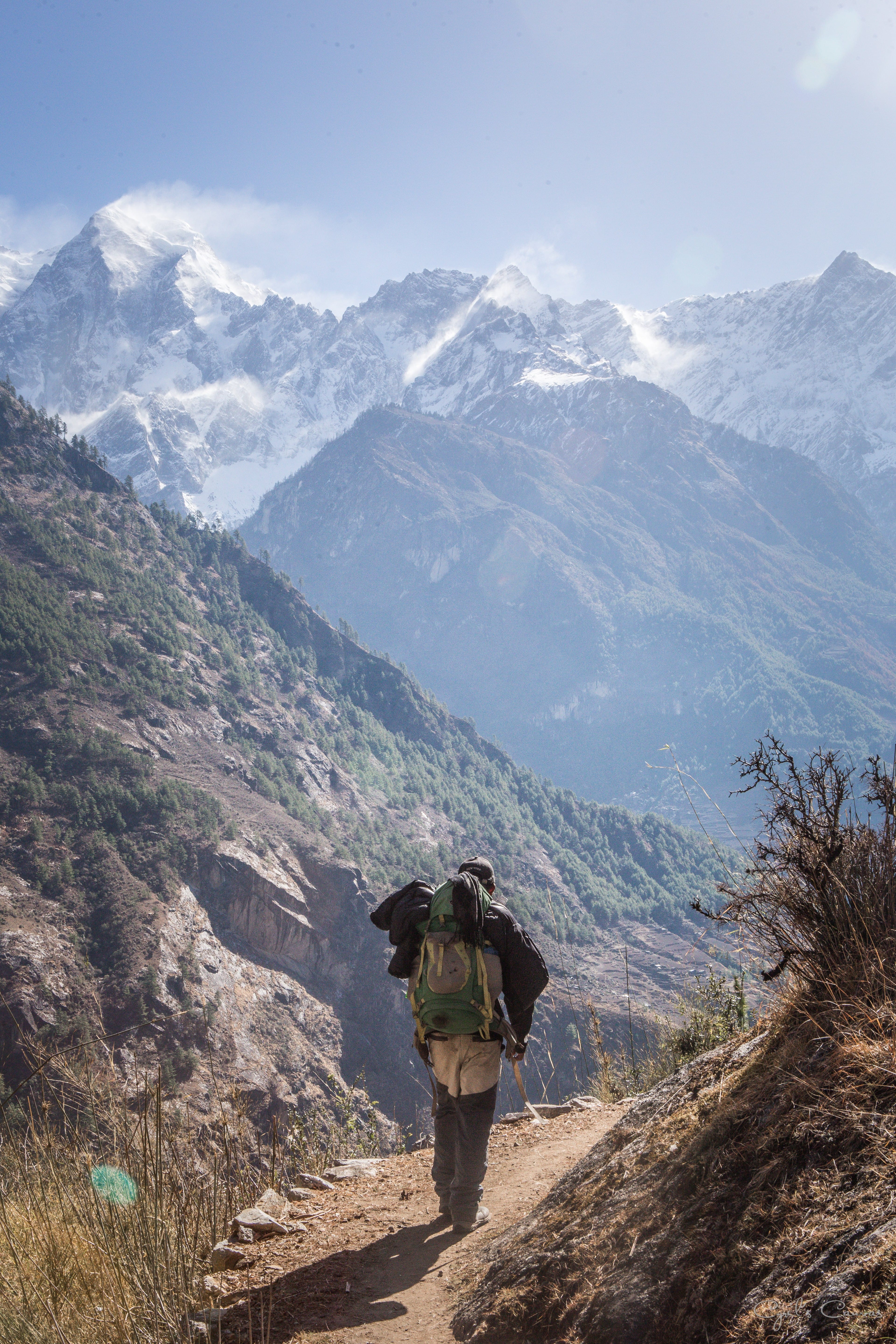
The trek usually takes around 14 to 18 days, depending on the chosen itinerary and acclimatization days.
Highlights:
- Scenic Beauty: The trek offers diverse landscapes, from lush green hills to alpine meadows and high mountain deserts.
- Cultural Experience: Encounter traditional Tibetan-influenced villages, monasteries, and the warm hospitality of the locals.
- Mount Manaslu: Enjoy stunning views of Mount Manaslu and other peaks like Himlung Himal, Cheo Himal, and Annapurna II.
- Larkya La Pass: Experience a challenging but rewarding ascent to Larkya La Pass, where you are surrounded by majestic snow-capped peaks.
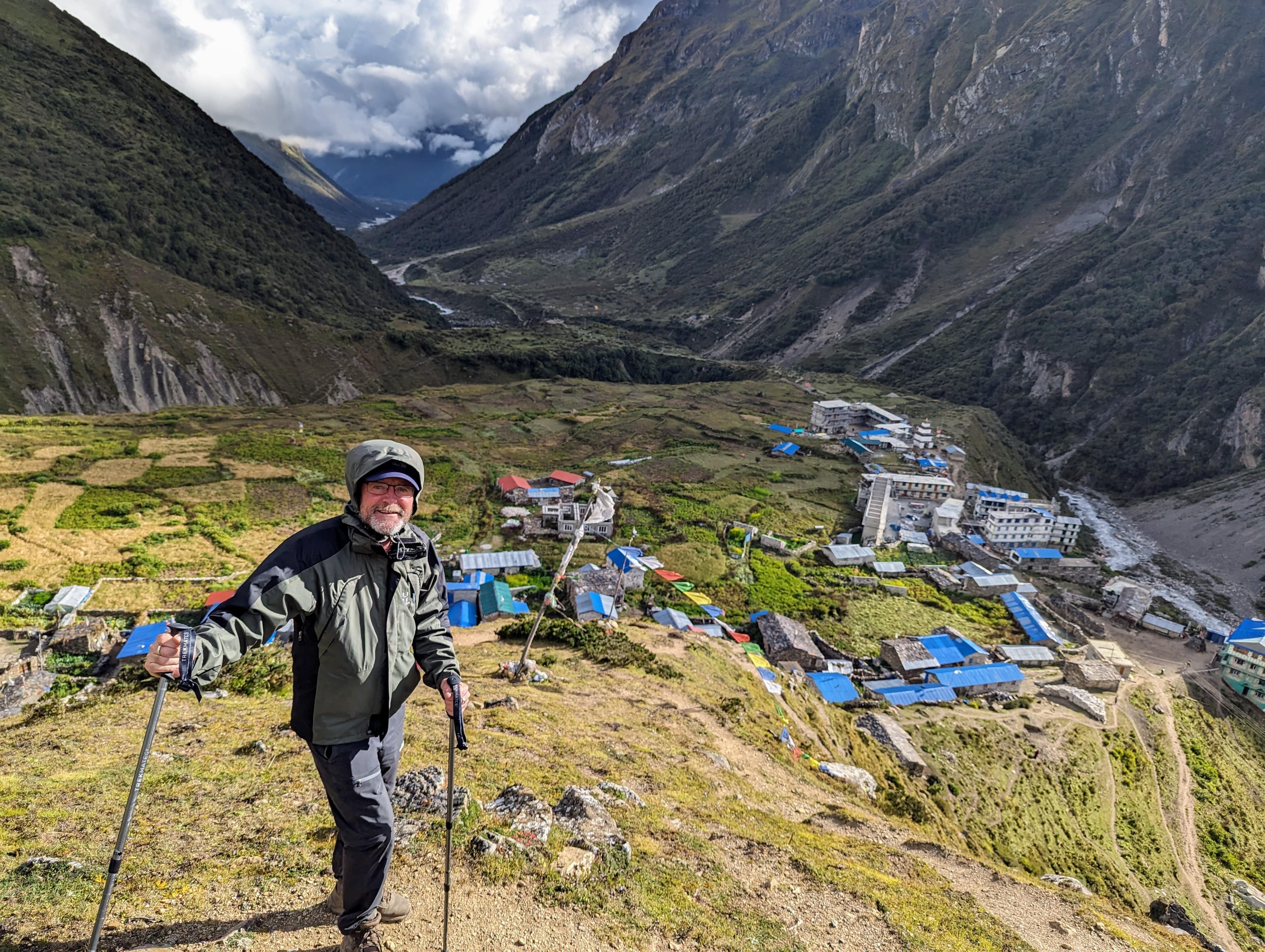
Difficulty Level:
The Manaslu Circuit Trek is moderately challenging, demanding physical fitness and proper acclimatization due to altitude changes and high mountain passes.
Accommodation:
Experience the warmth of tea houses and lodges along the route, offering basic yet comfortable accommodation. Booking in advance is recommended, especially during peak trekking seasons.
Preparation:
Physical fitness is essential for the trek, as there are steep ascents, descents, and the challenge of crossing high mountain passes.
Adequate gear, including warm clothing, a good pair of trekking boots, and a reliable backpack, is necessary. Trip Check list here
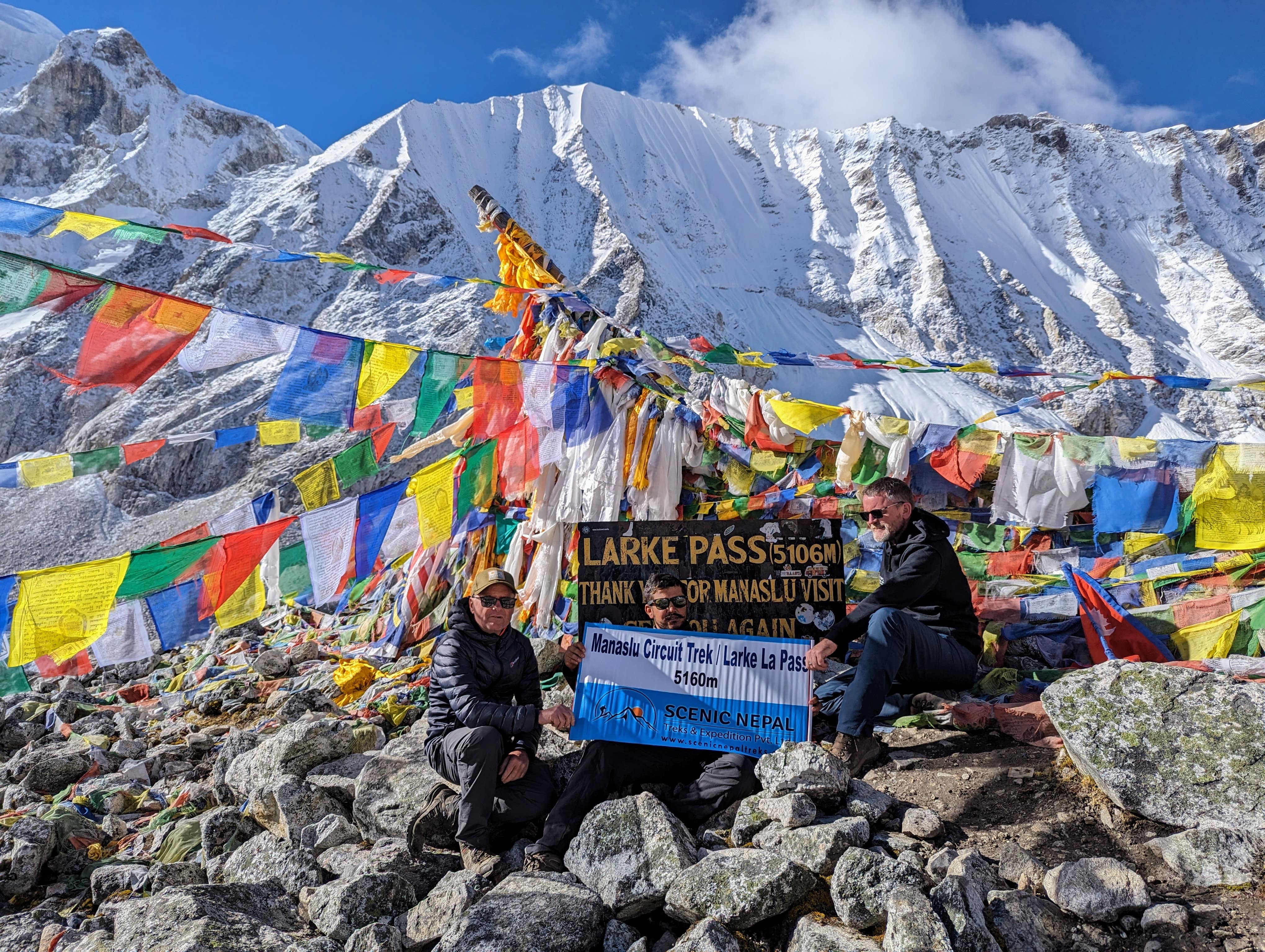
Cultural Sensitivity:
Respect local customs and traditions, embracing the strong Tibetan influence present in many villages along the route.
Hiring a Guide/Porter:
Consider the option of hiring a local guide or porter to enhance your experience, providing valuable support in navigation, cultural insights, and load-carrying. Scenic Nepal Treks offers you best guides.
Side Trips:
For a more immersive experience, explore side trips to Tsum Valley, a culturally rich and remote gem in the Manaslu region.
Unlock the wonders of the Manaslu Circuit Trek and create lasting memories as you traverse the captivating landscapes and cultural treasures of this Himalayan haven. Whether you're a seasoned trekker or a first-time adventurer, this trek promises an unparalleled journey into the heart of Nepal's majestic mountains.
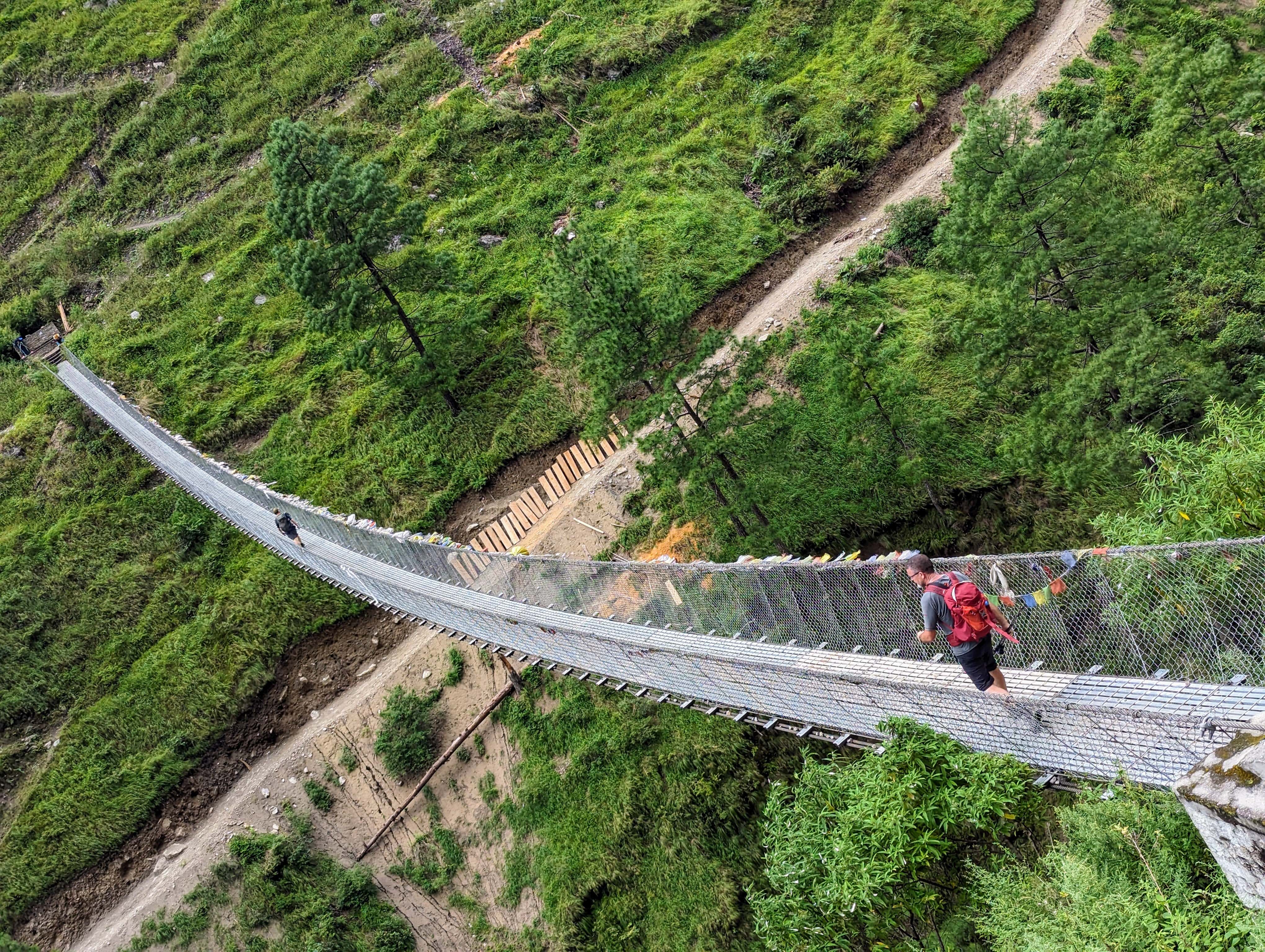
WHY manaslu circuit trek:
The Manaslu Circuit Trek offers a unique and captivating trekking experience in the Himalayas, presenting several compelling reasons for adventure enthusiasts to choose this trail:
Untouched Beauty:
The Manaslu region remains less frequented than popular trekking destinations like Everest and Annapurna, allowing trekkers to explore pristine landscapes in a more tranquil and untouched setting.
Cultural Immersion:
Trekking through traditional Tibetan-influenced villages provides an authentic cultural experience. Encounter the warmth of the locals, witness ancient monasteries, and gain insights into the unique customs of the region.
Stunning Mountain Vistas:
Revel in awe-inspiring views of Mount Manaslu, the eighth-highest peak in the world, as well as neighboring peaks like Himlung Himal, Cheo Himal, and Annapurna II. The diverse landscapes offer breathtaking panoramic vistas at every turn.
Challenging Larkya La Pass:
Conquering the Larkya La Pass at 5,160 meters is a thrilling challenge that rewards trekkers with unparalleled views. The sense of accomplishment upon reaching this high-altitude pass adds to the trek's allure.
Remote and Serene Atmosphere:
Unlike more popular trekking routes, the Manaslu Circuit offers a quieter and more serene atmosphere. Trekkers can enjoy the tranquility of nature and the Himalayan wilderness without the crowds.
Cultural Diversity:
The trail passes through diverse landscapes, from lush green hills to alpine meadows and high mountain deserts. This variety contributes to a rich and ever-changing trekking experience.
Tea Houses and Local Hospitality:
Accommodations along the route are provided by charming tea houses and lodges run by locals. This not only adds to the cultural experience but also ensures a cozy and welcoming atmosphere after each day's trek.
Moderate Crowds:
While the region has been gaining popularity, it still attracts fewer trekkers compared to more well-known routes. This results in a more intimate and personal trekking experience.
Adventure Off the Beaten Path:
For those who seek adventure off the beaten path, the Manaslu Circuit Trek offers an opportunity to explore a less-commercialized region while still enjoying the grandeur of the Himalayas.
In summary, the Manaslu Circuit Trek is a captivating choice for those who desire a unique blend of natural beauty, cultural immersion, and adventure in a less-explored and serene Himalayan region. Come and Join us. Send Inquary now
- Trekking in Nepal
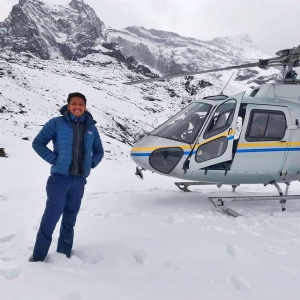
Dipendra Phuyal
I, Dipendra is an Adventure Specialist and founder of Scenic Nepal Treks and working in Mountain Travel and Tourism for more than a decade.
I have been leading different Hiking groups from all around the World to the Himalayas including Everest Base Camp, Annapurna Base Camp, and many more. Follow me for my adventure on Facebook and Instagram
Send us a message
Recent posts.
- Everest Base Camp Trek Guide: Ultimate Tips for a Successful Adventure
- Top Three Adventure Holidays in Nepal in 2024 | Best Deals Guaranteed
- Best time of the year to trek in Nepal
- How hard is to trek to Everest Base Camp ?
- The Best Non-Technical Peak in Nepal for Beginner Climbers
- Walk In The Shadow Of Verdant Hills And Towering Mountains To Everest Base Camp
- Uncategorized

Want a tailor-made trip?
Your trip, your way, your budget, your time, your activities, planned by an expert.
We use cookies to ensure that we give you the best experience on our website.

Manaslu Trek Map: Navigate any path Like a Pro with Insider Tips
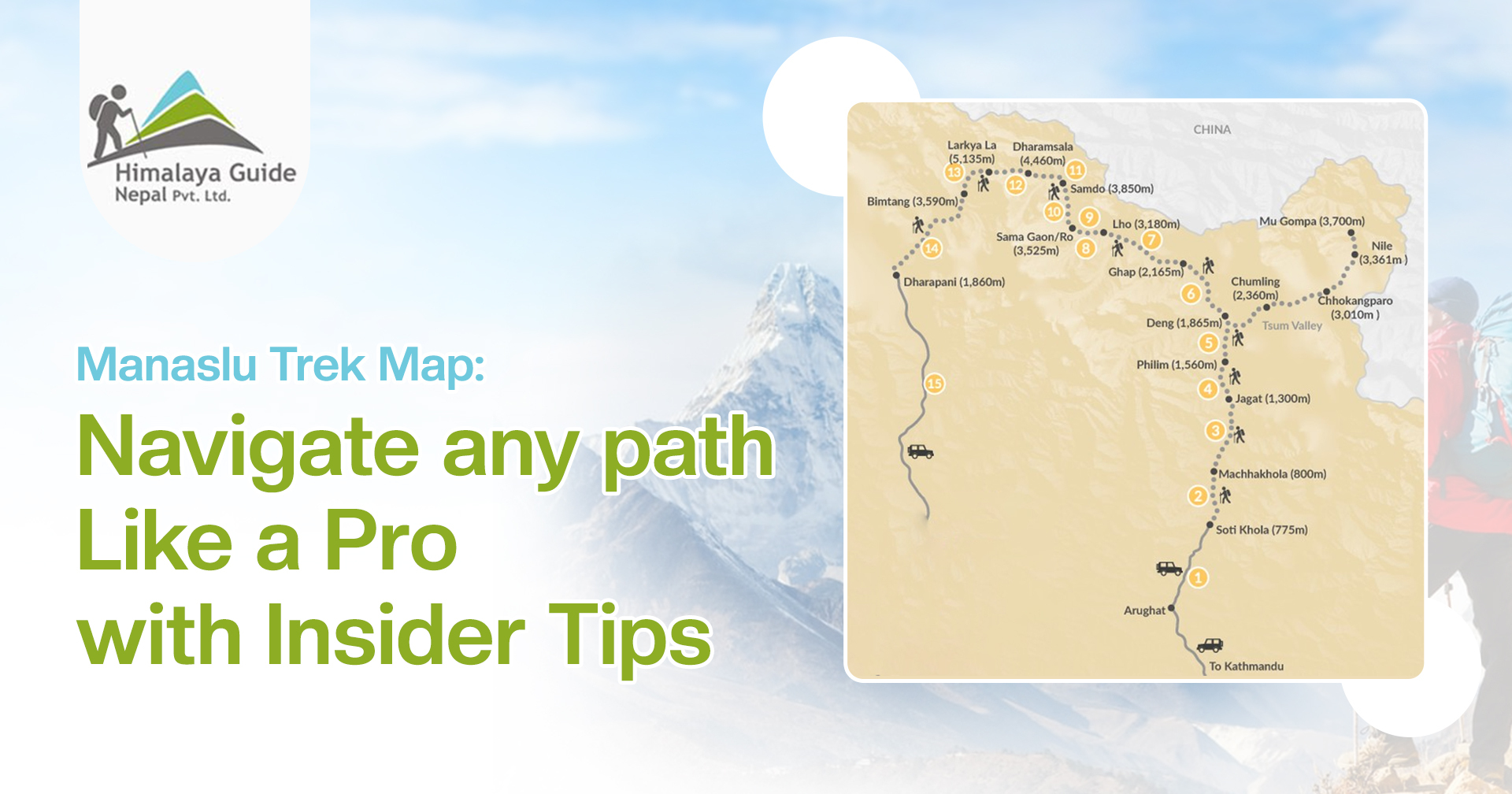
10 Jan 2024 Chandra Gurung
Zoom in with your fingertips! What comes to mind when you want to navigate the Manaslu Trek with the map at your convenience?
Manaslu Trek Map and an experienced guide, right? Here, our team not only gives you access to a handy map but blends your exploration with technology just to make your adventure an ever-recalling one.
Walking to the sun-kissed glaciers, the Ultimate Manaslu Trek Map aids your navigation process. Are you ready to check switchbacks and investigate your route with our Trek map?
Table of Contents
Understanding the Manaslu Trekking Map
Manaslu Circuit Trekking is a 177-kilometer route embedded in Nepal’s Himalayan trail. The rugged landscapes do push you to go beyond the personal challenges and stroll through the water sources and serene sanctuaries.
The journey is all about knowing the essential navigation tools, elevation gains, and keeping your feet active. Throughout the challenging Manaslu Circuit Trek days, you traverse a remote wilderness in the Himalayas.
Things get tough when the crisp air starts getting thinner. But you can avoid detours and safely integrate into the rhythms of mountain footprints with our Manaslu Circuit Trek Map.
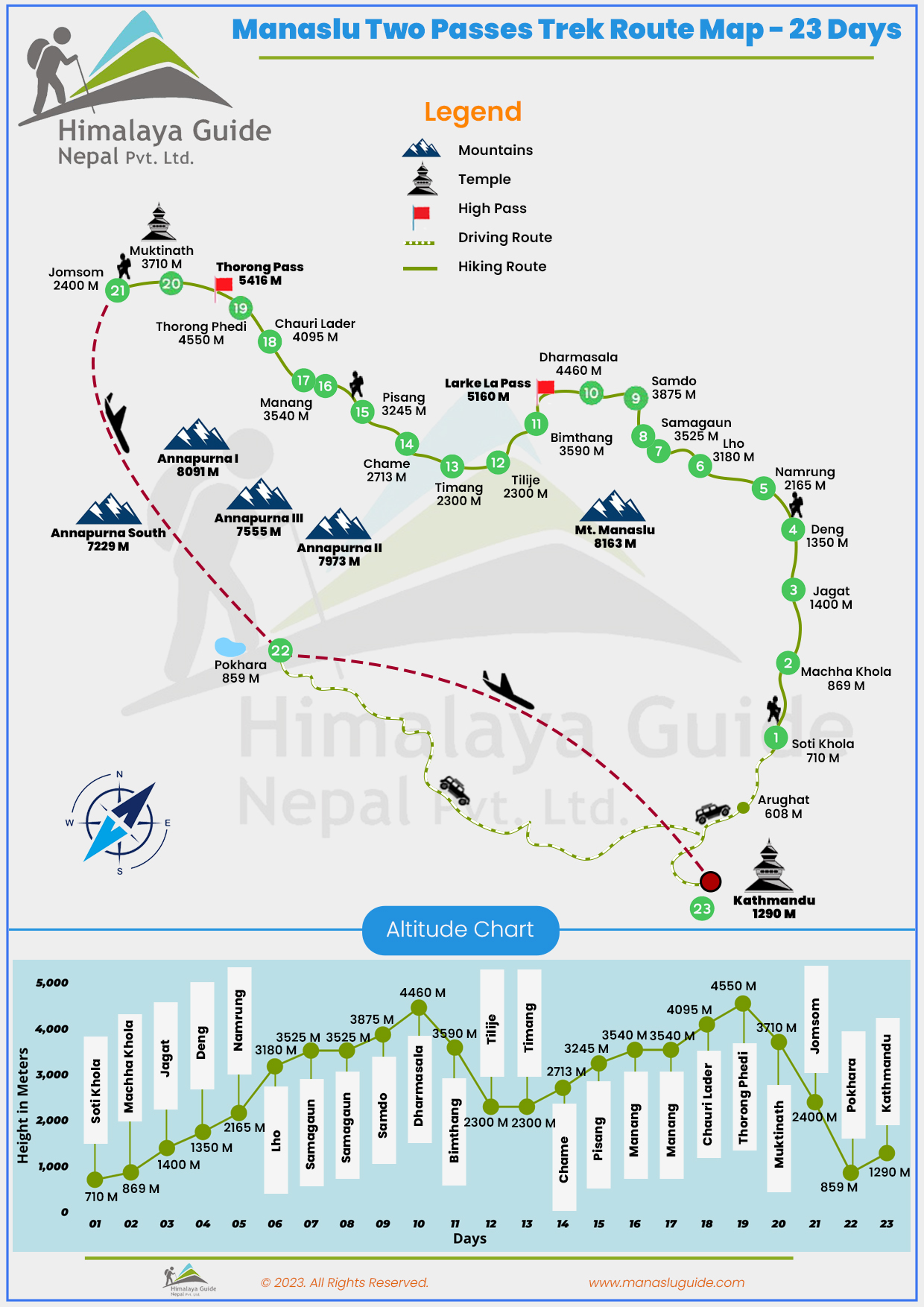
The Manaslu experience transcends mere navigation. Here is to embracing the challenge, conquering miles of thrills and excitement, and rushing to meet the boundless horizon on the Manaslu expedition .
More than just a Trekking Map
More than just footsteps, the allure of venturing off-beaten paths and rustic landscapes is something else. As your lungs are just being introduced to the crisp mountain air, you gain the spirit of evaluation and merely understand the story of each switchback.
Towards the destination, you can form friendships, share stories, and embark on an unforgettable adventure utilizing the information on the map. You can now explore the secluded valleys with our trekking maps at your fingertips when you browse free, downloadable trekking maps on our website.
Do you know? GPS devices have just revolutionized the navigation process. The whole concept of wandering in a new place and avoiding failure in trekking is safer these days. What we suggest is to navigate the wilderness with caution. For that, we also introduced our Trekking Map, which keeps you safe from potential hazards in the lap of the Himalayas.
Why use the Manaslu Trek Map in day-to-day navigation?
Manaslu circuit days are not complete without the map. It is because the map is truly a comprehensive guide that helps you understand the terrain and pre-plan the entire journey.
The map helps trekkers ascend and descend safely in the unpredictable circumstances on the route. Even crossing the suspension bridge of the Budhi Gandaki River and tracking the dense rhododendron forests in the Manaslu Conservation Area has become more convenient.
The valuable insights from the Manaslu Trek map helps you tackle potential hazards and challenges in the Manaslu region. Besides, it is responsible for making your trekking activities more manageable on forested sections and steep climbs.
With navigation tools like trekking maps and compasses, one can conquer high-altitude passes, like the Larkya Pass. Loose scree slopes and steep drop-offs can be life-threatening when you lack impromptu guidance. So, better avoid the slippery trails and easily navigate the avalanches and safe side , when you can access a detailed Trekking Map right in your hand.
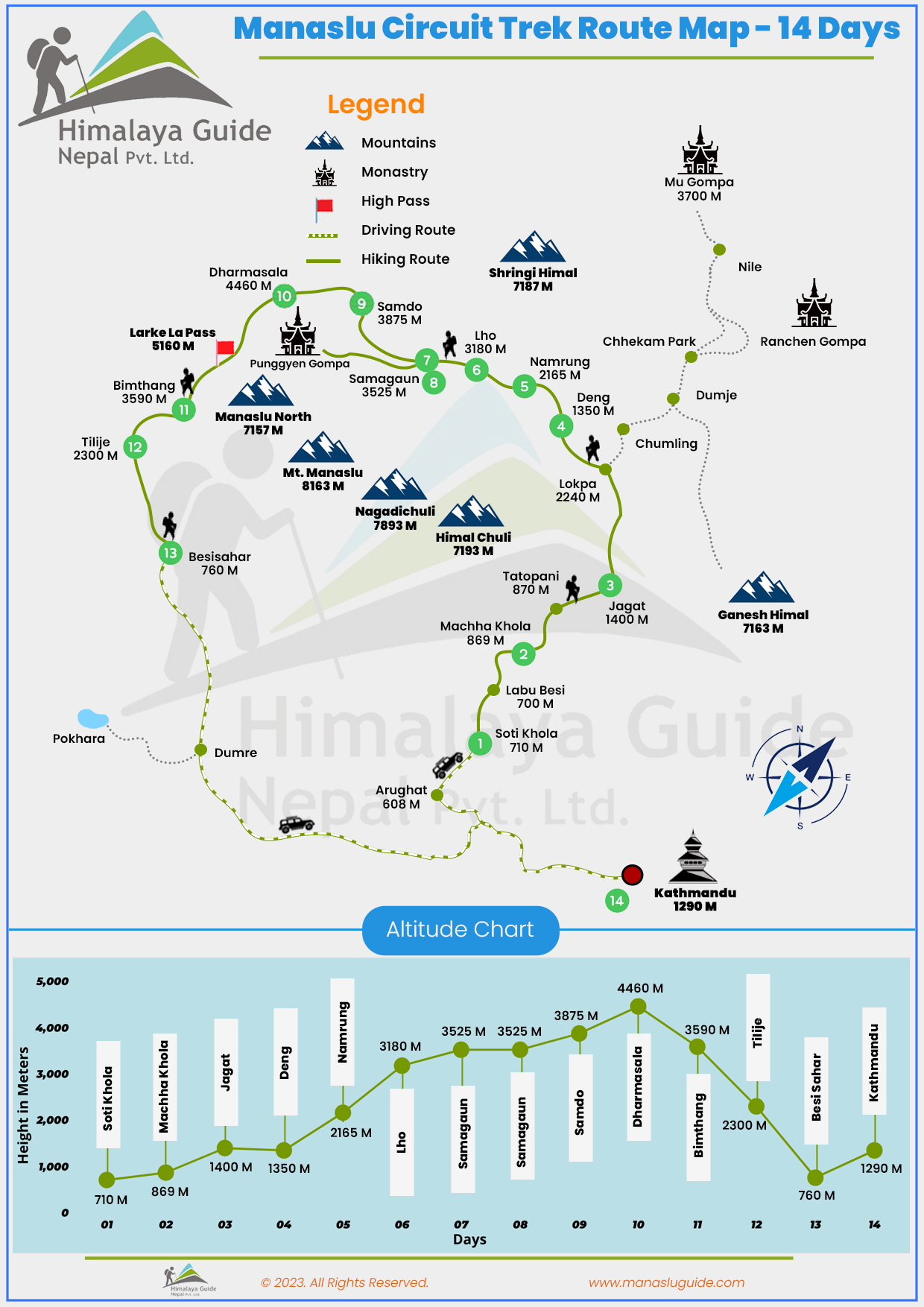
Benefits of the Manaslu Trekking Map
You can nail the trip when you have the map to the most awaited adventure. Beyond the waves of the meadows, you can embrace the symphony of nature. Your efforts to conquer glaciers can simply triumph as we have your back. Fear not, as we present a tailored trekking map for your Manaslu adventure.
Confidence in trekking
Whenever you have a digital map, you can simply zoom in and navigate the trail’s ups and downs. You get confidence in choosing the right path and trails, identifying the potential risks and alternatives of the rocky ascents, and hidden shortcuts, and thereby, unlock a whole new adventure with confidence.
Navigate safely
Mountains can get unpredictable, it is when the trekking map comes to the rescue. It gives you an advantage to navigate safely in the wildflowers, secluded trails, and breathtaking gorges. Simply, it helps you track the avalanches and risk aspects and move past them to enjoy a ruthless experience on the rustic Himalayan trail.
Pre-trek planning
If you visualize the entire journey with a virtual map, you can get an idea of the overall distance, elevation gains, and landmarks. By identifying what your realistic daily trek will be like, you can trace your stops and destinations based on the map’s information. So, go searching for the Manaslu trekking map that just interprets your whole journey.
Adhere to Guidebook
When you have the Manaslu Circuit trek map in your hands, you can understand what is truly planned in your guidebook. The map introduces you to challenges, additional information on history, landmark descriptions, and cultural insights into the Manaslu region. And if you take our Manaslu guidebook along with the map, you can protect yourself from unexpected detours.
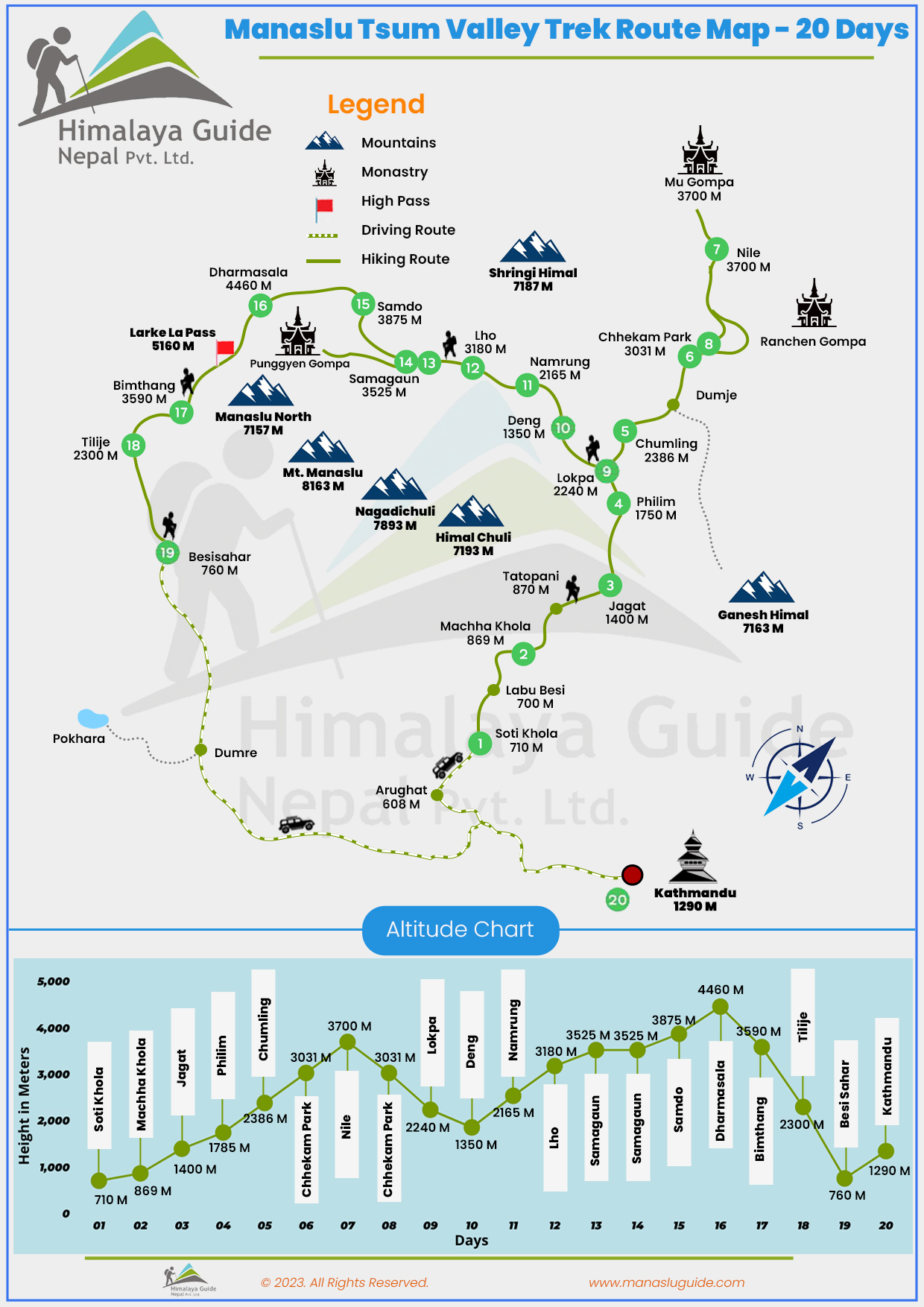
Navigating Manaslu: Essential Maps and Backup Options
You need to choose the right tools just before your Manaslu Circuit Trek begins. Incorporating maps, compasses, and a blend of technology is important for you to navigate Manaslu with confidence. So, what are the essentials of a map?
Scale and coverage
Whenever considering choosing a Manaslu Circuit Trek map, you need to see if that particular route covers your entire route. An in-depth and broader overview of the landscape is required to explore the Manaslu trek.
Readability
Easy-to-read text and symbols are something you ought to look at on the Manaslu Trekking map. For effortless interpretation of the Maps, it must contain all the essential guiding tactics and must possess clarity in instructions regarding the trek coverage.
Reliability
A map can be a reliable companion to understand the elevation, markings, clear symbols, and the journey elements in brief. The Manaslu Trek Map also incorporates side trails and alternative routes which makes it convenient to accurately pinpoint steep climbs, switchbacks, and elevation markings.
Guide Practically
A map with practical guidance is among the choices of users. It shall comprehend the examples, clear symbols, and visual diagrams making the study easier. When all these essential criteria are met, the comprehensive navigation facilitates planning and even responds to some unprecedented changes in your adventurous trail.
Emergency Backups
Maps and compasses are effective navigation tools, however, their limitations cannot be denied. Digital Maps are reliable only when you have a personalized emergency backup, waterproof GPS, and offline recording options which makes navigation possible in extreme climatic situations.
Conclusion
Adventure often awaits those who swing for the thrill, take on challenges, and navigate their way safely. Every step towards the Manaslu Circuit adventure can now be mapped. Campsites, teahouses, and ancient monasteries their precise location is updated on the map. Your next stop is merely beautiful and safe when you know exactly what you want in your trekking avenue.
Just before you precisely plan the trekking routes have a look at a map that guides you to the raw beauty and vibrant festivals of Manaslu. Better not get confused on what you ought to do and skip on passing through the off-beaten trails, and approaching a step closer to the viewpoint of killer mountain, Mt Manaslu.
Even when you have a trusted trekking guide , navigation can be challenging. The more precise the Manaslu Trek map is about the twists and turns of the routes, the more reliable it is to keep you safe.

Manaslu Circuit Trek - ULTIMATE GUIDE 2024-2025
- Last Updated on Nov 16, 2023
One of Nepal's most challenging and well-known off-the-beaten-path treks is the Manaslu Circuit Trek. The walk is most notable for the breathtaking views of multiple snow-capped peaks, notably Mt. Manaslu, the eighth-highest summit in the world (8,163m/26,781ft). In addition, the walk offers untouched nature, biological richness, traditional culture, unexplored pathways, a sweeping panorama, and unmatched beauty in the naturally endowed area. While trekking in the wild Manaslu region, one can feel great excitement. The walk has a lot more to offer enthusiastic and daring hikers. You must attempt the Manaslu Trek at least once in your lifetime to enjoy the peaceful walking trails, unspoiled natural beauty, and ecological balance.
The Annapurna region, Nepal's other well-known trekking zone, shares land with the entire Manaslu region. This makes the Manaslu region diversified and allows for the simultaneously creating of the Manaslu and Annapurna Circuit Trail. The Throng La Pass (5416M/17769Ft) is reached on this Annapurna trail before it descends to Muktinath or continues to the Upper Mustang Trail. Trekkers can discover the diverse native cultures and customs, the diverse flora, animals, monasteries, and the high Himalayas blanketed in snow. Spending a few more days will let you visit two well-known hiking locations on a budget.
Since hiking has just been allowed in the Manaslu region, this journey is ideal for physically fit people who enjoy being alone on the trails. Individual trekkers are still prohibited from entering several restricted areas without authorized guides registered with the government. There are still many untrodden and unknown hiking paths in this area. Trekking through the hidden valley is a genuinely daring and proud experience.
Table of Contents

Manaslu Tsum Valley Trek with Ganesh Himal Base Camp

Manaslu Circuit Trek

Manaslu Base Camp Trek with Larkya pass
Why trek to manaslu circuit .
The route leads you from the humid lowlands with their terraced fields of rice and millet through the massive gorges of the Budi Gandaki, which are home to stunning waterfalls and turquoise-colored waters. The Manaslu climb has suspension bridges unmatched in length and height, and the yearly monsoon frequently washes away smaller bridges, forcing hikers to use partially submerged boulders.
This walk still has the air of a pioneering expedition even though it was only made available to 400 trekkers at a time in 1992. The Manaslu circuit trek is a visual feast from beginning to end if you want to experience trekking in the 1980s, but you better be in shape. You make your way slowly northward to the snow-covered Larkya La Pass, close to the Tibetan border. The breathtaking views of Manaslu almost make up for the difficulties with the altitude here. Larkya La pass, at 5167 meters, is typically covered with snow and slippery. On the descent, micro crampons are frequently utilized. To reach the pass's highest peak before the winds arrive, which often come around mid-morning, a 3 am start is necessary.
While it is possible to see clearly from the pass in the direction you have come from, the most breathtaking view is seen after leaving the key and proceeding along a corridor to the west. A massive glacial cirque suddenly appears. While Annapurna II rises in front, a magnificent wall formed by Cheo Himal, Himlung Himal, Nemjung, Gyaji Kang, and Kang Guru pours down a stream of glaciers. The journey is worthwhile just for this vista. Your 15-day, all-inclusive trek can be organized with Magical Nepal. Unless you wish to deviate from the path, when camping is the sole option, the walk can be completed using teahouses.
Highlights of Manaslu Circuit Trek
- Compared to the Annapurna Circuit and Everest Base Camp, this circuit is significantly less congested. Although it is becoming more well-known, now is a perfect time to travel this circuit before it becomes more widely accepted.
- Even though the walk is wild and inaccessible, there are teahouses at every stop, so hikers don't need to pack food and tents, making it more accessible and less expensive than other treks of a similar length.
- Since there is no need for domestic aircraft, the trailhead can be reached on foot. ∙ You will pass through a subtropical jungle at lower levels before reaching the Himalayan foothills, and the panorama is constantly changing. Finally, at over 5,100 meters (17,000 feet), you will arrive at Larkya La.
- The first few days of the circuit include many suspension bridge crossings along the riverside walk in the Budi Gandaki, a deep gorge. The last few days of the walk are spent in the snow, but you may still hike in standard hiking boots while admiring the enormous snow-capped mountains on each side of the trail.
Manaslu Circuit Trekking Route
The mild hike of the Manaslu trip leads to a challenging climb. Due to its isolation and stringent trekking requirements, the Manaslu region is regarded as off the beaten path. Special permission is required for trekkers, which can only be obtained through a licensed trekking agency with a minimum of two trekkers and a local registered guide. Most of the Manaslu journey begins with a bus or jeep ride from Kathmandu to SotiKhola, where you can spend the night before starting your hike.
The Manaslu region lacks any further transportation options or airports. Starting your trek on a lowland trail will allow you to experience the variety. It will be a challenging journey to hike through the settlement and the forest. You can reach Samagaun by seeing many monasteries and chortens. On the Manaslu trail, Samagaun is a well-liked stopover that is also utilized for acclimatization before ascending the mountain. Fewer hikers dare to travel to the area despite the Manaslu trail's fame. The Manaslu trail requires special permission, which can only be obtained from a local, authorized trekking service in Nepal, and is subject to tight guidelines for trekkers.
The Manaslu region attracts few trekkers, yet because the trail is uncrowded and nature is healthy and balanced, it is in high demand. The villagers and the soldiers maintain the tracks, which are flawless and spotless. You can reach the highest point on your trek, 5100 meters above sea level, for the Larkey La Pass and descend to Jagat. You can take a car from Jagat and return to Kathmandu through Beshisahar, the administrative center for the Lamjung district. Alternatively, if time allows, you could hike the Annapurna Circuit. This will take an additional 5–6 days. Due to the proximity of the Manaslu and Annapurna regions, trekkers can complete both treks quickly.

Best Time to visit Manaslu Circuit Trek
The best times of year to visit Manaslu Circuit and Tsum Valley are considered to be autumn and spring. While spring comes before the monsoon, autumn comes after it. Although challenging, it doesn't imply that other seasons aren't appropriate.
Spring: Because of the great weather, spring is one of the best times to go hiking (late February to early June). Rhododendron flowers in bloom also adorn the forests. However, the road may still have some snow from the winter season on it.
Monsoon: Early June through late August is the monsoon season, which is wet. So, expect to encounter light to heavy rain throughout the way. Along with making the trail muddy, it might get your belongings damp. Additionally, the sky becomes hazy, obstructing all sights.
Autumn: The ideal time to trek in Manaslu is during the autumn (late August to late November). The sky is unclouded and peaceful. Like always, the vista is breathtaking.
Winter (late November to late February): Generally, higher elevations have colder temperatures all year round. However, it gets even more complex throughout the winter. The view, however, improves, and the sky is clear. However, the trail will be blocked until spring if it begins to snow.
Manaslu Circuit Trek Difficulty
The Manaslu trek is moderate to difficult in terms of difficulty. It isn't regarded as being the hardest. However, the trail's constant ascent and descent might push your limits and stamina. Trekking in the Manaslu region is both physically and mentally taxing. For those who enjoy adventure, it is ideal. A regular hiker could complete it without any problems.
However, it might be a challenging walk for newcomers. For the excursion, you might need to get ready. Before you embark on the walk, start working out and jogging. Additionally, the difficulty might vary depending on your physical condition, the weight you carry, the trail's condition (such as snow), your gear and equipment for hiking , your acclimatization process, the food you choose, and other considerations.
Due to its isolation, diversified nature, Himalayan culture and customs , magnificent rivers, breathtaking snow-covered Himalayas, and rugged Larkey La Pass , the Manaslu Circuit Trek is an adventure tour in the Himalayas. In addition, the distance of the walk, the weather during the trekking season, and altitude all have a significant role in determining the difficulty of the Manaslu Circuit Trek.

The Manaslu Circuit Trek involves around 177 kilometers of walking. This distance needs to be covered in 12 days; however, depending on your pace, you may need to go faster or slower. Your adventure begins at Larkey La Pass, where the elevation ranges from 930 to 5100 meters. As a result, you must travel 13 to 15 kilometers each day. The Manaslu Circuit Trek ranges from simple to moderately complex at higher altitudes. Therefore, before you begin your walk, ensure you are in shape enough to hike uphill daily.
Food and Accommodation in Manaslu Circuit Trek
Due to the limited food selection available when trekking the Manaslu Circuit, typical Nepali cuisine Dal Bhat Tarkari will be served. There aren't as many teahouses and dining options to pick from in Everest Region. Because fewer people visit the area as tourists than in the Everest Region .
You will be greeted upon arrival in Kathmandu , picked up, and then taken to a hotel. In Kathmandu, you stay in a hotel. In Kathmandu, there are many different kinds of hotels. There are 5-star homestay levels accessible for overnight stays. However, we typically offer 3-star accommodation with complimentary breakfast.
For foreign trekkers, Manaslu is off-limits. Due to its boundary with the Autonomous area of Tibet, there are strict regulations regarding entry into the Manaslu region. For the Manaslu circuit trip, a special permit is required. Manaslu Circuit Trail is an off-the-beaten trail because of its isolation, difficulty, and tight requirements. This trail is rarely used by hikers, making it more alone and less congested.
Furthermore, most people in this area are of Tibetan descent and practice Tibetan culture, customs, and religion. There are stunning monasteries, chortens, mani walls, etc., as well as less crowded communities. Manaslu Circuit Trek has a small number of lodges and tea shops. There will undoubtedly be fewer lodgings and amenities as you ascend the mountain. However, every resort at a higher altitude adheres to tourism requirements and is primarily run by local families.
Manaslu Circuit Trek outline Itinerary 2024-2025
Day 1:Arrive in Kathmandu
Day 2:Manaslu Restricted area preparation and briefing of Trek
Day 3:Drive to Soti Khola
Day 4:Trek Soti Khola to Machha Khola (869m)
Day 5:Machha Khola to Jagat (1410m)
Day 6:Jagat to Deng (1860m)
Day 7:Deng to Namrung (2630m)
Day 8:Namrung to Lho Gham (3180m)
Day 9:Lho Gham to Samagaon (3520m)
Day 10:Samagaon (rest day) Trek to Manaslu Base Camp or Pungyen Gompa and Birendra Tal.
Day 11:Samagaon to Samdo (3875m)
Day 12:Samdo to Larkya Phedi (4460m)
Day 13:Larkya Phedi to Bimthang (3590m) – climb the Larkya La (5160m)
Day 14:Bimthang to Tilje (2300m)
Day 15:Tilje – Chamche (1430m)
Day 16:Sharing Jeep drive to Beshisahar and Public Bus back to the capital
Day 17:Depart Kathmandu
Manaslu Circuit Trek Cost 2024-2025
The price of a Manaslu circuit trek varies depending on when and how you hike. Trekking in peak season will cost you a lot, and you'll need to pack your kit according to the conditions. The way you trek, the agency you select, the gear you bring, the length of the walk, etc., impact how much the circuit trek will cost. In addition, the final cost amount is affected by your attitude toward spending while on the walk. Making specific inquiries with the agency is the best approach to learning the pricing because the amount an agency charges you for the voyage varies for various reasons.
The peak months are March through May and September through November, with October hectic . As a result, the price you might pay at this Time is undoubtedly more significant than it would be for trekking during the off-season. You might want to think about the difficulty of trekking in other months, though. In the highlands, a few teahouses are closed from December to February. Although it's not tricky, trekking in the cold will need you to endure many hardships. In some places, you must navigate across icy sections, and the weather significantly impacts mobility. Also, remember that going on a winter trip necessitates purchasing winter-specific equipment, which could raise your overall gear cost, which, if not managed effectively, could be higher than going on a trek in another season.
Utilizing an international trekking service will increase your cost because more intermediaries will be involved in the payment process. Using a local trekking firm is essential if you want to manage your Manaslu circuit trek. You cannot complete this walk alone because the government has designated several areas in the Manaslu region as restricted. You must be trekking with a party of at least two people, and a porter guide or qualified guide must be with you at all times. Similarly to this, the fee increases with the length of the walk. But be careful not to let your desire to control costs ruin your trek carefully.
You may also need to spend some amount on other things, like on the trek.
Other Manaslu Trek Costs are:
- Manaslu trek packing list
- Electronic Charging Cost
- Hot Shower
- Tips and Donations
- Renting and Buying clothing and gear
- Gifts and Souvenirs
Manaslu Circuit Group Join Trek 2024-2025
One of Nepal's top tea house trekking routes is the Manaslu Circuit Group Join Trek. This journey is a well-known detour from the traditional Annapurna Circuit Trek . Manaslu Circuit Group Join Trek circuits in the Manaslu Mountain Range, which includes Mt. Manaslu (8156m), the eighth-highest mountain on Earth.
Because individual and solitary trekkers are not permitted in the Manaslu Circuit and Manaslu region, group join treks are crucial. However, many trekkers choose to complete this trek after arriving in Nepal. If you prefer to take on this journey alone, you can split the cost of the guides, porters, lodging, and trekking permits. Therefore, the Manaslu Circuit Group Join trek will be more affordable and enjoyable.
Manaslu Circuit Group Join Trek offers the chance to examine the distinctive nature, gorgeous mountain vistas, local peoples' culture, and way of life. The Manaslu circle walking track has beautiful plants and animals.
Requires Permit for Manaslu Circuit Trek
The Manaslu Circuit Trek is located in the region's restricted area . To enter the Manaslu region, trekkers require special permits. The price of your Manaslu Trek permit will vary according to how many days and months you visit this area. You will pass through the Manaslu region and the Annapurna region, two districts. Manaslu Circuit Trek requires three mandatory permits. The following are needed tickets for Manaslu Circuit Trek:
- Special Restricted Area Permit for Manaslu
- Manaslu Conservation Area Permit
- Annapurna Conservation Area Permit
- Trekkers' Information Management System Permit
- In addition, separate permission is required if you intend to undertake a side hike to Tsum Valley.
Guide & Porter on Manaslu Tsum valley Trek
Trekking in the Manaslu region is challenging. However, you can travel the most well-known trekking route in the world with the help of skilled team members, wholesome food and drink, relaxation, and acclimatization. As usual, the porter helps you transport your belongings. Most tour guides are knowledgeable, seasoned professionals who can quickly speak English. Remember that the director and porter are counting on receiving generous gratuities from you at the end of the trip. These people put in a ton of effort and try their best to get you and your crew to your destinations in the challenging hilly terrain.
For the Manaslu Circuit Trek, a guide is a necessity. It will help if you abode by the law since it is one that the government has imposed. Lone hikers cannot complete the walk unless they are part of a group with at least two other hikers and an experienced guide. That implies that you must also pay the Manaslu trek guide fee.
Altitude Sickness in Manaslu Circuit Trek
Of course! As you will be more than 5,000 meters above sea level, you should be concerned about altitude sickness . Altitude sickness is a common occurrence on the Manaslu trek. But there are several ways to stop it. You must first be aware of the signs of altitude sickness. Keep in mind that it might range from being normal to being critical. Among them are headaches, loss of appetite, shortness of breath, exhaustion, dizziness, and other symptoms. If your situation is urgent, you must be saved.
Altitude sickness can be avoided using a variety of treatments. First, always have a healthy diet and eat appropriately. Keep yourself hydrated at all times. Don't drink alcohol when you're higher up. Instead, slowly increase your speed as you ascend. Relax, and mentally get ready for the difficulties.
Physical Fitness For Manaslu Circuit Trek
It is unavoidably exhausting to complete a thirteen-day journey in a row, and it is unquestionably advantageous to be in shape. Remember that you exercise daily while on the trek, so you will emerge fantastically mountain-fit and weathered! Come back many kilos lighter, toned, healthy, and detoxified!
Please do plenty of walking with a day pack to prepare in advance, but don't overdo it. Although it isn't a marathon, there are plenty of hills to climb and descend! The high pass is also somewhat tricky. Carrying the bag, which weighs only about 5 kg but seems like 10 when walking uphill in the heat, works your thighs, calves, and shoulders. The days aren't too long, the route is good, and the porters are pretty helpful, but you'll appreciate this trip a lot more if you've worked on your fitness before the trip.
The pace of the walk is always leisurely, and days are typically shorter than day hikes back home. This weight is appropriate to work with because you probably carry 5 kilos in your day bag. If you're going to the gym, focus on the step machines, which strengthen the thighs and calves, and try to raise your heart rate to 50% over resting level.
Any cardiovascular exercise is beneficial, but swimming won't develop the right muscle groups. Thus it needs to be combined with other activities for maximum benefit. Body pump, Pilates, and aerobic exercise classes are all great options for preparing for a hike like this, especially ones focusing on core strength, stability, and balance.
Lightweight hiking boots with a high ankle are advised to prevent you from falling down on your ankle during the walk. Heavy footwear would be uncomfortable and heavy. Popular yet chilly in the morning are cross trainers.
Packing List for Manaslu Circuit Trek 2024-2025
The provided list comprises a comprehensive packing list for a Manaslu Circuit Trek to prevent unnecessary complications. It is a list that is advised. You are welcome to alter it to suit your preferences and needs.

- Sunhat
- Underwear
- Sports Bra
- Baselayer
- Trekking shirt
- Fleece Jacket
- Outer Jacket
- Rain jacket
- Trekking trousers and shorts
- Hand and Feet Wear
- Inner Gloves
- Outer Gloves
- Hiking socks
- Thermal socks
- Hiking boots
- Trainers or trekking sandals
- Gaiters
- Duffle bag
- Backpack
- Backpack cover
- A sturdy dry bag
- Sleeping bag
- Sleeping bag liner
- Trekking Poles
- Headlamp
- Crampons
- Microspikes
- Water bottle or Hydration Bladder Technology and others
- Camera
- Portable Charger
- Books
- Money
- Documents
- Passport
- Insurance
- Medication
- First aid kit
- Water purification tablets
- Isotonic Powder
- Toiletries
- Quick-drying towels
- Pee funnel
- Wet wipes, tissues, and hand sanitizer ∙ Lip Balm
- Tissue /toilet roll
- Deodorants
- Nail clippers
- Face and body moisturizer
- Foot powder
- Female hygiene products
- Small mirror
For more Update Follow Us on:
- Latest Update

Dipak Pande
Dipak starts to step up from porter, guide, and trekking leader to the company owner. Sometimes he share his experience with others as well as wrote in local travel news. Most of time he spend his time on mountain and his company.
Drop a message
Recent posts.
- What is the Best Wifi or Data on Trekking in Nepal ?
- What Kind of Electrical Plug Needed in Nepal?
- Trekking to Everest Base Camp vs Annapurna Base Camp: Which one is best?
- What are require training or Fitness for High Altitude trek in Nepal?
- Know before ABC Trek Food, Drinks and Lodges
- Everest Base Camp Trek on Christmas and New Year 2024-2025
Related Posts
- Early Bird Booking or Low Deposit Holidays in Nepal
- Shamanism Tour in Nepal - Spiritual and Meditation
- Why Manaslu known as a killer mountain in Nepal?
- Everest Trek Guide
- Latest News and Update
- Map and Itinerary
- Nepal Trekking Cost
- Peak Climbing
- Tour in Nepal
- Trekking in Nepal
We use cookies to ensure that we give you the best experience on our website.

Manaslu Circuit Trek
- Duration 14 Days
- Trip Grade Moderate
- Destination Nepal
- Start at Kathmandu
- End at Kathmandu
- Max. Altitude 5160 m
- Max. Group Size 2+
- Nature of Trip Manaslu Trek
- Best Month March, April, May, Sept, Oct, Nov
What To Expect
- Get the experience of very remote area trekking
- Uncover the cultures of ethnic people
- Go ahead through the beautiful forest by crossing the rivers
- Take photographs of wild animals
- Circle the eighth of the world's highest mountain
- Explore the very nearer live views of Manaslu, Annapurna, and the other Himalayas
- Take a snapshot of the surroundings from the Larke Pass
Manaslu circuit trek in Nepal is strenuous physically, enriching culturally, and beautiful scenically.
70+ Trip Advisor Reviews
Manaslu is the most renowned teahouse trekking in the off-the-beaten trail in Nepal compared to other destinations. It is a classic trek that presents the world’s eighth-highest mountain panorama along with ethnic culture, Buddhist architecture, and beautiful epic sceneries including wildlife.
The word Manaslu is derived from the Sanskrit word Manasa, meaning meaning "intellect" or "soul". Also, it is known by the name "mountain of the spirit". Trekking to Manaslu in Nepal remained restricted for a long time and opened recently in 1992 to non-natives. It lies in the border region between Nepal and Tibet. It's a less-traded Himalayan trekking zone and is listed as one of the most stylish trekking packages in Nepal trekking.
Manaslu is a Conservation Area that was declared in 1998 by the Nepal government. It preserves the entire Manaslu region. Manaslu conservation area is home to different species and floras. It covers 1,663 square kilometers in the Mansiri Himal range of the Himalayas. It is located in the Gorkha district of Nepal.
However, Mt. Manaslu Circuit Trek in Nepal is gaining popularity day by day due to its charming and untouched naturally beautiful spirit. Most of the trekking agencies are also promoting this destination nowadays as it is the less-explored trekking sector in Nepal. It offers great mountain sceneries and ultimate adventure knowledge. Mount. Manaslu, Annapurna II, Cheo Himal, Ganesh Himal, Kang Guru, and other glaciers are the major attractions of the Manaslu circuit in Nepal.

Manaslu round trek is a kind of adventure trekking in the Himalayan region of Nepal. It offers beautiful views of Mt. Manaslu and other peaks. The ethnic culture and tradition are awesome.

Crossing the precarious suspension bridges in many places is another distinctive experience. These are wooden bridges used for crossing rivers in the ancient period.
Likewise, the beautiful cascades on the way also make your touring trail fascinating. You get the opportunity to click the photos of captivating flora and fauna against the backdrop of natural scenery.
Besides, the few settlements located in the far distance are another special feature of the Manaslu Circuit Trek. Nature allows you to walk with it in peace and calm.
Manaslu circuit trek 2023/2024 is graded under the challenging trekking in Nepal. So, the previous trekking or hiking experience may benefit novice trekkers.
The Manaslu circuit trek of Nepal begins after a scenic drive from Kathmandu, the capital city of Nepal to the Manaslu region. A trek goes through the Budhi Gandaki River at the beginning and the Marshyangdi River at the end.
The vistas of Cheo Himal, Kang Guru, Manaslu, Annapurna, Himlung Himal, and further mountain fascination are stirring.
Similarly, heading through the Deng, Namrung, Sama Gaun, Samdo, and colorful towns lets, you cross the loftiest pass of the trekking- Larke La Pass. It is situated at an elevation of 5,160 meters above sea level.
In the same way, ethnical communities are rich in culture and traditions. Their customs are remarkable. You get astounded to visit those isolated villages and explore the conditioning of the original people.
After descending from Larkya La Pass, the journey encounters the Annapurna Circuit trek route. It is Tilije, the final destination of your trekking where you can see the nearer views of Manaslu as well as other mountains and glaciers. Then, your journey leads you to go back.

Although, our Manaslu trek itinerary is formally long. We can make it a bit longer and more audacious by joining this trip with the Annapurna Circuit Trekking trail. For further details, you can go through the Manaslu Annapurna trek route.
Adding a Tsum Valley trek within the same itinerary would be more beneficial. You can learn more about Tsum inhabitants of the Manaslu region through the Manaslu Circuit and Tsum Valley trek. Or we can cut off some days and customize the short Manaslu circuit trek as per your requirements.
Likewise, a day hike to Pungyen Gompa on acclimatization day is a rare experience that offers awful views of the surroundings. Although you see the beautiful scripts of the Himalayan ranges from the utmost of the places during this Manaslu circuit trek of 14 days.
Rising Adventure Pvt. Ltd. is a platoon of educated Himalayan leaders. We organize the Manaslu circuit treks in Nepal with our expert team and excellent services. Please, communicate with us for further details.
Note: As you know, the Manaslu region is considered a restricted area in Nepal. So, we need to present your original passport in order to get an MCAP (Manaslu Conservation Area Permit). So, one day must be reserved for getting Permit cards before your trip starting day. Once you provide your passport, our office will manage everything.
Manaslu Circuit Trek Itinerary
Manaslu Round Trek is a kind of adventure trekking in the Himalayan region of Nepal. It offers beautiful views of Mt. Manaslu and other peaks. The ethnic villages and their cultures are awesome. This trail can also be joined with the Annapurna circuit trekking.
The Manaslu Circuit Trek itinerary is a long day trekking trail in the remote area of Nepal. For more information, you can go through our Manaslu Circuit Trek detail itinerary.
Day 1: Arrival in Kathmandu
- Accommodation 3 star Hotel
- Maximum Altitude 1400 m
After your arrival at the Tribhuwan International Airport in Nepal, one of our representatives will pick you up and transfer you to the hotel. Please, find your name card in front of the arrival terminal at the Airpot.
Day 2: Trek Preaparation
- Meals Breakfast
This day is reserved for trek preparation because you are going to the restricted trekking region of Nepal and we need your original passport in order to make the special permit for trekking to Manaslu.
On this day, you can go for sightseeing in Kathmandu.
Day 3: Drive to Machchha Khola (7-8 hrs)
- Accommodation Tea House
- Meals Breakfast, Lunch, Dinner, & Seasonal fruit
- Maximum Altitude 930 m
Today you will have an almost 4-hour drive to Dhadingbesi along the paved road. Then your drive will go up along the rough road and reach Arughat. Then the continuation of your driving will take you to Machachha Khola.
Day 4: Trek to Jagat (6-7 hrs)
- Maximum Altitude 1340 m
Your trail will be continued to Kharlabesi by crossing the Thado Khola. Then the continuation of your trail will take you to Tatopani. It is a natural hot spring where you can swim as well. And you will walk on the suspension bridge after ascending a ridge. Then you will reach Dovan. You will have lunch there. Eventually, you will reach Jagat by ascending and crossing another ridge, Yaru Bagar village, and the suspension bridge respectively. From Jagat, you will visit the ethnic tribes only like Gurung and Tamang up to Gap village.
Day 5: Trek to Deng Khola (6-7 hrs)
- Maximum Altitude 1860 m
Today your trail will go up on the rocky ridge and reach Salleri village. Then you will reach Philim, a large Gurung Village by passing and crossing Sirdibas village and the suspension bridge respectively. From Philim, you will go ahead through the millet fields and walk a slightly upward trail to Chisapani. It is a village where you will have lunch. Then your trail continues to Ekle Bhati and crosses the suspension bridge over the bank of Budhi Gandaki River and takes you to Nyak Phedi. Again, you will walk along the suspension bridge. Then you will find the narrow path which goes through the forests of pine, rhododendron, and bamboo. Finally, you will reach Deng Khola.
Day 6: Trek to Namrung (6-7 hrs)
- Maximum Altitude 2660 m
Today you are going to Namrung Village, a vantage point for looking at the magnificent sceneries of Mt. Siringi. So, obviously, you need to cross the Budhi Gandaki River almost five times. You can find lots of teahouses ranging from lower to higher cost with full facilities.
After having your breakfast, the trek begins again. It goes along the slightly descending trail in the beginning. After crossing the suspension bridge, the ascending walk starts and ends at Bihi Phedi. It is a village, full of tea shops. So, you can have a cup of tea over there, take a rest, and continue the trekking. From there, the trail seems normal like the plain pathway, but you need to walk carefully because the road is narrow and there may be a chance of stonefalls. You can see lots of mules carrying loads. Then trekking takes you to Gap village where you will have lunch. From this village, you will encounter ethnic groups like Lama and Tamang. After eating lunch, your trekking continues. You will see the many mani walls while walking to Prok Phedi. From there, you need to walk up steeply. It is the harder walking time. You will cross the suspension bridges two times, visit the apple farms on the way, and reach Namrung village for spending a night.
Day 7: Trek to Syalla (5-6 hrs)
- Maximum Altitude 3150 m
Your trail will go ahead through the forest area and reach Bhanjan village. From there, you will have almost 30 minutes of ascending walking. Then you will see a big mandala like a welcome gate before barley terraces. It is a Lihi village where you will see a monastery and numerous Chortens. Then the continuation of your walking will take you to Sho village. From this village, you will start to see the views of Mt. Manaslu, Niky Peak, Samdo Peak, Shoula Peak, Himalchuli peak, Nadichuli peak, and others. Then your walking continues through the forests of birch, pine, and juniper; crosses the suspension bridge, and reaches Lho Village. It offers fabulous views of Mt. Manaslu as well as Ribung Gompa. You can have lunch there.
The trail continues along the plain pathways. You can see the monasteries on the way. Then you will cross the suspension bridge again and the descending route starts. You will walk down for almost fifteen minutes. Then the slightly ascending route occurs. You will walk up for approximately one hour and reach Syala Village. After reaching there, you will enjoy the gorgeous sunset views over Mt. Manaslu.
Day 8: Hike to Pungyen Gompa (4-5 hrs exploration) and trek to Sama Gaun (2-3 hrs walk)
- Maximum Altitude 3530 m
Today you will hike to Pungyen Gompa with an elevation of 4400m (approx.) from where you can see the views of Mt. Manaslu, Manaslu North, Himalchuli Peak, Mt. Bouddha, Nadichuli peak, glaciated moraine, so on.
In the morning after having breakfast, your Pungyen gompa hiking begins. It takes almost five hours to reach there. You will walk on the plain route in the beginning and cross the suspension bridges two times. Then you will reach a junction for going to Sama Gaun and the Pungyen Gompa. You will ascend steeply for approximately two hours and reach Pugyen Gompa. Due to the lack of tea houses, you will have a packed lunch over there in front of the beautiful mountain scenery. In addition, you can even explore a Gumba like house for meditation and visit the Lamas as well.
After spending some time over there, you will descend by retracing the previous route to a junction and move ahead towards the Sama Gaun along the forest way. En route, you will see the grazing yaks. You may visit a small government school as well. From there, it takes half an hour to reach Sama Gaun. From this village, you will see the real Tibetans. Many of them still do not have Nepalese citizenship. You can the monasteries and the mani walls there too. You can visit the Birendra lake too which is situated within ten minutes of walking distance from Sama Gaun.
Day 9: Trek to Samdo Village (5-6 hrs)
- Maximum Altitude 3800 m
In the morning after visiting Birendra lake, your trail will go on. It is the shortest walking day compared to other days. You will encounter the route to the Manaslu Base Camp. You will walk along forests of juniper and birch. Then the wooden suspension bridge over the Budhi Gandaki River. Then you will walk ascendingly for half an hour and reach Samdo. En route, you visit the snow landslide area too.
Day 10: Acclimatization Day
This is a day for acclimatization. It reduces the risk of getting high-altitude sickness. You can spend this day roaming around or go for a hike on the border between Nepal and Tibet.
Day 11: Trek to Dharmasala (5-6 hrs)
- Maximum Altitude 4460 m
Today you will walk along the juniper forest. Then you will reach Larke Bazaar. It is a traditional Tibetan bazaar where they used to do shopping at festivals in the ancient period. Then the trail crosses the suspension bridges. The trail goes slightly up and takes you to Dharmasala along the way to the Salka river. En route, you enjoy the views of Larke Glacier, Salka peak, Chiu Peak, Manaslu North, and Larke peak. You will have both lunch and dinner at Dharmasal teahouse.
Day 12: Trek to Bimthang (8-9 hrs) via Larke La Pass (5106 m)
- Maximum Altitude 3890 m
Today, you are going to cross the Larke La Pass over 5000 meters. So, you need to wake up very early in the morning, have breakfast, and begin the journey earlier before the wind comes because the wind causes the stone to fall en route to the pass.
So, you will ascend to the valley at first. It is a beautiful place that offers wonderful views of Cho Danda, Manaslu North, Niky Peak, Cheo Himal, and Larkya Peak. Then you will ascend again across the moraines of the glacier. Then the trail brings you to the last section of Larkya La Pass where you can enjoy closer views of Himlung Himal, Annapurna II, Kangaroo Peak, Pongka Peak, Pongkar glacier, Ponkar lake, and so on. Then you will descend to Phedi village, where you will take a rest and have lunch.
Then your trail goes down across the Pongkar glacier along forests of rhododendron and juniper. Finally, you will reach Bimthang. From there, you will see close-up views of Mt. Manaslu, Manaslu North, Himal Chuli, Bouddha Himal, Himlung Himal, and others.
Day 13: Trek to Dharapani (6-7 hrs)
Today you will enjoy the outstanding views of Mt. Manaslu, Himlung Himal, and Lamjung Himal from the Bimthang Village in the morning. Then you will go down towards the Kharche through the rhododendron forest by crossing the wooden bridge. After that, the continuation of walking will take you to Yak Kharka along the route of the forest. It is a beautiful forest preferable for trekkers. Then your trekking descends continuously and crosses a suspension bridge over the Surki River. Then you will reach Surki Khola village where you are going to have lunch. From there, the easy walking trail starts, though, some ascending trail occurs for a short time. And you will reach Goa Village, where you can visit the apple farms. From there, the roadways start. But it is not a busy road. So, you can walk along there and reachTilije. From there, it takes almost forty-five minutes to reach Dharapani by crossing a wooden bridge.
Day 14: Drive back to Kathmandu
- Accommodation 3 Star Hotel
- Meals Breakfast & Farewell Dinner
From there, you will have a drive to Besishara and then to Kathmandu. It’s a long hour of traveling. On the way, you will enjoy the views of the river, hillside, mountain landscape, and so on.
Not satisfied with this itinerary?
Let's recreate it as per your vacation duration. It just takes a minute.
- International Airport pick-up and drop-off by private vehicle
- Three-night hotel accommodation in Kathmandu with breakfast on twin shared basis
- Bus tickets from Kathmandu to Soti Khola (Trekking starting point)
- Bus tickets from Dharapani (Trekking ending point) to Kathmandu
- Three times meals during trekking in the mountain (Breakfast, Lunch, and Dinner) according to your choice
- Seasonal fruit after/with dinner during the trekking
- Manaslu Conservation Area Permit (MCAP)
- Annapurna Conservation Area Permit (ACAP) because the trekking route touches the Annapurna region
- Trekkers' Information Management System (TIMS) card for trekking
- Restricted area special trekking permit
- Licensed & experienced trekking guide during the trip
- Duffle bag if needed (needs to be returned after completing the trek)
- Water Purifier
- First Aid Kit
- Sport T-shirt of Rising Adventure as a souvenir
- Free co-ordination in case of emergency or rescue operation
- All the necessary paper works
- All the government taxes
- Farewell dinner at one of the typical Nepalese restaurants with a traditional dance
Note: Our guide & porter are fully insured.
- Nepal arrival visa fee
- Travel Insurance
- Alcoholic and nonalcoholic drinks during the trekking
- Chocolate and dessert
- Hot shower, Battery charge, and heater during the trekking
- Tips for guide
- Porter (manageable on request)
- Other expenses which are not mentioned in "Trip Cost Includes"
Things to Know
Mountains that can be seen during the manaslu circuit trek.
Nepal is home to 8 out of the 14 highest peaks in the world. One of the key offerings of traveling to Nepal is to take in the stunning sights of these Himalayan giants. There are numerous reasons to visit Nepal, including its friendly people, obviously spectacular peaks, its cultural heritage sites, and its world-class treks. The biggest offerings of all are perhaps the incredible sights of Himalayan giants such as Mount Everest, Manaslu, Lhotse, Annapurna, Ama Dablam, and Machhapuchhre. Among all of these attractions, today we will be talking about the Manaslu circuit trek.
13 days Manaslu circuit trek treks take you to the world’s eighth highest mountain, beginning in the busy market town of Soti Khola, going up and back along a different path, and ending in Syange. The beautiful and less crowded compared to peers Annapurna Circuit or Everest Base Camp offers wild and wilderness experiences with authentic local culture and people. Not only that during the trails you will able to enjoy the spectacular sights of mountains. Here are some mountains that can be seen from the Manaslu circuit trek;
Mount Manaslu
Mount Manaslu is the eighth-highest mountain in the world. It is obvious that during the trail you will see a giant big peak which is at an altitude of 8,163 meters. The Manaslu name is derived from the Sanskrit word Manasa which refers to the mountain of the Spirit. Each year thousands of people come here just to see the spectacular sights of the snow-capped mountain.
Larkey peak
Another spectacular mountain that you will witness and have to climb during the Manaslu circuit trek is Larkey Peak. The peak is considered to be a challenging peak in Nepal. It is located at the Manaslu Himalayan ranges at a height of 6219 meters or 20398 feet.
While climbing the peak, you will be able to explore the rich culture of the local community of the Manaslu area and the spectacular geography near the Tibetan village. During the Larkey peak climb, you will also have to cross an attractive mountain pass i.e. Larkya la at an elevation of 5200m. The pass is famous as the world’s longest trekking pass which can be done without the use of any climbing gear.
Himlung Himal
Himlung Himal is another mountain that you will witness during the Manaslu circuit trek. 7126 m tall peak is located in Nepal's western region just above the ancient Tibetan village of Phu in the Naar-Phu region in the northeast of Annapurna and northwest of Manaslu. The peak is considered to be one of the safest and most rewarding peaks in Nepal. The climb of Himlung Himal through the typical course represents no specialized issues. The trail leads through day snow and ice with no stone climbing sections. The climbing season is in the fall and spring.
During the Manaslu circuit trek, you will witness the spectacular sights of Cheo Himal. The beautiful Himal is situated at 6,820m above sea level, in the Peri Himal range in Manang district west Nepal. Cheo is about 3 km far from Himlung. The mountain was climbed by the Japanese Shigeki Imoto, Nepalese Ful Bahadur Rai, Tshering Sherpa, and Dambar Bahadur Gurung in 1992 from the southeast ridge.
Gyaji Kang is one of the most notable peaks during the Manaslu circuit trek. It is at an altitude of 7,038 meters and situated nearby to the localities Nemjung Goth and Himlung. The trek takes you through the remote Tibetan setting villages of Nar and Phu on the Tibet border in the most northern part of Manang, Nepal. This will help you to learn more about the culture, tradition and so on. This area was very lately explored so it is known to limited climbers only. Therefore very few teams have climbed this peak.
Nemjung
Nemjung is located approximately 150 kilometers northwest of the Nepalese capital Kathmandu and about 25 km northwest of the eight-thousander, Manaslu. The summit of the Nemjung is at an elevation of 7,140 meters above sea level. The peak was first climbed on October 27, 1983, via the east edge by a joint expedition from the Hirosaki University Alpine Club and Nepal led by Junji Kurotaki.
Kang Guru is another gorgeous mountain that is located in the Manang region of Gandaki Province. The summit of the Kang Guru is at an elevation of 6981m above sea level. The peak is one of the highest peaks of the Larkya sub-range of the Nepalese Himalayas. Furthermore, the Larkya range lies northwest of Mansiri Himal and northeast of the Annapurnas. Thus, while on the Manaslu circuit trek, make sure to ask your guide which one is Kang Guru.
Annapurna II
Annapurna II is another giant peak that you will witness during Manaslu Circuit Trek. It is a part of the Annapurna mountain range located in Nepal and is the eastern anchor of the range. Moreover, it is the 16th tallest highest mountain in the world and the second-highest peak of the Annapurna mountain range. The peak was first ascended by a British/Indian/Nepalese team led by J. O. M. Roberts via the West Ridge, reached by hiking the North face of Annapurna IV in 1960. The summit of the Annapurna II is at an elevation of 7937m above sea level.
Mt. Hiunchuli
During the Manaslu circuit trek, one can observe the rich culture of the local people with the majestic views of the mountain. You will be able to see the shiny snow-covered mountain of Hiunchuli. It is situated in the Annapurna massif of the Gandaki Province in north-central Nepal. Furthermore, Hiunchuli is the extension mountain of the Annapurna South. There is a narrow section of the Modi Khola valley between the Hiunchuli and Machapuchhare. The valley is also an access point to the Annapurna Sanctuary. The peak was first climbed by the U.S. Peace Corps volunteer Craig Anderson in 1971.
Mt. Ganesh
Not only Manaslu, Annapurna, you will able to witness Mount Ganesh which is a sub-range of the Himalayas located mostly in north-central Nepal, but some peaks lie on the border with Tibet. The summit of the Ganesh is at an elevation of 7422m. The highest peak in Ganesh Himal is Mount Ganesh I i.e. Yangra.
Manaslu Conservation Area
Manaslu Conservation Area (MCA) was established in October 1998 by the Nepal government. It encompasses 1663 square kilometers area. It aims to preserve natural resources and rich cultural heritage. It also promotes ecotourism to improve the livelihood of the local people of the Manaslu region.
MCA is home to different rare inhabits and floras. It preserves 33 species of mammals, 11 species of butterflies, 3 different sorts of reptiles, and 201 kinds of birds. There are 11 kinds of forests, more than 50 kinds of useful plants like herbs and shrubs, as well as almost 2000 species of plants.
Apart from them, Manaslu Conservation Area covers the villages like Sirdibas, Chhekampar, Chumchet, Bihi, Prok, Lho, and Samagaun. MCA is divided into three different geographical regions on the basis of ethnicity and nature. They are Nubri Valley, Tsum Valley, and the Kutang. The altitude goes up from almost 600 meters to the top of Mt. Manaslu at an elevation of 8,163 meters above sea level. As a result, the climate changes from place to place.
The Samagaun, Prok, and Lho come under the Nubri Valley lies in the northwestern part of the Manaslu Conservation Area. On the other hand, Chumchet and Chhekampar are included in the Tsum Valley, which lies in the northeastern part and the Bihi is only one village that comes under Kutang. Among these valleys, the Nubri and Tsum have their own distinctive features and are mainly popular valleys of the Manaslu region. The former is typically famous for Buddhist education where many monks and nuns live there. You can explore the historic Buddhist Monasteries. But the latter is popular for the Tibetan Buddhist culture which is situated nearby the border between Nepal and Tibet.
Before 2001, no any tourist got permission to enroll in the Manaslu region. Then the Nepal government handed over the responsibility of MCA management to the NTNC for 10 years and later extended the time again for 10 years. It means 20 years in total aiming to upgrade tourism in the Manaslu sector and improve the lifestyle of the local communities.
Before, the Manaslu area was deprived of basic services including safe drinking water, electricity, schools, and hospitals. As well as the development of infrastructure was also neglected. So, they depended on animal husbandry, natural resources exploitation, and non-technical agriculture. Therefore, NTNC started to work out the program named as Manaslu Ecotourism Development Project. NTNC worked in cooperation with the Nepal Government and the Asian Development Bank under the Ministry of Culture, Tourism, and Civil Aviation's Second Tourism Infrastructure Development Project.
Many field programs were held and implemented to motivate and increase the locals' capacity and enhance their leadership for managing the natural heritages. Now, the MCA is being managed by the Integrated Conservation and Development Program (ICDP) approach which emphasizes on the management of natural resource sustainability.
However, the prime objectives behind the establishment of the Manaslu Conservation Area are listed below;
- To manage and preserve the natural resources and the cultural heritage of the Manaslu region
- To upgrade the eco-tourism in order to improve the lifestyle of local inhabitants
Things to do in Manaslu Conservation Area
- Mountaineering
- Bird Watching
- Red Panda Tracking
- Snow Leopard Tracking
- Himalayan Thar, etc
Some places to visit in Manaslu Conservation Area
- Larke La Pass
- Tsum Valley
- Pungyen Monastery
- Birendra Lake, etc
Some names of Protected Mammals
- Snow Leopard
- Protected Mammals
- Leopard Cat
- Tibetan Brown Bear
- Himalayan Bear
- Assamese Monkey, etc
Some names of Protected Birds
- Impeyan Pheasant
- Crimson Horned Pheasant, etc
Please, step gently into the fragile Himalayan land of the Manaslu region and follow some rules for maintaining the natural and cultural heritage. They are;
- Do not disturb the wildlife and their habitats
- Do not damage or remove any plants
- Do not purchase animal parts and antiques
- So not light open fires
- Support the local economy in the best possible way
- Use and encourage alternative energy sources for firewood
- Make sure that you and your trekking support crews do not burn firewood for heating
- Dispose of rubbish things properly at the proper sites
- See that your trekking support staff does the same
- Carry out all other non-biodegradable and toxic rubbish
- Use a water purifier instead of plastic mineral water bottles
- Ask permission to Photograph people
- Do not give anything to the beggers
- Avoid wearing revealing clothes and avoid outward displays of physical affection
Manaslu Circuit Trek Food and Accommodation
As it is known, Manaslu Circuit Trek lies in the remote region of Nepal. It is a less-explored place. And it is also a kind of tea house trek in the Himalayan sector of Nepal.
So, tea houses are used as Manaslu circuit trek accommodations. A tea house is like a small hotel or lodge in a mountainous area. It offers basic facilities only in the higher elevation while you can expect more facilities in the lower elevation.
All the rooms are provided on a twin-sharing basis. But you may get a single room as well in low-altitude places. Hot showering, mobile charging, attached bathrooms, and free Wi-Fi are the basic features of lower-elevation tea houses. But only a twin-shared room, a clean pillow and blanket, sharing traditional toilets, and a charging plug are offered in the higher altitude hotels in the Manaslu region.
You need to pay a small amount for mobile charging and Wi-Fi. So, we recommend you buy an online data pack from the mobile SIM card and get connected with us and your family.
Taking a small mobile charging backup may prevent you from wasting money for charging a mobile in upper elevated places in Manaslu Circuit Trek.
Regarding the food in the mountain during Mt. Manaslu Circuit Trek, you can get Nepali dishes like Daal, Bhat, Tarkari, and pickle mostly in all the hotels. But both Asian and Western foods are also served. You can get verities of meals, especially in the lower-elevation tea houses. Normally, lunch and dinner are similar, but you can have a choice.

Please, read the following tentative Manaslu circuit trek food chart;
Breakfast: two boiled eggs/fried eggs, pancakes, porridge, juice, tea, coffee, Tibetan bread, toasted bread with jam, Muesli, fruits, vegetables, cornflakes, and others
Lunch/ Dinner: Rice, Lentil, seasonal vegetable, pickle, Thendug, Spaketi, Chowmein, Momos, Steak, Sherpa Stew, Macrooni, vegetable soup, non-veg soup, tomato salad, spinach salad, onion salad, mushroom soup, potatoes, Korean Ramen, Papad, Prawn, Rice pudding and apple pie as dessert, soft and hard drinks, and others.
We highly recommend you have a fresh vegetable soup for your health benefits.
Manaslu Circuit Trek Difficulty
Normally, the Manaslu circuit trek 2023/2024 is considered one of the moderately strenuous trekking destinations in Nepal. Because you are going to cross the Larke La Pass over 5000 meters above sea level. It is very tiring to cross the Pass. But the outstanding Himalayas views, unspoiled natural features, and diverse ethnic cultures encourage you to complete the entire trekking.
Manaslu circuit trek difficulty depends on some of the factors that appear during trekking. Such as high altitude sickness, long walking distances, unpredictable weather, remote landscapes, and heavily loaded backpacks.
However, all our guides are Nepal government-certified licensed holders. They are first aid trainers as well.
Besides, most of our guides and porters belong to the Himalayan region of Nepal. And we always send them on trips related to their living zone because they know technically well about every single trail of their area.
So, you do not need to be worried. We handle everything. We may even charter the helicopter in case of emergency. But the Helicopter hiring fees must meet your travel insurance policy.
Manaslu Circuit Trek Distance
The Manaslu circuit trek distance is approximately 160 km from Sotikhola to Dhararpani. The former is the Manaslu treks Nepal starting place whereas the latter is the ending point.
Similarly, Sotikhola lies in the Manaslu region while Dharapani is located in the Annapurna region. It means, that the Manaslu circuit treks Nepal adjoin the Annapurna zone at the end of trekking. If you want you can even extend your trekking duration and join the Annapurna Circuit Trek as well within a single itinerary.
It is 14 days of Manaslu Circuit Trek in total. You need to walk for almost seven to eight hours per day. We have calculated 2 days for acclimatization.
If you are physically fit and have a high-altitude trekking experience, you can cut off the trekking days and enjoy the short round trekking to Mt. Manaslu. In the same way, we can even add more days if you require.
But you have to arrive in Nepal 2 days before your trip starts. Because the Nepal government requires your original passport for making MCAP permit card. As you know, it is a restricted area of Nepal.
However, we can customize it as per your requirements. So, please know about the distance of trekking before planning the itinerary of the circuit trek to Manaslu.
Manaslu Circuit Trek Route
Our Manaslu trek route includes many different culturally rich villages, pristine Mt. Manaslu, and pure and authentic ethnic traditions. Gurung and the Tsum are the ethnical tribes of the Manaslu region.
We have designed the Manaslu trek for 14 days including two resting days. The trek begins from Sotikhola and ends at Dharapani.
Machchha Khola, Jagat, Deng Khola, Namrung, Sama Gaun, Samdo Village, DharmaShala, Bimthang, and the Tilije are other places included in the Manaslu circuit trek route.
Larke Pass with an elevation of 5,160 meters is the most challenging walking day of the entire Manaslu trail in Nepal.
Manaslu Circuit Trek Acclimatization
Acclimatization is one of the major concerns of every trekking package. Having proper acclimatization prevents you from getting high-altitude sickness.
So, we have designed this trekking to the Manaslu region concerning those acclimatization factors. We have added 2 more extra days for rest.
Larke La Pass is the highest pass of Manaslu trekking. It is situated at an elevation of 5160 meters above sea level. It is the hardest point of the entire trekking route to cross. So, you need to be well acclimatized before crossing this Larke Pass.
However, all our trained guides and porters assist you during trekking. If you get contacted with altitude sickness, our guide will descend you to lower altitude places. If it seems serious, you will be transferred to the Hospital in the capital city of Nepal. We will hire a Helicopter if the situation demands.
Manaslu Circuit Trek Cost
Manaslu circuit trek cost depends on the size of the groups. More groups offer a low cost while few take a high price. A Manaslu round trek starting spot is reachable over land. You do not need a flight. So, it is a cheaper destination as compared to its peer Everest base camp trek.
Besides, the services that you want to buy also affect the Manaslu Circuit trek cost. For example; if you hire a porter only, the trekking price would be cheaper when compared to hiring a guide.
Similarly, if you buy a full board Manaslu circuit trek package with us, then it may cost a bit expensive. But this package offers various facilities. For instance; you can have three times meals. You can get seasonal fruits as complementary during trekking days.
On the other hand, you can only hire a porter and pay for everything yourself. It costs cheaper for you. You can order food and pay yourself concerning your budget.
You can also rent a room in comparison ranging from low to high cost. In this way, you may save money.
Manaslu circuit trek is possible after getting a special MCAP permit from the Nepal government.
For more information, please visit our circuit trekking to Mt. Manaslu cost button where you can see the price list and offers. If there is anything to be negotiated, you can contact us at any time.
Manaslu Round Trekking days in detail
It is the Manaslu trek 14 days itinerary. However, you will walk only for 13 days including two acclimatization days.
Another extra day is reserved to make a Manaslu circuit trek permit. To buy MCAP special permit, you need to submit your original passport. And the permit can be bought during office days only. So, please schedule your Manaslu circuit trek itinerary concerning this factor.
It means you need to arrive in Nepal two days before your circuit trek to Mt. Manaslu starts. One day is for arrival and the next one is for trek preparation and permit collection.
The Manaslu trek in Nepal begins from a place called Soti Khola. It lies in the northern part of Nepal in the Dhading district. You can reach there after almost 6 hours of road drive. It is scenic driving. You can explore the White Water, green forest, towns, and the highway during driving.
From Soti Khola, the circuit trek to Manaslu embarks on. The trail goes ahead along the terraced farmland, green forest, steep ridges, and suspension bridge over the Budhi Gandaki River. Finally, you will reach your today’s destination. It is Machchha Khola with an elevation of 890 meters above sea level. You are going to spend your night over there.
After having your breakfast, the trekking to the Manaslu circuit begins in the morning. It is a fluctuated walking. Because you are going to walk ascending and descending pathways, on the way, you will reach a place, known as Tatopani. It is a natural hot spring place. You can have a bath over there and get a rest. From there, you will cross another suspension bridge over the Budhi Gandaki River. Then again crossing another precarious bridge, you will ascend steeply on a stone staircase. You can explore the typical Gurung village on top of the stair. Then, you need to cross one more suspension bridge again and will reach Jagat.
You will leave Jagat after eating breakfast in the morning. You will go up steeply to Salleri and come down to Sirdibas. It goes continuously and crosses a suspension bridge again over the Budhi Gandaki River. The trail takes you to Philim. It is a large Gurung ethnic village in the Manaslu region. You can have lunch there and know them and their culture closely. After having a rest, the Manaslu treks of Nepal continue. From there, you will walk with nature only because of the lowest number of houses established in the far distance. You will walk along the millet fields in Eklebhatti and cross the Budhi Gandaki River again. It moves ahead through the forest of Bamboo and finally takes you to Deng after crossing a small Deng River.
Today, you are going to Namrung Village for an overnight stay. In the beginning, you will cross the Budhi Gandaki River and reach Bhi. You will cross this river several times today as well. The trail goes through lush forests, alpine vegetation, and old-fashioned ancient ethnic houses. So, this day is essential for experiencing the cultural sections of the Manaslu region. You see lots of Gompas en route. While walking, you realize the forest becoming thinner to thinnest. After climbing a ridge, you will enter the Namrung Village.
Today, you enjoy your breakfast in front of the magnificent Himalayas views. You can see the beautiful Ganesh Himal and Mt. Himal Chuli. After finishing breakfast, your trail starts again. Your Manaslu trek ascends sharply through the forest and reaches the village, known as Lihi. This place is famous for stupas and terraces. Then you will descend. While descending, you can uncover the close-up Mt. Ganesh Panoramas.
Then you will pass many villages with different mountain views. You can see the majestic Mt. Manaslu vistas from Lho village. You can explore the renowned Ribung Gompa over there.
Another village is Shyala. It offers extraordinary mountain ranges like Himal Chuli, Manaslu, Ganesh Himal, and other neighboring peaks.
Finally, you will reach Samgaon where you will spend your two nights. It means you will have a day's rest for your proper acclimatization. You can spend your day roaming around the village or go for a short hike to Pungyen Gompa. It is an ancient monastery. You can see the great Manalsu glaciers from there. Besides, you can visit the thousands of Mani walls with Buddhist texts.
This is one of the easiest trekking days while comparing to other Around Manaslu trek days. You will go down and cross the Budhi Gandaki River Bridge. During walking, you will pass lots of Mani stones. As you move ahead, you will get closer to the Tibetan border. The trail passes the forests of birch and juniper. Then again cross a wooden bridge over the Budhi Gandaki River. And the continuation of your walking takes you to Samdo Village. You will spend two nights in this village as well. Because you are getting into the higher elevated places day by day. And to be well acclimatized is mandatory for reducing the risks of getting high altitude sickness. So, you can spend your rest day visiting the surrounding places or joining hiking to observe the Tibetan border. You can explore the delightful mountain views as well.
Today, you are going to Dharmasala. It is the shortest walking day of entire trekking days. En route to Dharmasala, you will pass the Larke Bazaar. It is a seasonal Tibetan market. You can witness the Larke Glacier while descending the Budhi Gandaki River. After having a short climb, you will reach Larke Phedi. You will have lunch and dinner in the same place. Now, you can take a rest.
Today, you are going to cross the Larke La Pass. So, you need to wake up early in the morning, have a delicious breakfast and move ahead. It is the most challenging day of the entire trekking day. Because you are going to walk across the moraine glacier. It is steep to steeper walking trails. So, this day is considered a difficult day for the trek to Mt. Manaslu Circuit.
You need to start your journey very early in the morning before the wind comes. You will cross numerous villages, and see the beautiful valleys, and glaciers. As you walk on Larke Pass, you will be astounded by the gigantic views of Larkya Peak and Cho Danda. After crossing the Pass, you will see the outstanding Mt. Himlung, Mt. Cheo, and Annapurna II. Then you will descend toward Bimthang Village.
In the morning, after having breakfast, the Manaslu circuit trekking Nepal, a trek through the Himalayas to the Manaslu trail moves on. This is the final trekking day. Today, you will go to Tilije. It lies in the Annapurna region of Nepal. If you want, you can extend your Manaslu circuit trek to the Annapurna circuit trek. It can be named Manaslu Annapurna Circuit Trek. A trail continues along the Dudh Koshi River in the beginning. It goes through a forest of rhododendron. It passes some villages and reaches Tilije by walking along the lush terraced fields and climbing a ridge. During walking, you will be surrounded by lots of Himalayan views. Such as Himlung Himal, Lamjung Himal, Mt. Manaslu, and Cheo Himal.
In the morning after having your breakfast, you will have a short trek to Dharapani. This is the end of your trekking to the Manaslu circuit region. Today, you will have a drive to Kathmandu. It takes almost 10 hours to reach there from Dharapani by private vehicle. This drive offers mountain views, landscapes, and river streams.
After reaching Thamel, you will be transferred to the hotel.
Manaslu Circuit Trek without Guide
A solo trek to the Manaslu circuit is not possible activity. Because Manaslu is one of the prohibited areas of Nepal. It is located on the border between Nepal and Tibet.
To enter this region, you must buy a special Manaslu Conservation Area Permit. And you must hire at least a porter to join the Manaslu circuit trek in Nepal.
So, the trek to the Manaslu circuit region is possible only with a guide. Otherwise, foreigners are not allowed. There are more than two check posts for checking your Around Manaslu trek permit and the guide.
Therefore, be prepared for hiring either guide or a porter for joining the Manaslu treks in Nepal. It helps to promote this isolated region as well.
We arrange everything for you including the MCAP permit, guide, and porter according to your wishes.
Manaslu Round Trek Best Season
Generally, spring and autumn are considered to be the best seasons for trekking in the Himalayan region of Nepal. So, March to May and September to November are taken as the Manaslu circuit trek's best season.
March, April, and May are the end of winter in Nepal. So, the temperature gets a little bit higher, but it neither be cold nor hot in the daytime. It would be colder at night in the higher elevation.
The sky looks clear and the day strengthens longer. As a result, you can see vivid mountain views. You can walk till evening. Besides, it is the time of blossoming the floras like rhododendron in the Manaslu region. Due to the warmer days, there would be a chance of seeing the wildlife as well.
September, October, and November fall under the autumn season in Nepal. September is the end of the monsoon period. From this month, the festival begins in Nepal till the mid of November.
As it is the festive period, you can get a deep knowledge about our culture and get the opportunity to celebrate with the locals.
Likewise, the temperature remains stable during these months. So, trekkers can go ahead with a tension-free mind regarding the weather. The clear sky offers clear Himalayan Panoramas.
Manaslu Circuit Trekking Gears
Below are the tentative lists of Manaslu circuit trek equipment. Please, check the details;
- Thermal Gloves
- Warmer Gloves
- Inner leg and body Thermal wear
- Warmer T-shirts
- Down Jacket for the winter season
- Fleece Jacket
- Inner Trouser
- Warmer Trekking Pants
- Warmer Socks
- Trekking Boots
- Rain Coats for Monsoon
- Waterproof Jacket and Pants
- Thermal Bottle
- Water Purification (will be provided by Rising Adventure)
- Trekking Pole
- Head Lights
- Sleep Bags (provided by Rising Adventure if needed)
- Personal Accessories
You can take other things as well as per your requirements.
Why should I hire a guide for Manaslu Trek?
Hiring a guide for every trek in the Himalayas of Nepal is an outstanding activity, though it is doable alone. But the Manaslu circuit trek solo is impossible. You must hire a guide if you wish to join the Manaslu trekking. The Nepal government would not allow you to enter the Manaslu region without a guide. However, the guided tours in Nepal make you feel stress-free, provide company, and extend the chance of trip success rate.
There are lots of reasons for why the government of Nepal focuses mandatorily on hiring a guide, especially for trekking to Manaslu. One of the major factors is that Mt. Manaslu lies in the remote region of Nepal and this region is categorized under the restricted area of Nepal. It would be dangerous to walk alone in this sector due to the off-the-beaten trails and the unequipped tea-houses. You must buy a special permit to go into this region.
The safety and security of the trekkers are another important factor for hiring the guides. As you know, the Manaslu circuit is a strenuous trekking. It is a difficult trek as you need to cross over 5000 meters Thorang La Pass and the path is steep and rocky. So, if you are with a guide, s/he will assist you in walking at a maintained pace, and make you aware of upcoming obstacles earlier like the bad weather or puzzling routes. S/He also teaches you about the guidelines for coping with those hindrances during the trekking to Mt. Manaslu. A guide contacts his/her offices if some unavoidable circumstances happen to you. For instance, if you get sick, a guide applies the first-aid medication and takes you to the nearby hospital if possible. If not, s/he will call his/her manager for the helicopter rescue.
Therefore, managing the proper itinerary is also a concerning issue. An expert guide must possess the quality of managing a proper itinerary. Because a trekking itinerary is a plan for what and when to do and where to go. Similarly, it includes the acclimatization days too for not getting the acute mountain sickness while going up towards the higher elevation. Both a guide and a trekking company help you in making preferable trek preparations.
Another reason is that the Manaslu is an isolated place. The trail is longer as well as confusing due to the lack of villages and the signboards on the route. As a result, there would be a possibility of getting lost or catching the wrong way. So, you must hire an experienced guide in coordination with the reputed trekking agencies to complete the trek safely. The company provides a hassle-free trekking plan with adequate preparation.
As it is well-known that Manaslu is located in a distant zone. Almost all the residents do not understand the foreign language even Nepali because they mostly speak their mother tongue only. It means if you hire a guide, s/he helps you in reducing the language gap between you and the locals. It would be easier for you to learn about the history, culture, architecture, and tradition in a translating way.
At last, hiring a guide does not mean that you will be charged expensively. It means that you are promoting local tourism as well as the economy of this backward region of Nepal. In this way, the local gets the employment and promotes their living standard. It also supports growing small businesses. But it is beneficial for you as well because a guide helps you in searching the nice accommodation in the mountains.
Manaslu Circuit Trek FAQs
Do you need a guide for manaslu circuit.
As we mentioned above, the Manaslu circuit trekking is one of the toughest. To submit, this trek one must have to take help from others. To navigate off-trail and understand the culture of the village on your way you must need a guide. Thus the Manaslu circuit cannot be done by the rural guide. Similarly, without a guide is not allowed because of its ruralness. Not only have you remembered that a freelance guide can't help you in obtaining the permits required for this trek. Thus, hiring a government-licensed guide before embarking on the trailhead will help you a lot.
What about the food options during Manaslu Circuit Trek?
Nepal is more than a mountain, the food, and culture of the Nepalese people are one of the major attractions of the Manaslu Circuit trek. Like other parts of Nepal, here in this region, you can get food variety like Porridge, momo, soups, dal bhat, porridge, momo, soups, thukpa, think, Tibetan bread, veggies, toast, pasta, curry (veg/non-veg), sandwiches, chapati, etc. Likewise, no need to worry about boiled drinking water, they offer as much as water you need during the trial. Also, carry water purification tablets for extra safety.
How are telecommunication and internet facilities in Manaslu Region?
As we talked a couple of times before, the Manaslu region is very remote trekking. Thus, the question of the internet and communication is mostly asked about the Manaslu trek. Adding to that the Manaslu circuit trekking route has 40% of the place where the cell phone signal is available if you want to use cellular data, then get a Nepali Sim with a data package to use while trekking. Similarly, there are several villages including Samagaun and Samdo where you can get Wi-Fi service, the service might provider may ask you for a few extra bucks. However, during trekking, many travel company provides a satellite phone that will keep you connected with them during the trip.
What Is 14 Days Manaslu Circuit Trek Itinerary?
- Day 01: Drive from Kathmandu to Sotikhola [2328 ft/710m] (8-9) hours
- Day 02: Trek from Soti Khola to Maccha Khola [2952 ft/900m] (6-7) hours
- Day 03: Trek from Maccha Khola -Jagat [4625 ft/1410m] (6-7) hours
- Day 04: Trek from Jagat to Deng [5917 ft /1,804m] (6-7) hours
- Day 05: Trek from Deng to Namrung [8626ft/2630m] (6-7) hours
- Day 06: Trek from Namrung to Samagaon [11,578 ft/3530m] (6-7) hours
- Day 07: Exploration day Samagaon to Pungyen gompa or MBC – Samagaon (6-7) hours
- Day 08: Trek from Samagaon to Samdo [12,660 ft/3860m] (4-5) hours
- Day 09: Exploration Rest Day in Samdo
- Day 10: Trek from Samdo to Dharamsala [14, 628 ft/4460m] (4-5) hours
- Day 11: Trek from Dharamsala to Larkya la [16,924 ft /5160m]-Bimthang [12,201ft/3720m] (8-9)
- Day 12: Trek from Bimthang to Tilije [7544ft/ 2300m] (5-6) hours
- Day 13: Trek from Tilije to Tal [3,542ft/1,080m] (4-5) hours
- Day14: Drive From Tal to Kathmandu or Pokhara by (Jeep, Bus, or Car) [4,265ft/ 1,300m] (7-9) hours
Do I need a guide or a porter?
To trek in Manaslu, you ought to have a guide. The trails are not well marked. The guide will help you through navigation, during emergencies, and for negotiations. The porter will carry your baggage for you. You can enjoy long walks without having to carry heavy burdens.
Why Manaslu? What made Manaslu different from Everest and Annapurna?
Along with the beautiful scenery, the Manaslu Circuit Trekking offers mesmerizing trails and one of the less crowded, and mountain views. During the trail, you will experience rich Tibetan Buddhist culture and diverse vegetation. Compared with the Everest and Annapurna circuit trek this Manaslu is less crowded, wilder, and more remote. Here is a list of some highlights of the Manaslu circuit trek are:
- Tibetan culture of the Nuri people bordering Tibet and Nepal
- Mountain drive from Kathmandu to Arughat and Beshisahar to Kathmandu
- Exotic Budhi Gandaki River valley
- Fabulous views of Mt. Manaslu, Mt. Himchuli, Mt. Ganesh, and others
- A lot of insights into Tibetan and Nepalese people
- Unspoiled nature and culture
- Larkya La pass (5153m/16901ft) crossing, one of the highest passes in the world
Where is the starting and ending point of the Manaslu Circuit Trek?
The 14-day Manaslu trek starts at Soti Khola and ends at Beshi Sahar. The day can be extended to 22 days with an additional side trek to the Tsum valley. Besides that, there is another itinerary that starts from Arughat Bazar and ends at Syange at 1,080 meters. From here, it takes another 8 to 9 hours of scenic drive to reach Kathmandu.
Can you see Everest from Manaslu Circuit?
Many people are curious about this question as Nepal is known as Mount Everest. Yes! You can see the beautiful majestic Mount Everest from the Koma-La pass, which is on the way from the Manaslu circuit summit. From there you will not only see only Mount Everest you can also see other mountains. Apart from the mountain, you will get to see a different culture, village, local people and national park as well.
What to pack for Manaslu Trek?
Before the beginning of the trek, everyone needs to be aware of the things that they need while trekking. While trekking towards the Manaslu circuit trekking you will have to carry a perfect size trekking bag or a daypack with all your personal belongings including gloves, hat, snacks, sunscreen, camera, documents, money, water bottle, and other items that you will need during the day time. Similarly, you will need a sleeping bag, layering clothes, and basic other things that you need at night time. Thus, before the Manaslu circuit trek backpack remember that all of this equipment will help you during the journey.
How high is Manaslu?
The snow-covered beautiful Manaslu is located at 8,163 meters high above sea level. Moreover, the highest point during the Manaslu Circuit Trek is Larkya La (pass) at 5,106 meters.
How much does the Manaslu Circuit Trek cost?
The beautiful Manaslu Circuit can take you to a lifetime experience. To witness heaven on earth one must first reach the land of Gorkhali. The local people of Nepal and the Khumbu region will welcome everyone with their bright smiles. Getting back to the Manaslu circuit trek it usually costs around US$1,350 a person. It means you should plan to spend an average of US$25 to US$30 per day on the trip. The cost includes your cost for transportation, food, accommodation, and trekking equipment. Apart from that, you have to pay extra for the permit which costs you around $70.00 for the first seven days and USD 10.00 for each additional day from September to November. Similarly, for the first seven days, it will cost USD 50.00 and USD 7.00 for each extra day from December to August. The total costs depend upon you who is traveling. In the market, several trekking agencies provide different packages. Please select one of them looking at your necessities. Before selecting that remember that travel insurance, tips, international flight fares, personal expenses, etc, are not covered by the package cost.
Do I need permits to trek to Manaslu?
To travel to any part of Nepal one must have an entry permit. Similarly, in the case of the Manaslu region, it is a restricted area in Nepal, therefore the trekkers have to take a special Restricted Area Permit (RAP) from the government of Nepal to trek in this region. Not only that you will also need Manaslu Conservation Area Project (MCAP) permit and Annapurna Conservation Area Project (ACAP) permit.
Is Manaslu Circuit Trek doable?
However, Manaslu Circuit Trek is the most challenging but it is also possible with a strong crew (guide and porters). As we said before the trail is very remote, thus previous trekking experience, endurance, and fitness also matter. Thus, pack properly and design an itinerary including ample rest days to make the trip smooth and safe.
How difficult is Manaslu Trek?
Manaslu Circuit Trek is a vigorous trek counseled to experienced trekkers only. Talking about the difficulty of the trek, it is generally considered moderately challenging. The trails have uncountable descents and ascents along rocky and forested paths. Thus, it is regarded to be one challenging and explores a remote area where everything is limited. Not only that the Manaslu is at an elevation of more than 8000 above sea level. Thus, it might be not shocking to say that acute mountain sickness, long walks, accommodation facilities, etc., are some of the significant difficulty factors. Unpredictable weather and the trekking season also play an essential part in the difficulty level. However, there are numerous events you can take to diminish the difficulty level of this trek. To complete the trek one must have to remain fit and have a basic level of stamina. As they need to prepare themselves with rigorous training before the journey, first-time trekkers will find this trek to be quite challenging. Similarly, the trekkers have to survive on bare minimum services and confront high altitudes.
What Is The Best Season for The Manaslu Circuit Trekking?
Before planning Manaslu Circuit trekking, knowing the seasons is always helpful. Like other parts of Nepal, this region also experiences 4 distinct seasons. Spring, Summer, Autumn, and Winter. Among them, March to May and October or November are the most crowded season for trekking in this region. During this time, the sky remains clearer, nights are warm, the average temperature, and views will be mesmerizing.
How long is the Manaslu Circuit Trek?
Normally, compared to other trekking areas of Nepal, the Manaslu Circuit trek is considered to be a longer trek. The trek can be completed in around 15 days. Also, the total distance of the Manaslu circuit is 177 kilometers (110 miles). However, the distance may vary depending on the itinerary. In the market there are several trekking companies, some of them start from Arughat Bazar and others only start at Soti Khola.
Why Manaslu is called Killer Mountain?
Towering above the pine forests of Nepal's Budhi Gandaki river valley, there is a beautiful snow-capped mountain named Mount Manaslu. Termed the mountain of the spirit, local people call Manaslu the “Killer Mountain of the World.” It’s because more than 60 climbers have given their lives while summiting the eighth-highest peak. Despite not being the world's tallest mountain of the world, it is regarded to be one of the most difficult mountains to climb. While climbing the mountain each step may give you a thrill. To submit successfully one must have good training experience and a great technical approach. In general, many people climb mount Manaslu before Everest to experience what it’s like to trek at a high altitude.
Customer Reviews
Manaslu circuit with chandan's team.
We did a Manaslu circuit and thanks to Rising Adventure it was an awesome experience. Chandan took care of all our needs, including the after programme in Chitwan NP and Lumbini. The trek went smoothly mostly because of guidance of Sundar, the best guide in the field. He was very professional and never put in doubt our ability to reach the Larke pass. Also our porters Lekvadu and Radzan were friendly and smily and helped us not only with the heavy luggage, but also with serving food and even performed music at the resting points. We have chosen Rising Adventure without any knowledge of their team, but it was the best choice we did for this journey and I recommend them to everyone interested in trekking in Nepal and discovering this beautiful country.
Inquire Now
We use cookies to ensure that we give you the best experience on our website.
- Manaslu Travel Guide
Manaslu Circuit Trek Itinerary: A Step-by-Step Guide
Manaslu Circuit Trek , often referred to as a hidden gem, offers trekkers a remarkable journey through some of the most stunning, and remote landscapes in the Himalayas.
Mount Manaslu traverse is the eighth-highest mountain in the world which provides an authentic cultural experience as you traverse through traditional Nepalese villages.
This comprehensive guide will take you through a step-by-step itinerary for the Manaslu Circuit trek, helping you plan an unforgettable adventure through this remote and pristine region.
There are some preparations and permission to be informed before traveling.
Manaslu Circuit Trekking Permits
Annapurna Conservation Area Permit (ACAP): Since the Manaslu Circuit briefly passes through the Annapurna Conservation Area, you'll also need an ACAP permit. You can obtain this permit in Kathmandu or at various entry points along the trek.
Physical Fitness and Acclimatization Physical Fitness: The Manaslu Circuit trek involves challenging terrain and high altitudes. Prior physical conditioning and cardiovascular fitness are crucial. Regular hiking and cardio workouts in the months leading up to your trek will help prepare your body.
Acclimatization: Acclimatization is essential to prevent altitude sickness. Your Nepal trekking itinerary should include gradual altitude gains and rest days to help your body adjust to reduced oxygen levels as you ascend.
Altitude Sickness Medication: Carry altitude sickness medication and consult with a healthcare professional before your trek.
Trekking Gear and Packing List Packing appropriately is crucial for your comfort and safety during the trek. Here's a list of essential trekking gear and items to pack:
Moisture-wicking base layers
Insulating layers (fleece or down jacket)
Waterproof jacket and pants
Trekking pants and shorts
Trekking shirts (long-sleeved for sun protection)
Warm hat and gloves
Hiking socks
Hiking boots (sturdy, waterproof, and well-fitted) Gear
Backpack (comfortable and large enough to carry essentials)
Sleeping bag (suitable for cold temperatures)
Trekking poles (for stability)
Headlamp (with extra batteries)
Sunglasses (with UV protection)
Water bottles (to stay hydrated)
Reusable water purification system (to reduce plastic waste)
Trekking towel (quick-drying)
First aid kit (including altitude sickness medication) Other Essentials
Trekking permits (Manaslu Restricted Area Permit and ACAP)
Passport and passport photos (for permit applications)
Cash (Nepalese rupees for expenses on the trail)
Guidebook/map (for navigation and information) Personal Items
Toiletries (toothbrush, toothpaste, soap, small towel)
Sunscreen and lip balm (with high SPF)
Personal medications (including altitude sickness medication)
Camera and accessories (to capture the stunning scenery) Optional Items
Gaiters (for keeping snow and debris out of your boots)
Down booties (for warmth at higher altitudes)
Portable solar charger (for electronic devices)
Travel pillow (for added comfort) The Manaslu Circuit Trek Itinerary Now, let's dive into the step-by-step itinerary for the Manaslu Circuit Trek . This classic route takes you on a circular journey around Mount Manaslu, showcasing breathtaking landscapes, rich cultural encounters, and challenging high-altitude adventure. The total trekking distance is approximately 177 kilometers (110 miles), and the trek generally takes between 14 to 18 days to complete, depending on your chosen starting and ending points and any side trips you wish to undertake.
Day 1: Kathmandu to Soti Khola (Drive) Distance: Approximately 140 kilometers (87 miles) Duration: 7-9 hours by vehicle Your Manaslu Circuit adventure begins in Kathmandu ( the capital of Nepal). From here, embark on a scenic drive that takes you through picturesque landscapes and charming villages. The journey to Soti Khola is an opportunity to soak in the beauty of rural Nepal and the stunning countryside. You'll overnight in Soti Khola, ready to commence your trek the following day.
Day 2: Soti Khola to Machha Khola (Trek) Distance: Approximately 14 kilometers (8.7 miles) Duration: 5-6 hours The trek commences as you follow the Budhi Gandaki River, crossing suspension bridges and navigating through lush forests. The trail takes you through quaint settlements and provides the first taste of the diverse flora and fauna that call this region home. Machha Khola, your destination for the day, is a charming village where you can rest and recharge for the journey ahead.
Day 3: Machha Khola to Jagat (Trek) Distance: Approximately 22 kilometers (13.7 miles) Duration: 7-8 hours Leaving Machha Khola behind, the trail continues to wind along the Budhi Gandaki River, offering glimpses of the region's natural beauty. The trek includes some ascents and descents, leading you to the village of Jagat. Here, you'll officially enter the Manaslu Conservation Area, and your trekking permits will be checked. Enjoy the rustic charm of Jagat as you settle in for the night.
Day 4: Jagat to Deng (Trek) Distance: Approximately 21 kilometers (13.1 miles) Duration: 7-8 hours As you ascend further, you'll notice changes in the landscape and vegetation. The dense subtropical forests begin to give way to temperate forests, with oak, maple, and rhododendron trees adorning the trail. Along the way, you'll encounter small villages, terraced fields, and friendly locals going about their daily lives. Deng, your destination for the day, offers a glimpse into the traditional way of life in the Manaslu region.
Day 5: Deng to Namrung (Trek) Distance: Approximately 19 kilometers (11.8 miles) Duration: 6-7 hours The trek takes you deeper into the conservation area as you make your way to Namrung, a picturesque village at a higher altitude. As you ascend, the views of the surrounding peaks become increasingly stunning. Namrung is your first taste of higher-altitude living, and you'll have the opportunity to explore the village and interact with locals who are accustomed to the challenges of mountain life.
Day 6: Namrung to Samagaon (Trek) Distance: Approximately 13 kilometers (8.1 miles) Duration: 4-5 hours Today's trek leads you to Samagaon, a charming village nestled amidst the towering peaks of the Manaslu Massif. Along the way, you'll be treated to stunning views of Manaslu and other surrounding mountains. Samagaon is a place to immerse yourself in the local culture, visit ancient monasteries, and experience the warmth of the people who call this village home.
Day 7: Acclimatization Day in Samagaon Duration: Full day in Samagaon To acclimatize to the higher altitude, take a well-deserved rest day in Samagaon. This is an opportunity to explore the village further, visit nearby viewpoints, and gain a deeper understanding of the local way of life. You can also consider a hike to the Pungyen Gompa or Manaslu Base Camp for breathtaking views of the surrounding peaks.
Day 8: Samagaon to Samdo (Trek) Distance: Approximately 10 kilometers (6.2 miles) Duration: 3-4 hours The trail continues to ascend, bringing you closer to the Tibetan border. Samdo, your next destination, is a small village with a unique atmosphere. The proximity to the border adds to the intrigue of this remote settlement. Upon arrival in Samdo, you can explore the village or take a short hike to acclimatize.
Day 9: Acclimatization Day in Samdo Duration: Full day in Samdo Another day for acclimatization in Samdo is essential before you proceed to higher altitudes. You may choose to hike to the nearby Tibetan border or explore the surrounding terrain. This additional day of rest and acclimatization will help prepare your body for the challenges ahead.
Day 10: Samdo to Dharamsala (Trek) Distance: Approximately 13 kilometers (8.1 miles) Duration: 4-5 hours Today's trek takes you to Dharamsala, also known as Larkya Base Camp. This is your preparation point for the upcoming high pass, the Larkya La Pass. The trail offers stunning views of the surrounding peaks, and you'll notice a change in the terrain as you ascend higher into the alpine zone. Dharamsala provides basic accommodation and meals to prepare you for the pass crossing.
Day 11: Dharamsala to Bimthang via Larkya La Pass (Trek) Distance: Approximately 15 kilometers (9.3 miles) Duration: 8-9 hours The highlight of your Manaslu Circuit trek is here as you cross the challenging Larkya La Pass. At 5,160 meters (16,929 feet) above sea level, this pass offers breathtaking views of the Himalayas. You'll likely encounter snow and icy terrain, so be prepared with appropriate gear. After crossing the pass, you'll descend to Bimthang, a beautiful meadow surrounded by high peaks. This descent provides a rewarding change of scenery.
Day 12: Bimthang to Tilije (Trek) Distance: Approximately 18 kilometers (11.2 miles) Duration: 6-7 hours The trek gradually descends today, offering different views and landscapes as you make your way to Tilije. You'll rejoin the Annapurna Circuit trail, trekking alongside the Marsyangdi River. This part of the journey takes you through lush forests and charming villages, providing a contrast to the high-altitude landscapes you've encountered so far.
Day 13: Tilije to Tal (Trek) Distance: Approximately 18 kilometers (11.2 miles) Duration: 6-7 hours Your trek continues as you make your way to Tal, a village along the Marsyangdi River. The trail takes you through terraced fields and scenic landscapes, with opportunities to interact with locals and learn about their way of life. Tal is your last overnight stop on the trek, and you'll catch a vehicle from here for the return journey to Kathmandu the following day.
Day 14: Tal to Syange (Trek) and Drive to Kathmandu Distance: Approximately 12 kilometers (7.5 miles) of trekking Duration: 4-5 hours of trekking, followed by a 2-3 hour drive to Kathmandu Your final day of trekking takes you from Tal to Syange, where you'll conclude your trekking adventure. From Syange, you'll catch a vehicle for the return journey to Kathmandu. The drive offers a chance to reflect on your incredible journey through the Manaslu region and provides one last look at the stunning Nepalese countryside.
Essential Tips for a Successful Trek
As you prepare for your Manaslu Circuit trek and follow the itinerary outlined above, here are some essential tips to ensure a successful and enjoyable adventure:
Trek with a Guide or Porter While the Manaslu Circuit can be trekked independently, hiring a local guide or porter can enhance your experience and provide valuable insights into the region's culture and terrain. Porters can carry your heavy gear, allowing you to trek more comfortably.
Acclimatize Adequately Altitude sickness is a real concern when trekking in Nepal at higher elevations. Follow your trekking itinerary, which includes rest days for acclimatization, and listen to your body. If you experience symptoms of altitude sickness (headache, nausea, fatigue), descend to a lower altitude immediately.
Stay Hydrated and Eat Well Proper hydration and nutrition are vital during the trek. Drink plenty of clean water, and eat balanced meals to maintain your energy levels.
Dress in Layers The weather in the Himalayas can change rapidly. Dress in layers so you can easily adjust to temperature variations throughout the day. Ensure your outer layers are waterproof to protect against rain and snow.
Respect Local Culture and Environment Show respect for the local communities you encounter along the trek. Ask for permission before taking photos of people and their property. Dispose of waste properly and carry out all non-biodegradable trash.
Stay Safe and Informed Stay informed about weather conditions and trail updates from local sources. Carry a first aid kit, and be prepared for emergencies. Register your trekking plans with local authorities or your trekking agency.
Conclusion: Manaslu Circuit Trek Itinerary: A Step-by-Step Guide
The Manaslu Circuit trek offers a unique blend of natural beauty, cultural immersion, and high-altitude adventure. Following this step-by-step itinerary, along with proper preparation and responsible trekking practices, will help ensure that your journey through this remote Himalayan region is not only successful but also deeply fulfilling. As you trek through attractive villages, traverse challenging mountain passes,

Shailesh Pokharel is young tourism entrepreneur as well as passionate traveler writer, who thrives on meeting new people and exploring the world. I love to share Captivating stories and insights from my global adventure inspiring other to embark on their own journey. Through my blog and travel service I will brings to life the diverse cultures, landscapes and experience I encounters making accessible and exiting for my reader and clients.

Everest Base Camp Trek with Helicopter Return vs. Everest Base Camp Helicopter Tour

Best Time for Kanchenjunga Base Camp Trek

Ultimate Guide to Kanchenjunga Base Camp Trek

Manaslu Circuit Treks
Trek For All
Best Time for Manaslu Trek: A Season-by-Season Guide
Discover the best time for Manaslu trek with this comprehensive guide. Learn about the unique advantages and challenges of trekking during autumn, winter, spring, and summer, and choose the best season for your adventure. Start planning your trek today!
The Manaslu Circuit trek is a once-in-a-lifetime experience, offering breathtaking mountain views, diverse landscapes, and a rich cultural heritage. To make the most of your journey, it is essential to choose the best time for Manaslu Trek. There are several factors to consider when planning your trip, such as the weather, temperatures, and crowds.
The weather in the Manaslu region can vary greatly depending on the time of year. During the monsoon season, which runs from June to September, the region experiences heavy rainfall and increased humidity, making the trails muddy and challenging to navigate. On the other hand, the winter months of December to February are characterized by heavy snowfall, making the trek difficult and even dangerous in some areas.
The temperature also plays an important role in determining the best time for Manaslu trek. During the summer months, the temperature is warm and pleasant, making the trek enjoyable and less strenuous. However, as the temperature drops in the winter, the conditions can become harsh and unforgiving, especially at higher elevations.
Crowds are another factor to consider when planning your Manaslu Circuit Trek . During peak tourist season, the trails can become congested, making for a less enjoyable experience. On the other hand, trekking during the off-peak season can offer a more peaceful and intimate experience.
So, the best time for Manaslu trek depends on your personal preferences and what you hope to achieve from your journey. Whether you’re looking for clear skies, ideal temperatures, or reduced crowds, there is a perfect time for everyone to trek Manaslu Circuit. This guide will help you determine the best time for your individual needs and make the most of your Manaslu trekking experience.
Let’s have an in-depth look at the weather conditions during each season in Manaslu!
Table of Contents
Manaslu Trek During Summer
Planning the Manaslu trek during the summer season, from June to August, offers a unique and memorable experience. With warm temperatures and clear skies, this is the perfect time to enjoy the stunning mountain scenery and rich cultural heritage of the region.
One of the biggest advantages of hiking Manaslu during the summer is the pleasant weather conditions. The warm temperatures make the journey easier and more enjoyable, allowing you to take your time and savor the experience. With clear skies, the views of the surrounding mountains are unobstructed and truly breathtaking.
Another advantage of Manaslu Circuit Trek during the summer is the reduced risk of snow and ice on the trails. This makes the trek safer and easier to navigate, allowing you to focus on enjoying the journey. The lush vegetation and blooming flowers add to the beauty of the region, making the trek a feast for the senses.
However, it is important to note that the Manaslu Circuit trek during the summer can also bring some challenges. With the increase in tourists, the trails can become more crowded, making the trek less peaceful and intimate. Additionally, warmer temperatures can also lead to increased humidity and the presence of mosquitoes and other insects.
Despite these challenges, Manaslu during the summer is a truly unforgettable experience. With the warm temperatures and clear skies, this is the perfect time to immerse yourself in the beauty and culture of the region. Whether you’re a seasoned trekker or a first-timer, trekking Manaslu during the summer season is a journey you won’t soon forget.
Difficulty Level: Challenging During the summer months, the Manaslu Trek can be quite challenging due to the monsoon season. The trail can be slippery and muddy, and there is a higher risk of landslides and avalanches. The heat and humidity can also make the trek more difficult.

Manaslu Trek During Winter
Trekking in Manaslu during the winter months, from December to February, can be a distinctive and testing adventure. The rough weather and snow-covered trails demand adequate preparation, unwavering commitment, and a spirit of exploration.
One of the significant benefits of the trek to Manaslu during the winter is the reduced number of visitors. This can offer a quieter and more intimate experience, enabling you to entirely immerse yourself in the region’s beauty and culture. The snow-covered terrain creates a winter wonderland, presenting a genuinely enchanting experience.
Additionally, Manaslu Circuit trekking during the winter provides an opportunity to breathe in the crisp and clear air. The low humidity and chilly temperatures create optimal trekking conditions, providing unobstructed views of the magnificent mountainous surroundings.
However, it’s crucial to acknowledge that Manaslu during the winter is not an undertaking for the faint-hearted. The tough terrain and snowy trails can render the journey challenging, and certain areas may even be hazardous. The frigid temperatures also pose a potential threat, making it essential to have suitable gear and attire to ensure warmth and safety.

Notwithstanding these obstacles, trekking Manaslu Circuit during the winter season is an unforgettable experience. The invigorating, clear air and breathtaking winter scenery create a test of endurance that will reward you with memories that will last a lifetime. Whether you’re an experienced trekker or an adventurous explorer, trekking this region during the winter season is a challenge that is undoubtedly worth taking.
Difficulty Level: Very Challenging Winter in the Manaslu region can be harsh, with temperatures dropping well below freezing at higher elevations. The trail can be covered in snow and ice, making it more challenging to navigate. However, the clear skies and snow-covered scenery can be breathtaking.
Manaslu Trek During Autumn
The autumn season, from September to November, offers a unique and breathtaking experience. With clear skies and moderate temperatures, this is the perfect time to enjoy the stunning mountain scenery and rich cultural heritage of the region. This is the Best Time for Manaslu Trek.
During the autumn season, the Manaslu region lights up with clear skies with moderate temperatures. The mild weather conditions make the journey easier and more enjoyable, allowing you to take your time and savor the experience. With clear skies, the views of the surrounding mountains are unobstructed and truly breathtaking.
Another advantage during the autumn season is the changing leaves and vibrant colors of the foliage. The forests and meadows come alive with a burst of color, adding to the beauty and diversity of the region. The monsoon season has ended, and the trails are dry, making the trek easier and safer to navigate.
However, it is also important to note that trekking during the autumn season can also bring some challenges. With the increase in tourists, the trails can become more crowded, making the trek less peaceful and intimate. The cooler temperatures can also pose a challenge, requiring proper gear and clothing to stay warm and comfortable.

All in all, Manaslu during the autumn season is a truly unforgettable experience. With clear skies, moderate temperatures, and stunning fall landscapes, this is a journey that will leave you with memories that will last a lifetime. Whether you’re a seasoned trekker or a first-timer, trekking Manaslu during the autumn season is a journey worth taking.
Difficulty Level: Moderately Challenging Autumn is considered the best season for the Manaslu Trek, as the weather is generally dry and clear, with moderate temperatures. The trail is well-defined and the views of the mountains are stunning. However, the trek can still be challenging due to the high altitude and long days of hiking.
Manaslu Trek During Spring
Trekking Manaslu during the spring season, from March to May, offers a unique and vibrant experience. With clear skies, warm temperatures, and the blooming of spring flowers, this is the perfect time to enjoy the stunning mountain scenery and rich cultural heritage of the region. March to May is also the next Best Time for Manaslu Circuit Trek .
Along with spring, comes the warm temperature and clear blue skies. The mild weather conditions make the journey easier and more enjoyable, allowing you to take your time and savor the experience. With clear skies, the views of the surrounding mountains are unobstructed and truly breathtaking.
Another advantage during the spring season is the blooming of spring flowers. The forests and meadows come alive with a burst of color, adding to the beauty and diversity of the region. The warmer temperatures also make the journey easier, allowing for a more relaxed pace.
Nonetheless, it is important to note during the spring season can also bring some challenges. With the increase in tourists, the trails can become more crowded, making the trek less peaceful and intimate. Additionally, the warmer temperatures can also bring rain and mud, making the trails more slippery and challenging to navigate.
However, trekking Manaslu during the spring season is a truly unforgettable experience. With the clear skies, warm temperatures, and stunning spring landscapes, this is a journey that will leave you with memories that will last a lifetime. Whether you’re a seasoned trekker or a first-timer, trekking Manaslu during the spring season is a journey worth taking.

Difficulty Level: Moderately Challenging Spring is another popular season for the Manaslu Trek, as the weather is mild and the rhododendron flowers are in bloom. The trail can be muddy in some areas due to melting snow, but the scenery is beautiful. However, the trek can still be challenging due to the high altitude and long days of hiking.

Manaslu Circuit Trek
Related: Everything you should know about Manaslu Circuit Trek in 2023
In conclusion, the best time for Manaslu trek depends on your personal preferences and the type of experience you are looking for. Each season offers its own unique advantages and challenges, and the decision of when to trek should be based on your individual needs and goals.
If you are looking for clear skies and moderate temperatures, autumn is the best time for Manaslu trek. If you want to experience the vibrant colors and blooming of spring flowers, spring is the ideal season. If you enjoy the snow and cooler temperatures, winter is the perfect time for the Manaslu Circuit trek.
Regardless of when you decide to trek, Manaslu offers a truly unforgettable experience. With its stunning mountain scenery, rich cultural heritage, and diverse landscapes, this is a journey that will leave you with memories that will last a lifetime. So, whether you choose to trek in autumn, spring, or winter, Manaslu is the perfect destination for an adventure of a lifetime.
If you still have any queries regarding the cost of the Manaslu Circuit Trek, please feel free to contact us . at [email protected] or call us directly at +977 9851179975 or WhatsApp us at +977 9851179975 . Happy Traveling!
Keep Reading See All

Your Ground Transport Journey to Manaslu & Tsum Valley

Unveiling Samdo Village: A Tranquil Haven on Your Manaslu Circuit Trek
Leave a reply … cancel reply.
Your email address will not be published. Required fields are marked *
Notify me of follow-up comments by email.
Notify me of new posts by email.
Regd. No: 175840/074/075, Tourism License No: 2432

Run and Managed by:
Local tourism experts & sherpas of nepal.

- Nepal Trekking
Manaslu Trek

- Trip Code: N-MT-140
- Destination: Nepal
- Season: Sep/Oct/Nov/Mar/Apr/May
- Max Altitude: 5160 meters/ 16929 feet
- Trip Starts/Ends: Kathmandu/ Kathmandu
- Transportation: Coach/ Jeep/ Car
- Accomodation: Tourist Hotel in Kathmandu & Tea-house in Trekking
- Trip Grade: Moderate to Strenuous
- Trip Overview
Manaslu trek is the scenic adventurous hiking trip that goes around Mt. Manaslu (8163 meters/26781 feet), the eight tallest mountains in the world. The route of Manaslu trekking here mentioned is also famed as Manaslu Round Trekking as well as Manaslu Circuit Trekking. Trekking in Manaslu zone was officially opened for tourists by Nepal Government in 1991 AD.
The word Manaslu defines ‘The Mountain with Spirit’. Local people believe that the holy being who is strong and benevolent resides within this mountain.
Manaslu trek is amazing in nature and fascinating in culture. It put forward incredible mountain scenery and a diverse range of eco-systems of the area from 620 meters to 5160 meters above the sea level. The trail of this trekking is challenging along Budhi Gandaki. It passes a number of waterfalls and lakes and interesting Buddhist Monasteries at medieval looks villages in Nupri.
Amidst real trekkers, Manaslu trekking is being more popular day-by-day as the route is full of diversity, less explore and out of the crowd. The Larke La Pass (5160 meters) in this trekking is one of the high mountain passes of the Himalayan region. It grants eye-catching views of Mount Manaslu, Himal Chuli, Ganesh Himal and other peaks of 6000 meters height.
Manaslu trek begins from Arughat, a small town 126 km west of Kathmandu. The route follows the Budhi Gandaki River all the way from Arughat to its source just below the Larkya Pass. It’s little bit hard walking for the first few days via green countryside and lush forests. Later the trail gradually enters some scenic and culturally interesting Nupri zone. Here it meets some exotic Buddhist villages like Samagaon, Sirdibas, and Samdo. The speech, dress, and customs of villagers are almost like Tibetan.
Subsequently, the route climbs up the high pass of Larke La. It can be little tough to the crossing of the Larke La Pass (5125 m) when there is snow, however, the views of the towering Himalayas and the spectacular glaciers make it more than worth the effort. The pass links the Budhi Gandaki with the Marsyangdi valley. After reaching the top of it, the trail descends through beautiful alpine meadows before joining the main Annapurna Circuit route and heading to the trailhead of Syange followed by Beshisahar where the trekking ends.
About Trip Date of Manaslu Trek
The best time of Manaslu Trek is autumn (From Mid-September to until November end) and spring (From the beginning of March until mid-May. During this period daytime is sunny and warm with outstanding views. At this time the temperature in the day is between 10 C and 30 C. The nights are often cold with a temperature between 5 C to -10 C.
The trip departure date of Manaslu Trek will be on any date which you feel comfortable. We organize this trekking as your private trip.
About Optional Activities for Manaslu Trek
Manaslu Trekking is an excellent trekking holiday in Manaslu region of Nepal. You can make it further exciting by joining in extra activities/ side trips. As the interest of people is different from each other, we have put these extra activities as optional tours. They are not included in your package cost of the trip. On your request, we offer you. The list of optional activities is displayed in right column.
For any further information and queries about this trekking, please feel free to contact us .
Day 1: Arrival in Kathmandu Airport.
Our tour officer will be receiving you at Tribhuvan International airport, Kathmandu. He/She will be displaying play card with your name written in it outside the airport terminal. He will meet, greet and welcome you with auspicious garland and escort you to your respective hotel by our private tourist vehicle. At the hotel, he will assist you to check in and do pre-trip meeting with you. You will be briefed about your overall program, introduced your guide and clear your questions/queries if any. During the meeting please clear the due balance and handover a readable copy of your travel insurance policy. Overnight at hotel.
Day 2: Guided Sightseeing of World Heritage Sites in Kathmandu. Trek preparation.
Today after breakfast you start a guided tour to in Kathmandu. You will visit two World Heritage Sights declared by UNESCO. They are Swoyambhunath, one of the most glorious Buddha temple in the world located on top of Hillock is also famous by the name of monkey temple, and Kathmandu Durbar Square, the historic royal palace of Nepal where you see the old unique art and architecture, temples and old heritage monuments. Evening preparation for trek. Overnight at a hotel.
Day 3: Drive from Kathmandu to Soti Khola (700m/229780ft). Distance: 150 Km. Driving 6 to 7 hours.
Our trekking guide will meet you at the hotel before 6 am and he takes you to the bus station for the journey to Arughat. You will be driving on a paved road from Kathmandu to Dhading Besi, district headquarter of Dhading (1050m) but the drive from Dhanding Besi to Arughat will be on a rough road. After reaching Arughat, a major town in that area you will drive further towards Sotikhola. Overnight at a mountain lodge.
Day 4: Trekking from Soti Khola to Machha Khola (869m/2851ft). Distance: 23 km. Walking 6 hours.
Today you trek through beautiful sal forests then climbs onto the ridge above the Budhi Gandaki River. Then trail leads to you Khursane, a big Gurung settlement. Then the rocky trail weaves its way up and down and passes two waterfalls. It traverses few rice terraces then up and down arrives at Labubesi village. The path gradually moves upwards then it descends to the sandy river bed. Head down again to the river and arrives at Machha Khola. Overnight at a mountain lodge.
Day 5: Trekking from Machha Khola to Jagat (1340m/ 4396ft). Distance: 23 Km. Walking 6 to 7 hours.
The trail makes some minor ups and downs often dropping onto gravel bar alongside the river. It eventually crosses the Tharo Khola (stream) then reaches Khorlabesi village. It climbs over a small ridge then makes another steep climb and descent. After more ups and down there is a small trailside hot spring then the route reaches Tatopani village. From Tatopani, the trail climbs over another ridge and crosses the Budhi Gandaki River on a suspension bridge and then arrives another village Doban. After that, it crosses a long suspension bridge and further climbs ridge and descends to Yaru Khola (stream). After that, it ascends to Tharo Bharyang. Thus after few climbs up and down it reaches to beautiful village Jagat. Overnight at a mountain lodge.
Day 6: Trekking from Jagat to Deng (1860m/ 6102ft). Distance: 21 km. Walking 6 to 7 hours.
Today the trail climbs over a rocky ridge to Salleri, a small village. From here you get good views of Mt. Sringi. Then it descends to Setibas where several mani walls indicate that the trek is now entering Tibetan influence region. The valley widens a bit as the trail continues up to the stone houses of Ghat Khola (stream). The trail continues upstream to a long suspension bridge. Crossing that bridge it climbs up to Philim, a large Gurung village. Then trail traverses millet fields and reaches Ekle Bhatti. Subsequently, the route enters a steep uninhabited gorge of the Budhi Gandaki River. After crossing the river it climbs few ridges and descends the river. Here you can see the Shar Khola and Tsum valley joining the Budhi Gandaki on the opposite bank. The trail makes its way up the western side. It passes through bamboo forests and reaches Deng, the village of Buddhist people. Overnight at a mountain lodge.
Day 7: Trekking from Deng to Namrung (2630m/ 8629ft). Distance: 19 km. Walking 6 hours.
Few minutes walking from Deng the trail recrosses the Budhi Gandaki River and climbs to Rana village. It again climbs a bit and heads west up the Budhi Gandaki Valley. It passes a waterfall and follows the stream. After passing some houses of Bhi it crosses Budhi Gandaki River. Then it climbs steeply and traverses above the Budhi Gandaki. The trail makes more ups and downs in forests passing mani wall then turns to Ghap. The mani wall in Ghap has elegant carvings that depict the Buddha in various meditative poses. After Ghap it moves a head through a forest of big firs where you see colorful birds including impeyan pheasant, the national bird of Nepal. In the middle of the forest to walk on wooden bridge make you more exciting by mist rising up from the valley. Then the trail makes along climb through bamboo and rhododendron forests finally entering Namrung. Overnight at a mountain lodge.
Day 8: Trekking from Namrung to Lho (3180m/10433ft). Distance: 10 Km. Walking 4 hours.
After Namrung you trek to upper Nupri (Tibetan Buddhist influence region). The trail climbs passing mani wall and the many fields and houses then up through a forest of firs, rhododendrons, and oaks. Then it reaches Lihi village which exhibits unusual architecture. Leaving this village it enters to another village Sho. From here the spectacular view of Mt Manaslu and Naike Peak starts at the head of the valley. Passing Kani (Buddhist stupa), prayer wheel the trail reaches Lho big village with a gompa and huge mani. Overnight at a mountain lodge.
Day 9: Trekking from Lho to Samagaon (3520m/ 11549ft). Distance: 17 Km. Walking 5 hours.
After Lho the trail drops down to stream and it follows stream up for a long distance through damp forests and arrives plateau at Shyaula with a wide vista of Mt. Himalachuli, Ngadi Chuliand Manaslu. After that, the trail crosses the ridge come to Samagaon, the village with extensive pastures and fields. Overnight at a mountain lodge.
Day 10: Day at Samagaon. Excursion to Birendra Tal / Pungyen gompa or Manaslu Base Camp.
Birendra Tal (3450m/11316ft): Walking 2 to 3 hours
Birendra Tal is a turquoise lake at the foot of the Manaslu glacier. Those of you who like to wash bath in distant waters will find it pleasant to dip in its chilly ice water. The lake can be visited on the way from Samagaon to Samdo, as it is a relatively short diversion from the main trail.
Phungen Gompa (Around 4050m/11316ft): Walking 5 to 6 hours
It is a day trip that starts in a branch of the trail between Shyala and Samagaon. From the branch it takes about an hour to reach a Yak pasture area and additional one and a half hours to reach the Gompa, which is located at the end of a vast grassy plateau surrounded by dramatic mountain scenery. This is one of the best places to get a view of Mount Manaslu and its surroundings. The Gompa includes a small prayer hall and some monk dormitories built into the mountain.
Manaslu Base Camp (4900m/16072ft): Walking 7 to 8 hours
From Sama Gaon hiking to Manaslu Base Camp takes full day for round. The steep climb from Sama Gaon takes about 4-5 hours. The trail has a short start in the forest then becomes exposed on the steep slope above Samagaon north of the impressive Manaslu glacier. As you gain altitude the scenery becomes more and more spectacular – the glacier just nearby, the turquoise lake beneath, and mountains as far as the eye can see. The last part of the climb is the steepest on a slippery trail on a narrow moraine. After visit of MBC, descend to Samagaon.
Day 11: Trekking from Samagaon to Samdo (3875m/ 12713ft). Distance: 16 km: Walking 5 hours.
After breakfast, you descend to the Budhi Gandaki and follow it to a bridge over a side stream. Today it’s an easy trail on a shelf above the river past juniper and birch forests and stone huts of Kermo Kharka. Then the trail drop off the shelf, cross the Budhi Gandaki and climb steeply onto a promontory between two forks of the river. Then you see a large Kani (Buddhist Stupa). The trail follows the Kani. After passing that it reaches Samdo village. Overnight at a mountain lodge.
Day 12: Trekking from Samdo to Dharmashala (Larke Phedi) (4460m/14633ft). Distance: 12 Km. Walking 4 hours.
After breakfast, you follow gentle trail passing many fields to a large mani wall and stone archway. Then it descends to the river. After crossing the bridge it climbs through tundra and juniper. You see huge Larkya Glacier that drops from Manaslu North. Then the trail climb in and out of the gorge and arrives at Dharmashala, is also known as Larkya Phedi. Overnight at a mountain lodge.
Day 13: Trekking from Dharmashala to Bimthang (3590m/11778ft) via Larke La Pass (5160m/16929ft). Distance: 25 Km. Walking 8 hours.
Today the trek starts climbing up the ridge in front of Dharmashala. It descends a bit to a lake and keeps climbing the ridge until the top of the moraine at 4690m. Then it crosses the moraine to the south of steep, grassy slopes. You see few cairns and prayer flags. After that, it descends to four frozen lakes. Eventually, it makes the steep climb to the Larkya La (5160m/16929ft). It takes three to five hours from Dharmashala to the Larkya La pass. It is best to make an early start in order to cross the pass safely. It can be extremely cold and windy during the climb. From Larkya La pass you see the tremendous view of Himlung Himal, Cheo Himal, Kang Garu Peak and Annapurna II. The descent begins along the top of moraine to the west and drops steeply to Dangboche Kharka. Then the trail becomes easier descending along the grassy moraine to a small meadow and a spring at 4080m. Then the trial turns a corner, the valley becomes larger, the trail heads down to a large meadow with a mani wall and rest house. This place is called Bimthang. Overnight at a mountain lodge.
Day 14: Trekking from Bimthang to Tilje (2300m/ 7546 ft). Distance: 17 Km. Walking 6 hours.
From Bimthang the trail drops and crosses a glacial stream. It climbs over the side of the moraine and descends into a forest of pine and rhododendron to Hompuk. From here the trail follows Dudh Khola (stream) through forests. The trail crosses a landslide then goes across fields before making steep climb over a ridge decorated with prayer flags. The trail comes off the ridge and down to the river bank near a few houses. This is Gho village. The trek continues through fields, rhododendron and oak forests then it enters to Tilje village. Overnight at a mountain lodge.
Day 15: Trekking from Tilje to Dharapani (1963m/ 6440 ft). Drive to Besi Sahar (760m/ 2493ft). Walking Distance: 7 km. Walking 2 hours. Driving Distance: Around 45 Km (Off Road). Driving 4 hours.
After breakfast you climb over a small ridge and enjoy the stone paved trail as it passes through a beautiful village. You then cross the bridge over Dudh Khola and climb up through a chorten-shaped arch, pass a mani wall and reach the Thonje village. At the village, you go through a police checkpoint and continue to Dharapani. You have entered the Annapurna circuit section from Dharapani. From Dharapani, you drive to Besi Sahar by jeep. Overnight at a mountain lodge.
Day 16: Day 16: Drive from Besi Sahar to Kathmandu. Distance: 172 Km. Driving 6 hours. Evening farewell dinner with Nepali Cultural show.
Today morning you drive from Besi Sahar to Kathmandu. The drive is often along the banks of the Marsyangdi and Trishuli rivers. You also drive by some beautiful villages with farming terraces on both sides of the road. In Kathmandu, you will be escorted to you hotel. The day in Kathmandu can either be spent in leisure or by last minute shopping. In the evening we offer you farewell dinner at typical Nepalese Restaurant with cultural show. Overnight at a Hotel.
Day 17: Final Departure from Nepal.
The trip concludes today. Our tour officer will drop you at Kathmandu International Airport for your flight departure from Nepal.
- Travel Tips
Best Time of Manaslu Trekking
The best time of Manaslu trek is in September, October, November, March, April, and May. During these months the weather becomes pleasant with a clear sky. So, you can enjoy the magnificent mountains. Further, during this time in the route especially at the Larke La normally no blockage from ice and snow. At this period temperature range is also from warm to moderate. Thus, it is a perfect time to go Manaslu trekking.
About Nepal Visa and Taking Procedure
All foreign nationals except Indian Nationals are required to arrange a visa in order to enter Nepal. A Nepalese Visa can be obtained either prior to your arrival at a Nepalese embassy abroad or on arrival time in Kathmandu at the airport. But nationals from Afghanistan, Iraq, Cameroon, Ghana, Somalia, Swaziland, Palestine, Zimbabwe, Nigeria, Ethiopia, and Liberia cannot secure the Nepalese Visa upon arrival. The Visa can be also taken at entry points at Nepalese borders. For Nepalese Visa it requires your passport with at least six months validity, recent digital photo (size: 1.5″ x 1.5″) and the following fees either in USD dollars cash or the equivalent local currency:
Meeting and Greeting in Kathmandu Airport
We would offer you the meeting and greeting service in Kathmandu International Airport on your arrival time. For this, you need to pass us your International flight details at least 2 days before your arrival date in Kathmandu. After you get down from the aircraft you just pass on the Customs and come out of the Terminal building where you will see our tour officer standing with your name card. He will greet and welcome you with auspicious garland and escort you to the hotel.
Accommodation in Manaslu Trekking
In Manaslu Trekking there are available of lodges along the trail. Lodges typically offer a room with a wooden bed with a simple mattress or foam pad, a cotton pillow, and a blanket or quilt. A few have electric lights and all have a spacious dining room-lounge. We will accommodate you and your group in local lodge available each day. We send a porter ahead of us to book the required rooms for you (here rooms cannot be booked in advance).
In the case of Kathmandu, we offer you tourist standard hotel under 3-star categories unless it is mentioned otherwise or clients have a special choice.
Food and Drinks in Manaslu Trekking
In Manaslu trekking, it’s commonly available for Authentic Nepali meal: Dal Bhat (rice with lentils soup and seasonable vegetables), noodles, pasta, chapatis, eggs, French fries, porridge, and muesli. The restaurant of lodges also serves Tibetan foods like momo, thukpa, chowmein, along with pizza, spring rolls, pancake and another continental as well as Indian foods.
Tea and hot lemon are traditionally the main drinks on the trail though coffee is found everywhere. Bottled soft drinks, bottled water, and even beer are common along the route but the price of each bottle rises each day when you move upward.
About your Trekking Guide and Team
The trekking team who will go with you is the most significant thing that makes your Manaslu trekking successful, enjoyable and memorable. We would provide you skilled, experienced, courteous, knowledgeable and helpful trekking guide and porters. The trekking guide leads you on the trail and brief you all the about this route and porters carry your luggage. Our all trekking guides are carefully selected in terms of their appropriate experience, leadership skills and their knowledge about local culture, ecosystem, geography, flora and fauna, and history. With aim of sustaining local communities, we only employ local people as trekking guide and porter. Our all trekking guides are certified by Nepal Government, Ministry of Tourism. We manage trekking team such a way that one trekking guide in each group and porters like one porter for two trekkers.
Luggage while Manaslu Trekking
During the trek, your main luggage will be carried by porters or pack animals (usually yaks or cross-breeds). You simply carry a day pack with water bottle, camera, sunscreen, spare jacket, etc. – a small load that allows full enjoyment of the trek. A trek bag is ideal for your main luggage, plus a small lockable bag for travel clothes or anything that you do not need during trek which you can leave at hotel’s locker room in Kathmandu for free of charge.
Day Routine during Manaslu Trekking
Every morning, first of all, packing your bags and then have a hearty breakfast at the lodge restaurant. Then set off on the day’s walk. After walking for 3-4 hours you all stop for lunch in local restaurant. Then continue walking to your destination. After lunch, it’s the only couple of hours walking. You usually arrive at your destination in the time of afternoon tea. Check in at the lodge. The rest of the day is at leisure. At the free time, you may explore surrounding village, do a bit of washing or simply relax by reading books and writing a diary. On some days you will arrive at your destination by lunch time and entire afternoon will be free. Most people also spend free time by playing cards and other games reliving the day’s adventures. Then in the evening have a dinner and you will be briefed by your trekking guide about your next day’s walking and then go to your bed for well-earned sleep.
Health & Fitness for Manaslu Trekking
Manaslu trekking is moderate/ fairly strenuous trek suitable for any passionate walkers who able to walk at least 5-7hours a day with a light day pack. Walking in higher altitudes is more physically demanding than walking in lower altitudes; however, if you are in excellent health with average physical fitness and have a positive attitude, self-confidence, and strong determination, you can do this trek successfully. Exercising and jogging regularly for some weeks prior to the trip is a good idea to enhance your strength and stability. Past hiking experience would be an asset but no compulsorily required for this trip. It is vital for participants with pre-existing medical conditions such as heart, lung, and blood diseases to consult their doctor before taking the trip.
Prevention from Altitude Sickness
At high elevations, the combination of reduced oxygen and lower atmospheric pressure can produce a variety of unpredictable effects on the body, known collectively as Acute mountain sickness (AMS) is also commonly known as Altitude Sickness. Everyone who treks over 3500 m experiences some mild symptoms of AMS like slowness, dizziness, headache, nausea, loss of appetite, shortness of breath, racing pulse, disturbed sleep and swelling of the hands and feet but serious cases are very rare. The golden rule of prevention from Altitude Sickness doesn’t walk too fast at altitude, drink plenty of liquids, eating well, getting plenty of sleep and avoiding alcohol. If in case you feel any mentioned symptoms the simple cure is to move down (descend) and you shouldn’t ascend further until you start feeling better. To treat AMS there is also available medication Acetazolamide (better known under the brand name Diamox). The dosage is 250 mg every twelve hours. Diamox improves respiration at altitude and can, therefore, accelerate acclimatization. Some doctors recommend a preventive dose (125 mg twice a day) for people trekking at high elevations. At the time of trekking our trekking team always guides you to prevent from Altitude Sickness and they always have Diamox along with first aid kit.
Rescue/ Evacuations in the Emergency Situation
We believe casualty and a serious sickness will not happen on the trip. If it happens we will do everything to transfer you to the nearest hospital. Since all the expenses incurred in evacuation liable to you please make sure that it is covered by your insurance before assigning for it or be prepared to pay on your own after getting back to Kathmandu.
Travel Insurance
We strongly advise you to take travel insurance before joining a tour which should cover medical expenses, emergency repatriation and helicopter evacuation at high altitude places and loss of your luggage. We would request you to bring your insurance documents when you come to Nepal.
Equipment & Packing List for Manaslu Trekking
The following list is a guideline to help you pack for your trekking. The weight limit for your luggage is 15 kg or 33 pounds. Remember that your luggage will be carried by our porter. However, you are required to carry a small day- pack with your valuables or anything important. We advise you pack only what is necessary.
Important Items : Airline tickets; Valid passport; 2 extra passport size photos; Photocopy of your passport; Insurance paper; Dollars, Pounds or Euros in cash for purchasing Nepalese visa at Kathmandu airport, for paying at restaurants and hotels, for gratuities, snacks and to purchase your own drinks and gifts; Credit Card (Visa/ Mater Card) for withdrawing cash from cash machines if needs.
For Head: Sun Hat; Bandana or head scarf; Headlamp with extra batteries; Sun Glasses with UV protection.
For Upper Body: Shirts (1 half sleeve and 2 long sleeves); Lightweight thermal tops; Fleece Jacket or Wool Sweater; Wind Cheater jacket; Down Jacket
For Lower Body: 1 pair of lightweight thermal bottoms; 1 pair of fleece or woolen trousers; 1 pair of waterproof shell pants and 1 pair of hiking trousers.
For Hands: 1 pair of lightweight wool or fleece gloves and 1 pair of lightweight poly liner gloves.
For Feet: 2 pairs of thin inner socks; 2 pairs of poly or wool socks; 1 pair of Hiking boots (sturdy soles, water resistant, ankle support); 1 pair of running shoes and/or sandals.
Other Useful Items: 1 sleeping bag (good to -20 degrees C or 28 degrees F); Rucksack and Travel Bags; 1 large duffel bag *; A small daypack/backpack for carrying your valuables; Small padlocks for duffel- bags; 2 large waterproof rucksack covers (optional); Digital camera; 2 water bottles (1 liter each); disposable rubbish sacks; Toiletries: 1 medium-sized quick drying towel; Toothbrush/paste; Multi-purpose soap; Deodorants; Nail clippers; Face and body moisturizer; Tissue /toilet roll; hiking poles, snack food (chocolate/ biscuits); umbrella; reading book or pack of cards (for leisure time during trekking).
Medical: Your daily taking medicine if any; small personal first aid kit; Aspirin, plasters (band-aids); Sunscreen; lip balms; Anti-diarrhea pills; Anti-headache pills; A cough and/or cold medicine; Anti-altitude sickness pills: Diamox or Acetazolamide; Stomach antibiotic: Ciprofloxacin.
Cases of Itinerary Changes
The itinerary for each trip should be taken as a guideline only. Depending on the situation, you can modify it to some extent after consulting with your guide. However, the date of trip ending should always coincide with the original itinerary.
Kindly keep in mind that sometimes unforeseen events may contribute to the need for a change in itinerary. In such cases, we or your guide will suggest the best alternative similar to your original.
Environmental Concern in Manaslu Trekking
Naturally Manaslu Region is so beautiful but equally, it is fragile as well. Increasing population density and numbers of trekkers threaten the very beauty of this area. We at Silver Himalaya Adventures are extremely conscious about protecting its beautiful natural environment and preserving the fascinating local culture. We are doing our level best to minimize our impact as much as possible. Our all trekking guides and porters are well trained and motivated to following guidelines of responsible tourism and eco-friendly tourism. In trekking, they also advise you do’s and don’ts to minimize your impact on the local environment.
Optional Side Trips for Manaslu Trekking
In addition to your Trekking trip, you can join in various side Trips in Nepal like a cultural tour of UNESCO World Heritage Sites, Jungle Safari in National Park, White Water Rafting in Himalayan Rivers, Golfing, Adventure activities like Bungee Jumping, Altra Light Flight, Paragliding, Jeep flyer etc. You also can extend your trip to neighboring Himalayan Countries: Bhutan, Tibet, Sikkim (India) which seems more appealing to you. On your request, we will give you the detail of the side trips.
- Trip Reviews
Pontus & Elin
Ask our experts (inquiry).
Select Trip Kyanjin Ri vs Tsergo Ri, Comparative analysis of both Hiking Peaks Kyanjin Ri Trek, Hiking Distance, Itinerary, Highlights Khopra Danda vs Mardi Himal Trek, Comparison, Differences Khopra Danda Mardi Himal combined Trek including Poon Hill Comparision between Annapurna Circuit Trek and Manaslu Trek: Annapurna Circuit vs Manaslu Circuit Trek Monasteries in Upper Mustang Trek, Names of Buddhist Monastery in Upper Mustang Everest Base Camp Trek including Chitwan National Park Tour, Itinerary, Cost Khopra Danda Annapurna Base Camp Combined Trek, Itinerary, Cost Short Khopra Danda Trek, Itinerary, Cost, 5 Days Quickest Khopra Danda Trekking Annapurna Base Camp Trek including Chitwan National Park Tour, Cost, Itinerary Dingboche Trek, Itinerary, Hiking Routes around Dingboche Village Annapurna Circuit Trek including Chitwan National Park Tour, Itinerary, Cost Three Passes Trek including Ama Dablam Base Camp: Best Itinerary with Cost Three Passes Trek clockwise vs anti-clockwise route Everest base camp Trek with a return flight by Helicopter to Lukla Hiking to Ice Lake from Manang in Annapurna Circuit Trek Gokyo Lake to Cho Oyu Base Camp Trek including 5th Lake Everest Base Camp vs Annapurna Circuit Trek: Difference between EBC & Annapurna Circuit Trek Makalu Base Camp Trek Cost, Cheap, Affordable Package Price Everest Base Camp Vs Gokyo Lake Trek: Differences between EBC & Gokyo Trek Cost Breakdown of Manaslu Circuit Trek: Detailed Manaslu Trek Price Breakup Makalu Base Camp Trek Distance: Daily hiking distance in Km, Miles Everest Base Camp Height: Mount Everest Base Camp Trek Altitude Variation Kathmandu to Everest Base Camp: How far from Kathmandu to EBC Everest base camp Trek with Italian Pyramid Research Center Three Passes Trek without Everest base camp, Itinerary, Price Langtang Trek Cost Breakdown: Detailed Price Breakup of Langtang Trek Pokhara to Annapurna Circuit Trek, Itinerary with drive from Pokhara to Besi Sahar Kathmandu to Dharapani Jeep Drive Cost Kathmandu to Chame Jeep Drive: Jeep Rental Cost, Hire Price Poon Hill Mardi Himal combined Trek, Itinerary, Cost Everest Base Camp Family Trek: EBC Trek for Family with Kids and Children Everest Base Camp Trek for Single Woman: Best EBC Trek for Solo Girl Kathmandu to Ramechhap Airport Sharing Transport & Car, Jeep Rental Everest Base Camp Trek for Indian Citizens: EBC Trek Cost in Indian Rupees INR Everest Base Camp Trek for Students, Best Package, Cost Short Tilicho Lake Annapurna Round Trek: Best Itinerary Shortest Annapurna Circuit Trek: Best Itinerary Shortest Langtang Trek: Itinerary and Cost Everest Base Camp Trek including Ama Dabalam Base Camp, Itinerary, Cost Manaslu Annapurna Circuit Combined Trek, Itinerary, Cost Langtang Trek Cost for Nepali: Student Package of Langtang Trek Special Puja at Pashupatinath, Abhishek, Cost and Time Annapurna Base Camp Trek with visit to Hot Water Spring Rafting in Pokhara: Updated Price, Everyday Departure Bisket Jatra in Thimi Motor Bike Tour in Nepal Kathmandu to Manaslu Trek Canyoning in Pokhara Manang Tilicho Lake Trek Kathmandu to Langtang Trek Trek to Kala Patthar Nagarkot Tour from Kathmandu Thorong la Pass Trek: Affordable Cost with Best Services Lukla to Tengboche Trek: Tengboche Monastery Trek Ghandruk Poon Hill Trek Namche Bazaar Trek (Short Everest Trek) Sikles Kapuche Lake Trek Lwang Village Homestay Tour Panchase Trek 2 Days Astam Village Trek Tour Chitwan Sauraha Tour Package Mardi Himal Trek for Nepali and Indian People Australian Camp Trek Nepal Poon Hill Trek Package Besisahar to Jomsom Trek Pokhara to Jomsom Trek Khopra Danda Trek: Cheap Cost with Perfect Itinerary Mohare Danda Trek: Community Lodge Trek in Nepal Pikey Peak Trek: Affordable Cost and Package Pikey Peak Trek Nepal: Itinerary and Price 7 Days Annapurna Base Camp Trek Tamang Heritage Langtang Trek Cost: Cheap Package Price Langtang Tour Package: Hiking Trip Everest Base Camp Trek Booking 12 Days Short Everest Base Camp Trek Kushma Bungee Jump and Swing in Nepal Kathmandu to Ghandruk Tour Package Poon Hill Trek Route, Distance, Itinerary Annapurna Base Camp Trek Distance Tilicho Lake Annapurna Circuit Trek Itinerary with Length Everest Base Camp Gokyo Lake Trek Combine Tilicho Lake Annapurna Circuit Trek, Cheap Cost, Affordable Package Everest Base Camp Trek Nepal Companies Poon Hill Trek Cost Mount Everest for Beginners Annapurna Circuit Trek inclusive Tilicho Lake Everest High Passes Trek Cost Everest Base Camp Trek with Daily Hiking Distance in Km/ Miles Everest Base Camp Trek from Kathmandu, Budget Cost, Itinerary Manaslu Tea House Trek Annapurna Circuit Trek Package Manaslu Nar Phu Valley Trek Tsum Valley Manaslu Trek Three Passes Trek Distance Gokyo Lake Trek Distance Mera Peak Climbing Itinerary and Cost Guide Cost for Everest Base Camp Trek Mardi Himal Trek Distance Langtang Trek Distance in Km and Miles How Long Annapurna Circuit Trek Distance in Km and miles Difference between Annapurna Circuit and Annapurna Base Camp Trek Annapurna Base Camp Mardi Himal Trek Mardi Himal vs Annapurna Base Camp Trek Best Company for Mera Peak Climbing Upper Mustang Jeep Tour Package Upper Mustang Trek Package Best Company for Upper Mustang Trek Best Tour Company for Everest Base Camp Trek Nepal Everest Base Camp Trek How Long? Nepal Trek to Everest Base Camp 4 Nights 5 Days Hiking Around Kathmandu 3 Nights 4 Days Hiking Around Kathmandu 2 Night 3 Day Hiking Near Kathmandu 1 Night 2 Day Hiking Around Kathmandu Hiking in Kathmandu Paragliding Kathmandu from Chandragiri: Price & Booking Contact Mardi Himal Trek Nepal One Week Nepal Honeymoon Tour Package Kathmandu Pokhara Honeymoon Tour Kathmandu Honeymoon Tour Package Nepal Honeymoon Tour Packages from India Nepal Tour Package for Couple Solo Poon Hill Trek Solo Three Passes Trek with Everest Base Camp Solo Mardi Himal Trek 7 Days Mardi Himal Trek Kalinchowk Package Langtang Trek with Local Company of Nepal Langtang Trek Nepal Island Peak Climbing: Cheap Cost and Best Package Everest Base Camp Trek: Hiking to Mt. Everest Everest Base Camp Trekking in Nepal Annapurna Base Camp Trek in Nepal Solo Annapurna Base Camp Trek Nepal Mahayana Buddhist Tour in Nepal Gokyo Renjo La Pass Trek: Less Crowded Trekking Route in Everest Trekking Agency to issue Upper Mustang Permit, Guide, Porter Hire Price Shortest Mardi Himal Trek, Cheapest Cost, Quickest Itinerary from Pokhara to Pokhara Trekking Agency to issue Manaslu Trek Permit, Guide, Porter, Jeep Hire Poon Hill Trek for Malaysia, Singapore People Mardi Himal Trek with Recommended Agency of Nepal Manaslu Trek with Best Local Company of Nepal Everest Three Passes Trek with Best Recommended Company Everest Base Camp Trek with Local Company Recommended Company for Island Peak Summit Climb Annapurna Base Camp Trek with Recommended Company of Nepal Annapurna Circuit Trek with Recommended Trekking Company of Nepal Best Everest Base Camp Trek Company Mount Everest Tour by Plane Quickest Trek to Everest Base Camp Best Nepal Trek Packages for Christmas and New Year Vacation Best Nepal Tour for Christmas and New Year Vacation Everest Base Camp Trek UK for British Poon Hill Trek by Jeep Drive Tour Everest Base Camp Trek in December Gokyo Lake Renjo La Pass Trek Mardi Himal Trek: Best Cost and Perfect Itinerary Trekking Guide and Porter Hire Cost in Nepal Everest Base Camp Trek from Brazil Everest Base Camp Trek from Philippines Everest Base Camp Trek from Indonesia Greenline Bus Kathmandu Pokhara Everest Mountain Flight for Bangladeshi, Sri Lankan & Others Everest Mountain Flight for Chinese, Thai, Malaysian & Others Three Passes Trek with Everest Base Camp Everest Mountain Flight for Indian Citizen Langtang Trek for Beginners, Seniors and Family Langtang Solo Trek Package Trek to Langtang Langtang Trek Cost: Cheap Package Price with Best value Annapurna Circuit Trek for Beginners Annapurna Base Camp Trek for Beginners Everest Base Camp Trek Best for Senior Citizen: EBC Trek Cost & Itinerary for Old Age Elderly People Muktinath Tour Package Sarangkot Hiking Everest Base Camp Trek from Singapore Everest Base Camp Trek for People from Australia Everest Base Camp Trek for Beginners: Best Itinerary with Price Recommended Operator of Everest Base Camp Trek Manaslu Circuit Trek Cost: Affordable Manaslu Trek Package Price Manaslu Trek with Cost Annapurna Base Camp Trek at Affordable Cost and Package Annapurna Circuit Trek: Affordable Cost and Package Bungee Jump in Pokhara at Affordable Price: 101 meters Height Annapurna Circuit Trek Cost for Single Trekker for 2020/ 2021 Best Price of Annapurna Circuit Trek Annapurna Circuit Trek for Malaysia and Singapore Hikers Everest Base Camp Trek Cost for Single Solo Everest Base Camp Trek in Nepal Everest Base Camp Trek at Hong Kong Dollar HKD Daily Hiking Distance of Everest Base Camp Trek in Kilometers and Miles Everest Base Camp Trek from Malaysia Annapurna Base Camp Trek from Malaysia Annapurna Base Camp Trek for Indian People Everest Base Camp Trek without flight to Lukla (By Road) 7 Days Poon Hill Trek 12 Days Annapurna Circuit Trek Shortest Annapurna Base Camp Trek: Best Itinerary & Cost Annapurna Base Camp Trek via Ghandruk Everest Base Camp Trek Cost: Affordable EBC Trek with Best Services Short Everest Base Camp Trek Hot Air Balloon in Pokhara Everest Base Camp Trek Manaslu Expedition: 8163 m/26781 ft Everest Expedition: 8848 m/29029 ft Amadablam Expedition: 6812 m/22349 ft Helambu Trek Tamang Heritage Trek Alternate of Lukla Flights in Everest Base Camp Trek: Alternative EBC Trek Route Gokyo Renjo La Pass Trek: Affordable Package with Cheap Price Everest Base Camp Gokyo Lake Trek Cost: Perfect Itinerary, Best Package Amadablam Base Camp Trek Naya Kanga Peak Climbing: 5844 m/19168 ft Hinuchuli Peak Climbing: 6441 m/21126 ft Saribung Peak Climbing: 6346 m/20815 ft Dhampus Peak Climbing: 6012 m/19724 ft Tent Peak Climbing: 5663 m/18563 ft Singu Chuli Peak Climbing: 6501 m/21323 ft Mardi Himal Peak Climbing: 5587 m/18330 ft Paldor Peak Climbing: 5896 m/19343 ft Yala Peak Climbing: 5732 m/ 18790 ft Chulu West Peak Climbing: 6419 m/ 21059 ft Chulu East Peak Climbing: 6564 m/ 21005 ft Lobuche Peak Climbing: 6119 m/ 19581 ft Makalu Base Camp Trek Dhaulagiri Base Camp Trek Khopra Danda Trek Pashupatinath Tour Pashupatinath Janakpur Tour Muktinath Overland Tour Muktinath Tour Maratika Tour: Halesi Tour Lumbini Tour: Best Itinerary at Affordable Cost Kathmandu Temple Tour 3 Days Nepal Tour: Classic Nepal 4 Days Nepal Tour: Glance of Nepal 5 Days Nepal Tour: Romantic Nepal 5 Days Nepal Travel: Kathmandu World Heritage Tour 6 Days Nepal Tour: Wonderful Nepal 6 Days Nepal Travel: Nepal Jungle Safari Tour 7 Days Nepal Tour: Incredible Nepal 1 Week of Nepal Tour 7 Days Nepal Trip: Discover Nepal Best Selling Nepal Tour: Affordable Package Price Langtang Helicopter Tour 9 Days Nepal Tour: Nepal Vacation Package 10 Days Nepal Tour: Fascinating Nepal 11 Days Nepal Tour: Exploring Nepal 12 Days Nepal Tour: Colorful Nepal Island Peak Climbing: 6189 m/ 20305 ft Mera Peak Climbing: 6461 m/ 211907 ft Pisang Peak Climbing: 6091 m/19980 ft Rara Lake Helicopter Tour Muktinath Damodar Kund Heli Tour Annapurna Base Camp Helicopter Tour Nepal Honeymoon Tour Mardi Himal Trek Druk Path Trek: 10 days Trekking in Bhutan Gangtey Trek: 9 Days Trekking in Bhutan Bhutan Travel 8 days : Paro Thimphu Trongsa Tour Bhutan Travel 7 days : Paro Thimphu Gangtey Tour Kalinchowk Tour Bhutan Travel 6 days : Paro Thimphu Punakha Tour II Bhutan Travel 5 days : Paro Thimphu Punakha Tour I Bhutan Travel 4 days : Paro Thimphu Tour Bhutan Travel 3 days : Paro Tour Everest Base Camp Tour by drive: Nepal Tibet EBC Tour Nepal Tibet Travel: Kathmandu Lhasa Overland Tour II Nepal Tibet Tour: Kathmandu Lhasa Overland Tour I Guge Kingdom Tour Kailash Heli Yatra: Kailash Helicopter Tour Kailash Yatra : Kailash Overland Tour Kailash Tour with Lhasa Everest Base Camp Mount Kailash Tour with Lhasa Tibet Tour 9 days : Lhasa Everest Base Camp Travel Tibet Tour 8 days : Lhasa Everest Base Camp Tour Tibet Tour 7 days : Lhasa Gyantse Shigatse Tour Tibet Travel 6 days : Lhasa Tsedang Tour Tibet Tour 6 days : Lhasa Namtso Lake Tour Hindu Pilgrimage Tour Nepal Buddha Temple Tour Nepal Muktinath Helicopter Tour Everest Base Camp Helicopter Tour Nepal Adventure Tour 9 days Nepal Adventure Tour 6 Days Tibet Tour 5 days : Lhasa Yamdrok Lake Tour Upper Mustang Trek Nepal Family Tour Everest Family Trek Nepal Family Trek Rara Lake Trek Kanchenjunga Base Camp Trek Upper Dolpo Trek Lower Dolpo Trek Tsum Valley Trek Langtang Gosaikunda Lake Trek: Cheap Cost with Perfect Itinerary Everest View Trek Three Passes Trek Everest Cost- 3 Passes Trek Package Gokyo Lake Trek Cost: Affordable Gokyo Lake Trek Package Classic Everest Trek The Last Resort Bungee: Bhotekoshi Bungy Jump Paragliding in Pokhara: Updated Price with Best Services Manaslu Trek Zipline in Pokhara: Classic and Superman Zipline Bhote Koshi Rafting Ultralight Flight in Pokhara: Best Price with Exciting Flight Everest Mountain Flight Everest Helicopter Tour Trishuli Rafting: Affordable Best Price Chitwan Jungle Safari Tibet Tour 4 days: Lhasa Tour Nar Phu Trek Ghandruk Trek Tilicho Lake Trek with Annapurna Circuit Poon Hill Trek Annapurna Circuit Trek Annapurna Base Camp Trek Langtang Valley Trek
Share this trip on
Have you any questions, if this trip doesn't suit you, make your trip happen, why travel with us.
- Run by local experts, guide & Sherpa.
- Focus on your needs.
- Good value for money.
- Real cared services.
- Government recognized company.
- Best reasonable rate.

Quick Navigation
Steps of contact and booking with us.


IMAGES
COMMENTS
Experience Nepal's remarkable Manaslu Circuit Trek, a captivating journey through culture and stunning landscapes. Your essential Manaslu trekking companion.
Discover everything you need to know for the Manaslu Circuit Trek with our detailed guide, including routes, tips, and essential information for an unforgettable adventure.
In this article, you'll find all the information and tips you need to have a successful trip on the Manaslu Circuit trek.
A comprehensive guide to Manaslu Circuit Trek. It includes everything you need to know such as cost, permits, difficulty, itinerary, weather and so on.
The Manaslu Circuit is one of my favorite treks in Nepal. Here's my ultimate itinerary resource with day-by-day breakdown, photos, tips, & maps.
The Manaslu Circuit Trek is a trekking route in Nepal that encircles the imposing Mount Manaslu, the eighth-highest peak in the world. This 13-day trek takes you through diverse landscapes, snow-capped peaks, rugged terrain, lush valleys, and traditional Tibetan-influenced villages. The Manaslu Circuit Trek is known for its remote and pristine ...
The Ultimate Guide to the Manaslu Circuit Trek Nestled in the heart of the Nepalese Himalayas, the Manaslu Circuit Trek is widely regarded as one of the best moderate multi-day treks in Nepal. Circumnavigating the spectacular Mount Manaslu (8,163m), the eighth highest mountain in the world, this thrilling journey takes you through remote valleys, high mountain passes, and charming villages.
Manaslu Trek is one of the difficult trekking destinations. It is the eighth mountain on the earth and situated at the height of 8163 meters (26, 781 ft) from the sea level.
Manaslu Circuit Trek is a 180km trek through the Himalayas of Nepal with 11,000m+ of incline with a high-point of 5,106m at Larkya La Pass.
Here's all you need to know about the Manaslu Circuit Trek in Nepal, from the daily itinerary and distances to packing list.
Discover the beauty of the Manaslu Trek in Nepal! Get essential tips on permits, route, difficulty, weather, and highlights for an epic adventure.
Complete Manaslu Circuit guide, with info on how to organise the trek, when to go, how much it costs, what to take, accommodation, food and much more.
Manaslu Circuit Trek. The Manaslu Circuit Trek is one of the best teahouse trails in Nepal; it stands out for its unique blend of culture, with a strong influence of Buddhism, and its picturesque teahouse trail. It is an off-the-beaten-path trek, circles the majestic Mount Manaslu crossing the challenging Larkya La Pass at an altitude of 5,106 ...
Our comprehensive guide provides insights into this Himalayan gem, from the majestic Mount Manaslu to the challenging Larkya La Pass. Discover the best times to trek, essential permits, and highlights of each enchanting village. Embark on an unforgettable journey through the pristine landscapes and rich cultural .
Embark on the Manaslu Trek Map with our Ultimate Guide! Conquer Nepal's breathtaking Manaslu Circuit like a pro. Start planning your Manaslu adventure today!
Manaslu Circuit Trek - ULTIMATE GUIDE 2024-2025. One of Nepal's most challenging and well-known off-the-beaten-path treks is the Manaslu Circuit Trek. The walk is most notable for the breathtaking views of multiple snow-capped peaks, notably Mt. Manaslu, the eighth-highest summit in the world (8,163m/26,781ft).
Manaslu Trek - A Complete Guide Manaslu Trek is an off-the-beat journey into the uncrowded and remote Himalayas of western Nepal, circling the eighth highest mountain of the world, Mt. Manaslu (8,163m/26,781ft). It is also regarded as the Manaslu Circuit Trek. Manaslu Trek is one of the closest trekking trails from Kathmandu. The fascinating trek in Budi Gandaki, Nubri, and Marsyangdi valley ...
Manaslu Circuit Trek is the off-the-beaten trekking trail in Nepal. You can explore Mt. Manaslu views, ethnic villages, suspension bridges, etc.
The Manaslu Circuit trek offers a unique blend of natural beauty, cultural immersion, and high-altitude adventure. Following this step-by-step itinerary, along with proper preparation and responsible trekking practices, will help ensure that your journey through this remote Himalayan region is not only successful but also deeply fulfilling.
The Manaslu circuit trek is one of the best treks in Nepal. It takes you around the Manaslu Conservation Area.
This ultimate guide will equip you with all the essential information about the Manaslu Circuit Trek cost and itinerary, ensuring a smooth and unforgettable experience.
Discover the best time for Manaslu trek with this comprehensive guide. Learn about the unique advantages and challenges of trekking during autumn, winter, spring, and summer, and choose the best season for your adventure. Start planning your trek today!
Manaslu Trek Guide features day by day itinerary, the daily walking distance in Kilometers (KM). Further, it also explains the day wise trekking description in the route of Manaslu hiking Trail.
32 likes, 0 comments - nepalmountainguides on August 17, 2024: " Manaslu Circuit Trek in Nepal ‼️ Booking ... Open September to November 2024‼️ Private and Joining trip Photo Cardit @unknown ️Manaslu Circuit Trek is a scenic and challenging trekking route that takes you around the world's eighth-highest mountain, Mount Manaslu (8,163m).